
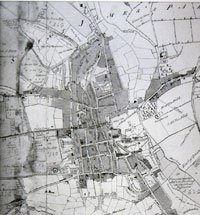
Bury Enclosure Map
Quick links on this page
Enclosure awards 1815
Theatre Royal built 1819
Lenny's map of Bury 1823
Suffolk Hospital opened 1825
Ickworth Rotunda ready 1829
Great Reform Act 1832
Municipal Reform 1835
Pigot's first Directory 1839
St John's consecrated 1842
Rail link to Ipswich 1846
Athenaeum taken over 1854
Corn Exchange built 1862
Fred King starts brewery 1868
BFP moves, EADT born 1874
Henry Prigg's digs 1878
KEGS at the Vinefields 1883
Greene King Brewery 1887
West Suffolk C C 1888
Police in St Johns Street 1892
Foot of Page-Moyse's in 1899
|
The Nineteenth Century after the Napoleonic Wars 1813 to 1899
Pre-
1813
|
Please click here if you wish to view events leading up to 1813.
|
|
1813
|
Farm prices began to collapse, and for the next decade farmers would be in financial difficulties. Most of the population still relied on agriculture, even if they were not themselves the landowner or the farmer. As farmers got less money for their crops, they could not pay the wartime levels of land rents, and also tried to reduce their production costs by reducing farm workers' wages. Agricultural depression meant misery and economic Depression on a wide scale.
In November a petition applying for an Act of Parliament for enclosure of the Bury St Edmunds town fields was considered in the House. Landowners needed to maximise their efficiency in the face of falling prices, and it would be the common users who would have to give way.
This new round of land enclosure would put further pressure on the rural poor, and alter the landscape of the countryside for ever.The enclosure of the remaining open fields around Bury St Edmunds would be completed over the next two years.
In 1784 the Reverend Sir John Cullum had published his book on the history of Hawstead. In 1813 the work was re-published as "The History and Antiquities of Hawstead and Hardwick in the County of Suffolk." Sir John had died in 1785, but the new edition, which was limited to 230 copies, included his own corrections, as well as notes by his brother, Sir Thomas Gery Cullum, and 7 new plates.
Sir Thomas Gery Cullum was also managing the River Lark Navigation on behalf of his aunt, Susanna Palmer, at this time. The company assets included the Wharf at Fornham, located just downstream of the site of Babwell Priory.
Records survive of a survey made by Thomas Warren of the buildings located at the Fornham Wharf at this time. Most of the space was taken up by coal yards in various hands. Plot 1 was occupied by a Mr Lee. Sir Thomas Cullum had a Timber Yard, a Coal Yard and a Carpenters Shop. The carpenter's workshop was for work to be undertaken on repairs to barges and canal stock. There was "An old Salt House," a Granary, Ridley's Coal Warehouse, a Weighing House, and an "old coal yard." The Granary was let to Mr Cooper for £12. 12.0 a year. Ridley's warehouse was let to Thomas Ridley for a 20 year term at 5/- a year. Probably this low rental implies that Ridley had paid for the building to be erected, and in effect this was just a site rent. In addition there were two new cottages for Sir Thomas Cullum's labourers which were not yet occupied. The malt house, which still stands today in a derelict state, was not added until 1851.
In 1813 Charles Lowe, a prosperous miller at Ixworth, leased Pakenham watermill and its 40 acre farm from the Leheu family for £130 pa. He agreed to spend £400 on improvements, despite the mill being only 15 to 20 years old. He replaced the undershot wheel with a very large breastshot wheel of wood and iron, which also meant that he had to raise the banks of the millpool to bring the water level up to breastwheel height, giving a 10 feet fall. The work would be completed in 1814.
|
|
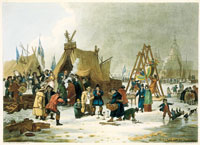
Last Frost Fair 1814 |
|
1814
|
The winter of 1813-1814 was very cold, and the frost was persistent. It began on 27th December, 1813, and continued with little interruption until March 27th, 1814. An 8 day thick fog , and a tremendous fall of snow, paralysed London for 8 days. By January 31st the Thames was "a complete field of ice."
This was to be Britain's last ever Frost Fair. It began on the 1st February on the frozen River Thames, where the ice around Blackfriars Bridge was thick enough to bear the weight of an elephant. It lasted for just four days, and on 5th February the ice began to break up. Several drownings were reported.
Winter temperatures were to remain below freezing for extended periods every winter until 1822.
In May the Napoleonic War was ended by a peace treaty. The stations of the Yarmouth naval telegraph line set up in 1808 were rapidly sold off. This included the Telegraph station on Telegraph Road in Icklingham.
|
|
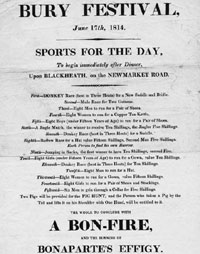
Bury Festival, June 1814 |
|
blank |
To celebrate the ending of the war the theme for the Bury Festival was the burning of Napoleon's effigy. The picture shows the notice giving details of the sports for the Bury Festival on 17th June 1814. It lists the old style races - the'Jingle race' and pig hunt. The prizes on offer were pairs of shoes; a copper kettle; saddle; hat; and money. The day ended with a bonfire and the burning of an effigy of Bonaparte.
The by-now eight troops of Suffolk Yeomanry originally formed in 1793 were formed into the First Regiment Loyal Suffolk Yeomanry Calvary. Bury was to remain the depot of the 4th Troop.
For the poor, education was a hit and miss affair. Often a local tradesman or an ex-soldier, would be licensed by the Bishop to teach children in his home. At Chedburgh the Marquess of Bristol built a school for Jonathan Cooper, probably a former soldier, to use for his classes. Other places might rely on the rector or his wife to teach basic literacy. Some parents could not afford the small fees, and in any case children were often needed to work to earn money. For some, Sunday School at the church was the only education available to children.
Bury had its Grammar School, founded in 1551, but there was no way in which a poor family could ever manage to send a child here. It was for the children of the Gentry.
|
|
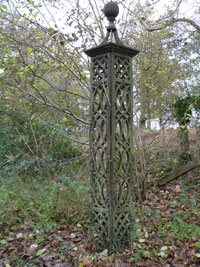
Chevington Iron Pillars
|
|
blank |
In 1814 the Chevington Way was closed off by the Earl of Bristol. He had obtained an Act of Parliament which allowed this on condition that it was replaced by an alternative route. He replaced it by new roads which skirted the area which he wished to reserve as Ickworth Park. The New Road led from near Chevington Rectory past Chevington Lodge to Great Saxham, where it picked up the route into Bury via Little Saxham and Westley Road. The Chevington Way had gone from the rectory north past the church and Chevington Hall Farm, and through the Iron Gates into Ickworth Park. At this point it was joined by another track from Chedburgh. It then followed the River Linnet to Westley Bottom and then past Perry Barn to what is now Abbot Road and Hospital Road.
As the Chevington Way was the direct and easiest route from the village to and from Bury, it seems to have continued in use to an unknown extent. Action to stop this took place in 1823.
The Iron Gates are long gone, but two gateposts now remain at this point, now known as the Chevingtom Iron Pillars by the National Trust.
At Norton, the Norton Heath was enclosed by Act of Parliament.
|
|
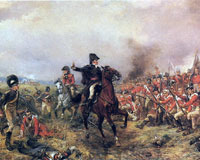
Wellington at Waterloo |
|
1815
|
Napoleon returned from exile but was finally defeated again at Waterloo. The Battle of Waterloo was fought on Sunday 18 June 1815 near Waterloo in present-day Belgium, then part of the United Kingdom of the Netherlands. An Imperial French army under the command of Emperor Napoleon was defeated by combined armies of the Seventh Coalition, an Anglo-Allied army under the command of the Duke of Wellington combined with a Prussian army under the command of Gebhard von Blücher. The defeat at Waterloo finally put an end to Napoleon's rule as Emperor of the French and marked the end of his Hundred Days' return from exile.
Just before the Battle of Waterloo all the gunflints for the British Army were being ordered from Brandon, and they had enjoyed prosperity at Brandon since the war began in 1793. A year later the order would be nil. The subsequent unemployment led to many of Brandon's flintknappers being “on the parish”.
No Mans Meadows came into the possession of the Guildhall Feoffees under the Bury St Edmunds Enclosure Award of 1815. They are still owned by the Feoffment Trust today, but were opened to public access under a management agreement with St Edmundsbury Borough Council in the 1990's.
Ther was also an Enclosure Award at Chevington in 1815. The maps that were produced for these enclosures are valuable records of the landscape at the time. Such enclosures were not cheap. Surveys had to be carried out and the legal expenses paid, which included the cost of getting a Parliamentary bill drawn up and enacted. Then works of laying out the new field boundaries and erecting hedgebanks and ditches were necessary. The Chevington enclosure cost £3,969.
In 1815 Sir Thomas Gery Cullum was carrying out improvements to the River Lark at Mildenhall. The Mildenhall sluice was being built at this time, but like many of Cullum's works, it is unclear whether these are rebuilds of older installations, or completely new constructions. He would continue to repair and rebuild features along the river until his death in 1831. His son, the Reverend Thomas Gery Cullum, then carried on this work into the 1840s and early 1850s. Because both men had the same name, and both were titled by way of the baronetcy, it can be difficult to sort out which man undertook which works. Sir Thomas the elder became 7th baronet in 1785, and died in 1831. The Reverend Thomas became the Reverend Sir Thomas in 1831, and the title became extinct upon his death in 1855.
In 1815 there were floods along the River Lark, and some landowners saw their meadows under water. This was blamed on the River Lark, and so Sir Thomas Cullum sent Mr Bevan to survey the situation. He concluded that in most cases the flooding was no worse than it had been in times past. However, he identified three locations where the river level was normally high enough to prevent meadows draining properly into the river. He proposed that for these three spots it would be possible to build tunnels beneath the bed of the river to carry this water away. Ditches would then take the water away to below the next lock or staunch, where it would drain naturally into the river. Such works can still be seen today at Fornham All Saints, Ducksluice and at West Stow. The 1839 tithe map for Fornham All Saints showed a Tunnel Meadow, which reflected this work.
During the 20 odd years of the Napoleonic wars, farmers had increased production as agricultural prices had risen. Food had doubled in price. Suffolk pastures were ploughed up to grow wheat. After 1814 prices for wheat began to fall back, profits fell and unemployment rose. Farm wages were cut by 30% and discontent occasionally boiled over into violence, particularly against any form of mechanisation.
Mobs in Ipswich and Gosbeck smashed machines and burned agricultural buildings. The words "Bread or Blood" were frequently daubed on Ipswich walls. How far the enclosures contributed to discontent is not easy to tell, but it is clear that this was yet another attack on the rights and incomes of the poor.
The newspaper reading middle classes were also further outraged when the tax on newspapers, called the stamp duty, was increased from thre'pence ha'penny to four pence a copy.
|
|
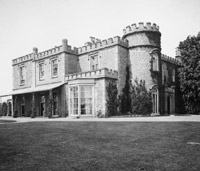
St Andrews Castle |
|
blank |
It has been written and published that St Andrews Castle in St Andrews Street South, Bury St Edmunds, was built in 1815 for the Boby family. At this time, after researching the background to Robert Boby's Iron works, the facts appear to be rather different. I can find no connection between the Boby family and St Andrews Castle until the year 1865, when George Boby moved in, and lived there until his death in 1890.
It has been shown by Jane Fiske (Editor of Oakes's Diaries) that St Andrews Castle was actually built by Ezekiel Sparke, who had been an Attorney who acted for James Oakes and others. In Pigot's Universal Directory of Suffolk for 1790, Sparke was listed as an attorney with a freehold at Hawstead. Sparke died, aged 54, early in 1816.
Ezekiel Sparke was buried at Risby on 22nd January 1816, having been born there in 1763. Oakes recorded that "my worthy friend...died... at 3 o'clock in London, (January 15th), after the Operation of being cut for the Stone." Sparke had married Sarah Sturgeon at Thurston on 21st August, 1800.
Sparke may have moved in around 1795, and the Sparke family must have lived there at least until 1816. The property was advertised as up for sale in 1839, and later, St Andrews Castle was owned by Thomas Collins, solicitor and Clerk to the county council from about 1847 to some time prior to the 1861 census.
It has since been a convent school, and today houses a business centre.
In 1815 John Louden McAdam, or Macadam, was appointed as Surveyor to the Bristol Turnpike Trust. He had no professional experience of road building, but had an enormous personal interest in the subject, backed up by his own experiments, and was already prominent in Bristol society. His method of road building, using stones broken into small pieces, rolled hard and cambered, revolutionised the roads around Bristol. He specified a rock size of six ounces, or "small enough to fit in your mouth", and this was the basis of his system. Bigger rocks were broken by the heavy wheels, but these small pieces merely pressed harder into the base course. By 1819, John, and his sons, James and William, were consultants to 25 Turnpike Trusts across the country, and some town corporations. James McAdam would work at Bury St Edmunds in 1821. John McAdam's work was endorsed by a House of Commons Committee in 1823, but not until 1827, when he was appointed General Surveyor of Roads in England, did he get the chance to improve the roads all over the country.
|
|
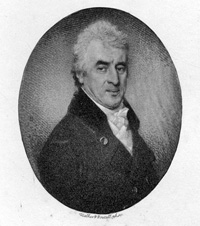
Arthur Young |
|
1816
|
Arthur Young of Bradfield Combust was still Secretary to the Board of Agriculture, despite his age and his blindness, which had crept up on him after 1807. Now well into his 70's he was still coming up with proposals to further the work of the Board. In February he proposed and masterminded a great postal survey of the real state of agriculture in the kingdom. He sent a circular letter with a questionnaire to lists of landowners and farmers drawn from his own past reports. By April most of the replies were received and "they describe such a state of agricultural misery and ruin as to be almost inconceivable." Young dreaded a scarcity of bread when multitudes were almost starving for want of employment. Country banks were ruined, he thought, by the Bank of England failing to issue enough money for circulation.
By 1816 Suffolk was also in a very depressed state. By 1816 the Guldhall Feoffees were completing the enclosure of land in Bury, and this may have helped to stir up further discontent. In April there was trouble in the countryside around Bury, and on the 29th April the Bury Magistrates issued a proclamation that they intended to enforce the law against disorderly assemblages, and "outrages". By May, violence reached Bury, when on the 8th large crowds gathered on the market, and on the 14th Robert Gooday's barns in Southgate Street were burned to the ground by a mob.
On May 15th James Oakes recorded that around 8 o'clock in the evening a great number of people assembled in the Butter Market to demand that a local hosier, Mr Wales of Abbeygate Street, should give up his Spinning Machines. Things "were proceeding to be very tumultuous", so the magistrates, principal inhabitants and officers of the militia turned out and suppressed any further disturbance before 12 o'clock. Things quietened down in Bury, but agrarian riots continued elsewhere in Suffolk.
High shop prices were also attacked. In Brandon, 1500 armed men wrecked a butcher's shop and demanded "bread or blood". In 1816 the army had completely ceased its order of gunflints from Brandon, following over 20 years of substantial annual contracts throughout the Napoleonic Wars. Throughout 1816 riots occurred in Brandon. The Riot Act was read and Dragoons sent from Thetford. The disturbances, in common with others in East Anglia, were due to the high price of meat and bread, but maybe more keenly felt in Brandon because of the loss of the flint industry. Eventually, the butcher’s house and shop was destroyed and some eight people arrested.
The decline in the gunflint industry was only partly counterbalanced by a rise in the rabbit fur trade. Originally a cottage industry, it now became organised into factories. The first rabbit fur manufactory in Brandon was W Rought’s which had been established in 1790. The fur, having been removed and processed, was sent elsewhere in Britain to be made into felt hats. The fur felt trade was a major industry in Brandon for well over a century.
The less well off did not have any efficient way to look after their small savings. In 1797 Arthur Young had written that Box Clubs "flourish very considerably in Suffolk". These were little local savings clubs. In 1810 the Reverend Henry Duncan of Ruthwell, Dumfriesshire, launched a community self-help project that spread nation- and world-wide. He wanted to help his poorest parishioners save for times of hardship. He devised a scheme by which ordinary people could save their pennies and the Ruthwell Savings Bank was born. It was a resounding success, resulting in hundreds of towns and cities wanting to form their own savings banks. According to Hugh Paget a savings bank opened in Bury St Edmunds in 1816, but further details are scant. However, this Savings Bank would eventually prosper sufficiently to move into Savings Bank House adjacent to the Norman Tower, in 1846.
|
|
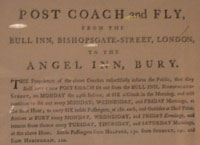
Post Coach and Fly
|
|
1817
|
The lobby of the Angel Hotel still displays this advertisement for a new Post Coach service from London to Bury. The display dates this document to 1817. The advert features the new Post Coach, but also confirms the arrangements for the existing coach, known as the Bury Fly.
The new Post Coach left the Bull Inn at Bishopsgate Street, London, at 6am every Monday, Wednesday and Friday, arriving at Bury St Edmunds on the same evening. After an overnight rest the coach returned to London every Tuesday, Thursday and Saturday, leaving at 6am as before. The six inside passengers paid 18 shillings for the full trip, and outside passengers paid half fare. Stops to take on new passengers occurred at the Bull at Long Melford, paying 15 shillings, the Swan at Sudbury, 14 shillings and the Bell Inn at Castle Hedingham, 12 shillings.
The Fly, as usual, would continue to set out from the Angel Inn every Monday, Wednesday and Friday morning at 6am, arriving in London on the same evening. The price was a bit higher and there were only four inside passengers paying 21 shillings each. Outside passengers paid half fare and pick ups at Melford paid 16 shillings, Sudbury 15 shillings, and Castle Hedingham 13 shillings.
In March, 1817, the county suffered damage from high winds. The Suffolk Chronicle for March 8th 1817 reported the following:
"By the high wind of Thursday se’nnight, two of the chimnies of Orbell Oakes, Esq at Bury, were blown down, beating in the roof, breaking the glass, and otherwise damaging his dwelling-house in Guildhall-street - the garden wall of Mrs. Palmer, at the back of Northgate-street, was blown down, and a child’s leg broken by the fall - a chimney at the King’s Head Inn was blown down, and breaking in the roof of the chamber, it was with difficulty that Mr. Oldham, the landlord, escaped the danger. Numerous other houses at Bury sustained similar damage in their roofs. Several beautiful trees on Sir Charles Bunbury’s lawns at Great Barton were snapped asunder. The windmill at Cockfield, and several others in the neighbourhood, suffered materially. The great barn at Hornings-heath, measuring 112 feet by 40, was nearly all blown down; - a barn at Rushbrooke; two others at Chedburgh and Shimpling-hall; others at Hawstead, Lavenham; Thorpe Morieux, and Hundon, are all said to have been either partly blown, or materially injured in the roofs. Numerous stacks of corn and stover were blown down in most parishes."
The same newspaper described more fully the problems of Thos. Collen, miller of Wetherden, whose newly renovated mill was destroyed in the storm... “a subscription is proposed to save an industrious man with a wife and two children from poverty.”
Collen himself took out an advertisement appealing, "That on Thursday morning the 27th of February, his Mill was blown down by a dreadful gale; and the Stones and other parts thereof so much shattered, that upon a moderate estimate, it will cost the sum of £330 to replace the same, without taking into account the loss of trade.
Your Petitioner also begs leave to inform you, that he is unable to defray the expenses of replacing the said Mill, and that he and his Wife and Family must, without assistance, be reduced to poverty."
After the end of the Napoleonic Wars, thousands of soldiers and sailors were paid off and sent home. Previously living on military pay, they had no jobs to go to, and they joined the unemployed thrown out of work when orders for military supplies and equipment finished. This problem was well debated at the time, and it would be 1818 before any sort of recovery occurred.
The post war slump in agricultural prices left about a third of Suffolk's working population unemployed. The previously well-off farmers could not pay tradesmen's bills and they in turn were ruined. By 1834 about half of Suffolk would be on some form of parish relief.
In Bury in 1817 about 4,000 of the 10,000 population were on some form of poor relief. In order to qualify for relief the conditions were now more demanding than in earlier years, and the poor were now probably worse off than for the last 20 years. The parish would top up the wages of a family of seven to 14 shillings a week, but this was 9 shillings the man, 1 shilling the wife and the five children were expected to earn 4 shillings. Employers exploited this by cutting wages. The Poor Rate had been a large and growing burden on the property owning class up to 1800, but since then costs had been cut and benefits reduced.
In 1835 the Commission on the Municipal Corporations in England and Wales published their Report. The Report on Bury St Edmunds referrred to incidents in 1810 and 1817, where the infighting on Bury Corporation resulted in elections to office being blocked by certain Members of the Council persistently absenting themselves from meetings.
In 1817 there was a vacancy among the Capital Burgesses. Those eligible to vote on the Corporation were the Alderman, the 12 Capital Burgesses, and the 24 Burgesses of the Common Council. A majority of each class had to be present to form a valid assembly. In theory any burgess or inhabitant was eligible to be elected as a Capital Burgess, but the practice was to elect the most senior Common Councillor to become the new Capital Burgess. In 1817 the Common Councillors preferred a junior member, and the Capital Burgesses blocked him by the simple ploy of remaining absent from the election, rendering it an invalid assembly. As in 1810, the situation was only resolved by a Writ of Mandamus being issued by the courts to force an election to take place.
In 1817 an Act of Parliament placed the Lark navigation under 80 new Commissioners. This Act also consolidated into itself all the provisions of the 1699 River Lark Act, and added several new clauses. At this time the Lark navigation was owned by Mrs Susanna Palmer, but Sir Thomas Gery Cullum, bart., was managing the river on her behalf. The old Commissioners, who oversaw the proper running of the river, had failed to be kept up to strength, and so it was difficult to get anything changed on the river. New commissioners were put in place by the Act, and Mrs Palmer was also given an increased scale of tolls on the river, which had been unchanged since the 1700 Act. In addition the commissioners were now empowered to carry out new works on the river, and pay for them via increases in tolls. The toll set for coals was 4/2 per chaldron.
Both Sir Thomas Gery Cullum, bart, and his son, Thomas Gery Cullum, were appointed Commissioners at this time. The Commissioners could now employ a Clerk, paying him up to £40 a year. Meetings had to be held in the Shire Hall in Bury St Edmunds. John Wayman, a Bury solicitor, was the first Clerk to the Commission, and he needed 15 commissioners to attend to make up a quorum.
The 1817 Act also required the owners of the navigation to provide either gates or leaps of the proper height to be made in any fences along the towpath. A leap was a place where the barge tow-horse could jump the fence, and was usually reckoned to be 2.5 feet high.
The full text of the 1817 Act can be accessed from the River Lark homepage, or can be read here: River Lark Act 1817 (Use your browser's 'back' button to return to this point.)
|
|
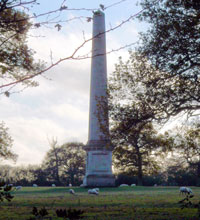
Ickworth's Obelisk
|
|
blank |
At Ickworth the 5th Earl of Bristol erected the 100 foot monument to his father, The Earl Bishop, which we still see today. It was funded by the people of Derry, where he had been Bishop, until his death in 1803. Subscribers included the Roman Catholic Bishop, and the Nonconformist Moderator of Derry. The monument was built of Ketton stone on the edge of Lownde Wood by the Bury firm of John de Carle, at the massive cost of £1,500.
The 5th Earl also decided to raise the height of the tower of the Church of All Saints at Chevington so that he could see it from Ickworth Lodge where he lived. He was still undecided about continuing with the building of the Rotunda and wings of Ickworth House started by his father. He was living in Ickworth Lodge at this time.
|
|
1818
|
James Oakes recorded an account of the Parliamentary election for the Borough of Bury St Edmunds. The candidates, Lord Euston and A P Upton, entertained 150 gentlemen and the corporation at the Guildhall. Later there was a ball in the Ball Room until 1.30 am. Although the two candidates were returned unopposed, the election expenses were £878.
|
|
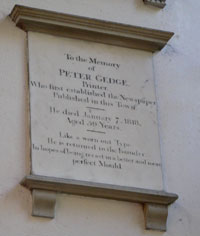
Epitaph of Peter Gedge |
|
blank |
On January 7th, 1818, the founder of the Bury and Norwich Post, Peter Gedge, died at the age of 59. Like other printers since, his epitaph alluded to his career. It stands in St Mary's Church on the north wall and says, "Like a worn out type, he is returned to the founder, in hopes of being re-cast in a better and more perfect mould."
His fame was widespread and his obituary in the London Morning Chronicle praised him, while taking a side-swipe at Bury. His newspaper, it said, "was distinguished by its firm and consistent avowal of the principles of civic and religious liberty, in a place noted for aristocratical ignorance and pride."
His widow, Ann, lived at the family home, the Hopleys in Horringer, until 1827, dying in 1840. Johnson Gedge, their second son, now took over the Bury and Norwich Post, and continued the printing partnership of Gedge and Barker.
In 1818 a newcomer to the town of Bury St Edmunds was to leave behind him a legacy which is still enjoyed today. His name was Nathaniel Shirley Harness Hodson, aged about 35 years old, and he intended to start a new enterprise which would turn his hobby into his full time occupation.
Born in Cambridge in 1783, Hodson had lately worked for the War Office in London since about 1800.
In London, Hodson had lived at Lambeth, and had made some contributions to botanical magazines, which he had based upon what he called, "my small but valuable collection of plants grown at my residence in Chapel Field, South Lambeth." It seems that he hoped to turn his hobby into his profession, and had looked for a suitable town which lacked such a facility, but had local well-to-do inhabitants who might have the means to pay to visit such a scheme.
By this date the Royal Botanic Gardens at Kew had been extensively developed on a scientific basis under George III and Joseph Banks, both of whom had brought Kew up to a peak of excellence. The idea of displaying plants to the public in a scientific and systematic layout was now a well established and fashionable idea.
In the countryside, Arthur Young of Bradfield Hall was grateful that his rents were still being paid to him. His small estate had tenants who were keeping their heads above water by 1818. He attributed the fortunate case of Suffolk to "the stability and flourishing state of our country banks." Young recorded that in Cambridgeshire and Huntingdom some farms "were abandoned and lying absolutely waste."
By 1818 there was a coach service from Norwich to London, stopping at Bury at both the Six Bells on Chequers Square, and the Angel on Angel Hill. This coach was called Richard Gurney's Original Day Coach.
The Castle Inn was one of the Carriers' Houses in Bury, and as well as providing a terminus for wagons coming to Bury market, the Castle had a carrier service to London. Twice a week, a laden wagon would take two whole days to make the journey to London.
|
|
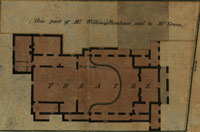
Wilkins' Plans for New Theatre |
|
blank |
The Market Cross of 1880 was designed to be a theatre, although plays were restricted to certain periods of weeks in the year. By this time the audiences had outgrown the available space and the current lessee, William Wilkins, asked the council if he might ‘take the stage, box fronts, seats…traps, machinery, wings etc’ to a new site in Westgate Street and there build a theatre ‘of ample dimensions and elegance corresponding to the other public buildings of the place’ at a cost of £5000.
|
|
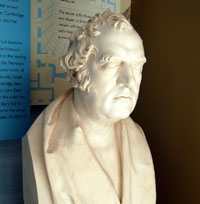
William Wilkins
|
|
1819
|
In Bury a new Theatre was erected in Westgate Street by William Wilkins, the manager of the Norwich Company of Comedians, who had hitherto performed regularly at the Market Cross. It was called the New Theatre and was most used during the Bury Fair. It had 780 seats, all benches. It did not become called the Theatre Royal until after Wilkins died.
William Wilkins was originally an architect specialising in Greek and Gothic revival buildings. He built Downing College Cambridge, as well as the National Gallery in London. His father was in the theatre business in Norwich, leasing a circuit which included Bury St Edmunds for the Norwich Company of Comedians. William had some involvement with this company since 1808, but in 1815 he inherited the business from his father. He was thus well placed to carry out building work for a new theatre at Bury, and thus take all the proceeds from performances into his own company.
|
|
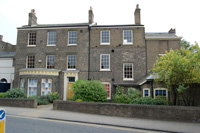
6 Westgate Street
|
|
blank |
Next door to the theatre in Westgate Street Wilkins had built a fine house, number 6, Westgate Street. Benjamin Greene, of Westgate Brewery, now moved his family out of Abbot Reeve's old home, and into this new property. Abbot Reeve's House became turned into the Theatre Tavern by Greene. The tenants of the Theatre Tavern could not make it pay, and it closed down in 1822.
The old theatre which was in the Robert Adam building now called the Market Cross, now became used as a concert hall and ballroom.
The poverty and ignorance amongst the working people led to movements such as the Society for the Propagation of Christian Knowledge. In Suffolk the Suffolk Society for the Education of the Poor in the Principles of the Established Church was in action to provide elementary and bible schooling. They set up Central Schools, such as the National School in Field Lane. This road is today called Kings Road, and the location was opposite the offices of the Bury Free Press.
In the same year the County Gaol at Bury St Edmunds was enlarged.
|
|
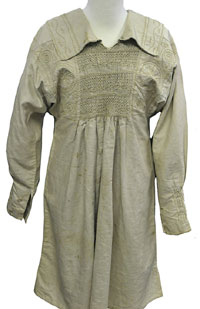
Drabbet Smock by Gurteen's
|
|
blank |
Drabbet was now replacing the woollen cloth industry in Suffolk. At first the drabbet had a warp of hempen twine and a weft or woof of cotton. Later in the century the hemp would be replaced by linen, but at this time it remained the cheapest and toughest material for workwear. For some reason the drabbet industry had been set up in Haverhill and it remained the main centre of drabbet production in Suffolk. The hemp came from Leeds and the cotton from Stockport and was woven to produce one "chain", which took one man about a week to make. About half the weavers were women or girls who needed two weeks to make one chain.
In Haverhill, Gurteen's factory records for 1819 first noted the sale of ready-made smocks, a major leap forward in the business from just supplying drabbet, fustian and cotton cloths to other businesses. The smocks would be booked out to local women to embroider the neck and sleeves with designs that denoted the occupation of the wearer. They would be collected back again and sent out to clothier's shops. Smocks had been popular in the 18th century for farmwear and were popular with waggoners and carters as well. Smocks were also called frocks at this time, and remained popular workwear in the early 19th century.
|
|
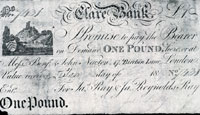
Clare Bank £1 note of 1819
|
|
blank |
The Clare Bank had been opened by James Ray and his son, James Reynolds Ray, in 1801. James Ray was a grocer and draper in Clare who moved into banking like other prosperous merchants at the time. The Rays of Clare do not seem to have had any family link to the Rays of Bury St Edmunds, who were also in the drapery business. Ray's Bank was forced into bankruptcy following the theft of a large number of their banknotes in 1819. The closure of the Clare Bank was not only a financial blow to its owners, but also left people who held their banknotes unable to spend them, or convert them into cash.
The agricultural slump had already greatly affected the banks, as well as the agricultural communities they served. However, a branch of the Bury and Suffolk bank was soon opened in Clare, following the failure of Ray's Bank in that town.
|
|
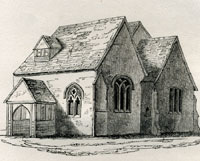
Bradfield Combust Church in 1827 |
|
1820
|
In 1820 King George IV took the throne, and street lighting was installed in Pall Mall.
Arthur Young of Bradfield Hall, the well known writer on agriculture, both at home and abroad, died in London, but was buried in Bradfield Combust churchyard. The church is shown here, as it was when illustrated in the 1827 volume entitled "A Concise Description of Bury St Edmund's and its Environs". It was described at the time as "a building of very inferior description, and contains no monumental inscriptions."
Arthur Young (1741-1820) was widely regarded by his contemporaries as the leading agricultural writer of his time. In 1767 he wrote his first major agricultural work, The Farmer's Letters, and after this he produced a constant stream of writings. Most famous were his Tours of England, Ireland and France, which mixed travel diaries with facts, figures and critical commentary on farming practices. In 1784 he founded the periodical Annals of Agriculture, and edited the forty-six volumes published as well as contributing a large proportion of their content. When the Board of Agriculture was set up to improve farming standards in 1793, Arthur Young was appointed Secretary. He held the post until his death.
|
|
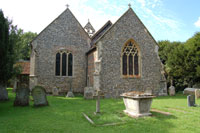
Arthur Young's tomb today |
|
blank |
His tomb can still be seen in the Churchyard at Bradfield Combust, and is shown here. As can be seen by comparing the pictures, the church has been extended and improved since 1827, and now contains several monuments, particularly concerning the Young family.
On his death on April 20, 1820, Arthur Young left an autobiography in manuscript, which was not published until 1898.
It was edited in 1898 by Miss M. Betham-Edwards, and is the main source of information about his life. He also left the materials for a great work on the Elements and Practice of Agriculture, but this was never published.
The followers of John Wesley had experienced some disagreements and by 1811 a splinter group in Staffordshire began to build their own chapels and called themselves Primitive Methodists. Although White's Directory of Suffolk of 1844 recorded that a Primitive Methodist Chapel was built in Garland Street, Bury St Edmunds, in 1820, this did not actually occur until 1830. Probably this was a simple misprint.
|
|
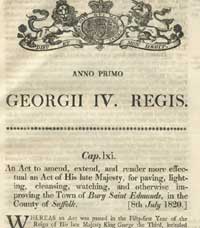
The 1820 Improvement Act |
|
blank |
The Paving Commissioners had been set up by a private Act of Parliament, and began to function in 1811. By 1820 the Commissioners had carried out much work, but could go no further without access to more funds, having taken up all the allowable sources of finance and borrowings in the 1811 act.
In 1820 James Oakes was influential in prompting a new Act of Parliament giving the Paving Commissioners in Bury St Edmunds the right to borrow up to £10,000 to repair and light the streets. However, in the way of government bureaucracy, they were not allowed to borrow more than £8,000 at one time, but a further £4,000 could be borrowed to pay for the costs and expenses of applying for the Act of Parliament. Oakes knew that this would not be enough "to complete the paving and repair which wants and to light next winter."
Nevertheless, the Act also authorised the lighting of streets and houses in the town by gas, including all the necessary works involved in setting up a gasworks and the mains. This would take another 14 years to happen. The 1820 act also extended the Commissioners' remit to the whole area of the Borough of Bury St Edmunds, whereas the 1811 act had limited them to the urban area within the old town gates.
You can read the contents of this Act here: The Improvement Act of 1820
|
|
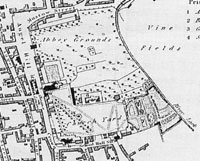
Lenny's Map of 1823 |
|
blank |
By 1820 Nathaniel Hodson had transferred his personal collection of plants to the new botanic garden at the east of the Churchyard in Bury St Edmunds. John Lenny's map of 1823 shows the site of the botanic garden at the south eastern corner of the Abbey Grounds. It was approached through the churchyard, and 'Botanic Gardens, The Churchyard', was its address.Today (2013) this site is a carpark, and contains the Suffolk Archaeology Service building.
The site was three acres in extent, but running down to the river, parts of it were marshy, and liable to flooding in bad weather. He had to pay a rent of £60 a year for this property. In the Probate of his will he was described as a "Gentleman", and he must have had sufficient means in hand to finance this enterprise.
However, he needed a Curator for the collection, and to meet his salary and the general maintenace costs, he had appealed for subscribers to pay two guineas a year to support the Garden, and to allow free access to it for those able to meet this commitment.
On 7th June he advertised in the Bury and Norwich Post to remind the "Nobility, Gentry and inhabitants in general" that subscriptions were now due, and should be paid into Oakes bank, as the business was due to open on 24th June, 1820. However, there would be no admission tickets issued until the Walks were sufficiently established.
Within a short time Hodson had gathered 133 subscribers, of whom, 30 were women. The subscribers included Sir Thomas Gery Cullum, the botanising 7th baronet of Hardwick Hall. A further subscriber was the Curator of the Cambridge Botanical Garden, Mr Arthur Biggs. Both of these persons illustrate the serious scientific side of Hodson's new venture.
|
|
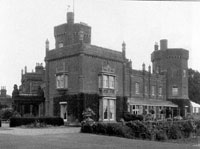
Rougham Hall
|
|
blank |
At Rougham, the building of Rougham Hall was completed. It was destroyed by a bomb in the second world war. According to H R Barker, in Pawsey's "West Suffolk Illustrated", it was erected about 1834 by P Bennet Esq., and was set in 400 acres of Park and pleasure grounds.
|
|
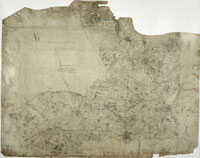
Wm Stanley OS drawing
|
|
blank |
Between 1789 and about 1840, the Ordnance Survey were sending surveyors to map the entire countryside. The drawings they produced represent the first continuous topographic mapping of England and Wales and are the most detailed record of the landscape preceding full-scale industrialisation in the mid-19th century.
The map shown here is by surveyor William Stanley together with its cost (£336.18s.4d) and the area covered in square miles, (207.35) and is dated 7th June, 1820, which is the date he completed his work. Stanley's map is drawn at 2 inches to the mile or 1:31,680.
|
|

Wm Stanley OS title panel
|
|
blank |
The original manuscript maps, drawn primarily at scales of 1:21,120 and 1:31,680, with coastal areas of military significance at 1:10,560, depicted the whole of Wales and England south of an east-west Preston-Hull line. Most such maps are available to view at the British Library website.
These ink-on-paper drawings formed the cartographic basis for the first published Ordnance Survey one-inch mapping. However they contain topographic details not captured in the smaller-scale, printed series. The first OS one inch maps (1:63,360) were published of Kent in 1801 and of Essex in 1805, now known as the Old Series. The first one inch maps of Suffolk would be published in 1836.
|
|
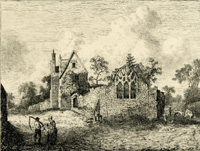 View of St Nicholas 1821
View of St Nicholas 1821 |
|
1821
|
This view of St Nicholas's Chapel in Eastgate Street was engraved and published in 1821, (copyright of the Trustees of the British Museum), described as "View of a ruined chapel with a Gothic window in Bury St Edmund's. 1821 Etching". The print was made by Jacob George Strutt, and sold at Deck's shop on Angel Hill, Bury St Edmunds. It was one of a series entitled "Bury St Edmund's Illustrated in Twelve Etchings". It shows that the window removed from St Petronilla's demolished hospital at Southgate Green was in place at the junction of Hollow Road and Eastgate Street by 1821.
John Webb wrote his second long poem about Haverhill, and called it "The Market Town". this poem does not seem to have been published until 1859, some years after his death.
Following ten years of rapid growth, Bury St Edmunds now had a population of nearly 10,000, overall an increase of 25 per cent since 1800. The official census total was 9,999, compared to 7,986 in 1811, and 7,655 in 1801. Thus growth was very slow from 1801 to 1811, and most of its increse occurred from 1811 to 1821.
The last few wool combers and spinners had finally given up in Bury by now. The town's only industry would be brewing and malting until Robert Boby's engineering works opened in mid century.
|
|
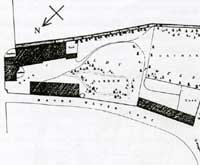
Location of Braddock's Brewery
|
|
blank |
In 1821 there were three large breweries in Bury, by the standards of the time. These were breweries which made beer to sell, not only to the public, but to other public houses and inns for resale. These were called Common Brewers, as opposed to the many inns and large houses, where beer was brewed for consumption on the premises. These Common Brewers were as follows:-
- The Brewery of Stutter and Gallant in Guildhall Street (previously the Capital Brewery)
- Buck and Greene's Westgate Brewery
- Henry Braddock's Southgate Brewery
Stutter and Gallant had taken over the Capital Brewery of John Clark. It was started in 1791 by Buckley and Garnish, who went bust in 1792, when it was bought for John Clark. It extended from Guildhall Street through to St Andrews Street. In 1821 it was probably the largest Brewery in Bury, although none of them were very large at this time.
Braddock's brewery was across Southgate Street from his maltings, at the foot of Maynewater Lane.
|
|
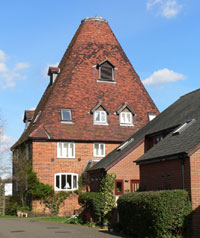
Braddock's Maltings
|
|
blank |
All these brewers also had their own maltings, usually adjacent to the brewery. Stutter's was near his brewery but facing St Andrews Street, Braddock's was just behind his White Hart inn on Southgate Street. They would also buy in malt from other maltsters.
One of the biggest of the independent maltsters was Maulkins, which was in St Mary's Square, not far from the Westgate brewery. Several local inns would buy in malt and brew their own beer for sale on and off the premises, a practice which would continue for many years yet.
The Improvement Commissioners of Bury finally appointed a Professional Surveyor, called James McAdam, to ensure that road paving and sewering was efficiently undertaken. Previously they were being criticised for the poor state of the roads. McAdam also got the commissioners to appoint a resident sub-surveyor who would supervise the contracts and report to McAdam.
James McAdam was the son of John McAdam, often today spelled Macadam, the inventor of road construction using small crushed rocks on a camber. The McAdams were consultants to Turnpike Trusts and corporations all over the country.
The Improvement Commissioners also gave permission for the path and highway to the east of the Assembly Rooms to be encroached upon by about four inches. A new brick wall was required to clad the side of the building.
Around this time the Half Moon inn was one of the town's leading coaching inns. The Half Moon was located on the Buttermarket, a few yards to the north of the Greyhound Inn, better known in the 20th century as the Suffolk Hotel. In these years the "Times" was a well known coach, and in 1821 the Times started a run from Norwich via Bury to London three times a week. The Half Moon got the job of providing fresh horses and dining facilities for Times passengers. Its driver was John Thorogood who had left his job driving the "Phenomena" coach after a dispute with Ann Nelson, the landlady of the Phenomena's London base at the Bull in Aldgate. The Phenomena was another coach which ran from London to Ipswich and the east. The Bull was to feature in Pickwick Papers, although described there as the Bull in Whitechapel. By about 1840 the Times would switch to the Bell Hotel in Bury.
The Half Moon survived until the Playhouse Cinema was built, but its old tap room found a new life as the Playhouse Bar until it finally closed in 1973.
The George and Dragon, another large coaching inn in the Buttermarket was located where Croasdales the chemists is now found. The George and Dragon was being advertised in the newspaper as far back as 1725, as "to be let or sold, the George (late the Post House), near the Market Cross." In the 1820's it was one of about six coaching inns in Bury, with the "Phoenix" coach leaving three times a week to Norwich.
The demand for political reform was growing, and there was an increasing amount of protest at the political control exercised at Bury. The Bury and Norwich Post gave a voice to reformers, but in 1821 the rival Tory supporting Bury Gazette was set up. As well as opposing parliamentary and other reforms, it opposed the emancipation of Catholics.
Coming out on a Wednesday, instead of a Saturday, the Bury Gazette probably drew some of its audience from those readers of the established Saturday papers. Later to become the Suffolk Herald in 1827, and finally to merge with the Bury Post, it was widely distributed across all the counties of East Anglia. Improved Turnpike Roads and increased speed of the Suffolk stagecoaches enabled a faster distribution to all corners of the region.
Another Tory supporting club was set up locally in 1821. Following the death of William Pitt the younger in 1806, Pitt Clubs were formed throughout Britain. They were sometimes created out of existing Tory Party organisations, to honour and preserve the legacy of the man they felt had saved the country from Bonaparte, and the hated Foxite Whigs.
In all around fifty clubs were formed between 1808 and 1821. The last, in 1821 was the Suffolk Pitt Club with annual dinners scheduled for the third Tuesdays in August, alternating between Bury St Edmunds and Ipswich. John Longe, Vicar of Coddenham was the chief instigator of the Suffolk Club, but it was to be short lived. Despite having over five hundred members by the 1823 dinner, it was disbanded by January 1824, having existed for only two and a half years.
In December, William Cobbett toured Norfolk and Suffolk, later to be recorded in his "Rural Rides", published in 1853. "The land all along to Bury St Edmund's (from Sudbury) is very fine; but no trees worth looking at. Bury, formerly the seat of an abbot, the last of whom was, I think hanged, or somehow put to death, by that matchless tyrant Henry VIII, is a very pretty place; extremely clean and neat; no ragged or dirty people to be seen, and women (young ones I mean) very pretty and very neatly dressed." This is the total of Cobbett's comments on Bury for 1821, but illustrates the type of black and white views he held, and his somewhat cavalier attitude to historical accuracy.
The gaol in Sicklesmere Road was enlarged to incorporate extra features proposed by John Orridge, its Governor.
The Bury Guide Book for 1821 recorded that there were three charity schools in Bury.
|
|
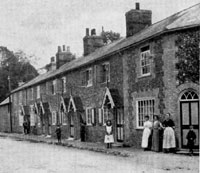
The Street and estate cottages
|
|
blank |
In 1821 Sir Charles Bunbury, the breeder of the great racehorse Diomed, died. His estates at Great Barton and Mildenhall passed to his artist brother Henry's son, called Lieutenant General Sir Henry Edward Bunbury. His family had lived at Mildenhall until he became lord of the manors of Mildenhall and Great Barton and moved to Great Barton in 1821. Sir Henry's oldest son was called Charles James Fox Bunbury and was born 1809. During his childhood Charles Bunbury was encouraged in the love of botany by his mother until in his words “ it became an actual passion.” He would become an accomplished naturalist.
At Great Barton Sir Henry Bunbury now embarked upon the rebuilding of Great Barton Hall and the development of Barton Park. He built The Street to run round the edge of his park, and lined it with well designed new homes for the estate workers. This development occurred over the years from 1821 to 1828. Any existing cottages within the Park area were demolished. Hall Park estate covers this area today.
These cottages remained far better than other non-estate workers could rent throughout the century, and were better than most people could afford to rent in Bury as well.
Sir Henry Bunbury would become High Sheriff of Suffolk in 1825 and would be an active Member of Parliament for Suffolk from 1830 to 1832.
The woollen industry along the Stour valley was fast declining because of competition from the new power looms being introduced in Yorkshire. Many handloom weavers could get little work. However, there was a thriving silk industry in London which had already started to employ local weavers in Sudbury and surrounds. John Hall had set up a mill at Coggeshall in 1818, and put out work to local handloom weavers. Hall and Sawyer were a firm of ribbon manufacturers in London and Coventry. George Cortauld had set up a silk throwing mill at Pebmarsh in 1800, and two more mills at Braintree in 1809 to supply the local weavers with silk yarn.
From 1801 to 1818 the Overseers of the Poor in Glemsford had sent 44 children to be bound as apprentices. A total of 21 had been bound to George Courtauld, silk throwster, both at Pebmarsh, and later at Braintree. Now they saw the possibility of not only employing poor and orphaned children, but of making work for unemployed adults.
Glemsford had suffered severely from unemployment, and in 1821 placed an advertisement in London newspapers addressed as follows: "To Silk Manufacturers : Any person desirest of an establishment in the county may have an advantageous situation in a parish where there is nearly 400 hands capable of being employed in the trade, many of whom are good weavers. A large Manufactory recently erected for the purpose may be had free of every expense. Application may be made to the Parish Officers of Glemsford, near Long Melford, Suffolk.
If by letter post paid.
June 18th 1821"
It is unclear whether this had any immediate effect as the first move to Glemsford of a silk throwing mill is not recorded until 1824. It is also unclear who had erected the factory which had so soon become vacant.
Things were better in Sudbury, as shown by this extract from the Bury and Norwich Post for June 29th, 1821:-
"We are happy to hear that the silk weaving business in Sudbury has very much improved in the last 3 years during which time two large factories have been built which employs large numbers of people, these in addition to the other factories of Crape, Says and Bunting afford constant work for the labouring poor. Upwards of 30 houses have been lately erected and the foundation for a new street are laid for 60 houses to be built so that looms can be admitted to be affixed to them, with the projected plan for paving and lights in the streets will make Sudbury vie with any town in the three counties."
In the opening chapter of Thomas Hardy's The Mayor of Casterbridge (1886) Michael Henchard sells his wife at auction. This sort of incident has been thought unlikely or confined to the West Country. However in the Bury and Norwich Post this incident was reported in the issue for May 16th, 1821:-
"Last week a disgraceful circumstance occurred at Sudbury when Henry Frost sold his wife (with the customary halter round her neck) to one Robert Whiting for 2s but the bargain being offensive to a number of females present they would have given the new bridegroom a summary chastisement had he not taken refuge in a cottage nearby but when they pursued him he was obliged to make his escape by jumping out of the chamber window."
The matter did not end there, however, for in the issue of the BNP for May 30th, 1821, the arrangement was found unsatisfactory:-
"The wife of Henry Frost mentioned some time ago as having been sold to William Whiting for 1s 6d has returned to her husband with Whiting giving the husband 2 guineas to take her back."
|
|
1822
|
In 1822 John Gage published his book entitled,"The History and Antiquities of Hengrave in Suffolk." The dedication was to Bernard Edward, Duke of Norfolk, the owner of the adjacent estate of Fornham St Genevieve. Unfortunately he did not include any maps of the estate or its neighbours. In the introductory chapter he wrote that the parish had a large number of partridges, "the bustard is sometimes, though rarely, seen on the heaths of the neighbourhood. A few quails are occasionally found on the Fornham Hills,..... and in the river the otter is sometimes speared. The fish of the Lark are chiefly pike, perch and eel, and not very abundant."
Willetts Bank, called the Norfolk and Suffolk General Bank, closed down at Thetford, Brandon and Mildenhall, affected by the agricultural slump. Their branch in Bury which had opened in 1806 also closed. In response the Bury and Suffolk Bank of the Oakes family opened a branch at Mildenhall, and possibly for a very short time in Brandon.
Highway robbery was still a hazard for the local family banks. The coach from London to Needham Market was robbed and Alexanders Bank of Needham lost £31,129. They had to issue new notes printed in red and told the public not to accept their old black printed notes. They paid out £5,000 in rewards and eventually managed to negotiate most of the money back via solicitors for the robbers!
Things were so bad in Bury that the first ball of the Bury Fair Season had to be cancelled as only 10 tickets were sold, compared to 409 a year earlier.
Despite these economic conditions, Nathaniel Hodson issued at the price of 3s., "a catalogue of hardy trees, shrubs and herbaceous plants" in his new Botanic Gardens located behind the churchyard at Bury St Edmunds. The list was compiled by J Denson, the curator and "comprises 1,534 varieties."
From the start, Hodson knew he had to appeal to as wide an audience as possible. He described the site as, "an ornamental and scientific garden for the recreation and amusement of the inhabitants of the town and neighbourhood."
The catalogue of plants also contained a list of subscribers which included the Dukes of Norfolk and Grafton, the Marquis of Cornwallis and the Earl of Euston. Each paid 2 guineas a year.
In December, 1822 it was announced that the Botanic Garden would be extended by a plantation leading to the River Lark. This would include grassy walks with suitable seating for the recreation of subscribers.
|
|
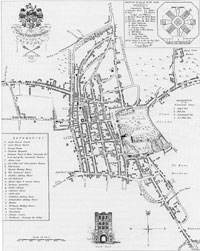
J G Lenny's Map |
|
1823
|
The year 1823 finally saw the end of a decade of freezing cold winters where the ground had remained frozen for long weeks at a time. British winters now reverted to their usual pattern of cold periods interspersed with milder, damper periods.
A new town map of Bury St Edmunds was published by J G Lenny. It shows just about the first new street to be built since medieval times, called St Edmunds Place. This short row was off the Field Lane, which is today called Kings Road, and the new street is now called Prospect Row.
Another new road marked was Waterloo Road, joining Field Lane to Risby Gate Street. The old name for this road was Chalk Lane, and Waterloo Terrace had been built there in 1815. Perhaps this was a speculative development that faltered as within a few years it was again known as Chalk Lane, and Chalk Road today.
|
|
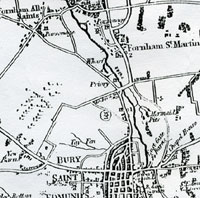
The wharf on Lenny's Ten Mile Map |
|
blank |
J G Lenny also published a map showing the area for ten miles around Bury St Edmunds. On the canalised River Lark, the map shows a wharf just north of the Priory on Mildenhall Road. Evidence of this wharfage remained until the second half of the 20th century. It consisted of a cut from the Lark towards Mildenhall Road, which turned south before reaching the road. This allowed cargo to be unloaded without blocking the main river. The cut ended at the Maltings on Mildenhall Road, which by 2005 stands empty and neglected. After its life as a maltings ended it became storage and a Furniture Warehouse, before being abandoned by the 1990's.
Lenny's map also shows the Toll Gates or Turnpikes, as they were then known, at Sicklesmere, on the Newmarket Road at Risby, and on the Ixworth Road at Great Barton. No Toll Gate is shown at the Tollgate Public House, or on the Thetford Road.
But all this was just the start of a period of new building and within a decade Lenny's map of Bury St Edmunds was seriously out of date. It would be replaced in 1834 by Payne's map.
By 1823 there was a Baptist chapel, called the Ebenezer Chapel, in Lower Baxter Street, founded in 1800. In 1823 its new pastor was Cornelius Elven, a convert from Congregationalism. Elven had a strong personal following, and he did not restrict his ministry to Bury St Edmunds.
He seems to have been willing to travel wherever he was invited and he would preach in the open air using a farm wagon as a pulpit. His diary states at times he preached to a congregation of 3000 people at Glemsford. He also carried out baptisms in a specially dug pool by the River Glem at Scotchford Bridge at which he claims there were never less than 20 candidates, some almost 80 years of age. Many of the Glemsford congregation would regularly travel to Bury to worship with Elvin in the Lower Baxter Street chapel. By 1829 about forty of these Glemsford worshippers would start building their own chapel at Glemsford.
Robert Nunn, the organist at St Mary's, added a Concert Room to his house on Honey Hill. It was called St Margaret's House and his concert room could hold 300 people, and the stage was big enough for a full orchestra. Gradually this venue would become the centre of Bury's 'serious' musical life for the next forty years.
Robert Nunn was well known in the town and was commemorated in W S Spanton's book, "Bury St Edmunds". Spanton wrote about Nunn's grave, which was 'conspicuous for its ugliness', and who died April 16th, 1863 aged 70 years. "Does anyone ever ask who Robert Nunn was? So well known was he in his day as organist of St Mary's, conductor of the Choral Society , teacher of music and dancing, that his friends thought there was no need to record his profession; his name was enough."...."He was indeed a notable character, full of jokes and taradiddles, with a laughing eye, a rubicund figure short and stout, hands so dumpy that everyone was surprised that he could play so well."
|
|
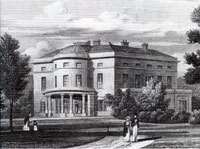
Culford Hall 1823 |
|
blank |
In August, Charles, the second Marquis of Cornwallis, died and the Culford Estate and its five villages were put up for sale. The estate failed to meet its reserve and not until August 1824 was it sold to Richard Benyon de Beauvoir of Reading.
|
|
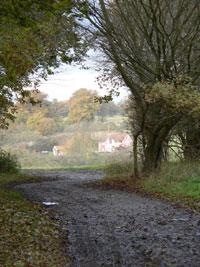
White House from Chevington Way |
|
blank |
In 1814 the Earl of Bristol had built the New Road from Chevington to Great Saxham to replace Chevington Way which now inconveniently ran through his Park. It was still being used, so in 1823 he built a dam across the River Linnet to form a 15 acre lake at a cost of £500. The rising waters of the new lake did successfully drown the Chevington Way and cut off the access through the park, but this lake would be the cause of a disaster in 1842.
The Chedburgh track met the Chevington Way just outside the Iron Gates.
The Earl also tried to cut off the Way from Chedburgh by building a pair of cottages across it at Iron Gates Green.
The well known and highly regarded Suffolk poet, Robert Bloomfield died in Shefford in Bedfordshire, in greatly reduced circumstances. He had been a great pastoral poet, drawing upon youthful life in and around Honington, Sapiston and Euston, although most of his adult life was spent in London and out of Suffolk.
In 1823 the Gaol Act was passed which made it compulsory for gaols to provide education in basic literacy for prisoners. As a result the County Gaol on Sicklesmere Road, Bury St Edmunds, employed a schoolmaster in 1826. Gaols also had to provide libraries for the use of inmates. It would be another half century before such a requirement for compulsory basic education was applied to the general population.
|
|
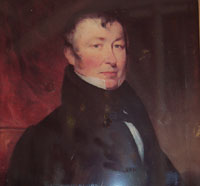
Benjamin Greene |
|
1824
|
Around 1824 or 1825, Benjamin Greene, the Bury Brewer, acquired interests in estates in the West Indies. The Greenes had been close friends of Sir Patrick and Lady Blake who lived almost next door to them in Crown Street. Greene had been made a Trustee of the Blakes marriage settlement in 1817, and was an executor and beneficiary in their wills. Sir Patrick died in 1818, and Lady Blake died in 1823, leaving half of her money and West Indian properties to Benjamin Greene. Greene now had an estate in St Kitts and a small property on Montserrat, and also became manager of their other estates in the West Indies and in Suffolk. His new connections with slave owning, sugar production and molasses would colour his views for the future.
The estate at Culford, together with the villages of Culford, West Stow, Timworth, Ingham, and Wordwell, several advowsons (church livings), and a brick kiln, were sold for £195,000 to Richard Benyon de Beauvoir of Reading. The estate was said to be one of the finest shooting domains in the county, "offering an excellent investment for a Capitalist rarely to be met with , the present Rent Roll exceeding £7,000 per annum." Despite this, the estate failed to meet its reserve at auction in 1823, and was finally sold privately to Benyon a year after the death of the Marquis of Cornwallis. Richard Benyon spent very little time at Culford right up until his death in 1852.
The Mechanics Institute was established in Bury St Edmunds in 1824.
The Suffolk Chronicle for August 12th 1824 described a dreadful hailstorm , when... “ice, large as walnuts dropped,” giving the appearance of... “a curtain falling from the sky”. At Fornham, corn was... “completely stripped off the stalk; a hundred acres of turnips were washed away, swedes cut to atoms.” Ice was described as being... “four feet deep in some hollows.”
At Sir Henry Bunbury’s farm at Great Barton, fifty brace of partridges were found dead, killed by the force of the hail storm.
White's Directory of Suffolk for 1844 contained the misprint that Bury's gasworks were opened in 1824. This error was continued in several future directories and guides. In truth, the gasworks was not built until 1834, but it illustrates how a mistake, once it has made it into print, tends to become accepted truth forever after. This particular directory also contained a similar ten year misprint regarding the first Primitive Methodist chapel in Bury, citing 1820 instead of 1830.
The silk weaving industry had been moving out of Spitalfields since about 1774. Sudbury, Haverhill and Glemsford were the places in Suffolk most affected by this migration. At first it was merely transferring the handloom weavers from one material to another, wool to silk, but following the removal of the duty on raw silk in 1824 the manufacturers began to set up throwing mills in connexion with the weaving centres.
|
|
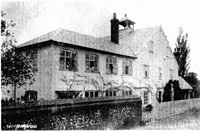
Glemsford Silk Mill |
|
blank |
From 1801 to 1818 the Overseers of the Poor in Glemsford had sent 44 children to be bound as apprentices. A total of 21 had been bound to George Courtauld, silk throwster, of Pebmarsh, who was later at Braintree. Having seen how useful this employment could be, the Glemsford overseers of the poor then advertised in the national press in 1821 for someone to open a silk throwsting mill at Glemsford. As a result of this announcement Alexander Duff came to Glemsford from his silk business in Spital Square, in the east end of London, and started the first silk mill here. Silk throwing is equivalent to the spinning process for wool. The end product is a twisted yarn, ready for dyeing and weaving, and this usually involved the silk being finally wound onto bobbins.
So it came about that in 1824, a silk throwing, (or throwsting) mill at Glemsford was established on an old watermill site using the existing water wheel and its half acre headwater pond. It was located at the north eastern edge of Glemsford at the end of Chequers Lane. It made employment for over 200 hands by 1874. The function of a throwing mill is to process raw silk by steeping, winding, doubling and twisting to prepare the silk into hanks for the dyers. The raw silk was imported in bales from China and Japan. In the Glemsford Mill the machinery was first driven by a water wheel. This picture comes from the Foxearth and District Historical Society website.
(This mill flourished up to 1874 before declining. Steam power was introduced probably in 1849 when a beam engine was built by J T Beale of Greenwich. This engine survives today in store at Beamish Living Museum in County Durham. Employment here was much reduced by 1900. Nevertheless the Glemsford Silk Factory would survive through to 1958, when dyeing was added to the activities of the Mill. In 1961 a modern factory was built on an adjacent site using electricity for power. Silk throwing survived in Glemsford until about 2010 as part of Stephen Walters Sudbury Silk Mills, on Chequers Lane.)
|
|
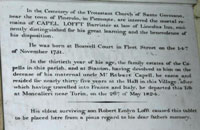
Capel Lofft memorial |
|
blank |
Capel Lofft, of Troston Hall, was travelling in France and Italy in his 70s when he died and was buried near Pinerolo in Italy. His son had this commemorative plaque erected in Troston church. He had been a reformer in the 1770s, but by the 1790s he espoused many more radical causes. These included universal male suffrage and the abolition of the death penalty. He had been an opponent of the War which resulted in American independence, and was an admirer of Napoleon Bonaparte. In 1800 he had gained notoriety for his vigorous campaign against the death sentence passed on Sarah Lloyd, and as a result he was struck off the roll of magistrates.
|
|
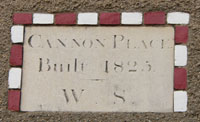 Cannon Street
Cannon Street
|
|
1825
|
William Steggles was listed in Directories as a local builder from 1823 to 1839. His office was at 10 Whiting Street for much of this period. By 1833 Payne's survey would show Steggles as owning more houses than anyone else in the town. In 1825 William Steggles was completing the building of 23 houses with gardens in Cannon Street, which he named Cannon Place. The only remaining buildings from this development are facing Pea Porridge Green, running from Cannon Street to Church Row.
|
|
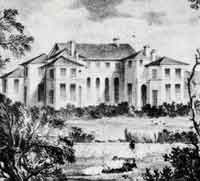
Suffolk Hospital c1830 |
|
blank |
A committee was set up, chaired by the Duke of Grafton, to provide a hospital. It was decided to purchase some redundant military buildings no longer needed after the end of the war.
The West Suffolk Hospital was founded in 1825 in the then rural surroundings of the Chevington Road, which soon became renamed as Hospital Road. At the time it was called The Suffolk General Hospital. It was opened on 4th January 1826, and was established in a converted military depot, now redundant after the end of the Napoleonic War following Waterloo. The depot was said to hold a 10,000 stand of arms. The conversion into the new hospital was funded by public donations, the first of which was £2,000 from Lord Bristol. Donors and subscribers could nominate the patients to be treated, and at first there was capacity for just 50 in-patients. Patients with infectious diseases such as cholera still had to go to the Pest House. Patients with venereal diseases were not admitted, and this rule continued until the time of the NHS after 1948.
In 1825 Stephen Piper, a bookseller in Ipswich reissued Joshua and William Kirby's 1766 map of Suffolk under his own name. Obviously it was well out of date by this time, and contained the names of many landowners who were long dead.
At Culford the new owner of the estate, Richard Benyon, set about emparking the Culford Mansion and grounds. Several new roads were created, and others diverted around the park boundaries. Some 200 acres of woodland was planted up. The village of Culford was demolished and rebuilt along the new village road. Many other estate buildings were modified or rebuilt. Over the next two years there were many new straight roads built for Benyon by John Soden. West Stow was joined to Flempton bridge, and West Stow was also linked to Fornham St Genevieve. Rats Hall corner was linked to Elveden. New roads were also laid out in the Park itself.
A new era in transport began when the world's first public steam-powered railway opened in September in the north of England between Stockton and Darlington. The first train to make the twenty-seven mile journey was pulled by George Stephenson's steam engine Locomotive No 1 and consisted of a tender, six goods wagons, the director's coach, six passenger coaches and fourteen wagons carrying workmen.
December 1825 produced a financial crisis when a series of banks crashed nationwide. Luckily there was only one bank failure in Suffolk, and this was at Brandon. Most could get to London to get cash to meet demands, and none had London bankers that failed. Sparrows of Braintree were not so fortunate.
|
|
1826
|
Catholic emancipation was one of the major issues in the 1826 General Election. The corporation of Bury opposed emancipation, despite the fact that both the Earl of Euston and Lord Hervey supported the cause. This led to some uncomfortable moments for both sides as the corporation more or less had to return both men as MP's because of their control of patronage in the town. There was pressure from reformers from all sides, and the corporation was no longer leading opinion as it once had. It was extraordinary that 37 mainly Tory men could still elect a Whig in this way.
In 1826 a bizarre discovery was apparently made on the Fornham Estate, which was described fourteen years later. In 1840 the historian John Gage Rokewood wrote, in his note to the Camden Society publication of Jocelin of Brakelond's 'Chronicle':
"In felling, in 1826, an ancient pollard ash that stood upon a low mound of earth about 15 feet in diameter, near the church of Fornham St. Genevieve, a heap of skeletons, not less than 40, were discovered, in good preservation, piled in order, tier upon tier, with their faces upwards and their feet pointing to the centre. Several of the skulls exhibited evident marks of violence, as if they had been pierced with arrows, or cleft with a sword".
In 1826, the Norwich dyer, tea-dealer and tobacconist, William Watling Sexton, moved his business to Bury St Edmunds. His original premises here are not known, but in 1830 he moved to 2 Crown Street, in Bury. He would move on as his business grew, until in 1858 he would open for business at 26 the Buttermarket. These premises would remain known as Sexton's the tobacconists until final closure in 1964.
Around 1826 it is believed that Abbeygate Street was paved with wooden blocks of cedar wood which had been soaked in tar. It was hoped that this would ensure that horses and carts could pass down the Bury's main shopping and residential street with the minimum of noise. These wood blocks were skimmed over with tarmac throughout their lives and finally removed in 1952, although a few remained to be removed in 1990.
From 1826 things started to go wrong for the growing silk industry of Britain. The duty on raw silk was reduced to one penny a pound in 1825, and the silk manufacturers were assured that this move towards Free Trade would would benefit them. However, the duty on thrown silk imported from abroad was reduced from 14s 8d a pound weight in 1823 to only 5s by 1825, and then reduced further each year. Large quantities of foreign white and coloured silk came into the country, undercutting local throwers and there was an immediate reduction in employment in the silk industry of London and East Anglia. Local manufacturers were having to rely upon producing black silk, which was not greatly imported. The situation in the industry and the resulting massive increase in poverty and degradation would lead to a Parliamentary Inquiry by a Select Committee in 1832. The London firm of Grout and Bayliss had set up mills at Norwich, Yarmouth, Bungay and Mildenhall, employing 3,500 people in Norfolk and Suffolk by 1826. But by 1832 this number would be halved. Similar effects were seen in the Stour Valley silk weaving and throwing industry. By 1840 silk weaving would finish altogether at Coggeshall and Hadleigh.
|
|
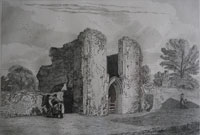
St Saviours in 1827 |
|
1827
|
In 1827 Henry Davy published a book of etchings of some notable old buildings in Suffolk. The book, entitled "The Architectural Antiquities of Suffolk", contained 70 plates both drawn and etched by Davy himself. This extremely large volume was printed by Deck's of Ipswich. The print shown here is of the remains of St Saviours Hospital, still to be seen in Fornham Road, Bury St Edmunds.
|
|
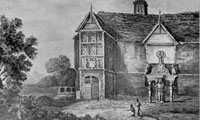
Hawstead Place |
|
blank |
Hawstead Place was not included in this volume as it was dilapidated, and was demolished in 1827. All that remained of the old house was the north wing. It had been a moated courtyard house dating back to at least 1510, when Sir Robert Drury embarked upon its improvement. Thomas Cullum bought the estate in 1656, but later it declined when the family preferred to live at Hardwick House.
|
|
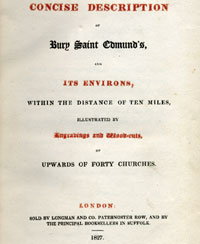
Bury and Environs 1827 |
|
blank |
In 1827 Longman & Co. of Paternoster Row in London published a book entitled "A Concise Description of Bury Saint Edmund's and its Environs within the distance of Ten Miles". It was illustrated by engravings and woodcuts of "upwards of forty churches."
For each parish the book details particulars of churches, brief biographical notes of celebrated men and families, charities, patrons of livings, incumbents, present Lords of Manors and principal proprietors of Estates. In all, there were 367 pages of text, plus a list of subscribers, and an index of names of all the Lords of the Manor mentioned in the book.
There were 279 original subscriber copies, but it was also sold by the "principal booksellers in Suffolk."
In March 1827, the Gardeners Magazine published a letter from Nathaniel Hodson describing the Botanic Gardens at Bury St Edmunds. This letter provides some idea of the form of the gardens. He noted that he had added two additional acres of meadowland for ornamental trees and shrubs, with spacious grass walks and rustic seats on the margin of the River Lark. The upper part of the garden had the ornamental and showy plants, with long narrow beds containing the classes and orders of the Linnean arrangement. Walls enclosed two thirds of the garden, and were lined with climbing plants and shrubs. The river could be crossed by a rustic Swiss bridge. He ended by writing that families living over 10 miles from the gardens could have a reduced subscription of one guinea, and strangers could obtain a day ticket if they applied to one of the existing subscribers.
By 1827 the Beast Market was taking up a considerable space in the town of Bury St Edmunds and was becoming thought a nuisance. However, they would soon find that there was a great public resistance to moving it.
At an assembly of the common council of the Borough held on 23rd January 1827, a report was
received from the “Committee To the Fairs and Markets” (Suffolk Record Office reference D4/1/5).
Amongst their
recommendations was the following:-
“Respecting the Markets – On measuring the present Beast Market they are of
opinion that it is not sufficient for the accommodation of the increased number of stock weekly
driven there as much of the present space must be appropriated to roads. They therefore
recommend to the consideration of the Corporation to obviate the present inconvenience some more commodious place has been considered and submit that the premises in St Andrews Street the property of Major Wilson being not distant from the present Beasts Market as a convenient
spot. With this view your committee have enquired (thro’ the medium of a friend) the price of the
said premises and are informed that nine hundred guineas is the sum named. They have also
directed their attention to find out a better accommodation on the Corn market and are of the
opinion that the present Market Cross might be converted”.
The corporation acting on the committee’s recommendation “resolved that Major Wilson’s
Estate should be purchased for the corporation at a sum not exceeding nine hundred guineas
and that the market for Cattle should be removed there and that the consideration of the further
part of the report be postponed to a future day and Mr Deck is authorized to treat for the Estate
on behalf of the Corporation”.
At the following meeting held on 9th February 1827, a “requisition” was presented to the
corporation that “We the undersigned Tradesmen and Innkeepers respecting owners, tenants and
occupiers of messuages and premises situate in and near the Market places of the said Borough
having been informed that it is intended to remove the Cattle and Butter Markets in the Borough
from the places where the same are now held respectfully beg leave to represent that such
removal would be greatly to our prejudice in our several callings and also materially depreciate
in value our houses and premises so situated. And we therefore humbly request that any removal
of the markets of this Borough (should such be contemplated) may not be carried into effect”.
This petition is dated 8th February 1827.
At the same meeting the committee of Fairs and
Markets “reported that they had bought Major Wilson’s House with the Fixtures at the sum
£920”.
At the next assembly held on 1st June 1827, it was decided that,
“further consideration of the question relative to the removal of the Cattle Market would be
adjourned till this day month”. The petition and public objections had now started to cause a delay. Some Council members were feeling under attack. At the same meeting “The committee appointed to alter the
Cattle Market declined to act any further”.
When the Council assembly next met on 29th June, a motion
was proposed in favour of their previous decision that, “so far as relates to the removal of the
Cattle Market be confirmed, the Corporation having purchased the Estate of Colonel Wilson
therein referred to, and that a committee be appointed to take the necessary measures to form
the New Cattle Market and to carry into full effect the above resolutions”.
A committee of five members of the council,
Robert Maukin, James Mathew, John Symonds, William Frewer and John Jackson were
appointed for this purpose and ordered to report “from time to time their proceedings”.
Matters now dragged on into 1828.
|
|
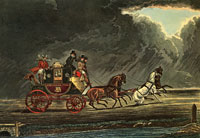
Norwich Mail Coach |
|
blank |
The years from 1815 to 1838 were the heyday of the coaching industry. Roads had been improved by engineers like Thomas Telford, but John Louden Mcadam (or Macadam) had made the most impact because his roads were effective, and much cheaper to construct than Telford's over engineered products. A complex network of staging inns every ten miles or so, now existed, with facilities for changing horses, refreshments, and some simple coach maintenance. In practice a stage might have to be between five and fifteen miles, depending upon conditions. The Halfway House, or Seven Mile Tavern, at Higham was mid way between Bury and Newmarket, a distance of about 7 miles in each direction. Coaching inns like the Angel at Bury, catered for overnight stops as well, if necessary, and had facilities for large numbers of horses.
The romance of speed was captured by artists like James Pollard, who loved to paint the "flying machines" of the day, the Post Coaches. This picture shows the London to Norwich Post Coach, designated by its number, N105. It is pictured crossing Newmarket Heath in a dramatic thunderstorm. Travelling north from the Post Office in Lombard Street, in London, it passed through Bishops Stortford to Newmarket, thence to Bury, then Thetford, and on to Norwich.
In 1829 the London starting point for the mail coach was moved to St Martin le Grand, where the Bull and Mouth was a renowned coaching inn for northern and eastern destinations.
James Oakes became unable to continue with his diaries in October 1827 as he was nearly 86, arthritic and deaf.
The Suffolk Yeomanry were suspended from duty for a brief period from 1827 to 1831.
Pressure for reform continued despite the control exerted by the Fitzroys of Euston and the Herveys of Ickworth. Whe the post of Recorder came up for election in Bury, the Reform Party put up John Benjafield as candidate against Oakes's political machine choice. Oakes controlled the votes on behalf of the great local gentry, and Benjafield himself knew it. In a newspaper report he was reported to say that he might as well expect to be appointed Emperor of the Turks, as Recorder of Bury.
The newspaper called the Suffolk Herald was started in Bury as an ultra Tory, anti-reform and anti-catholic emancipation paper. It seems to have replaced, or taken over, the existing Tory paper, called the Bury Gazette, begun in 1821. It was printed by Duttons of College Street. It lasted 15 months before being bought out by Benjamin Greene, the Brewer.
In 1827, Joseph Maulkin, the prominent Bury Maltster of the Horsemarket, died without any sons. His father, also called Joseph, had acquired the 1.5 acre site with its house, granary, and maltings, between Crown Street and what we now call St Mary's Square, in 1765. Much of this property, as well as others, now passed to Robert Maulkin, who was the son of Solomon Maulkin, Joseph II's youngest brother. The property included 4 public houses in Bury, two more in the country, 38 acres in Bury and 200 more elsewhere in Suffolk. Robert would not be so successful as his uncle had been, and shortly after 1836 he was persuaded to be "retired off" to Brinkley Grove.
In about 1827 Robert Boby first came to Bury St Edmunds, probably to be apprenticed to an ironmonger at the age of 13 years. He was born in Stanford, Norfolk, the son of a farmer. Boby would eventually be the founder of the St Andrews Ironworks, and would live in Bury St Edmunds until his death in 1886.
|
|
1828
|
At Fornham St Genevieve Hall, the Duke of Norfolk was in the process of updating the house using Robert Abraham, a London architect. Abraham had close connections with many of the Roman Catholic families in Norfolk and Suffolk. Many more alterations would follow throughout the century, resulting in a great mansion of 8 main bedrooms and 18 secondary bedrooms. There was also extensive servant accomodation, and many outside buildings for stables, laundry, bakery, offices and the like.
Work on removing the Beast market out of the town centre to a new site on St Andrews Street South had been carried on throughout 1827 accompanied by public protests. There were
no further reports on the Cattle market considered by the Borough Council until the 5th May 1828. At that meeting a vote of thanks was proposed “to
Charles Blomfield esquire as Alderman for his firm and manly conduct in supporting the rights
and orders of the Corporation on the thirtieth of April Last relative to the removal of the Cattle
Market. That he be requested to preserve in his exertions to further the resolutions of the
Corporation and to take such measures as he may be legally advised to adopt in preventing a
further resistance to such order. That all expenses incurred be defrayed from the funds of the
corporation”.
To avoid severe congestion on market days the Cattle Market was finally removed from Bury town centre near the Corn Exchange to St Andrews Street (South) during April, 1828. This resulted in a riot on 30th April when a brick was thrown at the Town Clerk. The octagonal toll collectors booth still survives from this site, but was not built until 1864. Bonds had been issued by the corporation in their usual way to raise the finance to buy the land for the new market.
In June, the Suffolk Herald was bought by Benjamin Greene. He may have had partners in this enterprise as John Benjafield was certainly registered as having an interest in 1831. In July the paper's name was changed to the Bury and Suffolk Herald, and Greene used it to express his own views, often highly critical of local personalities and issues, but with a strongly Tory slant. He would argue that the slaves in the West Indies were better off than English farm labourers, for example. But he attacked the Bury Corporation for being mere pawns of Lord Bristol and the Duke of Grafton. Rivalry with the Bury Post would lead to legal action in the future.
Warren's map of the town of Bury St Edmunds dated 1791 showed that by that date there was access to Field Lane via an opening at the side of the Woolhall. No such opening was shown on his 1776 map. However, in 1828, the old Woolhall, which had ceased its real use in about 1800-1806, was pulled down. The Improvement Commissioners took the opportunity to widen the opening and to create a proper road to connect the Market Place with St Andrews Street. They decided to give it the name of Woolhall Street, the first major opening to break through the line of the old town wall.
|
|
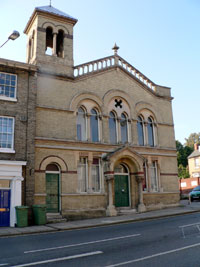
Independent Chapel |
|
blank |
In 1828 the Independent Chapel was opened in Northgate Street, Bury St Edmunds, at the Angel Hill end. In 1866 it was almost rebuilt, and comfortably benched, containing 400 sittings. From 1902 it became taken over by the Primitive Methodist congregation. The building still exists today on the corner of Looms Lane and has had a variety of secular uses as well as the religious.
From 1828 to 1839 there was also a great expansion in non-conformist activity in Haverhill. In 1828 the Baptists opened a new meeting house, to be followed by the Quakers house in 1834, the Methodists in 1836, the old Independents and the Market Hill Chapel in 1839.
|
|
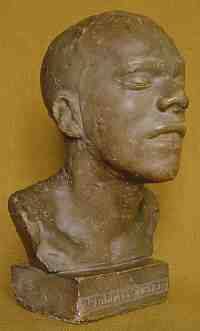
William Corder Deathmask
|
|
blank |
John Webb of Haverhill reported attending a sermon in London preached "to improve the Polstead murder". The preacher "cautioned young men in the congregation against idleness, Corder was idle, and held Maria Martin as a warning against immoderate dress". This murder, soon to become known as "The Murder in the Red Barn",
was widely reported in its day.
Corder's trial took place on Thursday 7th and Friday 8th of August 1828. Throughout the trial he claimed his innocence. Nevertheless he was found guilty of murder and sentenced to death by hanging. His body was to be anatomised (i.e. dissected, and the results put on display), a practice which was abolished in 1832.
Shortly before the sentence was carried out, Corder confessed. He was executed on the Monday August 11th, at the county gaol in Bury St Edmunds. Despite heavy rain, thousands of spectators attended. The body was taken to the Shire Hall, where it was cut open and laid out on show. Thousands of people filed past to view it before it was removed for dissection at the West Suffolk Hospital. The skeleton was kept, and the scalp and part of the skin were preserved. The surgeon, George Creed, later had an account of the trial bound in leather made from Corder's skin. Many of these items can be seen in Moyse's Hall museum today.
A very full account of the trial and the events surrounding it can be found by clicking here:
The Murder in the Red Barn,
The trial and execution brought crowds of sightseers to the town. The more well to do also visited Hodson's Botanic Gardens, which were adjacent to the Shire Hall where the trial was held. On 20th August the local papers noted that visitors to the Botanic Gardens included Lord Chief Baron Alexander, Sir William Rowley, Sir Charles Blois, Sir William Parker, Sir Robert Harland and many other gentlemen from different parts of the county.
Bury St Edmunds Horticultural Society was founded in 1828, and immediately set up an annual show. Plants were shown by Nathaniel Hodson and his Botanic Gardens curator, Mr Turner, at every show for years to come.
Robert Maulkin, who was now running the Maulkin family maltings and other businesses, bought more inns. The business already had 4 in Bury and 2 in the country. In 1828 he bought the Castle, and the adjoining Moyse's Hall. In 1831 he would buy two more inns, but the mortgage payments on all these would prove too much for the business to bear.
|
|
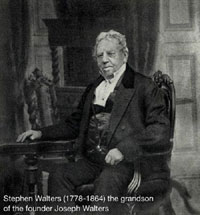
Stephen Walters - Silk manufacturer |
|
blank |
As part of the general dispersal of the silk industry out of Spitalfields, London, in search of cheaper skilled labour, the firm of Stephen Walters opened a silk mill at Haverhill. They had already expanded into Braintree in 1822, and Kettering (this seems to be South Kettering, by Lowestoft) in 1824. The firm did not move into Sudbury until 1860. They maintained their headquarters in Spitalfields until 1899, and by 1900 would move their whole enterprise to Sudbury. By 2012, the firm would still be trading from Sudbury as the two units of Stephen Walters and Sons Ltd, and as David Walters Fabrics Ltd.
|
|
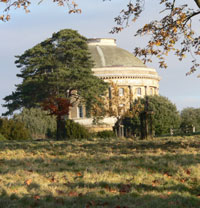
Ickworth House Rotunda
|
|
1829
|
The 5th Earl of Bristol (and 1st Marquess) had finally finished the building of Ickworth House and its great Rotunda. He moved his family out of Ickworth Lodge and into the East Wing of the great new house.
He was probably also responsible for the landscaping around the great house which prevents its grand design from being seen in its entirety. Only the Rotunda can be seen from the front drive, and only glimpses are visible from most of the Park.
The west wing was built but left internally unfinished. It was in use as an Orangery, and was not finally fitted out until 2005, when the National Trust added new Visitor Facilities here.
James Oakes, the prominent banker of Bury St Edmunds, died but he left a diary covering the years from 1778 to 1827. He had been five times Alderman of the town, Deputy Lieutenant of Suffolk, Justice of the Peace, Turnpike Trustee for Thetford and Sudbury roads, a Guildhall Feoffee and governor of King Edward VI Grammar School.
Robert Bevan and David Hanbury now became partners in Oakes Bank to produce Oakes, Bevan and Hanbury.
In 1829 torrential rain caused flooding in the Holy Water Meadows, the Butts and Friary Lane.
In Crown Street the house of the late Sir Patrick and Lady Blake was bought by the Suffolk barrister and reformer, Francis King Eagle.
Susanna Palmer, the proprietor of the River Lark Navigation, died in 1829, aged 93. The Lark navigation now passed into the hands of Sir Thomas Gery Cullum of Hardwick House. In practice he seems to have been managing it on her behalf for some years past.
In February 1829 the Bury and Norwich Post reported on a meeting held at Lavenham to discuss how, "to save Lavenham and the neighbourhood from pauperism and ruin" following the collapse of the old cloth industry and the agricultural slump following the end of the Napoleonic Wars. The cost of Poor Relief in Lavenham had peaked at £2,736 in 1813, but remained above £2,000 a year until 1833. It was suggested that a canal should be dug from the River Stour at Mistley to Lavenham to provide work and to encourage trade and enterprise in the town. However, this idea was never adopted as a serious proposition. Some people decided to leave south Suffolk to seek work in factories in Lancashire, and Lavenham's population would decline from 2,107 in 1831 to 1,871 by 1841.
While the Stour valley was experiencing massive unemployment there was a lack of skilled labour in London, resulting in higher wages, and the Spitalfields silk producers had been moving some production into the countryside. By 1827 it was reported that a number of Lavenham weavers were now employed in weaving silk for the masters at Sudbury.
It is not clear exactly when the first silk weaving was carried out in the Stour valley. The Spitalfield Weavers Act of 1783 had tried to introduce wage controls into the silk industry there, and this was probably an early incentive to move out of that area for some Silk masters. In July 1784 Arthur Young took his French visitors on a five or six day tour of Suffolk and the Essex border. They went to Long Melford and Sudbury, noting the "considerable trade in woollens and silk stuffs." In Sudbury itself there is a record of silk weaving in Weavers Lane by 1791. However welcome this work was for some individuals the silk industry never employed the large numbers who had been involved in the woollen trade.
Benjamin Greene now sent his eldest son, Benjamin Buck Greene to manage his sugar plantations in St Kitts. He had been able to but neighbouring estates cheaply because the price of sugar had fallen from 62s.4d. in 1815 and by 1831 they would be down to an average of 23s.10d. However young Benjamin was a good businessman.
Stutter and Gallant's brewery on Guildhall Street, their maltings nearby in St Andrews Street, and 11 country inns, were sold. It was opened as the Capital Brewery in 1791 by Buckley and Garnish, who went bust in 1792 when it passed to John Clark. By the 1820's it was Bury's largest brewery, but there was strong competition from both Greene's Westgate Brewery and Braddock's Southgate Brewery. The brewery seems to have closed until 1837, when John Everard started it up again.
|
|
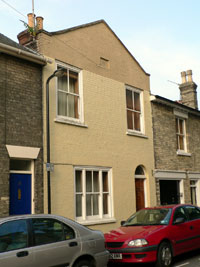
No. 15a Garland Street |
|
1830
|
The followers of John Wesley had experienced some disagreements following Wesley's death. His church became increasingly centralised, authoritarian and "Churchy". After 1811 two preachers from Stoke on Trent began to hold outdoor camp meetings for worship, which were very popular, but judged to be "highly Improper" by the Wesleyan Methodist Conference. These new preachers wanted to return to the fervour and evangelistic spirit of Methodism as it was in its primitive beginnings. In 1811 the first Primitive Methodist chapel was erected in Tunstall in Staffordshire, and admitted women to be preachers and office holders. It attracted the humblest members of the community.
By 1821 the Primitive Methodist movement reached East Anglia, and by 1829 two such preachers from Brandon came on a mission to Bury St Edmunds. They were so successful that a house in Garland Street was quickly purchased and converted into a chapel.
Primitive Methodist services began in Garland Street in Bury St Edmunds on January 22nd, 1830. This chapel is now private home, number 15A Garland Street. Meanwhile, in Bury, the old Wesleyan Methodists continued to attend chapel in St Mary's Square.
William IV became King in 1830. A major cholera outbreak began in Britain and continued into 1831. It took ten years for the link to insanitary drinking water to be accepted.
By 1830, the so called Gin Palaces were such places of drunkenness and ill repute, that an attempt was made to curb gin drinking by encouraging beer drinking. Beer was at this time very much an everyday drink - even children drank so called small beer - and it was seen by those among the evangelical and temperance movements as very much a secondary evil.
Farmers were also keen on beer production as it required malt from their barley in its production. Brewers and Hop growers would also expect to benefit from an increase in beer drinking.
So the Duke of Wellington's government brought in the Beerhouse Act in 1830. The idea was to allow householders to set up beerhouses at home for the sale of beer or cider, merely by paying a two guinea fee. The duty of nine shillings and two pence on a barrel of beer was abolished as an encouragement. Greenes brewery was reckoned to have increased its output by 50% in the year after the new Act.
Before 1830, all inns had to provide accommodation, refreshments and stabling for travellers by law. The Beerhouse Act removed this obligation. It was possible for a family to start a beerhouse in their front room, entirely within the law. Not surprisingly this put a great pressure of competition on the old coaching inns, which tended to decline.
In Bury a meeting of innkeepers was called to discuss the new Act in the Three Kings inn, which stood in the Cornhill, near the Market Cross. Perhaps aware of the consequences of the Act, and being little that could be done about it, only 13 Bury Innkeepers turned up. The Three Kings became a branch of Montague Burton's Tailors in 1933.
Over the next few years many new beerhouses started in Bury such as the Spread Eagle in Out Westgate in 1831, the Butchers Arms in Field Lane (Kings Road) in 1839, the Dove in Hospital Road, also in the late 1830's, the Black Girl in Guildhall Street in 1836, set up cheekily next door to the Black Boy, the Jolly Wagoners in Cotton Lane in the 1830's, and so on. Beerhouses continued to be set up freely until controls returned in 1869.
By 1996 only 24 public houses remained in existence from earlier than 1900, compared to a peak of 150 in the 18th century, and 100 throught the 19th century. According to Gerry Nixon in "Old Inns and Beerhouses of Bury St Edmunds", no fewer than 10 of the surviving 24 in 1996 began life as 1830 Act Beerhouses.
By 1830, Cupola House in the Traverse was taken over by Stephen Brooks a grocer and off-license seller of wine,spirits and tobacco.
By 1830, Nathaniel Hodson's Botanic Garden was becoming a popular and crowded attraction to the better off classes of the Bury St Edmunds district. There were calls for a bandstand to be added to allow music to accompany the visitors. Hodson knew that he needed more space to achieve further growth. The most obvious site for an enlarged public garden was within the Abbey Grounds, which since 1806 had been in the possession of the Marquis of Bristol.
By the Autumn of 1830, it had been agreed that Hodson could rent six acres on the site of the Great Court of the Abbey, for £60 a year, the same rent that he had already been paying at the old site. As the new area had been used as a private garden for Abbey House on the Angel Hill for many years when the Daveys were in residence, the walls were covered in fruit trees, and the soil was in good heart. This compared very favourably with the swampy nature of the lower parts of the existing Botanic Garden. In addition, the whole site was located more favourably, and graced by the Abbey Gate and surrounded by picturesque ruins.
In November the new site was public knowledge, and the Bury and Norwich Post for 17th November called it "highly eligible for the contemplated purpose", and questioned whether anything more beautiful is to be found in the kingdom.
As part of the new arrangements it was thought necessary to remove two of the trees on the Angel Hill in order to open up the vista from the gardens to the Hill. Naturally there were local objections to this, which Hodson countered by pointing out that they were decayed, and full of nails. This arose from them being used as lampposts, and in former times for suspending drying lines.
Work also got underway in laying out the new site, and transferring some of the first specimens from the old Botanic Garden.
William Cobbett returned to the east in 1830, for another of his rural rides, described in his book of the same name to be published in 1853. "At Bury St Edmund's I gave a lecture on the 9th, and another on the tenth of March in the playhouse, to very crowded audiences." His lecture included his views on the causes of agrarian distress.
‘Mr Cobbett began by stating that his object was to submit his opinions upon the distress, its causes, and its remedies, which he had a right to do. Strange it was that this country, gifted with advantages beyond all others, and once the greatest and the happiest in the world, should now be plunged in distress so deep that she durst not display her anger to other Powers: but it was not wonderful that they who had brought her to this state should seek excuses to make the people believed it was not their fault’.
He was controversial in his views, and when he arrived at Thetford to give two more lectures on the 22nd, the Mayor refused permission for the talks as the Assizes were in session and the judge might be offended.
Cobbett also wrote "To conclude an account of Suffolk and not to sing the praises of Bury St Edmund's would offend every creature of Suffolk birth; even at Ipswich when I was praising that place, the very people of that town asked me if I did not think Bury St Edmund's the nicest town in the world. ..... and indeed, as a town in itself, it is the neatest place that ever was seen. .... it is so clean and neat that nothing can equal it in that respect."
"At Ipswich, to my great surprise, we found a most beautiful town, with a population of about 12,000 persons, and ..... most abundant prosperity; for the new houses are, indeed, very numerous. ...... see the numerous little vessels upon the arm of the sea which comes up from Harwich." Cobbett was, however somewhat scornful of this prosperity which he ascribed to the 20,000 troops which he said had been garrisoned here for twenty years and paid for from taxation which had "plunged into ruin and decay other counties not benefitting from the ruthless squanderings of the war." Nevertheless, he wrote, "I know of no town that can be compared with Ipswich, except it be Nottingham".
Cobbett's view on local agriculture was favourable. "I have always found Suffolk farmers great boasters of their superiority over others; and I must say that it is not without reason."
Needham Market and Stowmarket he called "two very pretty market towns." "I did not see in the whole county one single instance of paper or rags supplying the place of glass in any window, and did not see one miserable hovel in which a labourer resided."
He disliked the habit of trees being pollarded in the county, and commented that labourers' gardens were used to grow food, and there was no ornamental gardening as occurred in Hampshire, Sussex and Kent.
Despite all this apparent progress farm labourers were protesting against the further mechanisation of their employments.
A "Captain Swing" had supposedly incited men to riot and attack machines, barns and workhouses.
All over the country intimidating notes were left on farm gates signed by the mysterious Captain Swing. By December it was felt that the Swing Riots, as they were called, were about to break out in Bury. The magistrates swore in many special constables and at the close of December 1830 about 30 people had been arrested for riot or machine breaking. Joseph Saville was taken for leaving threatening letters at Stradishall. He demanded higher pay for our labour or else "we will put you in bodily fear. SWING." Men were imprisoned or transported but criminal damage was widespread.
In the midst of rural unrest a Major Anti-slavery public meeting was held in Bury at the Guildhall in November. It lasted 5 hours and was well attended, largely because of the attacks made on the anti-slavery movement by Benjamin Greene in his newspaper the Bury and Suffolk Herald. Greene had a point when he showed how the conditions of farm labourers, chimney sweeps and milliners assistants might be worse than in good slave quarters overseas, but his bitter personal attacks on individuals well known in Bury, led him to lose a lot of local credibility. Such advance publicity made the subsequent meeting a sell out.
Oakes Bank now became known as Oakes, Bevan and Co., and the bank took a larger share of the banking business of West Suffolk. This bank would survive until 1900 when it would be taken over by the Capital and Counties Bank, eventually joining Lloyds Bank.
In 1830 Pigot's published their first Directory of Suffolk. This listed each town in the County, describing their history, local gentry and professions, and their tradesmen. Bury is described as "on the western bank of the river Bourne or Larke."
Tellingly, it says, "The corporation, who are self-elected...."
"The borough bridewell stands in the Market Place, and from its circular windows, is evidently a very ancient fabric."
Unlike the 1791 Universal Directory, tradesmen were listed by category, so that all Bankers, for example, were listed together. In addition the address of each person was included. House numbers were included and this must have been one of the first occasions on which this was possible. Numbering was just starting to be adopted as national practice. Larger cities had used numbering since the 1790s.
In order to make this innovation a practical proposition the Bury St Edmunds Improvement Commissioners employed a painter in 1830 to add the appropriate number to the properties within the town boundary. They concentrated upon the most important central streets first.
This Directory of 1830 was therefore the first directory that showed numbered houses in Bury St Edmunds. (Less populated rural villages managed without numbers until the 1920s, however, and many houses in the country continued with house-names instead of numbers until the 1960s.)
From 1830 to the mid-1880s, houses were numbered continuously, with 1, 2, 3 etc. from the main junction of a street to the end, with the numbering being picked up on the other side of the road and continuing back to the main junction. This meant that the lowest and highest numbers would always be opposite each other. The historic core centre of Bury still retains this old style of numbering.
Nevertheless, systematic and consistent street numbering was a big improvement. No longer would a shop need to be described as "under the the Crown and Dial at the corner of the Hatter-Street in the Cook Row in Bury St Edmunds," as Mark Hawkins did in his advertisement in 1754.
For example, John Deck's Auctioneer's office could now be recorded at 10 Crown Street, and, under Booksellers, at 1 Crown Street, and also at that address under Fire Agents.
Bankers recorded were as follows:
- Oakes, Bevan Moore and Hanbury, 9 Butter Market
- Squire Edmund, 11 Great Market Place-
(Both draw on Barclay Tritton and Co. London)
Brewers recorded were as follows:
- Braddock, Henry, Southgate Street
- Greene, Benjamin, 1 Westgate Street
Gunmakers recorded were as follows:
- Parker, Benjamin, 30 Churchgate Street
- Parker Charles, 18 Abbeygate Street
- Young William, 17 Great Market Place
Iron and Brass Founders recorded were as follows:
- Childs George (brass), 3 College Street
- Coleman Charles, 62 Guildhall Street
- Ridley Samuel, 25 Abbeygate Street
The Maltsters were
- Henry Braddock Southgate Street
- Samuel Cooper malted at 16 Long Brackland
- William Fenton at Southgate Street,
- Benjamin Greene 1 Westgate Street
- Robert Johnson 54 Guildhall Street
- Thomas Harmer jun. at 70 Westgate Street
- James R Harvey, 59 Churchgate Street
- E E Leece at Long Brackland
- Robert Maulkin at 10 St Mary's Square.
- Elizabeth Lucy Steel was at 64 Guildhall Street
- John Steele at 9 Risbygate Street
Newspapers were:
- Bury and Suffolk Herald, (Wednesday) Walter Biddell Frost, 45 College Street
- Bury Post (Wednesday), Gedge and Barker at 2 Hatter Street
Watch and Clock Makers were as follows:
- Fuller Thomas, 3 Churchgate Street
- Garrad Robert, 37 Guildhall Street
- Gudgeon George, 14 Abbeygate Street
- Gudgeon John, Butter Market
- Hobbort William, Garland Street
- Pace John, 20 Abbeygate Street
- Ray William, 2 Brentgovel Street
William Groom was one of the 5 Ironmongers at Bury St Edmunds listed in Pigot's Directory of 1830. His address was 8 Great Market Place. It seems that in 1830 Robert Boby joined the Ironmongery business of Mr William Groom as an Assistant. In 1866, when he finally gave up the business, he wrote that he had been associated with that business in the Meat Market as an assistant and partner for 36 years. He would soon become Groom's partner, and would take over his business when Groom died in 1843. This address seems to have been located where there is now a NatWest Bank.
Pigot's Directory described Long Melford as a large and populous village...whose stream supplies several corn mills, and one for making paper.The scenery is remarkable for its beauty. The inhabitants are for the most part in farming occupations, and a few others are employed in silk weaving for the masters at Sudbury. A "considerable" cattle fair is held annually in Whit week, and the parish had 2,288 inhabitants. Many of the expected trades of a small town were listed, making an entry about twice as large as that of Lavenham at the time. Amos Brooke and George Southgate were listed as a drabbett manufacturers, Mary Hildyard and Sarah Spilling made straw hats, and William Jay was a worsted manufacturer.
Although the 1830 Directory listed a John Churchyard as a cabinet maker, it is thought he was about to introduce the horsehair industry into Melford which would be employing about 700 hands by 1855, when it would have spread to Lavenham, Cavendish and Glemsford.
As for Lavenham, Pigot called it "a former market town" with 1,898 inhabitants, "once famous for its manufacture of blue cloths, and afterwards yarn from wool was principally made here, also says and calimancoes; at present the only manufacture is that of worsted yarns." The market "has almost fallen into disuse", however a butter and cheese fair is held in October, and a horse fair on Shrove Tuesday. Worsted yarn manufacturers are listed as Thomas Hitchcock, William Meeking and Thomas Turner. Humm and Spilling were sacking manufacturers.
Haverhill had just 1,649 inhabitants as at the 1821 census, and "the principal trade and manufacture in the town is in the weaving a coarse description of twilled cotton cloth, called drabbett, used principally for waggoners' frocks; there is also a silk manufactory, upon a small scale." "It was formerly a place of much greater consequence than at present, having had two churches and a strong castle; of one of the churches and the castle the ruins are still to be seen." The market was described as "a very small one" and was held on Wednesdays. There were two annual fairs, on 12th May and 26th August "for cattle, toys etc."
The silk manufacturer was Richard Roberts, the only man to be so listed at Haverhill.
However, the Drabbett Manufacturers had a small section of the Haverhill entry to themselves, and were listed as:
- Daniel Gurteen
- Samuel Nott
- Thomas Sizer
- Edward Sparkhall
- Barnabas Webb
- Stephen Webb
- Isaac Wright (& frocks)
Parry John was a "straw plat manufacturer" ay Haverhill. Straw plaiting for hats and baskets and a variety of wares flourished in these early years of the 19th century but succumbed to foreign competition in the late 19th century.
Clare had a population of 1,487, and "was formerly a place of considerable note and extent." "Nor is it a town of manufactures or particular trade; there is a little traffic on the Stour in corn and coal, and several mills are worked by its stream for grinding (corn)." The market is held on Monday and two fairs for toys on Easter Tuesday and 26th July.
Pgot's Directory for 1830 had no entries for either Glemsford or Cavendish.
In 1829 some 44 members of the Baptist Church in Looms Lane, Bury St Edmunds asked to be released from that congregation in order to start up their own chapel at Glemsford. These were people from Glemsford and surrounds who had been travelling the dozen miles to Bury each week to worship under Cornelius Elvin.
The new Ebenezer Chapel at Glemsford was opened by Pastor Elvin in 1830 with a large congregation and the first resident minister appointed was Pastor Robert Barnes who ministered there for 27 years. Membership included Baptist leaning worshippers from Sible Hedingham, Clare and all the surrounding villages. A plaque over the door read, "Strict Baptists", and the congregation seems to have required strict rules of conduct for its members.
|
|
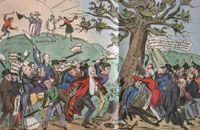
Arise ye Masses
|
|
1831
|
January 1831 opened with seven men transported by Bury Quarter Sessions for breaking a threshing machine at Withersfield. This agitation merged with the movement to reform the electoral system, and change, reform and an air of menace was in the air for the established farmers, parsons and general well to do of the country.
By 1831 it was widely accepted that the parliamentary electoral system was in complete disrepute. The House of Commons was composed of 658 members, of whom 513 represented England and Wales. There were two types of constituencies: counties and boroughs. County members were supposed to represent landholders, while Borough members were supposed to represent trade and commerce. In the Counties all male owners of freehold property or land worth at least forty shillings in a particular county were entitled to vote in that county. This requirement was known as the forty shilling freehold, and owners of property in several counties had several votes.
In the Boroughs the system which had grown up over centuries was totally haphazard. Wikipedia has listed the six main categories of Borough franchise as follows:
-
boroughs in which freemen were electors;
- boroughs in which the franchise was restricted to those paying scot and lot, a form of municipal taxation;
- boroughs in which only the ownership of a burgage property qualified a person to vote;
- boroughs in which only members of the corporation were electors (such boroughs were perhaps in every case "pocket boroughs", because council members were usually "in the pocket" of a wealthy patron);
- boroughs in which male householders were electors (these were usually known as "potwalloper boroughs", as the usual definition of a householder was a person able to boil a pot on their own hearth);
- boroughs in which freeholders of land had the right to vote.
In addition, many of the boroughs such as Dunwich were substantial settlements at the time of their original enfranchisement, but later went into decline. As a result they elected two MPs by only a few electors' votes, and these were often known as rotten boroughs. The rotten boroughs were lampooned in cartoons such as the one shown here. The system is shown as a rotten tree containing nests labelled Aldburgh, Dunwich, Orford, Yarmouth etc.. Not specifically shown was Sudbury, another notorious rotten borough lampooned later by Charles Dickens as Eatenswill. The caption read, "Reformers attack on the old rotten tree or the foul nests of the Cormorants in danger." Attempting to prop up the tree are the government led by the Duke of Wellington.
Bury St Edmunds would be regarded as a Pocket Borough, because only the Corporation could vote, and it was generally accepted that The Duke of Grafton controlled one seat and the Marquis of Bristol the other. Because they sometimes supported opposite opinions, Bury St Edmunds was not regarded as a particularly notorious example of a Pocket Borough.
Orbell Oakes continued to run the politics of Bury as his father had done, and at the May, 1831 General Election managed to get the Whig reforming candidate of the Fitzroys elected to one of Bury's two parliamentary seats. Only the 37 members of the Council could vote, and they had two votes available as there were two parliamentary seats. Earl Jermyn (anti-reform), got 23 votes and Colonel Charles Fitzroy (Reform) got 15, so they were both elected. Bennet (anti-reform) got 14 votes and Robert Rolfe, the much less well-connected of the two reform candidates, only got 2 votes. However the anti-reform candidate, Earl Jermyn, was elected with the most votes, and Philip Bennet of Rougham, also against reform, came a close third to Fitzroy. Bennet was peculiar in that he was supported by Benjamin Greene's Bury and Suffolk Herald newspaper, as a candidate for moderate reform, "approached with great care." Like Greene, he was anti-establishment towards the Bury Corporation, and in favour of helping the farm labourers but opposed catholic emancipation and most of the big issues of the Reform Movement. Such a closely contested election under the patronage system of the day was called a "most remarkable event" by the Bury and Norwich Post. If it were not for Orbell Oakes, the Tory corporation would never have elected a Whig who supported Catholic emancipation and other reforming ideas, most notably the widening of the right to vote.
Orbell Oakes lost a considerable source of influence and income when the posts of Receiver General for Taxes were abolished. Since 1822 he had held the post for East Suffolk as well as the West.
The Suffolk Yeomanry, mothballed in 1827, was re-formed in the face of all these issues. The original troop at Bury had been light dragoons, but were reformed as The First Troop of Heavy Dragoons. This cavalry unit lasted until 1875.
In the middle of 1831, Francis King Eagle came to live in Bury. He was already known for his liberal politics and attachment to reform. In that year the House of Lords rejected the Reform Bill, and meetings were held throughout the country to argue the case for the Bill. In October, Eagle addressed a meeting on this topic in Bury, and in November, a meeting at Stowmarket. Eagle also pursued other causes in Bury. He accused the coal merchants of selling coal at excessive profits, and accused the Guildhall Feoffees of renting out their lands too cheaply, and therefore breaking the terms of some endowments. None of this was proved or even generally believed, but it gave him a reforming profile in the town.
|
|
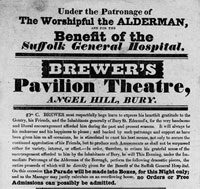
Brewer's Pavilion Theatre
|
|
blank |
This poster for a charity performance at the theatre was found in the papers of Neville Blackburne, the first Secretary of Theatre Management Ltd. It is a playbill for a performance at the Brewer's Pavilion Theatre, on the Angel Hill, Bury St Edmunds. Mr Brewer was showing his gratitude to his customers by holding a performance where the entire proceeds would go in aid of the Suffolk General Hospital. Charges were 2/- for a box, 1/- in the pit, and 6d in the gallery. The sum of 2/- is pronounced two shillings, and the decimal equivalent is 10p. However, in 1831 this sum represented a great deal more than it now appears. The performance is dated 31st October 1831.
By the Spring of 1831, Nathaniel Hodson was in the process of developing his new Botanic Garden site where the Abbey Gardens still are today. He quickly sold the lease of the old Botanic Gardens off the churchyard to Sir Thomas Gery Cullum, 7th Baronet, of Hardwick House. As he had hardly moved any of his specimens to the Abbey Gardens, he must have had an arrangement with Sir Thomas Cullum to let him clear the area in his own time. Cullum apparently intended to convert it to an ornamental cemetery to supplement the Churchyard.
Improvement works extended beyond the Abbey Gate, with planting on either side of the Abbey Gateway itself on the Angel Hill. The Corporation owned the land on the north side, and gave it up for planting so as to match the south side owned by the Marquis of Bristol.
Although the planting and layout were still far from complete, the subscribers were given free access to the new area during the Summer Assizes, and strangers could be admitted for the sum of one shilling. The ticket also covered admission to the old garden area, which was yet to be cleared, presumably again by agreement with Sir Thomas Cullum.
On 20th July, 1831 the Bury and Norwich Post gleefully reported that a band would be playing during the temporary opening period.
Work continued into the Autumn, and included changes to the ruins as well as the grounds. "Incumbrances upon the old Palace have been removed, by which the bases of the pillars in the interior of one apartment are exhibited in fine preservation, and the ancient remains are divested of some unsightly modern additions."
In addition a new entrance was created from the Abbey Grounds into the Churchyard. This would help the progress of transferring plant material from the old garden, but would be an amenity for visitors as well.
The move to a new site initiated a new stream of donations of plants and trees from local donors.
A further temporary opening period was allowed for the Bury Fair, held in October, 1831. Many fashionable and elegant new ladies were seen in the Gardens.
After the Fair was over attention turned to the entrance gateway on the Abbey Gate itself. By November the palisade was in place, and masons were engaged upon the stonework. For years there had been complaints about the existing unsightly gates, and the B & NP was looking forward to their replacement by something in character with the new ironwork.
By December the new layout for the Botanic Gardens was unveiled.
The central feature was a one acre circle of concentric beds based on the Royal Botanic Gardens in Brussels. The radii were intersected by a long walk from the Abbey Gate, and the area divided into 24 beds or compartments, eight of which formed an inner circle, leaving sixteen surrounded by a gravel walk. The remainder of the leased area would be devoted to beds for roses and ornamental plants, and for lawns and an arboretum.
Meanwhile a new house for Hodson was being built within the grounds. Today this house is known as Alwyne House, and by 2013 it is a private residence once again, having been a tearoom for a few years.
|
|
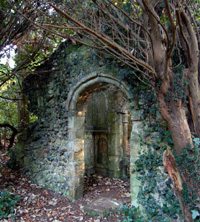
Church porch in Nowton Park
|
|
blank |
In order to widen the road at Honey Hill in Bury, the south porch of St Mary's church was removed. It seems to have ended up at Nowton Court, used as a garden folly, and can still be seen today near the larger pond.
|
|
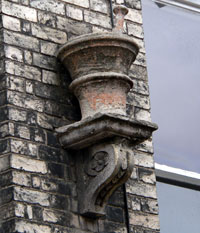
Burdon's Chemists sign
|
|
blank |
In Abbeygate Street in Bury the Chemist's shop of Nunn, Hinnell, Clark and Burdon was founded. Its sign was a large pestle and morter which can still be seen outside the premises today, which became called Leeson's Photographic shop.
|
|
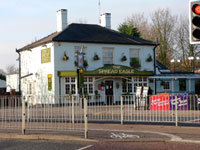
The Spread Eagle in 2005
|
|
blank |
The Spread Eagle inn in Out Westgate had a shaky birth when it was built by the Stamford Bridge. Local residents objected to it receiving a license as it would discomfort their walks in the countryside there, and increase the danger of "that most inconvenient bridge." The Magistrates refused it a full license, but could not prevent it trading as a beerhouse. It would get a full license in 1836. The Spread would become a useful drovers' inn, located as it was then, fairly isolated on the edge of town. The Spread Eagle today is a large and busy public house.
Bury's population was now 11,436 compared to 9,999 a decade earlier in 1821. They were made up of 2,429 families, and 141 were employed in agriculture, while 1,299 families were engaged in trade or manufacture. Some 989 families were classed as not comprised in either of these two classes of employment.
|
|
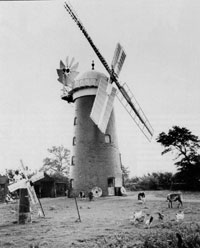
Pakenham Windmill |
|
blank |
At Pakenham the windmill was newly erected at 80 feet tall. It was renovated in 1961 to 1963, and is still working today. This mill was based on a brick built tower, and only the sails and topmost cowl would turn into the wind. This compares to medieval mills built of wood, where the whole mill would turn around a central post. Pakenham continued to have a working watermill in operation.
The 7th baronet Sir Thomas Gery Cullum, FRS, FSA, FLS, of Hardwick and Hawstead, died in 1831. Before succeeding to the baronetcy in 1785, he had been a doctor and surgeon, practising at 113 Northgate Street, Bury St Edmunds. He had also been responsible for many improvements to the River Lark navigation, which had been badly decayed until he took over its management in about 1807.
He was succeeded as 8th baronet by his oldest son, who also shared his name. The Reverend Sir Thomas Cullum, 8th baronet, also inherited his father's love of botany. He was vicar of Knettishall and chaplain to the Duke of Sussex. He would undertake some major improvements to Hardwick House and the estate, and continued to make improvements to the River Lark navigation. The Reverend Sir Thomas Gery Cullum, 8th baronet, liked to leave his mark on his achievements, and plaques with the legend "TGC 18??" can be seen on structures built by him.
|
|
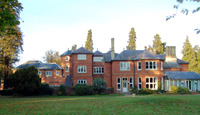
Nowton Court
|
|
1832
|
James Oakes, the Bury banker, local public figure and political fixer, had died in 1829.
His son, Orbell Oakes, bought the manor of Nowton and retired there to become a gentleman farmer and antiquarian. He had amalgamated the family's Bury and Suffolk Bank with Browne, Bevan and company to produce Oakes Bevan and co.. The family would retain an interest in the bank until 1899 when it was bought by the Capital and Counties Bank. Orbell continued his involvement in local affairs, perhaps more so than in his business affairs.
In June the popular support for reform of the voting system led to rallies and bonfire gatherings in Bury. The effigy of the Duke of Wellington, once a national hero, but now seen as the leading opponent of reform, was burnt by a crowd of 3,000. A Reform Festival and Dinner also went off peacefully, and the passing of the new laws seemed to promise a new era for many. The Feast was held at the King of Prussia in Southgate Street. Its skittle ground was festooned with flowers and banners to honour the occasion.
|
|
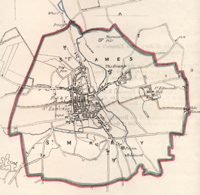
Commissioners' Report 1832 |
|
blank |
Before the Reform Bill was considered by Parliament, an assessment was required of the existing boundaries of Parliamentary constituencies, and their suitability for the future. Commissioners were appointed to draw up plans of existing boundaries and make proposals for any changes felt necessary. The number of existing electors was to be discovered and an assessment made of the likely numbers of householders who might become eligible to vote under the new proposals. The commissioners thought that about 719 householders, whose value was assessed as over £10, would now become qualified to vote. They thought that the current borough boundary was "in every way satisfactory: there can be no doubt that it should remain unchanged."
You can view the Report on Bury St Edmunds, brief as it was, by clicking on the thumbnail map adjacent.
The Great Reform Act of 1832 aimed to revolutionise British democracy. A uniform qualification of the £10 householder was introduced and the male head of such households was given the vote in the boroughs. Aldburgh, Dunwich and Orford all lost their MP's, as the smaller "rotten" and "pocket" boroughs were swept away. Eye was enlarged to include ten neighbouring parishes, and allowed to keep one MP. The franchise in Suffolk was widened from 6,200 voters in 1830 to 10,394 under the 1832 Act. At Bury, the old corporation of 37 members had previously selected and elected the two MP's for the town. Under the 1832 Act, the electorate was increased to about 600 men; rather fewer than estimated by the Commissioners. The 1835 Report of the Commissioners into the Borough of Bury St Edmunds stated that the number of Voters registered in 1832 was 560 householders and 30 Burgesses, or what we would know as members of the Borough Council.
The new constituencies were Bury St Edmunds, Suffolk Western, Suffolk East, Ipswich, Sudbury and Eye. Suffolk's MP's were reduced from 16 to 11, but Bury retained 2 MP's while Suffolk West had 2 and Suffolk East had 2. The boroughs of Ipswich and Sudbury had 2, while Eye had 1.
While the corporation of Bury now remained Tory as before, the majority of the 600 or so new voters in Bury were expected to support reform. The Fitzroy interest was Whig , and the Hervey interest remained Tory. They were challenged by a newcomer to town, Francis King Eagle, who stood as a Radical Reform Whig candidate in the 1832 General Election.
Benjamin Greene's Bury and Suffolk Herald embarked upon a campaign of vilifying King Eagle, a campaign later to result in a law suit.
|
|
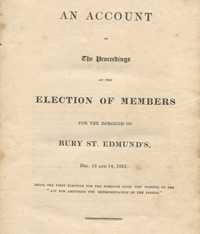
Election Account published 1833 |
|
blank |
New Parliamentary elections were held across the country in December of 1832. At Bury the locals were sure that the anti-reform Earl Jermyn would never get elected again, and the reformer, Francis King Eagle, was widely expected to sweep the board. Barristers came to town to make up the Register of those eligible to vote, and when the list was published, observers tried to judge the likely outcome. The Borough Recorder, Mr Rolfe immediately withdrew judging that he had too few votes. Even Eagle's supporters became deeply worried and tried to set up a coalition with Lord Charles Fitzroy, but Fitzroy was indifferent as there was judged to be no advantage to him personally.
Election Day was Tuesday 12th December, and a hustings and poll-booths were set up on the south side of the Concert Room, on the Market Hill. Today, this location is outside the art gallery entrance, on the site of Laura Ashley's shop. The candidates were proposed and on a show of hands it was declared that Lord Charles Fitzroy and Mr Eagle were elected. Earl Jermyn demanded a full poll, and under the provisions in the Act, this was adjourned to Thursday 14th December. The polling continued into Friday 15th December, but it was quickly clear that this arrangement was showing that Earl Jermyn was actually going to do better than Mr Eagle. The system was that each vote was recorded in a poll book, which was open to view. The poll was then published after the election. Many people deliberately held back their votes to see how the poll was going. They might then only vote for one candidate if he seemed to need as much help as possible.
In Bury there were 521 men who voted, and 42 others on the register did not vote. They could cast up to two votes as there were two seats available. Lord Charles Fitzroy gained 344 votes, Earl Jermyn gained 272 and Francis Eagle got 238. Eagle had narrowly lost to the usual Fitzroy and Jermyn combination when the poll was closed.
For all the fuss made, and all the hopes raised for change, the outcome of this reformed Bury election remained exactly as it had been under the old system. The result caused an uproar. Eagle accused Jermyn of electoral bribery by treating voters to gain goodwill. Disappointed crowds of Eagle supporters took to the streets in protest. Windows were broken and in Whiting Street, Mr Case fired his fowling piece from an upstairs window to disperse the crowds, but in the subsequent confrontations and fracas, he opened fire again and this time a few people were hit by shot. Philip James Case was a local attorney who was the Registrar of the Archdeaconry of Sudbury, and all the wills and records were kept in his house. As a member of the town corporation he was well known, and this may have attracted crowds to his house, as many others of the establishment had hidden themselves away to avoid trouble. Case, however felt he should defend the safety of his official records, and this may have led to the trouble. Eventually, Case and his family had to run out of the back way and give themselves up to arrest to prevent further violence, but even so, all their windows were broken, and the front door battered.
The official results were not declared until Saturday the 15th December, when the usual system was to chair the successful MP's around the town. However this idea was dropped for fear of provoking a further outburst from the disappointed backers of Francis Eagle.
The following Monday, Mr Case was up before the Magistrates, defended by Mr Wayman, the solicitor. The hearing lasted all week but resulted in Case being committed to the Assizes on £2,000 bail.
The new Suffolk West constituency elected Colonel Robert Rushbrooke, of Rushbrooke Hall, to Parliament.
|
|
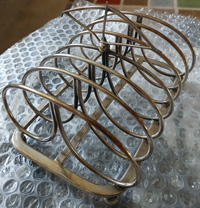
Archery Prize 1837 |
|
blank |
By Spring 1832 a letter to the Gardener's Magazine revealed that planting was still continuing at the new Botanic Garden in the Abbey Grounds, and considerable progress had been made in removing the plants from the old garden. Mr Hodson's new house was "in a forward state", and was "in very good keeping with the remains of the old buildings." Townsfolk were preparing to put up a cast iron fence on each side of the Abbey Gate.
Since 1826, Bury St Edmunds had enjoyed a Society of Archers. By 1832 they were allowed to hold tournaments in the Abbey Grounds. This was much to the distress of one of Hodson's subscribers, who complained about them in a letter to the press. It was generally held that they were an added attraction to visitors rather than a problem, and the complaint was dismissed.
Archery continued for some years. This picture shows a toast rack which was given as a prize in the archery contest of 1837. On the base it is engraved as follows:- "BURY St EDMUND'S ARCHERY PRIZE. 1837." This picture was supplied by Rob Jones.
In July 1832 there was a Report from the Parliamentary Select Committee on the silk trade. The evidence taken throws light upon silk manufacture in general but also provides evidence of the trade in Suffolk. Amongst the many Spitalfields and Macclesfield manufacturers questioned, were provincial makers like Mr Joseph Grout, resident of Middlesex, of Grout, Bayliss and Co silk manufacturers of Foster Lane, London, who gave this evidence:
Q: Where are your mills for winding and throwing your silk?
A: We have mills at Norwich, Great Yarmouth, Bungay and Mildenhall. We work them by steam and water power, 15HP by water and 116 HP powered by steam.
In the last twelve years Grout said he had kept manufacturing establishments in Norwich, North Walsham, Great Yarmouth, Bungay, Mildenhall, Saffron Walden, Bocking, Braintree, Sible Hedingham, Glasgow, Paisley, and Ponders End. In addition he had a "selling warehouse" in London, and a filature or reeling establishment in Bengal. It was not established what type of work was carried on at each of these places, or whether they were still in operation, but he had 1,587 hand looms for making silk crape standing still and idle. In 1826 the company had employed 3,500 people in Norfolk and Suffolk.
Grout made "every sort of crape, namely China, Italian and French. Silk imported was one third India, one third China and one third Italian. Silk was obtained from Bengal, in India, but was inferior to silk from France and Italy because of climatic differences.
By 1831 trade had fallen off to such a degree that Grout now employed only half the hands that he had in 1825. This depression began in "July 1826 when our ports were opened for the reception of foreign manufactures, and we, at once, lost a great part of our white and coloured trade. Every succeeding year it became worse and last year we had not a single loom going, with either white or coloured crape; whereas previous to the year 1826, we had in the Spring as many looms employed on on whites and colours as on blacks; so that full one half of our trade is lost."
Not only were half the workforce dismissed but those remaining were on starvation wages. "In 1822 we paid 12 shillings for weaving a piece,.. we now pay 7shillings." East Anglian silk workers had always been paid about two thirds of the rates at Spitalfields, but even these low rates were now much reduced.
Before 1826 the workers were "very respectable in their apparel", but now "many of them have sunk into a degraded and dissipated state."
|
|

Account of the 1832 Election |
|
1833
|
The controversy about the results of the 1832 election continued into 1833 at Bury. An account of the election together with copies of the electoral addresses and the speeches made, was printed and published by Walter Frost of Churchgate Street, in 1833. There was also a full account of the court case against Mr Case, which describes the disturbances after the election. The summary ended with the hope "that when the system gets into general operation, it may work more quietly".
Francis King Eagle threatened to petition against the election in which he had lost. By now Benjamin Greene disliked King Eagle more than he disliked the Bury Corporation, and he now defended the winning side against King Eagle.
|
|
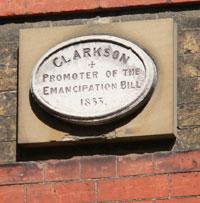
Clarkson memorial plaque |
|
blank |
As the emancipation of slaves drew closer, a second major anti-slavery meeting was held in Bury in February 1833. Again Benjamin Greene, the brewer, launched attacks on the personalities involved in the call for emancipation. The Reverend Cornelius Elven had attacked Greene for the scurrilous and anonymous pamphlets he had put out in 1830, and now said that Greene had been "convicted of deliberate falsehood", as he had never published any proof of his claims against the campaigners. This was carried in the Bury Post, a rival newspaper to Greene's, and he sued Johnson Gedge, its printer, for libel. The judgement of the judge was that although Greene had not made a deliberate falsehood, he had certainly committed a blatent libel. So Greene won on a technicality, but got only a farthing in damages, and had to pay his own costs. This ill-considered case brought by Greene caused him to finally lose all face with Bury people. Over the next three years he would decide to leave Bury, and hand over the brewery to one of his sons.
Slavery was now abolished in the British Empire. Slave owners were paid compensation by the government. Benjamin Greene the Bury brewer, owned 216 slaves on his St Kitts plantations and got £3,934 in government compensation. There was to be a period of transition frm slavery to freedom called apprenticeship lasting from 1834 to 1838. During this time Benjamin Buck Greene, son of the brewer, and in charge at St Kitts, would introduce mechanisation, and some Suffolk farming methods into St Kitts.
Thomas Clarkson was one of the pioneers of the anti-slavery movement and had been active in this field since the last century. He married William Buck's daughter Catherine in 1795. At first they farmed in the Lake District, becoming friends with the Wordsworths and Samuel Taylor Coleridge. In 1805 they returned to Bury to live in St Mary's Square. There is a memorial to him fixed to his house.
In 1833 Richard Payne made a survey of Bury, called "Particulars of the Lands in Bury St Edmunds". A new map was needed as Lenny's map of 1823 was already out of date. Payne's survey recorded a growing town, just about to expand dramatically beyond its ancient boundaries. His map would be published and printed in 1834.
William Steggles, the builder, was a major landlord at the time, owning more property than either the Guildhall Feoffment or the Corporation. Stables and haylofts for horses and carriages were as much in demand as housing. Steggles had just built 23 houses at Cannon Place.
Chalk Lane had a limekiln recorded by Payne, but Lenny had labelled it Waterloo Street in 1823. It seems that this name did not stick, despite the fact that Waterloo Terrace was built there in 1815, and the old name of Chalk Lane re-established itself.
Payne's survey also showed that a subscription library stood on part of the site where the Corn Exchange was built. William Ray, a well known local clock maker, had premises in Brentgovel Street. Looms Lane only had six houses, most of the land being used as back entrances to the grand houses on Angel Hill. The Greyhound inn on the Cornhill was rebuilt as the Suffolk Hotel. This would be altered again in 1873, but would remain as a well known hotel until 1996. The name Greyhound was re-used in the 1840's when a pub of this name opened in Eastgate Street. Payne also recorded that the Tollgate Inn was owned by Sir Thomas Cullum of Hardwick Manor at this time. The Tollgate, with its 30 acres of land, was used by Drovers from Norfolk coming in along the Thetford Road with sheep for market or the Sheep Fair held at Horringer. The River Lark was navigable to this point and there was a large Maltings just along the Fornham Road, so customers for the Tollgate were not lacking despite its out of town location.
Payne recorded a dozen maltsters in Bury. Two of the largest were Henry McL'Roth and Robert Maulkin. They owned 11 public houses between them, and 12 others were owner occupied. The brewers Greene and Braddock only owned 3 between them. Bury had 54 inns and public houses, and at this time only 20 of them did not brew their own beer on the premises.
Thomas Ridley had a drapers shop at 34 Abbeygate Street and a grocers' shop at number 35. The Suffolk General Hospital occupied one acre in Hospital Road, less than many of the gentry's homes occupied. There was a limekiln in Westgate Street, and two windmills stood on high ground near Mill Road.
The Paving Commissioners agreed that the firm of John Malam and Thomas Peckston should be allowed to bring Gas Lighting to the town. They would be allowed to lay down gaspipes to supply houses, and to put up Gas Lights in Abbeygate Street. Peckston now bought some land in the Tayfen to build the Gas Works on. This location was supposed to have once been used for public executions, being just outside the town wall. The firm would build the works over the next two years and would soon run into financial difficulties.
In 1833 Commissioners investigating the Municipal Corporations of England and Wales started to compile their report on Bury St Edmunds. It would be published in 1835 as part of the evidence leading to the Municipal Corporations Act of that year. It stated that Bury was a Borough by prescription, with privileges derived from various early charters, and confirmed by James I in 1606.
|
|
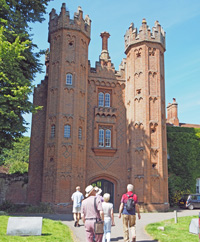
Deanery Tower in Hadleigh |
|
blank |
The Oxford movement in the Church of England advocated reviving certain Roman Catholic doctrines and rituals, and began with a conference in Hadleigh, Suffolk held at the Deanery. The Hadleigh Conference met in late July 1833 at Hadleigh , where Hugh James Rose was Rector. The conference held in the Deanery Tower led to agreement over the principles of the new movement: to proclaim the doctrine of the apostolic succession; the belief that it was sinful to give the laity a say in church affairs the need to make the Church more popular and, to protest against any attempts to disestablish the Anglican Church.
This attempt to stir the Established Church into new life arose among a group of spiritual leaders in Oriel College, Oxford. Prominent among them were John Henry Newman, John Keble, Richard Hurrell Froude, Charles Marriott, Edward Bouverie Pusey and Richard William Church. The Oxford movement has exerted a great influence, doctrinally, spiritually, and liturgically not only on the Church of England but also throughout the Anglican Communion.
From 1833, the state began to pay annual grants to the anglican National School Society and the non-conformist British and Foreign School Society, with the much larger National Society receiving a proportionally larger share. The grants increased over time, but they were accompanied by inspections and increasing demands from the state. The rigid monitorial system, though economical, would come to be viewed by inspectors as limited.
|
|
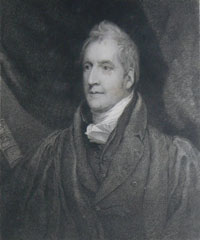
Richard Yates 1769-1834
|
|
1834
|
The Reverend Richard Yates died on August 24th, 1834. He was the author of the first major history of the Abbey of St Edmundsbury to be written in English, and published in 1805. He was born in Bury in 1769, his father having lived for 37 years in a house in the abbey ruins. He was educated at Bury School, and took his Divinity degree at Jesus College Cambridge in 1805. He always intended to add to his 1805 book, but nothing further was published until after his death, when J B Nichols published some additions to his work in 1843.
According to Nichols, Yates had been shown so much new material by Richard Gough after 1805, that the task of completing his history "appear almost to have overwhelmed him". "Previous to his lamented death he presented his materials to his friend Mr Nichols, who now possesses his collection."
|
|
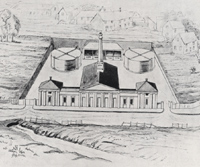
Gas Works in 1834 |
|
blank |
On January 11th, 1834, the Bury St Edmunds Paving, Lighting and Cleansing Commissioners made a contract with John Malam of Hull, and T S Peckston, for the erection of a Gas Works sufficient to supply gas to public lamps, and public and private buildings within the town. The contract provided for further provision as required by the commissioners, and would last for ten years from 1st October, 1834.
Thus, during 1834, Malam and Peckston's firm from Hull built the town of Bury a Gasworks on the edge of Tay Fen, in Tayfen Road. The works cost about £12,000 and were said to be built on the site where at one time criminals were executed. This privilege was also attributed to Thingoe Hill up to 1766. The firm had been allowed to lay down gaspipes to supply houses, and to put up Gas Lights in Abbeygate Street. The pressure was very low, but the improvement made by the gas lighting of the streets was dramatic.
Before 1834 there was no general pattern of local government. Towns like Bury, Ipswich, Sudbury and Thetford had been given the power to elect a corporation by Royal Charter at various times.
In 1811 the corporation had needed to obtain an Act of Parliament to establish Paving and Improvement Commissioners for the town.
Outside Bury St Edmunds, Suffolk was split into East and West with Quarter Sessions of Magistrates who dealt not just with the administration of justice, but also the police force, the coroner, bridges, the Lieutenancy and the Militia. The Quarter Sessions levied a rate on their constituent parishes. Each Parish had a vestry which dealt with the Poor Law, repair of roads (except turnpikes), vermin control and upkeep of the Church.
After the Napoleonic Wars, the massive unemployment caused by demobilisation led to the need for action. So the Poor Law Amendment Act was passed in 1834. Because of its Local Act status, the Borough of Bury St Edmunds was exempted from most of the provisions of the 1834 Poor Law Amendment Act. The parishes of St James and St Mary had already been united under joint Poor Law Guardians by a private Act of Parliament in 1847. The Borough's College Street union workhouse would continue until around 1880, when it closed it down.
Under the 1834 Act the old Overseers of the Poor and the Parish Workhouse were abolished. Parishes outside Bury St Edmunds were now grouped into unions to be run by elected Guardians Of the Poor in order to cope with their Poor Law duties. The new unions were given the power to build workhouses to provide "indoor relief" to the poor. The position in Suffolk was particularly bad, with up to half the population on some form of parish relief. Suffolk was divided into 18 Poor Law Unions. The Poor Law Reform Act served to cut the cost of relief, but at the expense of the poorest members of society. The Thingoe Union Workhouse was a local result of this reform, set up in Mill Lane, just off Hospital Road, in 1836. The national situation was overseen by the Poor Law Commissioners set up by the 1834 Act. Their secretary was Edwin Chadwick, a reforming young barrister.
|
|
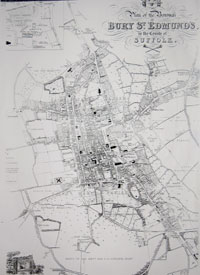
Richard Payne's Map |
|
blank |
In 1833 Richard Payne had surveyed Bury St Edmunds and he published his new town map in 1834. Payne's map of Bury St Edmunds shows the original layout of concentric beds in the Abbey Gardens. There are three concentric circles visible, intersected by paths which divide the circles into 24 beds. The new Botanic Gardens now carried the address, 'Botanic Gardens, Abbey Grounds'.
Unlike the two Warren's maps of 1747, and 1776, Payne places north at the top of the map. Prospect Row was a new street at this time on the site of what Lenny had called St Edmunds Place in his 1823 map. Over the previous dozen years or so, the population rose by about 15% and this growth had been mainly accommodated by infilling gardens and spaces by courts, yard or squares.
|
|
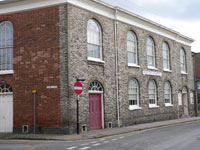
New Baptist Church
|
|
blank |
In 1834 the new Baptist Church was opened in Garland Street, replacing the 1800 one in Looms Lane and Lower Baxter Street, although the old churchyard can still be seen today at the foot of the Borough Offices car park. It was built by the firm of Steggles and can seat nearly 1,000 people. The Pastor, Cornelius Elvin, was responsible for the large increase in the congregation since he took over in 1823. This church is still in use today.
|
|
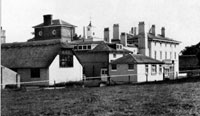
Chadacre Hall
|
|
blank |
Between 1823 and 1834 Thomas Hallifax, a rich London Goldsmith, had built Chadacre Hall at Shimpling. This seems to have replaced the Hall which the Plampin family had previously owned here. It became well known as an Agricultural College between 1918 and 1988. It is now largely demolished.
In Haverhill the old Quaker Meeting House had been in bad disrepair and by 1834, a new meeting house was finished in Quakers Lane, on the same land they had held since 1674.
The 1830's was generally a period of social reform, as well as political. In 1834 the practice of hanging the bodies of executed prisoners in a gibbet cage was officially abolished, although it was no longer in use. In 1832 the even more gruesome dissection and display of a murderer's body was already ended.
|
|
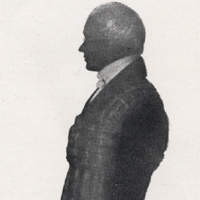
Robert Bevan
|
|
1835
|
By January 1835, Malam and Peckston's Bury St Edmunds Gas company became wound up after only a few months in existence, and so the gasworks were bought by the newly formed Bury St Edmunds Gas Light Company using finance lent by the Improvement Commissioners. The price was £6,000 in cash and £6,000 in fully paid shares in the new company, which T S Peckston now held. Peckston thus owned half of the new company, while Malam took the cash. Peckston also owned an interest in gas companies in Stowmarket, Beccles, Bungay, Lowestoft and Woodbridge. Despite his enthusiasm for this new technology, he over-reached himself and unfortunately he would become insolvent in about 1840.
Although Peckston owned half of the shares, the remainder were in local hands. There were 24 shares issued worth £500 each. The shareholders were as follows:
- T S Peckston----------- 12 shares
- Henry James Oakes------- 2 shares
- Robert Bevan------------ 2 shares
- George Moor------------- 2 shares
- Abraham Gall------------ 2 shares
- George John Hagget------ 1 share
- Francis George Probert-- 1 share
- William Groom----------- 1 share
- Mary Elizabeth Bullen--- 1 share
Oakes and Bevan were bankers, and Robert Bevan would eventually gain control of the gas company by 1849.
|
|
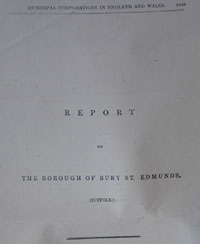
Commission Report on Bury St Edmunds
|
|
blank |
In 1835 the Commission into the Municipal Corporations in England and Wales published their Report. Each Borough had an individual section in the report, and the Report on the Borough of Bury St Edmunds was signed by George Long and John Buckle. The reports in general were scathing about the conduct of affairs in the Municipal Corporations, and that on Bury was no different.
The report is summarised below, but you can view the report on Bury St Edmunds in the original text by clicking here:
The 1835 Report on Bury St Edmunds.
The Charters of 1606 and later had defined the Corporation as the Alderman and Burgesses of Bury St Edmunds, in the County of Suffolk. The officers of the Corporation consisted of:
- An Alderman
- 6 Assistants
- 12 Capital Burgesses
- 24 Burgesses of the Common Council
- A Recorder
- A Town Clerk
- A Coroner
- 4 Serjeants at Mace
- A Receiver
- 2 Town Criers
- Up to 12 further Freemen
Those elegible to vote on the Corporation were the Alderman, the 12 Capital Burgesses, and the 24 Burgesses of the Common Council. A majority of each class had to be present to form a valid assembly.
These 37 members would vote for a new Alderman each year, but only the Capital Burgesses were eligible for the office. The practice had arisen of voting in each capital burgess in rotation.
In theory any burgess or inhabitant was eligible to be elected as a Capital Burgess, but the practice was to elect the most senior Common Councillor to become the new Capital Burgess.
Any inhabitant of the Borough was theoretically eligible for election as a Common Councillor.
The Burgesses of the Common Council were elected for life by the same 37 man electorate already described, but in practice the Alderman usually handpicked a friendly local tradesman to become a Councillor. However, the rivalries on the council frequently caused divisions and contests on these elections, and a successful candidate was then expected to pledge his vote and support to whoever introduced him to office.
The report noted a bias in favour of churchmen, as no dissenters had been elected. Nobody had been excluded for political reasons at Bury, but the Report said that "a bias exists in favour of persons whose political opinions coincide with those of the majority."
Any candidate had to agree to become a capital burgess if elected, which inevitably led to eventually to his election as Alderman, a job which entailed considerable time and expense. Thus only men of some means could take on office.
The Commissioners described the events of 1810 when 18 Members tried to block the election of the Alderman by absenting themselves, not for differences of political opinion or public principle, but to secure for themselves the advantages accrueing from the corporate privileges.
A similar event occurred in 1817 when the capital burgesses seceded from the assembly to prevent a junior common councillor being elected as a capital burgess.
Before 1832 and the Reform Act, it was also customary to exclude from consideration for election as a common council member any tradesman who was in competition with an existing Member of the Council. When the Commissioners examined Bury Borough Council in 1833, the Alderman was the bookseller, John Deck. Deck himself claimed that his own election had been delayed because there was another bookseller on the Council. The report noted with satisfaction that the 1832 Act had already stopped some of these abuses.
However, the Commissioners said that "these elections do not seem to have been directed or influenced by the public feeling of the town, and latterly invitations to join the corporation have been declined by many respectable inhabitants. The town clerk has refused to become a Member while the system of self-election continues; and the same objection seems to be felt by others."
Officers of the corporation become Freemen upon election to office. Every attorney admitted to practise in the borough court of record also becomes an admitted Freeman of the Borough. The town clerk told the Commission that in the past their had been a large body of Freemen, entitled to the privilege by birth and apprenticeship. The inhabitants at large were thus currently not being admitted to the freedom of the borough. The commissioners judged that:
"The management of all corporate concerns has passed into the hands of a select body of its members, from which the assistants are excluded." This select body governed all the elections, and alone had power to remove the officers of the council. "It claims and exercises the the power of making orders and bye laws,..... exercises the patronage of the corporation, and has the sole and uncontrolled management of its property and finances."
Reference was also made to the practice of allowing the Duke of Grafton and the Earl of Bristol, each to nominate one of the two MP's for the town, despite the political preferences of the townspeople. This had been stopped by the Reform Act of 1832, but had been justified by the "select body" of councillors on the grounds of the money their lordships spent in the town and the charitable donations made to the town. The commission felt that such money and favours had not been fairly spread about the town.
Thus the Commission found that a few unrepresentative individuals had in effect taken over the powers and privileges of the corporation. This self elected body apponted the magistrates and the officers of the council, as well as the Freemen, and that posts that are by charter open to all the inhabitants of the borough were "exclusively conferred on the personal friends and adherents of the alderman, or on some influential member of their own body." Members were mostly tradesmen of the town and they "were looking to the corporate offices as sources of increased custom to their shops." "Their votes were bartered with peers of the realm for the custom and patronage of their houses." "The public feeling of the town was expressed in favour of municipal reform; and, we may add, that the present chief magistrate, with some other members of the select body, are prepared to welcome its introduction."
Thus did the Municipal Corporations Act of 1835 introduce the first elements of democracy into local government in Bury St Edmunds and the rest of England and Wales. In Bury the old council was dissolved and the town was divided into 3 wards and new elections were held. The new Council would be made up of a Mayor Recorder, 6 Aldermen and 18 Councillors. The Councillors were to be elected by the ratepayers in their wards, and the Council could elect the Aldermen and the Mayor. The Magistrates were now separated from the Corporation, which was, however, still responsible for policing matters.
Non-conformists could at last be elected to the Corporation.
The old corporation was substantially in debt and the last Alderman, Abraham Gall, (1835-36) actually refused to hand over the insignia and plate to the new Council. Gall wanted to sell the assets to pay off the old corporation's debts. Eventually a judgement was obtained to enforce this transfer.
By 1835, Nathaniel Hodson was suffering from a shortage of funds in the running of his new Botanic Garden within what we now call the Abbey Gardens. He had not been able to obtain as many subscribers as he had hoped, and so the original 2 guineas a year subscription fee had failed to raise enough money.
In order to encourage more visitors, and to widen the garden's attractiveness, Hodson introduced a menagerie into the botanic gardens. As well as rabbits, guinea pigs and varieties of pheasants, the wildfowl, which still delight children today, were introduced on to the river. However, Hodson included a pair of spoonbills and a stork, as well as the ducks and geese. Many of these were caged, but some could roam freely in the park.
Oddly enough it is the menagerie which survives to the present day, while the once strictly scientific Botanic Garden is now completely given over to ornamental planting.
In 1830 the Beerhouses Act had allowed anybody to sell beer on their premises on payment of a fee. This gave old established inns a new source of competition. In 1835 the Queens Head in Churchgate Street was acquired by John Cocksedge, who rebuilt the old inn, and added a Gin Palace to its attractions. Luring people away from gin had been one of the aims of the Beerhouses Act, and the licensing committee did not like this innovation at all. However the objectors only succeeded in putting off other inns from following suit, and gin was sold at the Queens Head Gin Palace until 1872.
|
|
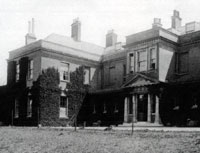
Ousden Hall improvements 1836
|
|
blank |
Ousden Hall and manor had been bought by the Reverend James Thomas Hand in 1804. The Reverend Hand died in 1835, and the estate passed to his nephew, Thomas James Ireland. Ireland set about improving the hall to modern standards. He engaged Thomas Rickman in 1835 to build a square bay over the north portico, and a pedimented portico on the west front, along with other 19th century features. After these improvements, which extended into 1836, Ireland was reported to have entertained the King, William IV, when he attended race meetings at Newmarket. Unfortunately, this royal connection would soon end with the death of the king in June 1837. Ireland himself held Ousden until his own death in 1863. Ousden would be up for sale again in 1864.
|
|
1836
|
On 1st January, 1836, the reformed Borough Council of Bury St Edmunds took office under the first Mayor since the brief Mayoral period of 1684 to 1688. The town had only previously had a Mayor for the years of 1684 to 1688 when the King had taken over control of the membership of the corporation. The post had been called Alderman for most of its existence. The Mayor would now replace the Alderman as the town's first citizen from 1836 onwards, and be elected to serve from November to November. The first Mayor after the 1835 Act was Francis King Eagle who had been the local radical candidate following the Great Reform Act of 1832. The new Mayoral year was to start on 9th November, so Eagle would be replaced by Charles Leech on 9th November 1836.
The 1835 Municipal Corporation Act had imposed a duty on borough councils to establish a police force if they had no existing arrangements in place. The Act gave borough watch committees both in theory and practice absolute power over the chief constable.
On police matters the new Bury St Edmunds council's Watch Committee had clear views. In February, 1836, a Police Force was formed for the Borough to replace the constables previously appointed by the Court Leet.
One of the rooms in Moyse's Hall was refurbished to provide Bury with its first official Police Station, or Station House. The Borough Police replaced the old ward constables, and was started with a Superintendent, Richard Coney, and five constables for the daytime and six for the nights. (Both Ipswich and Sudbury also set up borough police forces in 1836.)
On 4th March, 1836 King William IV signed a charter giving the Borough of Bury St Edmunds the right to hold separate Quarter Sessions of the Peace.
Between 1833 and 1848 the Society for the Diffusion of Useful Knowledge published a series of articles on Historic Towns in 'The Penny Magazine'. An article in 1836 on Bury St Edmunds gave a snapshot of the town at the time, including the following;-
"The exclusive criminal jurisdiction over the whole town and one mile round it, which was granted to the Abbot of Bury by King Edmund, son of Edward the Elder, and is now vested in the corporation, ceases under the Municipal Corporation Act from the 1st of May, 1836. The borough Courts are a court of sessions, a civil court called the court of record, a court-leet, and a court of Pie-poudre. The sessions are held three times a year, in February, June, and November, and as the county assizes are held within the town there are annually five gaol deliveries. Petty sessions are held every Thursday, and are very well attended by the magistrates. The court of record is held once a month, and embraces all pleas where the cause of action has arisen within the precincts of the borough and the damages do not exceed £200.
A court-leet is held once a year. There is also the court of the steward of the liberty, called the 'Much Court,' which is held once in every three weeks before the town-clerk, but which is limited to debts under 40 shillings.
The town is watched by night, and has an efficient police. The borough gaol has not been used since 1805. The prisoners are all confined in the county gaol which is within the precincts of the town.
The town of Bury is pleasantly situated on the river Larke, and from its delightful walks, clean streets, and well built houses, and from the urbanity of its inhabitants, forms as pleasant a country residence as any small town we know of.
There is a subscription library, which contains a valuable collection of books, and four circulating libraries. The new subscription rooms on Angel Hill are very handsome and contain a well proportioned ball-room, card-rooms, billiard-room, &c. There is also a subscription coffee-room and billiard-room. A new theatre was built in 1819, and the old one has been converted into a concert-room. The entrance to the botanic garden is through the abbey gate, and the walls that surround it are part of the old walls of the monastery. The river Larke flows, at the bottom of the garden. The collection of exotic plants, which is already pretty good, is rapidly increasing.
The Shire Hall, a neat modern building, is situated on the ancient site of St. Margaret's church, and contains two good-sized courts, which have but one inconvenience, that is, having no internal communication. The Guild-hall, where the borough-courts are held, is a handsome structure, built of flint and freestone.
The County Gaol, about half a mile from the south end of the town, is built on the radiating principle, and is surrounded by a wall twenty feet high, inclosing an octagonal area, the diameter of which is 292 feet. The keeper's house, which is an octagon and stands in the centre, is so elevated above the rest that from his windows he can command the whole building. In the centre of his house is a chapel, divided off into numerous partitions, so that the different classes into which the prisoners are divided and subdivided are kept separate and cannot even see each other. Upon the whole, for its accommodations and internal regulations, this gaol is one of the best in the kingdom. Two tread-mills have lately been added to it. The house of correction is near the gaol, and is equally well managed, being under the superintendence of the same keeper. It at present only contains female prisoners, all the men being confined in the gaol.
Part of the town is well paved, but the principal streets are Macadamized. It is well lighted, and has a sufficient supply of water. About a mile from the town the river Larke becomes navigable to Lynn, whence coals and other commodities are brought in small barges. The market-days are Wednesday and Saturday ; the latter for meat and poultry, the former for corn, &c. Fairs are held on the Tuesday in Easter week, and on the 1st of October and 1st of December, for horses, cattle, cheese, &c. But the great fair, which is justly celebrated, generally commences about the 10th of October, and lasts about three weeks.
The Grammar-school, which is a neat modern building, with a commodious house adjoining it for the master, was founded by King Edward VI, whose bust is placed over the door with an appropriate inscription. It has four exhibitions of £20 each, and two of £25 each per annum, to either of the universities, a scholarship at Corpus Christi, and another at Jesus-college, Cambridge. A new school-house has lately been erected. There are now about 100 boys on the foundation.
Bury also possesses three charity-schools, in one of which forty boys, and in another fifty girls are instructed and clothed. They are supported partly by subscription and partly by an endowment of £70 per annum ; as well as two Lancasterian schools, one for boys, the other for girls, established in 1811.
( Note: Joseph Lancaster, a Quaker, published an account of his educational work in 1803 called "Improvements in education as it respects the industrial classes of the community".
Joseph Lancaster had found that at his 'Lancasterian School' in Southwark one 'teacher' could teach say five boys one item of knowledge in reading, writing or arithmetic. These five boys would teach another five. These would teach five more. He also adopted use of the slate and slate pencil to replace costly pen, ink and paper. In this way education could be provided very economically, and each boy paid 1p per week.
Financial difficulties led in 1808 to the schools being taken over by a non-conformist group who formed the Society for Promoting the Royal British or Lancasterian System for the Education of the Poor ( renamed in 1814 as the British and Foreign School Society or BFSS). )
(There are) 98 almshouses, founded by different persons, amongst whom the principal benefactors were Mr. Edmund King and Mrs. Margaret Drury. They are under the superintendence of trustees, and their funds altogether amount to about £2000 per annum. Poley Clopton, M.D., founded an hospital (called Clopton, after the founder) for the support of six aged widowers and widows, and endowed it with property worth £200 per annum. It is a neat brick building, with the arms of the founder over the principal entrance. A large erection, built by government for an ordnance depot, has been purchased and converted into a general hospital, which is supported voluntary contributions, and now contains about forty patients.
There is a Roman Catholic chapel, a place of worship for Baptists, the society of Friends, Methodists, and Unitarians, and two for Independents. A mechanics' institute has recently been established."
The article in the Penny Magazine included the many facts listed above.
|
|
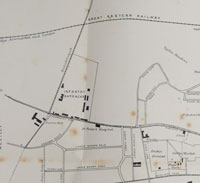
Beetons Footpath
|
|
blank |
The King Edward VI Grammar School in Bury St Edmunds at this time owned some 113 acres of land in the town arising from endowments made to it over the years. In 1836 the Bury Post and the Suffolk Herald contained an announcement by the school asking for tenders for letting of the St Peter's Barn Farm in Bury amounting to 94 acres and 2 rods. This was the main holding of the school in the town, and was currently occupied by Mr George Beeton who wished to give up his tenancy. This land included sites later occupied by the Gibralter Barracks and crossed by the railway line. The Borough boundary was marked by a footpath through this farm which was called Beeton's Footpath and is still known today as an important road called Beeton's Way.
In the event, Mr Beeton continued as the tenant of St Peter's Barn Farm.
Politics and Inns went together in the 19th century. In Bury the Reform Club met at the Black Boy in Guildhall Street. This old inn dates back to at least the 17th century. In 1836 it was big enough to host a Reform Club meeting when 200 people attended. At election times such inns were decorated up in their favoured candidates colours, and "treating" of voters on polling day was commonplace.
Although the Brewery of Greene King is a massive enterprise in 2005, it was still a relatively small and uncertain affair in 1836. Benjamin Greene, its founder, handed over the brewery to his third son Edward, (1815-1891), when he reached 21 in this year. His eldest son, Benjamin Buck Greene (1808-1902), was in the West Indies running the family sugar estate, and his second son John Greene (1810-1867), was a local solicitor. Charles (1821-1840), and William Greene, (1824-1881) were still young, but would also go to the West indies.
Benjamin was 56 years old at this time, but wanted to pursue a career as a merchant in London, and devote more time to his West Indies business ventures, which he acquired around 1825. He did not see brewing as the best way to make a vast fortune at this time, and in any case, he had rather fallen out with Bury society over the slavery issue, and his largely unfounded attacks upon other local notables. Edward did not get the brewery for nothing. Everything was itemised and valued, and he had to pay his father the full value over a nine year period. Within 25 years Edward would demonstrate that good management could transform the brewery's business fortunes.
In 1836 he began by installing a small Cornish-type steam engine in the brewery to circulate the brewing liquors more efficiently. This engine was still working in the 1920's.
The new council found that the old corporation had, as usual, farmed the markets and fairs, and they were bound by the terms of the existing lease, which did not expire until 1849. The chain of office made in 1805 had its medallion replaced with a bust of William IV.
|
|
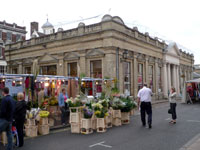
The Corn Exchange of 1836
|
|
blank |
By now the ground floor used as a corn market in the Market Cross building at Bury was too small for the numbers attending, and a new building was necessary.
So a new corn exchange was built just south of the old one, now the site of the Laura Ashley store, to replace it. The concert hall upstairs in that Robert Adam building we now call the Market Cross, was left alone. The old exchange floor downstairs was enclosed for council offices by 1840. It would soon became called the Town Hall. The new building was used as a Corn Exchange until replaced by today's Corn Exchange on the adjacent site in 1862.
The Thingoe Union WorkHouse was built in Mill Lane during 1835 to 1836 nearby the hospital on an 8 acre site, to house 300 paupers, at a cost of £6,000. It was a result of the Poor Law Reform Act of 1834. The Thingoe Union comprised 46 parishes which had elected to join the union. These included the 18 parishes of the Thingoe Hundred. Places like Chevington who had supported their own poor in the parish workhouse, now had to send the paupers to the Union Workhouse in Bury where they had to live amongst strangers.
|
|
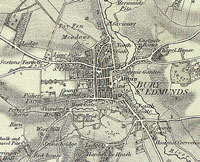
First one inch maps Suffolk
|
|
blank |
The first one-inch ordnance survey maps of Suffolk were published in June, 1836. This was an enormous step forward for government, both local and national, as well as for landowners, travellers and the general public, to be able to visualise their local areas and their surroundings.
You can click on the thumbnail to view much more of the area around Bury St Edmunds.
This map is based on data provided through www.VisionofBritain.org.uk and uses historical material which is copyright of the Great Britain Historical GIS Project and the University of Portsmouth.
You can view more historical maps by clicking on this link:- www.VisionofBritain.org.uk
From 1836 to 1858 the Bury Borough Council gradually acquired more land on St Andrews Street South for the cattle market and fairs.
The first railway was planned for Suffolk by the formation of the Grand Eastern Counties Railway. No track would actually be built in Suffolk until 1844.
|
|
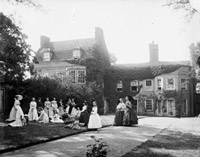
The real girls school |
|
blank |
It was into this environment that Charles Dickens placed his fictional character Mr Pickwick, in his book "The Pickwick Papers". From March 1836, the Pickwick Papers were written and published in 20 monthly instalments ending in October 1837. In the book Pickwick stays at the Angel Hotel in Bury St Edmunds, has an adventure at a girls school, sometimes said to be where the Nuffield Hospital remains today, and witnesses an election at Eatanswill, reputed to refer to Sudbury, a notorious Rotten Borough of the day. Although Dickens placed the girls school in Westgate Street, the actual school described seems to have been at 42 Southgate Street, by St Botolphs Lane.
|
|
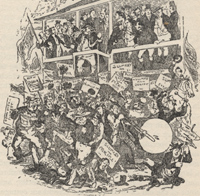
Eatanswill, drawn by 'Phiz'
|
|
blank |
The rotten borough of Eatanswill is described in Chapters 13 to 15. From there Pickwick travels to Bury in Chapter 16, where he quickly arrives at Miss Tomkins boarding school, "just outside the town," called in the book, the Westgate House Establishment for Young Ladies. By Chapter 19 he has left Bury.
To liven up the text the first two monthly issues were illustrated by R Seymour. After Seymour committed suicide, his place was taken by Hablot K Browne, who used the name "Phiz". Browne was educated at Botesdale Grammar School, in buildings which had until 1561 been St Botolph's chapel. This school would be closed in 1878, and the building returned to its use as a chapel.
In 1836 the Tithe Commutation Act was passed which ended the practice of delivering one tenth of all agricultural produce to the titheowner, who was often the local parson. Hitherto this delivery had to be carried out on harvest day, resulting in all sorts of difficulties and evasions. Without this Act the practice of tithing may well have died out under the weight of its own encumbrances. This Act did drop any attempts to continue with personal tithes, but continued the burden on agricultural producers by placing a valuation upon land which resulted in an annual cash payment called the Tithe Rentcharge.
In many ways this was a worse burden on farmers as they had to find the rental payment whatever the state of the harvest, or the effort of the farmer. What was worse was that with an increasing number of religious denominations, they could not accept that the fruits of their labours should go only to the Church of England parson.
So efficiently was the new system imposed, that it continued in England well into the 20th century while most other countries had dropped tithing by about 1900.
|
|
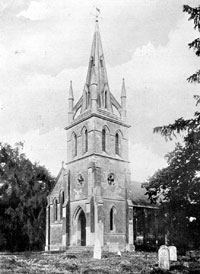
Westley Church
|
|
blank |
At Westley the new parish church of St Mary's was completed after a two year building project. The old church of St Thomas a Becket was apparently beyond repair. It had suffered severe storm damage in the 18th century, and had been in a long slow decline ever since. The new church was built on a more prominent site. It was unique at the time for a Church of England building in that it was built of concrete, with a cast iron roof, and was part funded by the Marquess of Bristol. He gave the land and £600 towards the £1,400 bill. It was built with a spire above the tower, which could be seen from Ickworth House. This spire was removed in 1961.
The architect and builder who constructed the new church was William Ranger of Brighton. He had patented a form of concrete known as Ranger's Artificial Stone in 1832, and by 1834 he was using it to produce pre-formed blocks. Both his blocks and liquid concrete were used at Westley. The roof was clad with slate, but supported by cast-iron hammer beam trusses, which was another new feature for the time.
|
|
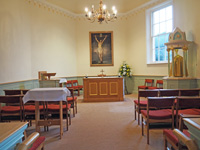
Existing catholic chapel
|
|
blank |
Meanwhile there was some disquiet expressed in the local press because the Roman Catholic congregation in Bury St Edmunds were planning to build a new church. Catholic worship had been made legal in 1791, and the tiny chapel in Westgate Street was bursting at the seams. The Bury and Norwich Post and Suffolk Herald 6 April 1836 referred to the external construction and funding of the new Church. It also highlighted the disquiet around that time from opponents of the Faith:
‘A number of immense blocks of Ketton stone (many of them weighing 3 – 4 tons each) have been put on barges at Wansford to be used in building a large Catholic Church at Bury St Edmunds. We believe that the expense of this edifice is defrayed from the general fund for the creation of Catholic Chapels upon which every town has a claim in its turn. This fact may serve to quiet the alarms of some of those persons who see in every announcement of a new Catholic place of worship the approach to the restoration of ‘Popish’ supremacy in this Country........."
The paper goes on to attempt to alleviate its readers fears as follows:
"Supposing that there be 510 R C Chapels, each having a congregation of 300 persons on the average, the total will not amount to a hundredth part of the population, notwithstanding the constant immigration of Irish poor. These fears of the spread of Popery, and the perpetual hankerings after the interposition of the secular arm, are wretched complements to the Protestant Church with its endowed Ministers posted in every parish.’
In December 1836, the Bury Maltster, Robert Maulkin had to sell the contents of his house on St Mary's Square to raise cash to pay off some of his mortgages and other debts. In 1834 the family had felt they needed to set up a trust to ensure the financial survival of his wife and family, safe from creditors. Robert was persuaded to go off and live out of harm's way at Brinkley Grove, and take on George Beeton to run the Malting business as a partner.
|
|
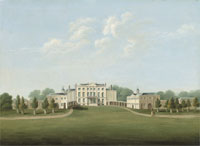
Livermere Hall
|
|
blank |
In 1836 the owner of Livermere Hall in Little Livermere, was Nathaniel Lee Acton, who had inherited the estate from his uncle, Baptist Lee, in 1768. Nathaniel had made some alterations to the hall over his tenure, and this picture appears to have been painted for him, to include the latest state of the improvements. After Nathaniel's demise, the estate passed to his elder sister. She would also die within a few months, when the estate would again pass on. This time it went to his younger sister, Hariott. She was the widow of Sir William Fowle Middleton, first baronet. From Harriot the estate would then pass to the second baronet, Sir William Fowle Fowle Middleton.
|
|
1837
|
Queen Victoria was to be the last of the House of Hanover, but she ruled for 64 years over an era of unprecedented expansion. Meanwhile, epidemics of influenza and typhoid ravaged London. The consequences of illness pushed up the cost of Poor Relief. The Poor Law Commission set Edwin Chadwick to write a report on the matter.
|
|
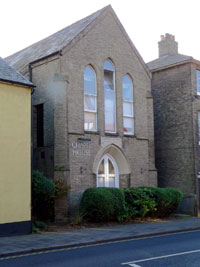
Rehoboth Chapel Westgate Street
|
|
blank |
Following a dispute with their pastor, Cornelius Elven, about 30 members of the Baptist Church left and set up their own Rehoboth Congregation. They set about creating their own chapel in Westgate Street, which was ready for worship by 1840. Elven was brought up a Congregationalist but had joined the Ebenezer Baptist congregation following his own bible studies. He became their Pastor in 1823, and was responsible for gaining a great number of new worshippers, to the extent of needing to move to a new chapel in Garland Street. He was a liberal Baptist, and the breakaway group desired a stricter form of worship.
Around this time, in the 1830's, several of the dissenting groups reformed new congregations. A few years earlier some Congregationalists left to set up the Chapel at the bottom of Northgate Street.
The old brewery of Stutter and Gallant in Guildhall Street had closed in 1829. It was now reopened by Henry Everard.
In 1837, the Greenes' first son, Benjamin Buck Greene, returned from their sugar planations in St Kitts, and was replaced by their 4th son, Charles, who was only 16 at the time. All the sons of the Bury Brewer Benjamin Greene, had been educated at the Grammar School in Bury. Charles was to die of Yellow Fever, in 1840, aged barely 19, but he had also succumbed to the West Indies planters' lifestyle, leaving 13 illegitimate children on the island.
When Queen Victoria came to the throne Haverhill was largely poverty stricken. The majority of the population were illiterate, working either on the land or on hand looms in their own homes. Housing was insanitary for the labouring classes, lacking running water or proper drainage. Local affairs were run by the Parish Vestry whose main business was administration of the Poor Laws. Streets were unpaved and unlit.
|
|
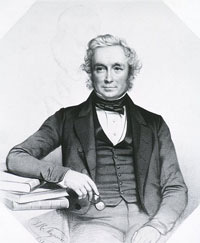
Revd Henslow in 1851
|
|
blank |
In 1837, John Stevens Henslow, who was Professor of Botany at Cambridge University, was appointed
the rector of Hitcham in Suffolk. Charles Darwin had become one of Henslow’s students in 1828 and in 1831 Henslow had proposed and sponsored Darwin to join HMS Beagle as a naturalist to accompany a naval survey of South American waters. Hitcham was a small parish in Cosford Hundred, but it was to provide Henslow with a generous and reliable income. This new living gave him an income of £1040 a year, together with 40 acres of glebe land. This compared with the £200 odd that he had been receiving for his Cambridge professorships.
In 1839 he moved his family to Hitcham and he lived permanently in Hitcham Rectory from 1839 until his death there in 1861, aged 65. After his death one obituary described the state of Hitcham when Henslow arrived there.
Hitcham was,
"a populous, remote and woefully neglected parish, where the inhabitants, with regard to food and clothing and the means of observing the decencies of life, were far below the average scale of the peasant class in England".
Despite his many commitments in Cambridge, Henslow set about improving local village life by practical means. He soon set up a Hitcham village school, a coal club, a clothing club and a Wives Society. He introduced allotments and set up the Hitcham Labourers' and Mechanics' Horticultural Society as his way of educating the working men of the parish.
In November 1837, the Pickwick Papers were first published in book format, having previously been issued in 20 more or less monthly instalments, as a magazine.
|
|
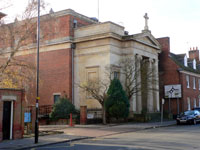
Roman Catholic Church
|
|
1838
|
During 1836 and 1837 the Roman Catholic Church of St Edmund was built in Westgate Street in Bury, to replace the overcrowded chapel adjacent. It was built in the Greek revival style, and dedicated on 14th December, 1837. In 1844 White's Directory would refer to it as a small, neat building. The local catholic congregation was founded by the Jesuit priest, John Gage, in the 1760's, initially using the private chapel at the rear of Westgate Street.
The Theatre Royal had been badly lit since it opened, but this year it was given the benefit of gas lights. Heating was still by open fires, and it was notoriously cold and draughty.
|
|
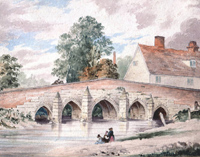
Eastgate Bridge
|
|
blank |
The old Eastgate Bridge was pulled down in 1838. This picture is dated 1840, by which time this bridge no longer existed. It is signed "J C.d.", and was sold on Ebay in September, 2008. According to Horace Barker there was a ducking chair located nearby. The East Gate itself had long gone, pulled down in 1763. The current bridge was built in its place, but not completed until 1840. Some alternative arrangements must have been in place while the bridge was being replaced.
|
|
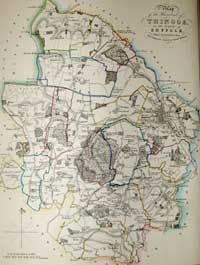
Extent of Thingoe Hundred 1838
|
|
blank |
In 1838 John Deck of Bury published the work by John Gage entitled "History and Antiquities of Suffolk, Thingoe Hundred". This was a review of all the estates around Bury within the Hundred of Thingoe. This area contained 18 parishes and would survive as an administrative unit as Thingoe Rural District Council until 1974.
|
|
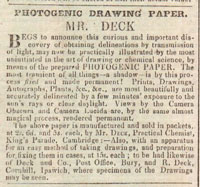
Photogenic paper
|
|
blank |
Although Deck was a bookseller and post office, he also branched out into the related fields of a stationer. This advertisement from 1839 is for what was called photogenic paper. This was light sensitive paper which could be used to record the shape of an object placed on the paper and exposed to sunlight. The development of photography would soon follow.
The death knell of the mail coach came in 1838 when the contract to deliver the mails was given to the railways. As each line was completed the mail contract was to be handed over to the railway company. The London to Norwich mail coach would survive until 1846, but hundreds of businesses and thousands of people would lose their livings over the next few years as passengers and goods transferred to the railway. The network of stageing inns every ten miles or so would lose their reason for being, along with horsemen, coach builders, maintenance men, drivers and conductors.
In 1838 the Camden Society produced the first of a series of publications of historical documents. This series of publications has continued to the present day, and would include several works of interest to our area. The first of these would come in 1840, when the Chronicles of Jocelin of Brakelond were first published.
|
|
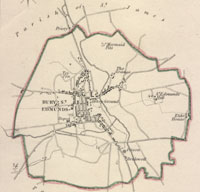
Bury c 1839
|
|
1839
|
This plan of Bury St Edmunds was published in 1840 in the book, "View of the Representative History of England and Wales", by S Lewis. It is a very small scale map in the original, but gives some idea of the extent of the town at this time.
At Nowton, Orbell Oakes had died in 1837. His son, Henry, decided to modernise the house at Nowton. By 1839 Henry Oakes had the house rebuilt in a mock Tudor style by George Russell French, and renamed it Nowton Court. This house survives today as Heritage Wellbeing, owned by Euronite. (For some years before this it was the British home of the Keio University of Tokyo, and while in residence here the university digitised the Bury Bible.)
The Reverend Sir Thomas Cullum, 8th baronet of Hardwick and Hawstead, also enlarged Hardwick House, adding embattlements and crenellations. He laid out extravagant gardens as well. In 1834 he had built the Swiss Cottage, also called Dairy Cottage, in Home Farm Lane following a trip to Switzerland. This house can still be seen today in what has now become a smart suburban street.
Sir Thomas Cullum had no sons, and neither did his brother, John Palmer Cullum. The baronetcy would become extinct in 1855, on Sir Thomas's death.
According to a Bury Guide of 1867, "Near the Risby Gate stood a chantry called Stone Chapel, remarkable for its curious flint stone walls. For many years (it was) held as the Cock public house, taken down in 1839 and rebuilt with white brick." By 1849 the Cock would be renamed the Grapes, as part of an attempt to escape its bad reputation for drunkenness. The Grapes still survives as a public house on the corner of St Andrews Street and Brentgovel Street in 2005.
William Greene, fifth son of Benjamin Greene, went to St Kitts at the age of only 15, to help his brother Charles run the estates. Charles himself was only 18, and would die of Yellow Fever inside a year.
During the 1830's the Great Bustard became extinct in the Breckland, partly as a result of agricultural improvements since 1812. The Pine belts had become established by now, and much of the hitherto great open landscape now appeared more enclosed.
Some of these great "improvements" had taken place on the Culford Estate which, since 1824, had been owned by the wealthy Richard Benyon de Beauvoir, who had diverted roads, planted trees, and tried to make the estate efficient and well ordered. By emparking the area around Culford Hall itself he imposed a new order on the landscape.
Richard Benyon rarely visited Culford and in 1839 he granted a life tenancy of Culford Hall to his nephew the Reverend Edward Richard Benyon. Edward might have been the joint owner of the Benyon fortune, but for the fact that he was born out of wedlock. Edward enthusiastically took over the management of the Culford Estate. Until his death in 1883 he would build four schools, restore the five parish churches and build a new church at Culford Heath, three new rectories, two almshouses, a public house at Ingham and many new cottages on the estate.
However, Edward Benyon was a man of strict principles and he would run the estate under his own strict rules. The thousand people living on the Culford estate came under his social and moral control. Tenants in arrears when he took over were soon evicted. Any tenant convicted of an offence like poaching, for example, could expect to suffer under the law, and then find that he lost his job, was evicted from his cottage, and other tenants were forbidden to help the dispossessed family in any way. The human weaknesses and sufferings of the poor received no sympathy from the new master at Culford.
In 1839 Pigot and Co published Pigot's Directory of Suffolk. Such directories aimed to give a detailed history of each town, together with lists of the main streets, nobility clergy and gentlemen as well as traders, and their addresses.
At Lavenham, Joseph Poulton had a silk mill in Water Street by 1839. By 1855 it was owned by Miss Mary Poulton.
House numbering had begun in Bury St Edmunds by 1830, and numbers are shown where they were included.
Three brewers were listed. These were
- Henry Braddock of 80 Southgate Street
- Edward Greene of Westgate Street
- Henry Everard in Westgate Street
Greene and Braddock were also listed as Maltsters, along with 10 others.
The Maltsters were
- Henry Braddock malting at 80 Southgate Street
- William Fenton at Southgate Street,
- John Clarke at number 74 Risbygate Street,
- John Steele at 9 Risbygate Street
- Robert Clarke at 2 Meat Market
- Samuel Cooper malted at 26 Long Brackland
- Edward Eugene Lease at 184 Long Brackland
- Edward Greene was in Westgate Street
- Thomas Harmer at 70 and a half Westgate Street
- George Beeton at 10 St Mary's Square.
- Thomas Moore MacLeroth was at 64 Guildhall Street, and
- Humphrey Steggles at 51 Churchgate Street.
There were no headings for Engineers or Iron Founders. There were two firms called Machine Makers. These were:
- Gilbert Joseph (and engineer), 16 Eastgate Street,
- Henry Rockham, Long Brackland.
There were six firms listed as Whitesmiths, as follows:
- Joseph Childs, 3, College Street,
- James Crowe, Buttermarket
- John Mitchell, (coach), 45 Churchgate Street,
- Elisha Peachey, (and gas fitter and bellhanger), 18 Long Brackland,
- Henry Perkins,
Short Brackland,
- Robert Syrett, 55 Whiting Street.
Newspapers were
- Bury and Norwich Post by Johnson Gedge at 2 Hatter Street
- East Anglian (Wednesday) by Johnson Gedge at 2 Hatter Street
- Bury and Suffolk Herald, (Wednesday) Samuel Donaldson printer, 4 Bridewell Lane
Pigot also recorded the following persons as Lime Burners:-
- Steggles and Sons of 10 Whiting Street
- William Warren of St Andrews Street
Body snatching was apparently still practised at this time as this story from the Bury Post of November 18th 1839 shows:
"On Saturday se’nnight the body of a child, aged seven years, the daughter of Robert Whitehead, was interred in the churchyard at Ixworth. On the Thursday following, in consequence of the sinking of the earth after the rain the grave was examined, when the coffin was found securely screwed down, but on opening it, the shroud alone remained, the body having been carried off. What renders this act more audacious and more revolting is that poor Whitehead’s cottage actually adjoins the churchyard."
In 1836 the congregation of Haverhill's Independent Congregational Church had a disagreement over finances and a group split away to found the Market Hill Chapel where Chapmans is today. The Market chapel was finished in 1839 by the new group. The original group became known as the Old Independents and also built a new meeting house at this time.
During the 1830's Wheatstone and Cook developed the Electric Telegraph, using wires which they intended to run alongside railway tracks. In 1839 the first telegraph was installed on the Great Western railway from Paddington to West Drayton and Slough. Up until this time the railway train was the fastest method of communication, but telegraphy produced instantaneous message transmission by wires. The first telegraph used a code of 20 characters based upon a pattern of left and right movements.
|
|

Rehoboth Baptist Chapel
|
|
1840
|
In Bury St Edmunds a second Strict Baptist meeting place was opened at the Rehoboth Chapel in Out Westgate Street. The name Rehoboth was derived from the Bible. In the 26th chapter of Genesis there is a well of water named “Rehoboth” and an explanation as to its meaning. “And he moved from there and dug another well, and they did not quarrel over it. So he called its name Rehoboth, because he said, 'For now the Lord has made room for us, and we shall be fruitful in the land'”. This break-away congregation desired a stricter form of Baptist worship than that preached by the more liberal teachings of Cornelius Elven at the Baptist Chapel in Garland Street.
For a time this building has been called Chapel House, and has variously housed the printing works of Miro Press, the architect's practice of Rees Associates, and has even once again been a centre of worship. As the Vineyard Centre of the Vineyard Church, its address is now simply 15a Out Westgate. Modern parking issues in this area mean that Sunday services have to be held elsewhere, at the King Edward VI Upper School, off Spring Lane.
Meanwhile Methodism was a rising force in some places. Primitive Methodists of the Wickhambrook and Newmarket Circuit had leased the Independent Chapel at Chevington from the Bury Congregationalists by 1840. This arrangement continued throughout the century, and Chevington was regarded as a local centre of nonconformity, along with Wickhambrook.
Edward Greene had been running the Westgate Brewery since he bought it from his father in 1836. In 1840 he married and had to live in Abbot Reeves old house on the brewery premises off Crown Street. He was still paying off his father for the purchase price of the brewery. His father's grand house at 6 Westgate Street was let to other tenants.
|
|
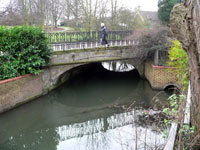
Steggles Eastgate Bridge
|
|
blank |
Some improvements were undertaken to Eastgate Street in Bury and the Marquess of Bristol subscribed to the works. The local building firm of Steggles built the white brick bridge which still crosses the River Lark. Iron railings were erected along the riverside there, reused from the Market Cross. This was the first time that there was no traffic actually fording the river. Up to 1840 there had always been a combination of bridge and ford in Eastgate Street.
Work was finished on the plan to enclose the ground floor of the Market Cross building. It became known as the Town Hall when it was used for offices by the Bury St Edmunds Borough Council. The space had become available in 1836 when the Corn Exchange was removed from the Market Cross into the new building to the south.
By 1840 the enclosure of the Brecklands and Newmarket Heath was almost complete. From 1790 to 1840 there was a spate of Acts of Parliament passed allowing large areas of north west Suffolk to be enclosed. These were private Acts which required the sponsoring Landlords to meet the cost of the legislative process through Parliament. Most of the rest of the County had been enclosed long before this time. This area covered the Breckland and the chalky grasslands of the Newmarket Downs. On private estates like Euston and Hengrave there was no need for a Parliamentary Act, as the land owners had carte blanche over their own property. Haverhill was outside this area, but for some reason did not get enclosed until this period, but by 1820 its old open fields had also been swept away by Act of Parliament.
In 1838 the Camden Society produced the first of a series of publications of historical documents. Volume 13 was published in 1840, when the Chronicles of Jocelin of Brakelond were printed. This work is familiar to us today, as it has been translated and published a few times. However, in 1840, it was presented to the world, in its original latin form, for the first time.
The Penny Post was begun. Although there had been a movement to number the properties in the main streets of towns throughout the 1830s, the Penny Post finally made it a universal system in all towns.
With access to cheap postage the working classes could now afford to send letters to family and friends, and this must have led to an increased desire to improve their levels of literacy.
A Parliamentary Select Committee reported upon the bad effects that poor sanitation could have on the health of the labouring classes.
|
|
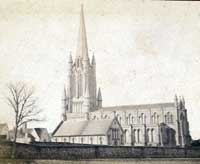
St John's Church c 1866
|
|
1841
|
In 1841, built of white bricks produced at nearby Woolpit, and endowed by the Marquis of Bristol, a dramatic new church was being built in Long Brackland. It was to be dedicated to St John the Evangelist and the architect was William Ranger of Brighton who invented an artificial stone known as ‘Ranger’s Artificial Stone’, patented in 1832. William Ranger had recently completed work on the new Westley church, St Mary's, of 1835 /1836 which was built mainly with his new artificial stone or concrete.
The builder of St John's Church was Messrs Bell and Sons of Cambridge and the church was dedicated on October 21st 1841. This picture is from about 1866 but even by that date there was no Orchard Street yet built, and very few other buildings around the church. St John's school for infants is also visible in this picture, and seems to have been built at the same time as the church. This school would be extended in 1875 and a further extension added in 1899.
In Bury the George and Dragon, a large former coaching inn in the Buttermarket was put up for sale. Located where Croasdales the chemists is now found, it seems to have been turned into shops at this time. The George and Dragon was being advertised in the newspaper as far back as 1725, as "to be let or sold, the George (late the Post House), near the Market Cross." In the 1820's it was one of about six coaching inns in Bury, with the "Phoenix" leaving three times a week to Norwich.
By 1841 a large brewery and maltings existed in Haverhill along both sides of Camps Road. It was owned by James Boreham to serve his pubs and to sell to others. Before such breweries, all beer was brewed by individual publicans on their own premises.
Benjamin Greene's second son, John Greene was a solicitor in Bury. On November 9th 1841 he became Mayor of Bury St Edmunds, a job he would hold again in 1852. He was the first Tory Mayor of the town since the passing of the 1835 Municipal Corporations Act. While his elder brother now ran the Greene's brewery in Westgate Street, and his other brothers were in commerce in the West Indies or elsewhere in England, John made his way as a professional man around Bury St Edmunds.
At Bury St Edmunds the West Mill at Horringer Road was now a thriving business. The miller was one William Cockrill, and he employed 17 men and 8 boys. There were eight mills operating in Bury through the 19th century, but West Mill must have been one of the most successful.
Other windmills in Bury were at Out Southgate, where the Southgate Mills were operated by a Mr William Plumb and Mr Samuel Wright. In Southgate Street itself, a steam mill was operated by John Cooke. Mill Road had a windmill, and two more were along Field Lane, which today would be located along Kings Road towards the Borough Cemetery. These were all owned by James Limmer. There was another mill at Out Northgate.
By the end of 1841 the Bury St Edmunds Corporation were facing a financial crisis. The 1835 reforms under the Municipal Corporatins Act had produced a Whig leaning council, considered by many to be dangerously radical. Between 1836 and 1841 the council had launched four major capital projects:-
- the building of a new Corn Exchange, (not the current one)
- buying up land in order to reform the Cattle market
- Converting the Market Cross into a produce market with public rooms above
- Rebuilding the decayed Eastgate Bridge
They hoped to sell off various rights and assets to raise funds and hoped to mortgage other property. They also arranged an overdraft of £2,000 from the Bury branch of the National Provincial Bank, to bridge any funding gaps. By December, 1840 the council had exceeded its overdraft facility by £154, and the Bank was pressing for improvements. The Treasury was refusing to give permission for further borrowings and in October, 1841 the Bank sequestered the corporation's assets, keeping all its income to pay off the overdraft, which would take until August, 1845.
The Corporation had to levy an extraordinary rate in order to meet its day to day expenses.
|
|
1842
|
The Poor Law Commission produced a report on the "Sanitary Condition of the Labouring Population of Great Britain". Their secretary was Edwin Chadwick a barrister and follower of Jeremy Bentham and he had spent three years on the report, convinced that the old vestry system must be replaced by central government intervention to improve health in towns.
Up to 1842, the Corporation in Bury had owned the advowsons of both existing Anglican churches. This meant they could appoint friends and relations to the livings of St Mary's and St James's, but in 1842 the corporation sold its nomination rights.
|
|
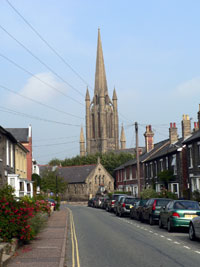
St Johns Church in 2005
|
|
blank |
In Bury, St John's Church was consecrated. With its distinctive spire of 178 feet, it was built to serve the expanding Victorian town towards the north. In the spirit of the industrial age, its interior columns were made of cast iron, supporting a brick built structure. It was built through 1841 and cost £6,000, all raised by public subscription. The first Vicar of the church was the Rev.B. Rashdall.
Much of the old Long Brackland was re-named St John's Street. The name Long Brackland survives today only at the bottom end of its former length. The Lane marked as such on Payne's map of 1834, now became known as Church Row.
St John's was the third Anglican church in the town, but St John's parish itself was not established until 1846.
According to William Spanton, in his book "Bury St Edmunds", there was trouble at St James's church, or to be more precise, with the church's belltower. We now know it as the Norman Tower, and in 1842 there were buildings attached to it on both sides. "When from neglect, injudicious repairs, and the careless hanging and ceaseless ringing of the bells, the gatehouse at last threatened to collapse, the inhabitants of the houses on either side had forty-eight hours' notice to quit", he wrote. The Mayor called the first public meeting on the subject in 1842, and launched an appeal for public subscriptions.
|
|
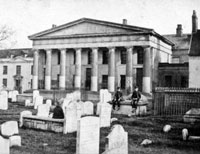
The Old Shirehall
|
|
blank |
During 1841 and 1842, the Shire Hall was rebuilt in the style of a Greek Temple with its magnificent columns and portico facing into the Churchyard at Bury. The new court rooms were opened at the Shire Hall, and would be in use until another rebuilding in 1907. The Shire Hall replaced a Shire House dating back to Elizabethan times. It had been left in trust for the Feoffees to occupy and use it for the sessions of the Justices of the Peace and the Assizes.
This photograph is taken from a carte de visite made by W Spanton, and on the reverse it has the inked note, "'St Margarets' as it was in 1878 - before it was altered." These cdvs were made on card of 102mm by 62mm, but will be greatly magnified on your screen if you click on the thumbnail picture shown here.
The composer Liszt performed at the Concert Rooms in Bury, in the room which is currently an art gallery, in the Market Cross.
There was widespread flooding at Out Westgate in Bury in the vicinity of the Spreadeagle public house. The dam in Ickworth Park across the River Linnet had burst, and the contents of the 15 acre lake flooded down the valley into Bury. The dam was never rebuilt.
In her book "Curtsey to the Lady", the author Zoe Ward describes how the area of the broken dam became known as the Busted Canal Bank to local children.
Some of 8th baronet Sir Thomas Cullum's major improvements to the River Lark were finished in 1842. The Cherry Ground lock at Lackford was built by Sir Thomas, and once had a plaque stating "TGC 1842". This lock is now within the West Stow Country Park, and has been fenced off because the brickwork is crumbling away. It currently bears an Anglian Water sign calling it Cherry Tree Lock.
The Cherry Ground lock was a key part of the improvements to the river. It was built on a bend where the lock was fashioned into a crescent shape, much longer and wider than the usual locks on the Lark. It could hold 8 gangs of lighters at one time if necessary, lined up side by side. Such a lock justified a full time resident lock keeper.
So Sir Thomas Cullum also built River House nearby for the use of the lock keeper. This was completely demolished in 1979 as part of the preparations for the opening of the West Stow Country Park to the public. The house had stood in ruins for years, and was unsafe. According to D E Weston, this house also bore the Cullum plaque, "TGC 1842".
Cullum's investment in the river would become almost worthless when the railway arrived in 1846.
Ransomes of Ipswich were producing a full range of agricultural equipment, along with about 20 other foundaries in Suffolk. In 1842 Ransomes developed their first successful steam traction engine.
In 1842, four years before the railway came to Bury, the Eastern Counties Railroad Tavern was opened in Churchgate Street. It was already an inn called the Dog, and stood at number 34 Churchgate Street, later to become well known as the home of Berry's Bakery Shop. The new owner Joseph Wiggins had the ingenious idea of running a stage coach service to Brentwood Rail station, where the coach would be loaded on to an open railway carriage and make the rest of its journey by rail. This cut the travelling time from Bury to London to much less than the full day needed by the "Old Bury" coach running out of the nearby Angel Hotel.
This new service by the "Wonder" coach, seems to have started out at the Woolpack inn, later to be called Everards Hotel, no doubt calling at the Railroad Tavern, and then on to Long Melford and Brentwood.
Wiggins himself died in 1843, and the Railroad Tavern closed in 1846, when the railway itself came to Bury. However the "roll-on, roll-off" approach to coach travel would then be adopted by most of the Bury Coaches.
Practically next door the Railroad Tavern stood the Six Bells, on the site now occupied by the Masonic Lodge. In 1842 it was already a coaching inn, but when Samuel Clements took it over he began to expand its coaching activities. In the next twenty five years the Six Bells played host to famous East Anglian coaches like the "Times", the "Phenomena", the "Defiance", the "Age", and the "Rival". By about 1870 its coaching days were over, and the Six Bells closed in 1885.
|
|
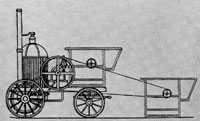
Ransome's self propelled engine 1842
|
|
blank |
In 1842 the firm of J R and A Ransome of Ipswich exhibited a portable agricultural steam engine at the Royal Show in Bristol, which could use its own steam to move itself from place to place. In fact Richard Trevithick had built a successful steam carriage in 1801, able to carry 7 or 8 people, but financial backing ended, and Trevithick turned his attention to rail travel. It was Ransome's 1842 example which revived the idea of steam powered road locomotion.
At first it was used just to move a static agricultural engine from place to place, and a horse was needed to steer it. Farmers resisted the idea of steam propulsion, while welcoming the static steam engine for a wide variety of jobs. Not until the mid 1850's did self propulsion become more widely introduced.
Robert Ransome founded the Ipswich firm in 1789 to make iron implements for farming. Robert died in 1830, but the firm continued. In 1831 Ipswich's first steam engine was installed at Ransome's foundry. In 1832 Ransome's began manufacture of their world famous lawn mowers. In 1837 the Orwell Works was opened. They exhibited a portable steam engine at the Liverpool Royal Show in 1841, and it was this engine which was made self propelled in 1842. Later the firm evolved to become known as Ransomes, Simms and Jefferies.
|
|
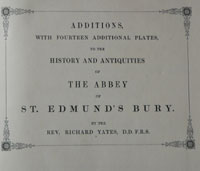
Yates' Antiquities 1843 edition
|
|
1843
|
The book known as Yates History and Antiquities of the Abbey of St Edmundsbury, first published in 1805, was re-issued with some additions. It seems that people who already owned the 1805 edition could acquire a second volume of additions. As well as some pages omitted in error from the first edition, this included a chapter on the Abbey Gate, a chapter on the Norman Tower, and one on the Abbey church. Several new plates were included which had been prepared in 1804/05, but never printed. The publisher, J B Nichols, wrote that prior to his death in 1834, Yates had passed on all his collection of material to him. From these notes Nichols had compiled some new descriptions of the original plates. New Appendices contained the Grammar School charter of Edward VI, the charter of the Steward of the Liberty of St Edmund of 1602 and the Town Charters of 1606, 1608 and 1614.
The Guildhall Feoffment Trust came under a scheme of control of the Charity Commissioners. Under this arrangement, part of the Trust's income was assigned to the Borough of Bury St Edmunds, to reduce the burden of the rates, and another fixed sum was paid to the West Suffolk Hospital. This was felt to be the best interpretation of Jankyn Smyth's bequest in modern conditions. However, the bulk of the Trust's income went to provide and run three new schools opened in 1843. These were the Guildhall Feoffment Commercial School for 150 boys in College Street, the Guildhall Feoffment Poor Boy's Elementary School for 300 in Bridewell Lane, and the Guildhall Feoffment Poor Girl's School for 150 in Well Street.
This major improvement in Bury schooling arose from the influence of Francis King Eagle. In 1839 he had examined the Feoffee's finances and declared that a quarter of their income should be devoted to education. At first it was slow to catch on but within 40 years these growing schools and their upkeep and improvement would prove too much for scarce resources of the Feoffees.
Other public schools for the education of the poor were opened at this time. The St Mary's Parochial Girl's and Infants School on Sparhawk Street was built in 1842/43. By 1879 it had space for 100 girls and 220 infants.
On January 27th the Bury St Edmunds Borough Council had purchased 3 acres of land off Kings Road for £550. This area became known as the Playfield.
On May 22nd, 1843, the Bury St Edmunds Corporation acquired a further 6 acres of land off Chalk Road for a sports and cricket ground. This land cost £800. The Playfields lasted over 130 years in use for cricket or football, but today the land is used for car parking.
Bernard Edward Howard, 12th Duke of Norfolk, had owned the estate and Hall at Fornham St Genevieve since 1789. The Duke had died in 1842, and in July, 1843, the whole estate was sold for £75,500 to Lord Manners, a relative of the Duke of Rutland.
In August Richard Cobden MP visited Bury to campaign for cheaper bread via the repeal of the Corn Laws. He was treated with contempt by the Bury and Suffolk Herald.
Although there were still three firms of yarnmakers listed for Lavenham in Directories of 1839 and 1844, this industry had been in long term decline, resulting in large scale unemployment and poverty. A commission of 1843 found that Lavenham had formerly had 150 woolcombers providing work for all the women and children for ten to fifteen miles around. By 1843 there were only sixteen combers throwing most of the local population entirely upon agriculture or relief. Machinery could now spin yarn for three farthings a pound, where handspinners got 13d a pound, and even this income was trifling given that a hand spinner could produce only two pounds of spun yarn a week.
Many people living "on the parish" gave up hope in this country and emigrated. Poor Law Unions arranged passages and there was a government assisted scheme to Australia.
After 1838 the Chartist movement led many to believe that a new Charter could improve their lot. By 1843 the Chartists knew that their demands had failed, and a new wave of disillusioned violence broke out in Suffolk.
In October an outbreak of fires on rural farms began, mainly west of Bury, which lasted well into 1844. The price of wheat had collapsed and in response labourers' wages were cut. The notorious Red Barn at Polstead, scene of the murder of Maria Marten, was one of the farm buildings burnt down in these disturbances.
|
|
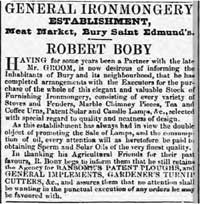
Boby sets up his Ironmongery business |
|
blank |
Following the death of Mr William Groom, the ironmonger, Robert Boby raised the money to buy Mr Groom's share of the Ironmongery business, located at 8, Meat Market.
The Bury and Norwich Post of 15th November 1843 carried this announcement from the General Ironmongery Establishment, Meat Market, Bury St Edmund's.
"Robert Boby, having for some years been a partner of the late Mr Groom......has now completed arrangements with the executors for the purchase of the whole of this elegant and valuable stock."
The announcement also said that he would continue to sell the finest sperm and solar oils to promote the use of lamps. Also he would continue to hold the agency for Ransome's patent ploughs and other implements.
In 1843, according to "Grace's Guide to British Industrial History", Robert Boby was in business in Bury St. Edmunds as an 'Ironmonger, Red and White Lead Dealer, Brazier and Turner.'
|
|
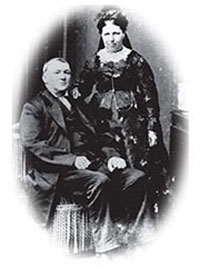
Robert and Sarah Clarke
|
|
blank |
At Coney Weston, in Suffolk, Robert Clarke was one of those farm labourers who was being pushed deeper into poverty. Robert Clarke was apparently uneducated, hard-working, deeply religious and devoted to his family. He was also very musical and played a small wooden whistle. So much so, that when he heard of a new material called "Tinplate", he obtained some through the local blacksmith, who showed him how to copy the wooden whistle, and to make his own musical instrument.
Using the tinplate, together with some solder and a small piece of wood, he created the tin whistle.
Clarke found that the new instrument sounded so good that he thought he could make a living by making them for sale. By this time it seems that he had fallen out with the farmer who employed him, and left his position.
Robert Clarke heard that there were big opportunities for manufacture in Lancashire so, together with his son, walked all the way from Coney Weston to Manchester, pushing his tools and materials in a handbarrow. On the way he stopped in villages where there were markets. He set up his stand and made the tin whistles to sell to the villagers.
Sometimes he met the navigators, Irish labourers, who were building railways and canals and sold his tin whistles to them. These Irishmen took them back to Ireland, where those English tin whistles rapidly became Ireland's favourite folk instrument.
When Robert reached Manchester he set up his factory in a shed and soon became a successful manufacturer. He called his Tinwhistles "Megs" which is a Victorian nickname for a halfpenny, which is what he charged for them. He made so much money that he was able to build two houses, a factory and a church in a nearby village called New Moston. He even went back to Coney Weston and bought up the farm he had worked on.
Today the Clarke Tinwhistle company is located in Kent, and Clarke's tinwhistle is played all over the world.
The railway line had at last reached Colchester from London.
|
|
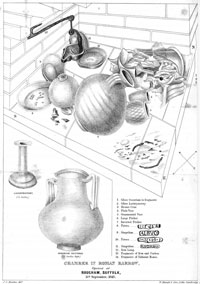
Contents of mound 1 Eastlow Hills
|
|
blank |
J S Henslow has been described as the father of scientific archaeology in Suffolk, as he undertook the first excavations in the county where a written and drawn record was made. These were undertaken in 1843-4 on the Roman barrows at Eastlow Hill in Rougham.
During 1843 and 1844 four Roman barrows at Rougham were excavated by Professor J S Henslow from Cambridge, finding a chamber with walls of flint & mortar with tile courses at intervals, on a flint and mortar platform and with a tiled roof. A second mound dug in 1844 contained an inhumation in a lead coffin. Henslow was also the rector of Hitcham but is probably best known nationally for being Charles Darwin's tutor. The largest surviving barrow is called Eastlow Hill, and was 17 feet high when Henslow dug into it. The barrows contained significant Roman material, which was sent to Rougham Hall, where it was held.
|
|
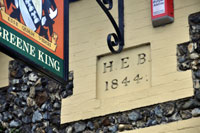
The Bunbury Arms |
|
1844
|
About 160 fires had occurred in Suffolk by the time the outbreak of arson ended and most were believed to have been started deliberately. Mildenhall and its surroundings saw many of these fires and the topic was widely reported and debated in the national press. Many people attributed these to the distress caused by the New Poor Law introduced in 1834. Sir Henry Bunbury of Barton Hall, and also lord of the manor of Mildenhall, commented on the "cold harshness" of the New Poor Law and claimed "incendiary crimes are the symptoms of a smouldering and dangerous discontent".
Bunbury's own tenants were well housed, as Bunbury had built many model homes between 1821 and 1828. In order to provide his workers with entertainment he constructed the Bunbury Arms public house in 1844. However, he built it some way outside the village, on the crossroads with the Thurston to Livermere road.
|
|
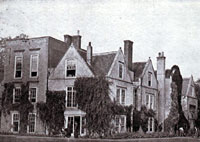
Manor House, Mildenhall |
|
blank |
Sir Henry Bunbury's eldest son was called Charles James Fox Bunbury, and in 1844 he became married and moved into the Manor House in Mildenhall. The circumstances of his marriage throw light upon his circle at the time. On February 27 th 1844 he went with Charles Lyell and his wife Mary and Miss Francis Joanna Horner to the British Museum to view fossils. Charles Bunbury and Miss Horner became engaged on April 10th, married on May 30 th and moved to the Manor House, Mildenhall. Mary, Francis Joanna, and Katharine were daughters of Leonard Horner who was a founder member of the Geological Society, and who became its president in 1844. Mary married Sir Charles Lyell (1832) and Katharine married Col. Henry Lyell (1848). Charles Bunbury and Sir Charles Lyell became lifelong friends. Sir Charles Lyell became a famous geologist, while Charles Bunbury became a famous naturalist. .
In Bury the Chapel of the Charnel's entrance to the old crypt was discovered. The floor was two feet deep in bones. It was remodelled into a family mausoleum by Alderman Spink, and he surrounded it by iron railings.
On July 20th 1844 the Ipswich Journal published a very long letter, with illustrations by the Rev J. S. Henslow, Rector of Hitcham, describing his excavations at Rougham.
"SIR - On Thursday morning, the 4th of July last, the workmen were sufficiently advanced, after more than four days’ constant labour in exploring the large Tumulus at Rougham, named Eastlow Hill, to raise our expectations that we should be able to expose an extensive deposit of Roman remains by the hour at which the public had been invited to attend. The discovery turned out to be something of a very different description from what I had anticipated. Instead of urns and vases, paterae and simpula, lamps and lachrymatories, such as were found last year, the only contents of a large chamber of masonry, which I shall presently describe, proved to be a leaden coffin, enclosing a skeleton..."
St Mary's church in Bury was completely restored at a cost of £5,000 to £6,000. Wilkin's Bury Guide of 1867 reported that it now had 2,000 sittings of which 500 were free.
An Order in Council finally removed the right to control the clergy of St James and St Mary's from the town corporation. These two churches and their parishes were finally made part of the Thingoe Deanery and the Arch Deaconry of Sudbury, under the Diocesan control. The corporation had inherited the Abbot's old freedom from episcopal control when they got their third charter in 1614, and finally this freedom was removed.
In October, the West Suffolk County Constabulary was established to get more organised policing in the rural areas.
Sudbury had its right to two MP's abolished because of gross electoral corruption. The Borough was lampooned as Eatanswill in "Pickwick Papers" by Charles Dickens. Suffolk was thus reduced from having 11 MP's, as it had enjoyed since 1832, to 9 MP's. This number would stay the same until 1885.
In 1844 William White published his "History, Gazetteer and Directory of Suffolk". White's Directory recorded that there were four silk manufacturers and some 600 silk looms in Sudbury although about half the looms were idle ‘in consequence of the general depression of that year.’ More silk manufacturers arrived in the following years including locations at Glemsford, Nayland and Lavenham.
White's Directory recorded four brewers in Bury St Edmunds. These were
- Henry Braddock of 107 Southgate Street
- John Clarke of 74 Risbygate Street
- Edward Greene of Westgate Street
- James Waldwine of 28 St Johns Street
|
|
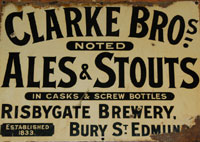
Clarke Brothers, est 1833 |
|
blank |
Apparently Clarke's Brewery was set up in Risbygate Street in the early 1840's, as it was not recorded in the Pigot's Directory of 1839. However, there is a sign in Moyse's Hall museum from a much later period which claimed "Clarke Brothers noted ales and stouts, Risbygate Brewery, Bury St Edmunds, Established 1833." A better example of this sign is illustrated here, and in 2008 could be seen in the Three Kings public house at Fornham All Saints. Whatever the exact date of the brewery, Clarke had definitely taken over over the existing Malthouse at 74 Risbygate Street by the time of the 1839 Directory. This old Malthouse survived in various uses until 1980, when it stood derelict for 20 years. In 2005 it was taken over by St Matthew Housing Association, and converted eventually into homes and a Heritage Centre, opening in 2007.
Clarke's brewery continued up to 1917, when Harry Clarke would sell out to Greene King. After 1887 Clarke's would be the only remaining serious competitor to Greene King in Bury.
John Deck was the Postmaster at 2 Hatter Street, with another address recorded at 15 Churchgate Street.
Whites Directory included the information that the tolls from the Lark navigation were payable to Sir Thomas Gery Cullum under the terms of the will of the late Susannah Palmer. By 1844 the River Lark navigation was thriving. White's Directory of Suffolk recorded that barges went on a daily basis from Mildenhall Bridge to Bury St Edmunds and Kings Lynn. White's recorded that there was much greater traffic to and from Lynn than previously. Tolls had been cut from 7/- and 8/- a ton to 4/6 and 5/- a ton by Sir Thomas Gery Cullum, who was also responsible for major improvements along the river.
In 1841 an Act of Parliament gave the Eastern Counties Railway Company the power to connect Bury to Kelvedon in Essex by rail, but nothing had been achieved by 1844.
White's Directory also considered that the town is well paved and most streets have flagged causeways.
A public subscription was in hand to pay for the restoration of the Norman Tower, which a report by a Mr Cottingham had said was otherwise liable to fall into a ruin.
J W Donaldson was headmaster of the Free Grammar School at 12 Northgate Street.
Bankers recorded were:-
- National Provincial Bank of England in the Meat Market
- Oakes, Bevan Moore and Bevan, Bury and Suffolk Bank, 9 Buttermarket
- Suffolk Banking Co at 10 Meat Market
- Worledge and LeBlanc at 11 Meat Market
- Savings Bank in the Guildhall, open Saturday 12 till 1
John Cooke had a steam mill for grinding corn at 32 Southgate Street, while other Corn Mills, presumably windmills, were at West Mill and Southgate Mill.
Bury had 12 blacksmiths listed, but only two firms were listed as Iron and Brass founders. These were
- John Cornish and Son at 62 Westgate Street,
- Pritty and Hodgson at 63 Abbeygate Street.
John Cornish and Son were also listed as Machine Makers at 62 Whiting Street and as Whitesmiths at 62 Westgate Street. There were three firms listed as Machine Makers, as follows:
- John Cornish and Son at 62 Whiting Street,
- Henry Backham at 32 St Johns Street,
- Henry Smith at 22 Westgate Road.
There were 12 people listed as Maltsters, including the best known names, Braddock, Clarke, Greene and Maulkin.
The Maltsters were:-
- Henry Braddock malting at 107 Southgate Street
- William Fenton at 71 Southgate Street, and
- Ann Goldin at 110 Southgate Street.
- John Clarke was at number 74 Risbygate Street
- John Hayward Guy at 12 Risbygate Street and
- James Lee at 27 Risbygate Street.
- Isaac Cooper malted at 17 St Johns Street, and
- Edward E Lease at 53 St Johns Street.
- Edward Greene was in Westgate Street, with
- Robert Maulkin nearby at 10 St Mary's Square.
- Hannah MacLeroth was at 64 Guildhall Street, and
- Humphrey Steggles at 51 Churchgate Street.
It may be noted that the 1839 directory gave Cooper's address as 26 Long Brackland, and Lease's address as 184 Long Brackland. In reality they had not moved. In 1842 Long Brackland was renamed St Johns Street, and subsequently re-numbered.
White also recorded the following Lime Burners in Bury in 1844:-
- Francis Jarrold of 66 Risbygate Street
- James Taylor of 39 Southgate Street
- William Warren of 37 St Andrews Street
In 1844 the horsehair industry was introduced to Glemsford when Messrs. H, Kolle & Sons built a factory in Bells Lane for the processing, curling and weaving of horsehair. Horsehair was not just used to stuff sofas and for a number of years this factory employed a large staff making a variety of blinds and woven products. By 1855 Kolle would be employing 470 hands making horsehair and cocoanut matting products at Glemsford. By 1885 this would rise to 700 hands. However, Kolles went bankrupt in 1905, and the firm closed down.
In 1907 the firm of Arnold and Gould would continue the processing of horsehair at Glemsford, employing 100 people. By 1962 it would become one of the important firms of horsehair manufacturers in Europe. It imported horsehair from all over the world and this was then washed, sorted, hackled, double drawn and prepared for the brush industry, textiles and sundry other uses, of which violin bow making was perhaps the most specialised.
In the USA, Samuel Morse set up his first experimental telegraph line using his own code invented in 1832, of long and short clicks, or dots and dashes. It covered every letter and the commonest letters had the least code. Despite modern advances into satellite communications, Morse code still has a place in the emergency shipping frequencies today.
|
|
1845
|
In 1845 the West Suffolk Rural Constabulary was established under powers contained in the County Police Acts of 1839 and 1840. The new Chief Constable was appointed by the Justices of the Peace for West Suffolk in 1844, and work began to appoint six superintendents, seven sergeants and twenty seven constables. All ranks were provided with swords, as well as the more usual truncheons and rattles. The Chief Constable took rooms in the Shire hall at Bury.
The town of Bury St Edmunds had enjoyed a Borough Police Force of one superintendent and 12 constables, based in Moyse's Hall, since 1836, and now there were two separate forces both headquartered in Bury St Edmunds.
Work started on a three year project to restore the Norman Tower, which was in danger of collapse. The first move seems to have been that the cupola shown on it in Yates Antiquities of 1805 was removed.
Development of a railway link from Norwich and Yarmouth to Cambridge meant that Brandon and Thetford on this route were the first places in Suffolk to enjoy a rail link to London, and indeed, the first in Suffolk to have any sort of rail link at all.
The Culford estate had so far escaped any of the arson attacks prevalent in Suffolk during 1844, and into 1845. However, in January 1845 the outbuildings at Timworth Hall were burnt down. Timworth Hall had been the home of the Estate Steward, John Berrett. Since 1839, Berrett had sacked many of the estate hands who Edward Benyon, the owner's nephew and effective master of the Estate considered were not up to their employment.
By 1845 it was nine years since Edward Greene had bought Westgate Brewery from his father, Benjamin Greene. He had agreed to pay his father over a nine year period, and the loan was now paid off. Edward would now have the money to expand the brewery as he wished. He was well aware that the railway was coming to Bury, and anticipated a great new market for his beer, opened up by fast, relatively smooth travelling conditions.
In 1845 Edward Greene built a new and extensive Maltings in Bridewell Lane. He had already been renting other maltings in Bury, but this new one outstripped them all. It was the first increase in area that the brewery had received since Buck and Greene began in 1805. These maltings, known as School Maltings, continued in use until 2003/04 when they were converted into housing. The ground was bought from the Guildhall Feoffees, adjacent to their school.
Greene also reorganised his brewery to increase production capacity, and sold off 30 hogsheads and other brewing equipment which he had replaced.
During 1845 there was a dreadful potato famine in Ireland.
|
|
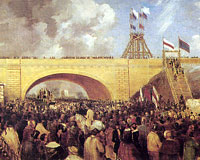
First train to Bury |
|
1846
|
Through 1846 the River Lark navigation enjoyed its last 12 months of prosperity until disaster arrived for it at Bury St Edmunds in the shape of the railway. Navigation company records show that some 10,000 tons of coal and other goods were sent from Kings Lynn to Bury St Edmunds by barge in 1845. By 1852 this trade would have dwindled to almost nothing.
In December, 1846 the long hoped for railway line arrived at Bury St Edmunds from Ipswich.
Northgate station was not yet built, so a temporary platform was set up on the Ipswich side of the viaduct over Out Northgate Street. The first train arrived in ceremonial fashion, as shown in this painting of the event. It carried the company directors and the Mayor and corporation of Ipswich, who arrived to a tumultuous welcome. There were street celebrations and fireworks to welcome this great event. The assembly then processed into town for a banquet at the Concert Room in what is now called the Market Cross.
A railway line now linked London, Colchester, Ipswich, Stowmarket and Bury St Edmunds. The link from Colchester was built by the Eastern Union Railway founded in 1844 by J C Cobbold of Ipswich. The spread of railways caused the end of the boom in stagecoach travel. This was no wonder when it was seen that you could get from Bury to London in the astoundingly short time of four hours on the train. It could take all day by the fastest stage coach.
The "Old Bury" coach had run out of the Angel Yard since 1737, and had been the first Bury coach to get to London on the same day as it started. The Old Bury was now a lame duck, but not quite a dead duck.
The stage coaches might have seemed to have had their day. However, coaches like the "Marquis of Cornwallis", which ran out of the Suffolk Hotel on the Buttermarket, still had a trick to play. Arrangements were made for an open rail carriage which the coach could be loaded on to. Where there was no railway the "Marquis" could drive you to your door, and where there was a rail station, the "Marquis" could take advantage of the speed of the railway. Its run to London could now be cut from a day to just over six hours. Every Bury coach except the Times now used the railway to make most of their journey. The Times ran from the Bell Hotel in Bury, and tried to make a virtue of being the only coach to go all the way to London by road.
The mail coaches run by the Post Office did not have a chance to survive. They were under contract, and, since 1838, as each railway line was finished, the mail contract was handed over to the railway. The first mail coach to run between London and Norwich (139 miles) began in March 1785, stopping along the way at Bishop's Stortford. On 14 June 1846, the very last mail coach to run out of London travelled that same route, bringing the mail coach era to an end.
Third class fare from Bury to London by rail was about the same as the Stage Coach price, but you could go fourth class even cheaper. In December, 1846, when the first 90 tons of coal arrived in Bury by train, its price fell by ten percent. It arrived to temporary platforms just east of the bridge over Out Northgate Street, and the current station had hardly been started. The railways gave the town an easy export route, as well as bringing goods in cheaper. The old established brewing and malting industry could now be joined by other newer undertakings.
Other establishments such as The One Bull inn, also suffered from the railway's competition. The One Bull had run a long distance carrier service by wagons to London and towns throughout East Anglia. The railway killed this trade and after this time the One Bull's carriers only served the local villages. Possibly this decline was linked to the fact that over the next decade the One Bull became notorious as a dancing house with the worst kind of disorderly conduct.
|
|
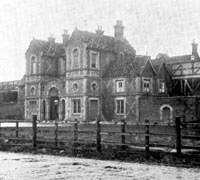
Thurston Station |
|
blank |
The railway company built grandiose rail stations along the line at every stop. Even small places like Thurston, (reduced to an unmanned halt in 1967), were graced by a Jacobean style "mansion" by Frederick Barnes. Grand estates like that at Rougham, would now chose to go to Bury via the local train station instead of by chaise right into town. Rougham Hall would build a new drive just to get to and from the nearest station at Thurston. Bury's own Northgate Station was opened for use in November 1847, while building work continued.
St John's Street now became a major route as it was the normal way into town from the railway station. Development now increased in this part of town. The Railway Hotel was granted a full license to serve the railway trade. Today it is known as the Linden Tree.
With small villages like Elmswell suddenly opened up to the outside world by the railway there was a chance to expand. Elmswell soon became a small centre for agricultural businesses.
With the success of the railway line to Ipswich, competing companies were considering the extension of the line from Bury St Edmunds to Newmarket and Cambridge.The Chesterford and Newmarket railway company had approached Mr George Beeton, tenant of St Peter's Barn Farm for rights to lay a new line across his farm to Northgate Station and to another terminus at Blomfield's Meadow. A draft agreement was reached with the landowners, the King Edward VI Grammar School in 1847, but there was no progress for the next five years. The Eastern Counties and Eastern Union Railway company also expressed an interest, but the price seems to have been a sticking point for all parties.
|
|
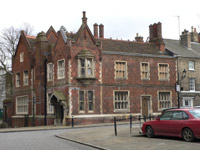
The Savings Bank |
|
blank |
The Norman Tower was restored in 1846 and 1847. The houses built against each side, and even partly in front of it, had been taken down in 1845. Some five or six feet of earth which had accumulated over centuries was excavated from around the foot of the tower, to leave its base exposed in the intriguing way in which it remains today. This accumulation of earth is thought to have been a deliberate attempt to raise the ground level to avoid flooding in late Medieval times. On the tower the walls were strengthened with iron bolts, and the foundations underpinned with concrete. As part of the reinstatement process the Savings Bank built and opened new premises next to the Norman Tower, and these still stand today. The date "1846" is picked out in the brickwork of the Bank on the chimney wall facing the Norman Tower. This Savings Bank was often erroneously called the Penny Bank and it closed as a bank in 1892.
The architect of the Savings Bank, together with much of the restoration planning around the Norman Tower, was Lewis Nockalls Cottingham, who was born in Suffolk. In 1841 he had worked on the parish church in Horringer, and from 1842 until his death in 1847 was responsible for restorations at St Mary's church in Bury St Edmunds.
Lewis Cottingham was born in 1787 at Laxfield in Suffolk of a respectable family. He showed a talent for science and the arts early and he was apprenticed to a builder at Ipswich. After several years he moved to London and there placed himself with an architect and surveyor. He commenced his professional career in 1814 at his residence near Lincoln's Inn Fields. Cottingham's first public appointment was as architect and surveyor to the Cooks Company in 1822. Soon after this he erected a mansion in the perpendicular style of Gothic architecture for John Harrison at Snelston Hall in Derbyshire. He became a prominent architect of the Gothic Revival style in Britain. In 1825 he became architect to Rochester Cathedral.
Cottingham won a competition to remodel the interior of the Chapel of Magdalene College, Oxford. Work started in July 1829 and during the course of the restoration, a great deal of seventeenth and eighteenth century work was stripped away. This disregard for buildings other than Gothic was typical of the period.
William Spanton, writing in the late 1920s, bemoaned the fact that when the buildings by Bury's Norman Tower were demolished, the old abbey walls were demolished as well, instead of being repaired as they might have been. He also regretted the design of the Penny Bank, as it was then known, calling it a sham antique. Spanton himself was born in 1845, and therefore had no personal memories of the situation.
|
|
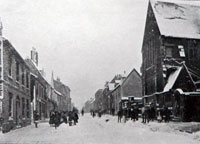
St James's National Schools |
|
blank |
The St James's National Schools were built in Risbygate Street. The single, large and ornate building had separate entrances for girls and boys. In 1937 it was removed and became a carpark, and the road up to the Cattle Market, which was also created is still called School Yard.
|
|
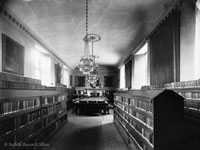
Library in the Guildhall |
|
blank |
The West Suffolk Library was established in 1846, and was located in the Guildhall's south hall, also known today as the banqueting-room. It would also become the Council Chamber for Bury St Edmunds Borough Council from 1877 to 1966. Up until 1877 the council meetings were held upstairs in the Guildhall in a room at the back. This photograph, from the Spanton-Jarman Collection at Bury St Edmunds Record Office, shows the Library and chamber beyond it in about 1890.
The corn laws were repealed following a long and successful public campaign. There was now the prospect of cheaper bread from foreign corn.
|
|
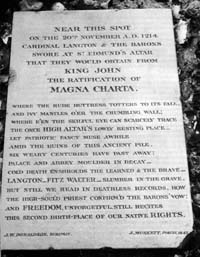
Commemorating the oathtaking
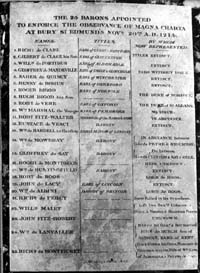 The Barons of 1215
The Barons of 1215 |
|
1847
|
By the late 1840s, the new Bury St Edmunds Council had established itself and in common with the rest of Victorian England there was an explosion in local civic pride. Economic growth had helped the council out its earlier financial problems. There was a growth in the idea of self-improvement and a thirst for knowledge about history, botany, and antiquarianism in its widest sense. There was talk of opening a museum, and of setting up a Suffolk Institute of Archaeology.
In 1847 the Council erected two stone tablets among the remains of the old abbey church commemorating the Barons' meeting here in 1214, and the idea now grew up that the town should capitalise on these ancient connections. The inscription on the first tablet was written by Dr John W Donaldson who was Headmaster of the King Edward VI Grammar School from 1841 to 1855.
Early photographs of this tablet show that the Barons' meeting was erroneously inscribed as 1215, and the stone must have been recut at a later date.
The list of Barons shown on the second stone was taken from the "Flowers of History" written by Roger of Wendover in the 13th century.
Civic pride was enhanced on the scientific front as well.
The West Suffolk General Hospital was somewhat enlarged by now, but its modern credentials were best established when Dr John Kilner carried out one of the first uses of anaesthetics in an operation. The Bury Free Press of 27th January announced that an operation to remove a breast cancer had been undertaken on 6th January, 1847 by the use of ether as an anaesthetic.
|
|
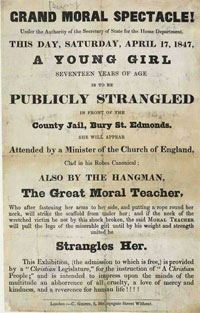
Satirical anti-capital punishment poster |
|
blank |
Catherine Foster of Acton was just 17 or 18 when she married John Foster. After only three months of marriage she was found guilty of murdering him by giving him arsenic mixed in a dumpling. Since 1835 there had been a strong drive to abolish hanging as a punishment, although there had been local individuals opposed to the practice in earlier times, such as Capel Lloft in 1800. This poster attempted to recruit public opinion in favour of abolition, using Catherine Foster as an example.
Meanwhile a museum was opened at Ipswich to display items hitherto stored in the council's vaults.
After an inaugural committee had canvassed subscriptions from the great and the good of the county, Ipswich Museum opened its doors to the public for the first time in 1847. According to the Ipswich Journal, two hundred and fifty invited guests celebrated the event with a grand dinner. The new Ipswich Museum, which gave its name to Museum Street, appears to have been constructed along similar lines to the one at Kew, which Professor Henslow had been responsible for creating. Reverend J.S. Henslow was a remarkable man, who was able to follow his early career as Professor in Botany at Cambridge University with his later years spent teaching and preaching from his parish base at Hitcham.
In 1847 men 'raising gravel for ballast' for the barges on the then navigable River Lark, found skeletons and numerous cremation urns at West Stow.
The Bury and Norwich Post of 2th September 1847 carried an announcement from the:
"Savings' Bank, Bury St Edmunds. Notice is hereby given that the business of the above institution will in future be carried on in the Banking Rooms recently erected next the Norman Tower. William Williams, Thomas Reach, Clerks. Bury St Edmunds September 26th, 1847."
|
|
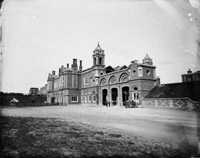
Northgate Railway Station by 1854 |
|
blank |
In November 1847 the new railway station at Northgate Street was opened for business replacing the temporary station just across the road to the east. The station had only been started the previous year and some building work continued as it came into use. Most of the railway stations on the Eastern Counties Railway were designed by Sancton Wood. The main contractors for the line were called Thomas Brassey and Alexander Ogilvie, and they built the station as well. The wooden platform roofs were built by a local builder, John Trevethan of 71 Guildhall Street. The distinctive twin towers had the practical purpose of housing the hydraulics for the luggage lifts up to the platforms. At this time the line terminated just west of the station with a turntable allowing access to the engine shed and goods shed, and to turn the engines round for the return trip to Ipswich.
Along with the station came the so-called wharfs for unloading coal and other heavy goods. The Gas Works in Tayfen Road had hitherto obtained all its coal supplies from the canal wharf at Mildenhall Road. Now it could obtain all the coal it required from the goods yard at Northgate Station.
William Wicks took over the Bell Hotel on the Cornhill, standing where the Post Office is now located. In the next ten years he greatly expanded the Bell as a coaching inn, despite the railway competition, and added a funeral service to his businesses. The Bell Hotel had stabling for up to 50 horses.
At Chevington a new school was built by the National Society for the Education of the Poor in the Principles of the Established Church. Such schools were known as National Schools.
The site, near All Saints Church, was donated by the Marquess of Bristol and General Hervey's Charity supported it by £40 a year. In the fashion of the time the girls were educated separately from the boys, and they were regarded as two individual schools. The schools continued into the late 20th century.
Greenwich Mean Time was first adopted across Great Britain by the Railway Clearing House on December 1st 1847 to standardise train timetables, and by almost all railway companies by the following January, 1848. However, while railway time was generally accepted for the purpose of catching a train, some places stuck to their own local time. Such was the force of local opinion that in Dorchester, for example, the local time continued to be several minutes later than GMT. The Dorchester Assizes, however, ran by GMT, and in the case of Curtis v. March in 1858 the judge found for the plaintiff as the defendant and his counsel had not turned up by 10 o'clock GMT. Upon appeal it was decided that "local mean time" was to be regarded as the official time. Because of the problems that this judgement caused, by the end of 1880 an Act of Parliament was needed to ensure that GMT was legally adopted as official time throughout Great Britain.
|
|
1848
|
In January the St Edmunds Head inn was opened in Cannon Street, as a purpose built inn, unlike many of the beerhouses set up at the time. Next to the inn a large brewery was also built, linked to the inn by an archway. This brewery was one of the last of the independent brewers in Bury, still producing beer up to about 1914. By then it was called the Cannon Brewery.
The St Edmunds Head became a Greene King pub in 1958, and it closed in 1994. However, at the end of 1999 it reopened as the Old Cannon Brewery, as part of the new trend for micro breweries trading on the fact that it was different to the mass produced beers of the 1990's.
The Golden Fleece stood in Churchgate Street, on the corner of College Street. It had been there since 1737, and in the rear of the pub stood a Brewhouse. It had probably been making beer for itself for many years, as had been the custom for most large old inns. It is notable because, like the Cannon Brewery, it brewed its own beer right up to 1913 or 1914. These two independent brewers were the last two establishments to survive brewing their own beer up to the time of the Great War.
|
|
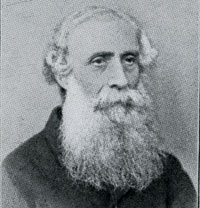
Samuel Tymms |
|
blank |
In March 1848 the inaugural meeting of the Bury and West Suffolk Archaeological Institute took place, and its first quarterly meeting followed on 8th June, 1848 in the Guildhall, in the room of the West Suffolk Library there. In Ipswich there had been a Suffolk Archaeological Association in existence since 1846, and it may have inspired the Bury group to be set up. However, after publishing three volumes, the Ipswich based Association seems to have fizzled out after 1848.
One of the driving forces behind the Bury and West Suffolk Institute was Samuel Tymms, who would hold the post of Honorary Secretary from 1848 to 1867. Born in 1808 in Camberwell, Tymms seems to have arrived in Bury on the staff of the Bury Post. By 1857 he was established as a printer, stationer and bookseller in Lowestoft. He would die in Lowestoft in 1871. Tymms would publish many articles and books including Bury Wills and Inventories in 1850, and his series of Guides to Bury St Edmunds.
Local Boards of Health were set up by the Public Health Act of 1848. The Act was adoptive, not prescriptive and its sewerage provisions were not adopted by the Commissioners in Bury for 11 years.
The General Board of Health was established with Edwin Chadwick at its head. It was the first stirrings of what would become today's DETR. In the same year Samsons Tower changed from stables to a dye works, having been auctioned off for £520. By now, however, its history was becoming more widely appreciated, and it was suggested that it should be adapted as an official home for the Mayor.
The Corn Exchange was now bursting at the seams with traders and buyers. An extension was approved and built but in the next twenty years this would prove to be inadequate yet again.
A railway link was established from Cambridge to Newmarket, but there was as yet no link to Bury from this direction.
Through the 1840's the reverend Sir Thomas Gery Cullum had been running the Lark Navigation Company on behalf of his Aunt. This included the wharfage and the coalyards in Fornham Road. Perhaps Cullum could see that the railways would result in a loss of trade on the canals.
In this year the Ipswich and Suffolk Railway company agreed to pay the Reverend Sir Thomas Cullum £500 a year to let the Lark Navigation decay for ten years. The agreement started on 1st January 1849, and despite the protests of the Bury Corporation, the deal was done. The corporation's legal advice was that this was contrary to the original Navigation Act.
However the river continued to be used to haul coal to the Fornham Wharf until 1890. The cut from the River to the wharfage survived until the 1970's, and the river was known as the Coal Rivers by local boys into the 1960's. By the end of the 20th century the cut was filled in to provide parking for a transport and haulage business. Only a small ditch remains to collect outflow from the surface water drains on the Mildenhall Estate, and deliver it to the River Lark. Even this ditch is diverted several yards to the north of the course of the cut.
When an old oak was felled at Hoxne, some rusty iron was found in its heart. This was acclaimed as an arrowhead from the martyrdom of St Edmund, and for years was displayed by Bury museum. Following much later examination by x-rays, it was decided that it was a piece of rusty fence wire or a nail.
The Church of St James had held a library since 1558. It was located in the bay of the North Aisle. By 1848 it was recognised that damp was affecting the ancient books and they were moved to the guildhall for safekeeping. They would return to the church in the early 1900's but be moved out again by the 1980's. In 2004 they would return to the new Cathedral to a fully refurbished specially controlled library room.
|
|
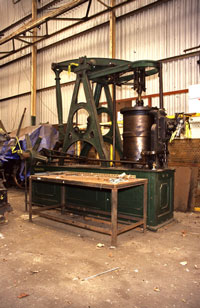
Glemsford silk mill steam engine |
|
1849
|
Steam power was by now well established. At Glemsford Silk Mill the Chequers Lane mill had been powered by a water wheel since 1824. In around 1849 a steam powered static engine was installed to supplement the water power. Chris Allen photographed this engine in store at Beamish museum and published it on geograph.org.uk. His description is, " It is a single cylinder A-frame, tank bed, beam engine. It was built by J T Beale of Greenwich c1849. Unfortunately the flywheel was cut back for display. The slide valve cylinder is 19" x 2' and the flywheel was 9' 5" diameter. It ran at 34 rpm on steam at 25 psi. It was donated to the museum in 1939.
The lease on the Bury market expired and the Corporation agreed to take over its management and fix the tolls.
By this time the parish of St James had opened a new school in Risbygate Street, while the St Mary's school was enlarged to cover several buildings in and around Sparhawk Street. A school place was now available in the town for every under 13 who wanted one.
In the 1840s, The College Street workhouse underwent alterations costing around £1,000. The architect for the enlargement work was William Mason who had undertaken a similar project for Hartismere Union, and also designed the Union workhouse at Ipswich.
In about 1840, T S Peckston, the major shareholder in the Bury St Edmunds Gas Light Company, had become insolvent. After spending time in the Fleet Prison for Debtors, he finally filed his petition in Bankruptcy. Among the people who had a claim on Peckston's assets were Oakes, Bevan and Co.'s Bank, who held deeds to land and 6 shares in the company as security for Peckston's loans. Robert Bevan, of the bank, had acquired a controlling interest in the Gas Company by 1849. He obtained an Act of Parliament, called the Bury St Edmunds Gas Act, 1849, which incorporated a new company called the Bury St Edmunds Gas Company, with power to produce town gas in Bury. Bevan now disposed of all the assets of the old company to the new company, for £8,500. The gas works had been in Tayfen Road since 1834, and by 1849 had sold gas at 10/- per 1,000 cubic feet. Bevan's new company immediately cut the price of gas to 8/4 per 1000 cf, and continued to reduce it in future years. This is the company which would continue to run the Gas Works in Bury into the next century.
The ground floor of the Concert Rooms in the Market Cross now became used as Council Offices. The building gradually became called the Town Hall, and was used as such until 1937.
In 1849 excavations were carried out in the Bury Abbey grounds by permission of Mr Muskett and the results were recorded in the issues of the "Bury Post" during the autumn of that year. These excavations of the east end of the abbey church and buildings near the river was also mentioned in G Hills, ‘The Antiquities of Bury St Edmunds’, JBAA 1865, Volume xxi.
Between 1849 and 1852 a number of local 'antiquarians', as they were then called, made collections of Anglo-Saxon objects from West Stow cemetery. Parts of these collections, made by John Gwilt of Icklingham, the Reverend Banks of Dillingham, Cambs and the Reverend Benyon of Culford, have survived and are to be found in the British Museum, the Ashmolean (Oxford), the Museum of Archaeology (Cambridge), Thetford Museum and at the West Stow Anglo-Saxon Centre.
A rail link was built from Haughley Junction to Norwich, via Diss. This gave Bury a railway route to Norwich. Sudbury was joined to Marks Tey by a seven mile link
|
|
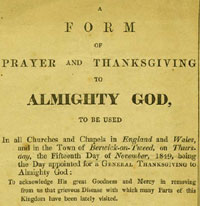
Prayer against Cholera, Sudbury 1849 |
|
blank |
The Sudbury Parish Records contain this poster advertising the day on which to give thanksgiving to 'Almighty God' for the disease of Cholera being 'removed', as disease was seen as a divine punishment. Cholera was a highly contagious and lethal disease, which first appeared in Britain in 1831. There was a brief reappearance in 1848/49 to which this poster refers. The king had issued notice that every church in England and Wales, and Berwick on Tweed, should utter prayers of thanksgiving upon the same day, namely 15th November, 1849.
During 1849 William and Hugh Rainbird published their, "Agriculture of Suffolk." They described Suffolk as "wholly without manufactures", a statement based on their observations of the drastic decline in the old cloth and spinning enterprises. "I say 'wholly' because those at Sudbury, Lavenham etc are too trifling to deserve mention and, small as they are, are decreasing."
However, the Rainbirds described Lavenham as still having two or three woolstaplers who mainly supplied yarn to Dublin for 'tabinet'.
(Huguenots had settled in Ireland and were particularly numerous in Dublin where they made the city famous for ‘tabinet’ or poplin, a fine cloth of mixed wool and silk.)
This export trade required the employment of 600 spinners in the nearby villages of Shimpling, Cockfield, Rattlesden, Brent Eleigh and Monks Eleigh, but the small money they could make was regarded as trifling, contributing very little to the household budget.
|
|
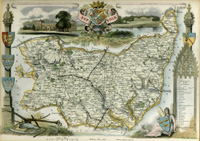
Railways in the years 1850-1853 |
|
1850
|
By 1850 there had been a considerable spate of railway building in Suffolk, as well as the rest of the country. Lowestoft was linked to Norwich in 1844, and Brandon and Thetford enjoyed being part of the Norwich to Cambridge line in 1845. Bury was linked to Ipswich in 1846 and Hadleigh got linked to Bentley on the Ipswich to London line in 1847. Sudbury was linked to Marks Tey in 1849, and in the same year, both Haughley and Diss were linked to Norwich.
Thus by 1850 the attached map of Suffolk's railway lines was formed. The map shows the picture between late 1849 and 1854. The map would need to be redrawn in 1854 when Bury would get linked to Newmarket and Cambridge. Sudbury would be joined to Haverhill in 1865, while Bury's line to Thetford would not be built until 1876.
|
|
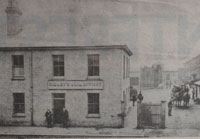
Ridley's Office and Coalyard c1850 |
|
blank |
By about 1850 Thomas Ridley had opened his new coalyard in Out Northgate, conveniently close to the railway yards at the Northgate Station. His old coalyard at the Fornham terminus of the River Lark navigation now became redundant as Ridley's town customers could be better served from his new premises here. By clicking on the attached thumbnail you can see the full extent of the premises. A horse drawn delivery waggon carrying bags of coal to customers is visible heading for the yard gate.
The Bury Corporation tried to enforce its rights to collect market tolls from shopkeepers using stalls outside their shops on market days. Counsels advice backed them up.
The current Borough motto seems to have been used from about this date - Sacrarium Regis, Cunabula Legis, or Shrine of a King, Cradle of the Law. The shield of crowns and arrows and the crest of a wolf holding a human head had been granted shortly after the 1606 charter.
At some point visitors were allowed into the Abbey Gardens for a shilling, and children for sixpence. The price was relatively high to control the clientele and exclude "undesirables".
The Public Libraries Act of 1850 paved the way for a national network of 4,000 libraries.
The Theatre Royal in Westgate Street in Bury was by now in use all the year round, rather than having a season around Bury Fair. In 1850, the programme was made more popular and prices reduced to attract a new, perhaps less genteel, audience.
The Cupola House was granted a license to sell Bell's patent brandy for medicinal purposes. However, it soon became a public house with beer and porter replacing Bell's medicinal brandy. From the 1880's until 1926 it was called the Victoria, but then reverted to Cupola House.
Benjamin Buck Greene, eldest son of the founder of Greene's brewery in Bury, became a Director of the Bank of England, a post he would hold for 50 years. From 1873 to 1875 he was Governor of the Bank of England. He had never been involved with running the brewery, but had first made a success of the Greene's sugar plantations in St Kitts, and then made Blyth and Greene a great merchant enterprise in London after 1846.
In 1850 the Camden Society published "Bury Wills and Inventories", a selection of local wills, intended to throw light upon the customs and language of the day. The 54 selected wills range from 1370 to 1650, and were edited by Samuel Tymms, Treasurer and Secretary of the Bury and West Suffolk Archaeological Institute. This was volume 49 of the Camden Society series of historical documents.
After 1850 it is generally accepted that the Little Ice Age which had prevailed since 1550, was over. However, the climate did not much improve until about the 1890's.
|
|
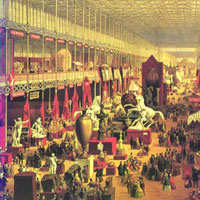
The Great Exhibition |
|
1851
|
The year 1851 was the year of the Great Exhibition, held at the specially built Crystal Palace in London from 1st May to 15th October. Bury St Edmunds Clock and Watchmaker, John Pace showed three exhibition pieces which were examples of the best that could be achieved in his field at the time. Page 419 of the Exhibition Catalogue refers to "Pace, J. Bury St Edmunds, - Inventor, Designer and Manufacturer". He showed two clocks and a barometer, as follows:
- A Skeleton Clock which goes for three years. This period is obtained by the use of six springs, the united force of which is 250 lbs.
- A Pyramidical Skeleton Timepiece, which goes for three months. The dial is placed at the bottom of the clock to show the motion of all the wheels.
- A Barometer of highly-polished brass, containing three glass tubes, supported by scroll work.
John Pace worked at 19 Abbeygate Street from 1823 to 1855, and was the most important of Bury's clockmakers in the 19th century. The Gershom Parkington collection includes one of his silver watches from about 1840, and another silver watch from 1823. The latter has a leopards head, crowned, and a lion passant. The collection also has a John Pace 8 day long case clock in a tall laquered case standing about 8 feet tall.
Suffolk industry was also well represented at the Great Exhibition. Ransomes showed their new Iron drop Drill and Roller Mill, Garrets showed their Thrashing Machine and Horse Hoe. Burrell’s of Thetford took an array of Steam Engines. Turners of Ipswich exhibited their own four horse-power steam engine and their improved corn and linseed crusher. Other Suffolk machines on display were a crushing and grinding mill manufactured by Woods of Stowmarket, a clover threshing machine from Sargent of Long Melford, a universal self-adjusting cultivator from Bendall of Woodbridge and a model of a tipping wagon from Swan of Boxford.
There was a census in 1851, and since the 1841 census, it was decided to improve the collection of statistics.
Suffolk had a population of 335,000 by 1851, about 50% greater than in 1800. Bury's population was now 13,900, a 45% increase since 1801. Farm prospects began to improve in the 1850's, and some landowners tried to help the plight of poor workers by providing model homes or cottages. The Bunbury estate at Great Barton had cottages which were "well built, airy and commodious", whereas in Bury there were many "miserable hovels," and "extreme misery".
On the Culford estate The Reverend Edward Benyon also designed and built many new cottages for his workforce. However, Benyon expected all his tenants and workers to adhere to his strict rules. In January 1851 the Bury and Norwich Post carried a letter from William Devereaux, who had been evicted from his home at Wideham Cottages in West Stow. Devereax claimed that he had been convicted of poaching on perjured evidence. He received a five shilling fine, with 19s 6d costs, and £1 1s 8d in surcharges. However, Benyon had him evicted and he was now living with a wife and eight children in a shelter of wood and sods on Icklingham Heath. "No one around dare take me into shelter me, nor no one to let me have a house." Upon being ordered by Benyon to dismantle his makeshift home, Devereaux was eventually housed by the Reverend Daniel Gwilt of Icklingham. John Vale, a witness in Devereaux's defence, was also evicted from the estate.
Edward Greene, the Brewer at the Westgate Brewery was recorded as employing 18 men and 3 boys at these premises. This number would increase greatly in the next decade.
|
|
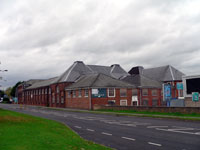
Dunnell's Maltings of 1851 |
|
blank |
The coming of the railways would have a profound effect upon the commerce of the River Lark. This navigable river extended from the Great Ouse river, through Mildenhall and upstream as far as the Fornham Wharf. This wharf was within the parish of Fornham All Saints, upon land owned at the time by Sir Thomas Gery Cullum.
Much of the land at the Fornham Wharf had been coalyards, and most of the tonnage on the river had been coal. The Ipswich to Bury railway line had been delivering coal right into Bury St Edmunds at Northgate Street since December 1846. Thomas Ridley had rented a coal warehouse from Sir Thomas at Fornham Wharf, but he no longer required its use. Sir Thomas probably did not have the money, or the inclination, to redevelop the site himself, so he let it to Robert and John Dunnell, who built a large new Malt House on the site.
This is what the White's Directory of Suffolk for 1855 said about it.;
"Sir T R Gage, Bart, is lord of the manor (of Fornham All Saints), but part of the soil belongs to Sir T G Cullum, Bart, on whose estate, at the south-west angle of the parish,1 mile N. of Bury, is a commodious Wharf, at the termination of the Lark Navigation, ... and a large Malting House, built in 1851."
The Directory for this parish failed to identify a maltster, but a James Footer was recorded as a carpenter, "Wharf", presumably indicating that his business took place at the Wharf.
The wharf was served by a cut from the River Lark which then turned 90 degrees to run parallel to the Mildenhall Road. This cut survived in a silted up form until the 1960s, but was filled in to provide land for development.
Nothing remains of the Wharf either, which now lies beneath the UPS distribution depot, but the Maltings was used for this purpose until at least the 1960s. Later it became a furniture warehouse, finally known as Kingsbury's, but in 2008 it has stood empty for several years. Some iron ties at the northern end of the building still display the inscription, "TGC 1851".
|
|
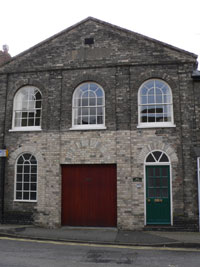
Chapel House, 23a Garland Street |
|
blank |
After twenty years at 15A Garland Street the Primitive Methodist congregation had grown considerably and they needed to find new premises. This would be a purpose built chapel, rather than be a converted house as at 15A.
In 1851 the primitive Methodists completed their new chapel in Garland Street, located at what is today number 23A Garland Street. This had a capacity of 120 people, and would be in use until 1902.
Their previous chapel, located nearby, at number 15A Garland Street, would be sold to the Plymouth Brethren in 1853.
In 1851 there was a national census of religious worship to measure how many places were available in church and chapel to accomodate the growing population. Census Day was 31st March, 1851. For some reason the Primitive Methodists at Garland Street did not submit a return. Perhaps the change of location caused it to be overlooked.
The St Mary's Square Wesleyans reported attendances well below their capacity of 400 places. Both the Baptists in Garland Street and the Whiting Street and Northgate Street Independent chapels reported congregations larger than the Wesleyans. The Quakers had declined over the last fifty years and reported a very small number attending. The Unitarians in Churchgate Street reported numbers similar to the Wesleyans.
This upsurge in independent religious activity has been seen as very important in ameliorating the economic and political disturbances of the times. In 1848, the year of revolutions throughout Europe, it was able to be thought that "Methodism saved us from a bloody revolution", although it is clear that it was Primitive Methodism that captured popular support.
Straw plaiting was well established in south west Suffolk by the time of the 1831 census, and by 1851 there were 2,220 girls in Suffolk employed as straw plaiters.
Lavenham had 300 straw plaiters in 1851 according to the census, and about a dozen people used the plaits locally to make straw bonnets. Other plaited straw went to Luton for the hat makers there. The Napoleonic war had finished off the old cloth industry in Suffolk. To use the skilled labour attempts were made to find other industry. Straw plaiting was introduced to Suffolk in the late 18th century, having started in the south midlands. Straw plaiting was a skilled job, and plaiting schools were established to teach girls the skills.
In 1871 there would be still be 2,335 women and girls plaiting straw in Suffolk, but by 1881 they would be down to just 781.
By 1881 the hand plaiters were largely replaced by machinery, and after 1890 English straw plaiting would be wiped out by foreign competition.
Silk weaving had come to Haverhill, Bungay, Sudbury and Glemsford around 1800, and silk weaving would survive in Sudbury to the present day.
From 1830 - 1860 the weaving of horsehair and coconut fibre was introduced, particularly in the same area of the Hundred of Babergh.
The 1851 census recorded a William Richold, age 26, as a coconut manufacturer at Long Melford. By 1855 White's Directory would describe Richold as a manufacturer of "cocoanut fibre mats, matting and brushes."
The same census recorded three horsehair manufacturers in Melford. John Churchyard was employing 43 men, 56 women and 12 boys. William Groom had 86 employees, and Henry Lengemann employed 2 men, 10 women and 12 boys. It had been Churchyard who had first brought horsehair manufacture to Melford in the 1830s, from where it spread to Lavenham, Cavendish and Glemsford.
John Churchyard was making horse hair seating at Water Street, Lavenham by the time of White's Directory in 1855, having started at Melford in the 1830s.
Horsehair and coconut matting manufacture would last in the area into the 1930's.
Drabbet was a mixture of linen and cotton which became a speciality of Gurteens of Haverhill.
|
|
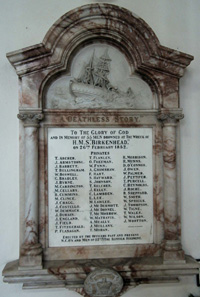
HMS Birkenhead Memorial |
|
1852
|
In 1842 the Reserve Battalion of the East Suffolk Regiment was formed and in 1851 it was sent to South Africa for the Kaffir Wars. In 1852 a draft of one sergeant and 79 private soldiers of the First Battalion East Suffolk Regiment were sent to join them on board HMS Birkenhead. In all, there were 10 regiments represented aboard the vessel, and a large proportion of the young recruits were Irish, many in the Black Watch.
They were shipwrecked off Cape Danger, about 100 miles south east of Cape Town, South Africa, on 26th February 1852. The soldiers stood steady on parade on deck as the ship went down, to allow the women and children into the lifeboats. The famous expression "women and children first" arose following the widespread admiration of this event. Only 207 of the 636 people on board survived and 55 of the Suffolk soldiers were drowned, or fell victim to sharks. The Black Watch, then the 73rd Regiment of Foot, suffering the heaviest losses.
There is a memorial to the 55 Suffolk men in St Mary's Church, Bury St Edmunds, unveiled by the Marquess of Bristol in 1907. The list of names can be seen by clicking on the memorial illustrated here. A painting of the incident was produced by Thomas M M Hemy in about 1892, and prints were widely circulated.
From 1846 to 1852 the USA was covered in telegraph lines. London was traversed by wires by 1850. It was the 19th century equivalent to the internet. News could cross a continent in minutes, but it slowed dramatically to ship speeds at the coasts.
A new factory was opened at Chevington for the production of ready made clothes to be sent to London and overseas. It drew on up to 600 women for labour working both in the factory or as outworkers, both full and part time. Women whose husbands relied on meagre agricultural wages could greatly improve the family standard of living from this income. Chevington only had a total population of around 600, so clearly the factory drew workers from a much wider area than the village itself. In White's Directory of Suffolk for 1855 the manager was listed as William Beales of Bury St Edmunds, who also had establishments in Essex. This operation was linked to, and probably owned by, the wholesale clothing and outfitter's business of Robert and Henry Parnall of Bishopsgate in London. The factory seems to have begun in a barn of what was later called Factory Farm, and then a purpose built factory followed in about 1862. Goods were taken to Bury railway station for delivery to London.
|
|
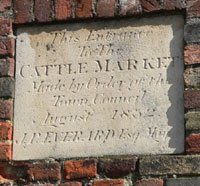
Risbygate Street Market Entrance of 1852 |
|
blank |
In August 1852 the Bury Town Council made an order for a new access to be made into the Cattle Market from Risbygate Street. In those days there were no lorries to deliver beasts to market, and they would be driven on foot through the streets to and from the market. This was still happening in the 1960's. The entrance off Risbygate Street meant that animals were less likely to stray into the town centre than they were if taken up St Andrews Street South to the old entrance.
|
|
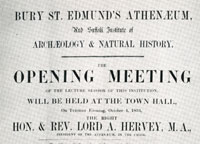
The Athenaeum and Suffolk Institute combine |
|
1853
|
The Reverend Lord Arthur Hervey became the first President of a new society formed by leading citizens of the area. On 13th January a public meeting was held to consider "consolidating the various literary and scientific institutions of Bury St Edmunds into one efficient and dignified Institution". The Bury and West Suffolk Archaeological Institute had been formed in 1848. The Bury St Edmunds Athenaeum seems to have been set up at this time, including the members of the Young Men's Institute. The Bury and West Suffolk Museum also existed as a separate body, as did the Library located at the Guildhall. As for the Athenaeum, they called themselves the Athenaeum Literary Institute, and for a time they were based in a house in Guildhall Street.
On 13th April, following the January public vote in favour of a merger, the Archaeology Institute resolved formally to be placed "in union with the Bury St Edmunds Athenaeum." They also resolved to widen their sphere of coverage to the whole of Suffolk, and into the fields of Natural History, and art, particularly portraits of local worthies. The Institute now renamed itself The Suffolk Institute of Archaeology and Natural History.
This was a less than complete union as the SIANH had a subscription of ten shillings, but members had to pay another sixteen shillings to gain access to the News Room, Library and Lectures of the Bury Athenaeum. This is illustrated by the opening meeting of the new united body which took place on October 4th 1853, under the title of "Bury St Edmunds Athenaeum and Suffolk Institute of Archaeology and Natural History."
The first volume of the Proceedings of the SIANH was published in 1853.
On 7th April, 1853, after several years of negotiations and hesitations, the governors of the King Edward VI Grammar School signed an agreement to sell a little over two acres of St Peter's Barn Farm to the Chesterford and Newmarket Railway Company for £625. To enable the farm tenant, Mr George Beeton, to continue to work all parts of the farm the agreement included the construction of a level crossing on Beeton's footpath.
One of the last enclosures of old open fields was at Barrow in 1853. Most land enclosure was finished off between 1770 and 1840, and it was to be all over by 1880.
In 1853, William Cobbett published his book "Rural Rides in Surrey, Kent and other counties", better known to us simply as "Rural Rides". These rides were undertaken from 1821 to 1832, and include his own "economical and political observations". He was in Norfolk and Suffolk in December 1821 and again in 1830. His observations are reported in this chronicle in those years.
In December the Electric Telegraph lines arrived at Bury station from the Ipswich direction. Messages could be sent and answers received within minutes.
|
|

15a Garland Street |
|
blank |
In 1853 the Plymouth Brethren took over the old Primitive Methodist Chapel at 15A Garland Street, and would use it for worship until 1939. The Primitive Methodists had already moved to 23A Garland Street into bigger premises two years earlier.
|
|
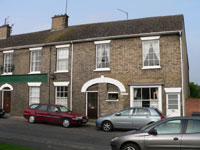
The old Seven Stars |
|
blank |
In 1853, Henry Cockton died of tuberculosis at the age of 46. He was born in London, but during the 1840's he had been a travelling salesman, often visiting Bury and lodging at the Seven Stars public house. The Seven Stars was located at what is now numbers 18 to 19a Long Brackland, and the bracket for the inn sign, and the bricked up entrance to the inn yard can still clearly be seen. At the same time as travelling he was trying to establish himself as an author. In 1840 he wrote the story of Valentine Vox, who was a stage ventriloquist who solved various mysteries. This was a successful book, as were most of his other works, but to a much lesser degree. In the early 1840's he married the daughter of the Seven Stars landlord, and took her off to live in London. By 1846 he had run into financial disaster and moved back to Bury. In 1846 he became the landlord of the Seven Stars. Financial problems continued to dog him, and he even used his mother in law's money to invest in a maltings. This business also failed.
|
|
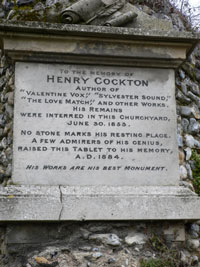
Henry Cockton's Memorial |
|
blank |
Today he is unknown, but his works became very popular during the nineteenth century. In 1884 some admirers of his work subscribed to erect a memorial tablet in his honour. This can be seen in the Great Churchyard attached to the Mausoleum.
Even in 1899, the Daily Telegraph newspaper offered its readers "the 100 best novels in the world" for nine guineas. One of these novels was Valentine Vox by Henry Cockton.
|
|
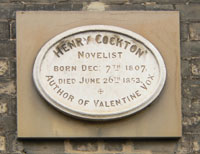
Henry Cockton's plaque |
|
blank |
In the early 20th century a plaque was erected to his memory on the wall of number 16 Long Brackland, next door to the Seven Stars. Today he is a footnote in literary history, remembered only as the author of Valentine Vox.
|
|
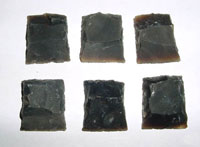
Brandon gunflints
|
|
1854
|
Britain joined the Crimean War in 1854. It would continue until 1856. In Brandon there was an increase in the demand for the flints needed for flintlock rifles and pistols. The British army no longer used flintlock weapons, but during the Crimean War Brandon supplied eleven million flints annually
to the Turkish Army. The flint industry in Brandon now consisted of three masters employing thirty-six knappers. Flints were produced in a variety of sizes to suit different gunlocks, and a continuing supply was necessary for any weapon that was regularly used. In 1807 a patent had been issued for a new percussion lock which would use a percussion cap to replace the need for the spark generated by gunflints. By the time of the Crimean war the more modern armies, such as Britain, had been converted to percussion locks, and no longer needed gunflints. However, Brandon flints were still in use in Abyssinia in 1935, and even in
1950 2,000 gunflints were being made each day,
mainly for export to Africa.
By now the social life of Bury had changed. The grand balls and assemblies had faded away, and the Assembly Rooms Subscribers wanted to sell their fading asset. An appeal was launched by Lord Arthur Hervey and 500 new subscribers were conveniently found in his Athenaeum Institute to put up enough to buy the building. Thus the Athenaeum Literary Institute acquired the Assembly Rooms building on the Angel Hill, Bury and changed its name to the Athenaeum. Pig Lane, formerly Punch Lane, now became known as Athenaeum Lane. The building would soon gain a Reading Room, a lending library and a Billiards Room. One upstairs room housed a museum from 1854, which was basically the collection of the Archaeology Institute. This room was used as a museum until the opening of Moyse's Hall in 1899. The Ballroom became called the Lecture Hall. Eventually in 1861, an observatory was put in the roof following a successful lecture on Astronomy.
|
|
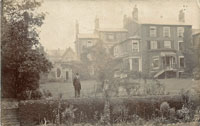
6 Westgate Street from rear
|
|
blank |
By 1854 Edward Greene was making good returns from his Westgate Brewery. He had been living in his childhood home, the old house off Crown Street since 1840, but now moved into his father's grand house at 6 Westgate Street, adjacent to the Theatre Royal. The house in Crown Street which had once been the retirement home of John Reeve, the last Abbot of Bury, was finally demolished. The site was used over the next two years to extend the brewery and has now completely disappeared under brewery works.
Across Bridewell Lane Greene also built the Foundry Maltings, facing Westgate Street, but next to the School maltings.
Edward Greene also now extended his business into farming. He leased Stone Bridge Farm in Bury from Lady Cullum of Hardwick, for a twelve year term. At first its 138 acres provided extra fodder for the brewery horses, but it became more integrated into the business. The farm could provide some malting barley, as well as fodder, and spent grains from the brewery could in turn go to feed the animals. The labour could also be shared between brewhouse and farm.
In November the first Chrysanthemum Show was held in the Corn Exchange. These shows have continued annually into the 21st century.
The existing railway link from Cambridge to Newmarket was extended to Bury St Edmunds which was already linked by rail to Ipswich and beyond. The new line crossed land which had to be purchased from existing owners, including the St Peter's Barn farm tenanted by George Beeton from the Governors of the town's Grammar School. A level crossing had to be built on Beeton's footpath to link the parts of the now severed farm.
At Bury's Northgate Station further works had to be carried out to accommodate the new line from the west. The existing turntable to the west of the station had to be removed, along with an engine shed. New sheds were built by extending lines on new embankments on to what is now called Station Hill. The station already had two platforms so no changes were needed there.
Rail traffic could now flow from Ipswich to Cambridge and on to the Midlands. Bury had a choice of two routes to London now. The Jockey Club had insisted upon a tunnel being dug under Newmarket Heath so as not to scare the horses, but this was an unnecessary cost, and a cause of delays as it was a single track only. As usual over-grand buildings adorned even small hamlet stops along the route. Higham's station opened on April 1st.
Another station was opened at Saxham. The clothing factory at Chevington could now bring and send deliveries through Saxham station instead of taking the longer journey to Bury station.
The Assizes for the county were held at Bury on March 27, 1854, and "the Lord Chief Justice having walked in to the Abbey Grounds on Sunday, a shilling was demanded of him for admission. After charging the jury, on the Monday, His Lordship had the Curator, Mr Hodson, before him, and told him it was penal to demand payment for admission to such places on the Lord's Day."
In 1854 the St James's National Schools were built in Risbygate Street. Although adjacent, they were two seperate schools, one for 200 boys, and the other for 200 girls.
In Raingate Street the Globe inn was opened directly opposite to the Coachmakers Arms. Raingate Street was a poor and narrow street, the east side backing on to the marshy No Mans Meadows. The coachmaker Francis Crane had given up his coachmakers business on Angel Hill, and opened the Coachmakers Arms as a beerhouse in about 1843. This inn lasted until the 1860's. The Globe, however, became the Rutland Arms in 1878, and survived until 1992.
In the 1850s there was a considerable movement against burial of the dead within town or city limits on health and hygiene grounds. There was concern about the re-use of graves and the overcrowding in most existing churchyards, many of which had been in use for hundreds of years. Burial Acts of 1852, 1853 and 1854 gave the crown the right to issue Orders in Council to close specific burial grounds throughout the country. The Acts also required any new burials to be outside the built up areas, and gave the Vestries the power to set up new Burial Boards to make the appropriate new arrangements.
On 11th August, 1854, such an Order in Council was made instructing that with effect from 21st August, 1854, there should be no more burials within inhabited areas. However the Order included a few exceptions to that general rule, at Diss, Manchester and at Bury St Edmunds.
The appropriate Order in Council for Bury St Edmunds read as follows:
"BURY ST. EDMUNDS.—Burials to be discontinued
in the churches of St. Mary and of St. James,
(reserving to Mrs. Harriet Haggitt the right
of interment in her husband's vault under
the chancel of St. James's Church) ; and
from and after the first of January, one
thousand eight hundred and fifty-five, in the
churchyards of the same, in the burial-ground
of the Whiting-street Chapel, and in the
Baptist Burial-ground. To be discontinued
forthwith in the Friends' Burial-ground
within five yards of the walls of the chapel
and of any dwelling-houses.
C. C. Greville."
|
|
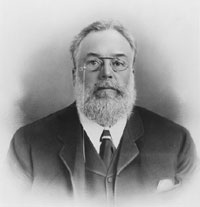
Daniel Gurteen III
|
|
blank |
The Lancashire cotton boom, around the middle of the nineteenth century, hit the hand weavers of Haverhill (although hand weaving carried on in back-garden sheds did not finally die out until the late 1920s).
In 1854 the great grandson of the founder of the Gurteen Company of Haverhill, also called Daniel Gurteen, entered the family business. Later, writing of 1854, he stated that: "At that time the whole town (Haverhill) was in a most miserable condition, being looked upon as one of the most God forsaken places in the world." Often 500 men stood idle on the Market Hill, waiting for work and food. "So great was the distress that the Vestry met twice a fortnight for the purpose of finding means of sending families to Australia and elsewhere."
The Haverhill Enclosure Act was passed by Parliament in 1854 and the last open fields at Withersfield, near Haverhill, were enclosed. This was another blow to the common man as some landlords could now enclose and fence off common lands or areas where people may have gathered firewood or grazed animals, or caught rabbits in the past. A survey of 1737 had recorded Rookwood Common, Small Millfield Common, Broadcroft Common, Millfield Common and Westfield Common around Haverhill.
One small relief came in 1854 when the Haverhill Gas Works was opened in Withersfield Road by the Stour Brook.
At Diss, the open air Corn Market was replaced by the newly built Corn Hall. During the 1850s nine other Corn Halls would be newly erected in Norfolk. This was also happening on a national basis, and perhaps this was one reason why Bury St Edmunds felt the need to start thinking about a grand new Corn Exchange to replace the existing Exchange Building which was built in 1836. During the 19th century towns were practising one-upmanship in their civic buildings, just as medieval communities had practised it in their church buildings.
|
|
1855
|
On 1st January, 1855, by Order in Council, no further burials were to be allowed within the boundaries of the Borough of Bury St Edmunds. This prohibition was being enforced throughout the country, following the Burial Acts of 1852, 1853 and 1854. It was felt that burials should henceforth take place outside built up areas for health reasons.
It is easy to see why such concerns came about. William Spanton has described the scene in the old churchyard in his book entitled, "Bury St Edmund's".
"Until the opening of the cemetery, in 1855, the churchyard was like the Grave Digger's Scene in Hamlet, and my father, when a boy, often amused himself by helping the Sexton dig the graves and throw up the skulls: his father used the crypt of St Mary's as a workshop."
However, at Bury St Edmunds the deadline of January 1st could not be met and extension of time was granted, but only for a few months. The land for the new cemetery was purchased by Bury St Edmunds corporation from Mr George Brown of Tostock Place. It cost £2,276.16.0, and was known as the Westfield Farm purchase. The first plot of land laid out was about 11 acres. Up to this time the road up to the new cemetery had been known as Field Lane, but it naturally now became called Cemetery Road. At that time the land was on the edge of town. Further development came along Cemetery Road and in 1911 it would be renamed Kings Road.
The chapels and the lodge at the Cemetery were designed by Cooper and Peck, and together with the entrance gates cost nearly £1,900.0.0. Laying out the ground and accomodation works cost another £5,500. The new cemetery was finally opened for burials on October 1st, 1855 and the chapels were consecrated by the Bishop of Ely on 23rd October of that year. A further plot of land would need to be bought in 1880 to enlarge the burial ground.
The Churchyard between St Mary's and St James' was now closed to further burials. It had been used for burials at least since 1148 when it was enclosed by the abbey precinct walls. The earliest surviving gravestone today is dated 1637, and many gravestones have been removed and lost over the years.
|
|
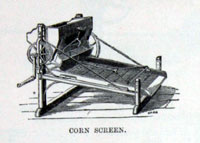
Boby's Medal winning Corn Screen |
|
blank |
In the London Gazette 1855 page 2665 is found the following official public record concerning applications for patents:
Patent Law Amendment Act, 1852.
Office of the Commissioners of Patents for
Inventions.
"NOTICE is hereby given, that—
......................
478. And Robert Boby, of St. Edmund's, Machinist,
and Thomas Cooper Bridgman, both of
the same borough, in the county of Suffolk,
Chemist, have given the like notice in respect
of the invention of " improvements in corn
dressing and winnowing machines."
As set forth in their petition, recorded in the said
office on the 3rd day of March, 1855."
This announcement was the start of the factory of Robert Boby which would last well over a hundred years in Bury St Edmunds. In 1855 he built the Improved Corn Dressing and Winnowing machine to separate corn from chaff, and won a gold medal with it at the Chelmsford Show in 1856. He decided to go into manufacturing rather than license the invention to anyone else. Presumably Bridgman would receive a royalty on each machine sold.
Such new and relatively heavy machinery could now be shipped easily to anywhere, home or abroad, via the railway system which covered all major ports by this time. This was to be very important for the development of industry in the town. At this time there were probably still about 300 families in Bury involved in agriculture, while the largest single source of employment was probably in domestic service. The Gas Works was the only other industrial type of work available.
Initially Boby seems to have made use of the yard behind his iron monger's shop in the Meat Market to produce his new machines. But he may well soon have been renting space in the defunct Home Maltings in St Andrews Street for some time before he finally purchased it. He did not risk buying further property until 1860.
Since 1712 the government had limited news and discussion by placing a tax on every copy of a newspaper that was sold. The Stamp Act of 1712 had lasted for 140 years, with the rate of tax, or stamp duty, varying with the times. By 1815 the duty on a newspaper was increased to four pence. In 1836 the government had been persuaded to reduce the stamp duty on papers by one penny, but paper and even advertisements in papers, were still taxed. The advertisement levy was not ended until 1853, and in 1855 when the Stamp Act was finally repealed, many new papers sprung up, often calling themselves a Free Press.
|
|
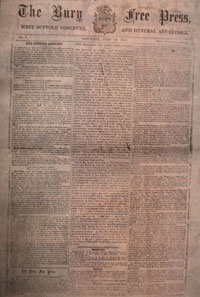
Bury Free Press established |
|
blank |
Thus the Bury Free Press was established in July 1855 to appear on Saturdays, not on Fridays as it does today. Its full name was The Bury Free Press, West Suffolk Observer and General Advertiser. Because the Newspaper Tax had just been abolished it meant that newspapers became available to a wider public because they could be sold at a lower price than hitherto. The BFP could be sold for three halfpence, pronounced "three haypence" by those of us who went to school before decimalisation in 1971. It had 8 pages, and was only 13 inches by 10 inches. It aimed to be a complete newspaper in that it included national and international news along with local news.
It was founded by Thomas Lucia, who had worked on the the other Bury paper, which was the Bury and Norwich Post, for 11 years. He lived at 8, The Buttermarket, where he already had a shop selling tobacco, snuff and Rose's tea, to supplement his pay at the Bury Post. This was to be his office for the new paper, but he printed it in Half Moon Lane, also known as High Baxter Street. Later he would move his printing press into 15, Abbeygate Street.
With the abolition of the Stamp Duty, the Bury and Norwich Post would also increase its sales, and doubled its size from four to eight pages. The two newspapers would continue to circulate in Bury, in competition, until 1932.
White's Directory of Suffolk for 1855 noted that:
"In consequence of an arrangement between Sir T G Cullum and the Railway Company, the traffic on the Lark Navigation is now much diminished."
During this period of the sudden decline of the River Lark navigation, Sir Thomas Gery Cullum died, aged 77, on February 3rd, 1855. He had made many improvements to the river in the 1840s, but the new railways had largely destroyed the barge trade.
The Reverend Sir Thomas Cullum of Hardwick and Hawstead had no sons, and neither did his brother, John Palmer Cullum. The baronetcy would thus become extinct in 1855, on Sir Thomas's death. However, the estates passed to his daughter Arethusa, the wife of The Right Honourable Thomas Milner-Gibson. The Cullum name was adopted by their youngest son George Gery Milner-Gibson, (1857-1921), so he became known as George Gery Milner-Gibson Cullum. This would enable him to inherit the estate in his turn.
Frederick William King, a farmer at Kirtling in Cambridgeshire, but with origins around Gazeley, had married Emily Maulkin of Brinkley Grove, in 1852. This brought him into close contact with the Maulkins of Bury St Edmunds, one of the best known business families in the town. In 1855, Fred and Emily King gave up the farm, and moved to Bury, where Joseph Maulkin, Emily's great-grandfather, had established a house, granary and malting business in St Mary's Square dating back to 1765.
Unfortunately, Emily's father, Robert, had made several errors of judgement when he ran the business from 1827 to 1836, and had retired to Brinkley Grove, leaving a partner, George Beeton, in charge of the business at Bury. Fred King now joined Beeton in the Maulkin Maltings, and by 1858, Fred King would take over the business completely.
White's Directory of Suffolk for 1855 observed that:
"An Act for better paving, lighting, cleansing, watching, and
otherwise improving the town of Bury St. Edmund's, was passed in
1811, and it was amended by another Act passed in 1820. Under
these Acts, the town has been greatly improved, and is now well
paved and lighted, and nearly all the streets have flagged causeways in place of the rough pebbled footpaths which existed in most
of them till 1811. The commissioners have recently done much to
improve the sewerage, and steps are being taken to secure a constant
supply of water for public and private uses, by the construction of
water works, under the powers of an act of parliament. At present
the only supply is from springs, wells, and the roofs of houses.
The Paving and Lighting Commissioners meet on the first Monday of every month. Jas. Sparke, Esq., is their clerk; Mr. John
Trevethan, surveyor; and Messrs. G. E. Whitaker and John Ward,
rate collectors."
|
|

Cheaper railway coal |
|
blank |
Through November and December 1855 Thomas Prentice at the Town Hall proudly announced that his new Railway Wharf was now in operation to bring best Staveley coal to Bury St Edmunds for 19/6 per ton. Delivery in town would cost another 1/- a ton. Railway Wharf was not on the River Lark, but was his name for his new coal depot on Station Hill, served by rail, not by water.
In 1844 the horsehair industry had been introduced to Glemsford when Messrs. H, Kolle & Sons built a factory in Bells Lane for the processing, curling and weaving of horsehair. By 1855 Kolle would be employing 470 hands making horsehair and cocoanut matting products at Glemsford.
|
|
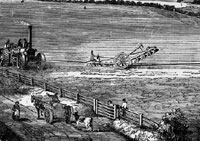
Steam Ploughing |
|
1856
|
Ransomes of Ipswich collaborated with John Fowler to produce the world's first steam ploughing set. The Ipswich firm had an established works, and was already building portable agricultural steam engines. John Fowler had designed a successful mole draining system, and was full of new ideas. Fowler found Ransome's receptive to his ideas and willing to develop them. The key to the idea was Fowler's invention of a double ended balance plough which could be pulled by steam power across the field on a cable attached to a steam engine at the edge of the field. The plough could then be tipped and run back across the field. This plough was the basis of steam ploughing for the next 90 years.
(John Fowler went on to found possibly the greatest traction engine works ever, Fowlers of Leeds, in 1861, at first only producing steam ploughing sets.)
The picture shown here comes from Burrell's catalogue of 1881, and is here shown fully developed, but steam ploughing began with the Fowler/Ransome's trial at Nacton in Suffolk in 1856.
Although such mechanisation would become used in larger farms, agricultural work continued to be largely manual. Horses would be used right through to the Second World War.
|
|
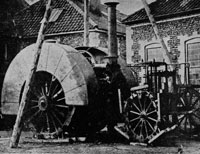
The Burrell-Boydell Engine |
|
blank |
Meanwhile, at Thetford, the firm of Charles Burrell began to build traction engines equipped with the Boydell "Endless Railway" system. This was an attempt to add shoes to the wheels, which overlapped to produce a continuous track. Burrells themselves regarded this as the birth of the first heavy duty steam road haulage engine. The picture shows this engine, probably in Burrell's own yard at Thetford. Many of these machines were made and many were exported. The following year Burrell's demonstrated the Boydell wheels on agricultural engines in a ploughing display at Thetford. However well this system worked it was abandoned after 1862 because the tracks were too prone to breakages.
In Bury, Robert Boby, who was an ironmonger on the ButterMarket, had decided to set up a factory to build his patented agricultural machinery. Boby had been recorded as an Ironmonger, Brazier and Turner as early as 1843, and was of an entrepreneurial turn of mind. At the Chelmsford Royal Show of 1856, the Corn Dressing and Winnowing Machine built in Bury St Edmunds won a Gold Medal. In the first full year of production, Robert Boby produced 200 Corn Screens of his and Bridgman's own design. These would become very popular and by 1887 he would sell over 13,000 units all over the world.
|
|
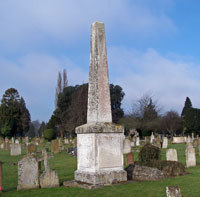
Francis King Eagle obelisk |
|
blank |
Francis King Eagle, one time radical politician, died on June 8th 1856. His memorial can be seen in the Cemetery which was newly opened in the previous October of 1855. In the middle of 1831, Francis King Eagle came to live in Bury. He was already known for his liberal politics and attachment to reform. When the Great Reform Act was passed, he stood in Bury as a Radical Reform Whig candidate in the 1832 General Election. He had been declared the winner on a show of hands, but following an adjournment and a full recorded poll three days later, Eagle had narrowly lost to the usual Fitzroy and Jermyn combination. He became the first Mayor of Bury St Edmunds following the Municipal Corporations Act of 1835.
By this time the Bury St Edmunds Improvement Commissioners had been installing "underdrains" in several town centre streets to replace the ditches which had existed beforehand. These were discharging into whatever convenient ditch or watercourse was available. In 1856 the Commissioners invited tenders for the provision of an intercepting sewer which would receive the contents of the underdrains and discharge into the river at Eastgate Street, by the Fox public house.
In 1856 the White Lion public house in Brentgovel Street was the source of a street riot by a drunken mob, which spilled out into the town centre. The mob were protesting about the new County Police Force which replaced the old Borough force. The White Lion was an important Carriers House, with wagons travelling to and from local villages, particularly on Market Days. The large Carrier's yard at this inn made a good assembly point for the 1856 rioters.
William Wicks gave up as Landlord of the Bell Hotel, following a driving accident in his dog cart. The license was passed to John Bridgeman, who also ran the Angel Hotel, and the two hotels now ran their coaching services as a joint venture.
|
|
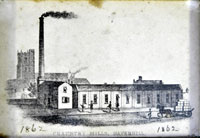
Chauntry Mill
|
|
blank |
Steps were also being taken by Gurteens of Haverhill to compete with the mechanisation in the north. A new steam factory called Chauntry Mill was built and two beam engines were introduced to power the looms. Up to this time most of their workforce worked in their own homes, either at hand looms or making up ready made clothing. The new factory had 32 power looms. The new material was now steam drabbet, a course but hard wearing linen-like material used for smocks, the working clothes of most rural workers. It was the denim of its day and Haverhill became a famous centre for the making of drabbet smocks.
|
|
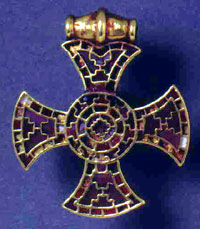
The Ixworth Cross |
|
blank |
Joseph Warren of Ixworth was a seller of clocks and watches and a collector of antiquities. He recorded that on February 18th of 1856 he bought the exceptional jewelled pendant now displayed in the Ashmolean Museum at Oxford, and labelled "The Ixworth Cross." He wrote as follows:
"This day was brought me a Gold Cross set with small garnets, also the front of a circular gold fibula, covered with filigree work, with a rim round it of very fine gold wire platted, unfortunately whatever was set in the fibula is gone......They were found by a man raising gravel at Stanton. The cross weighed 6Dwt 22 grs, and the fibula 5 Dwt 20 grs.
There was with them 24 articles of iron like staples, and 4 other pieces, the ends twisted as if intended for handles. I think a wood coffin had been used.
An account of them is published in the Collectanea [Antiqua] by Mr C R Smith, Vol 4, Page 162, pl[ate] 38."
Mr Warren's account was re-published in the Proceedings of the Bury and West Suffolk Archaeological Institute, Volume III, page 296. Joseph Warren's collection was sold to John Evans of Hemel Hempstead, and eventually ended up in the Ashmolean Museum at Oxford.
In 1856 the Camden Society produced its 66th volume of edited historical documents. This was the Diary of John Rous, who was Vicar of Santon Downham in the years from 1625 to 1644. The diary contains little domestic detail, but has many comments upon the politics and personalities of the day.
|
|
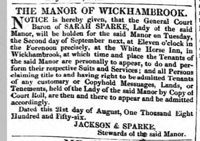
Announcing Court Baron
|
|
blank |
In a few parts of the deep countryside old vestiges of the medieval feudal system still clung on. At Wickhambrook the Lady of the Manor was Sarah Sparke, and local solicitors Jackson and Sparke were the appointed Stewards of the manor. This advert from the Bury and Norwich Post of 27th August, 1856 gives notice of a Manorial Court Baron to be held on 2nd September next at the White Horse Inn at Wickhambrook. All her tenants had to appear personally to "do and perform their respective suits and services."
The court baron was one of the three types of manorial court, the others being the court of the honour, and the court customary. However they were all of little importance by this time as judicial bodies. Prospective new tenants might be interviewed here, copyhold or customary tenancy transfers agreed on inheritance or sale, complaints or disputes heard, and rents collected. A record was made in the Manor Court Rolls.
The Crimean War ended and it was generally acknowledged to have been badly conducted, and that reform of the army was needed. The national defences seemed inadequate.
|
|
1857
|
In 1845 the West Suffolk Rural Constabulary had been established under the County Police Acts of 1839 and 1840. Bury St Edmunds had enjoyed a Borough Police Force since 1836, and it made sense for these two small forces to be amalgamated. The County and Borough Police Act of 1856 gave powers to do this, and on 1st January 1857, the Bury St Edmunds Police Force officially ceased to exist when the two forces merged.
The West Suffolk Police now moved out of the Shire Hall to join the Borough Police at Moyse's Hall.
In Bury the requirements of the Militia Act of 1853 were being carried out in Cemetery Road, known today as Kings Road. Each county had to provide NCO accomodation and a secure store for arms. A site of 2.5 acres was identified in Cemetery Road and its cost together with the buildings was £10,000.
One problem was that the Cricketers Inn stood in the way. This inn dated back to the early years of the century, and had at first been called the Green Dragon. It now needed to be demolished to make way for the new barracks. The Cricketers was now relocated to the opposite side of the road, making it in fact nearer to the Cricket Field from which it took its name. The Cricketers survived in this location until it was demolished to make way for the Parkway Road roundabout.
The new Militia Barracks was built with an armoury for 1,000 stand of arms, guard and orderly rooms, surgery, stores, powder magazine, prisoners' cells, as well as a yard and sheds. These new barracks would eventually be the muster point for 1,000 men of the West Suffolk Militia Regiment. They assembled annually for training. They would have 29 officers, 37 staff sargeants, and 40 other NCO's. The housing development called Yeomanry Yard is all that remains of the depot, but numbers 28 to 33 and 37 to 39 Kings Road are thought to be part of the NCO accommodation. The barracks in Risbygate Street was not to be built for another twenty years.
A new ward was added to the hospital in memory of The Reverend Hasted funded by public subscription.
Following recent elections at Bury, allegations were made that some voters were paid to vote for a candidate by way of "treating" at local inns. This was nothing new and had gone on for many years with various degrees of blatentness. A committee was set up to hear evidence from several innkeepers. At the Fox, for example, it was heard that 28 people were given a breakfast, and then taken to the poll in a state of intoxication. As bribery was very hard to prove, this practice carried on for some time.
A beerhouse called the Segment was opened on the corner of Station Hill and Tayfen Road. It had a distinct circular frontage wrapping around the corner, which no doubt gave it its name. Although the area was now under development. there were already other pubs in the vicinity. By 1864 this inn was renamed the Ipswich Arms.
The last open fields at Haverhill were enclosed and a Corn Exchange was built in Haverhill's High Street by St Mary's Church by William Wakelin Boreham.
At around this time many villages without a Chapel began to hold open air "Camp Meetings" on Sundays. These would be addressed by a local preacher who could be expected to walk 8 or 12 miles in all weathers to take the camp meeting. Most of these preachers were local working people. Shopkeeper, farm horseman, and fishmonger were the weekday jobs of three local preachers. Some camp meetings survived into the 1920s.
Meanwhile the bad news from the far reaches of the Empire was that the Indian Mutiny had begun in 1857. It would last into 1858.
|
|
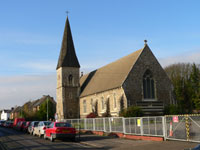
St Peters Church
|
|
1858
|
St Peter's Church was dedicated in Hospital Road, Bury. It was to serve the growing population in Westgate Ward, and was set up as a chapel-of-ease for St Mary's. It was started in 1856, largely supported by three generous ladies and the site donated by the Marquess of Bristol. The Bury Paving Commissioners sank a well, off what is now Kings Road, to get water to wash the streets. Eventually this well was developed for washing and drinking supplies.
|
|
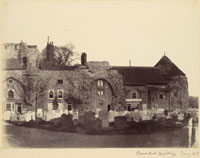 Sexton's Dyeworks West Front 1858
Sexton's Dyeworks West Front 1858
|
|
blank
|
This fascinating photograph is labelled "Conventual Buildings Bury 1858", better known today as the West Front of the Abbey. It clearly shows the existence of Sexton's Dye Works incorporated into part of the inhabited ruins. Also to be seen is the existence of gravestones on the green which is today the home of a sculpture of St Edmund by Elizabeth Frick.
|
|
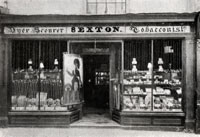 Sexton's Buttermarket shop in 1906
Sexton's Buttermarket shop in 1906
|
|
blank
|
In January 1858 William Watling Sexton moved his shop from 27 Abbeygate Street to 26, the Buttermarket. Sexton had a dyeing and scouring business, with the dyeworks operating in the Abbey Ruins in the churchyard, which he now incorporated into the Buttermarket premises. He also dealt in teas and tobacco products, and it is as a tobacconist's shop that 26 Buttermarket survived under the Sexton name until 1964. This shop was remarkable in that it retained much of the character of 1858 right up until its closure in 1964.
Quant's shoe shop was established in Abbeygate Street. The family were Baptists and had helped establish the Baptist Church in Bury St Edmunds in 1800.
In 1858 the Ebenezer Baptist Chapel at Egremont Street, Glemsford combined with Clare to pay the cost of opening a meeting room at Cavendish. However, a rift among the Glemsford Ebenezer members was now becoming evident. Despite this, the Ebenezer Chapel at Glemsford would survive until 1986.
In Haverhill, a new silk factory, the second one located in that town, was built by Kemp and sons.
|
|
1859
|
Charles Darwin published his revolutionary book on “On the Origin of Species by means of Natural Selection, or the Preservation of Favoured Races in the Struggle for Life”. The contents of this book caused a national furore.
The War Office sanctioned the formation of Volunteer Rifle Corps, and twenty one corps were soon raised in Suffolk. Two companies of the 13th Suffolk Volunteer Rifles were based in Bury. The 18th Corps was at Wickhambrook, and together with others around West Suffolk were under the 1st Administrative Battalion.
Following the agreement made 10 years earlier with the railways, the Lark Navigation was now in a badly decayed state. However, there was now a chance for a new canal operator to undercut the railway tolls, as the restrictive agreement had ended. A partnership of Henry Newson and James Lee could now try to make the river a going concern again. By 1861 they had failed to come up with the purchase price, and ownership reverted to Lady Ann Cullum.
The Bury Paving Commissioners adopted significant provisions of the Public Health Act of 1848 and the local Government Act of 1858 relating to sewers, drains and privies. New houses in Bury now had to be built with drains and a water closet. The Commission had established a sewage works at the Tay Fen, but in the 1850's it was causing concern because of smells and the usual problems of sewage disposal. However, most people still had nightsoil collected by cart, or stored it in the yard for sale to farmers. Something was needed a bit further out of town and capable of being gravity fed from most of the town.
In September 1859 the Commissioners agreed to extend the the sewerage system from Southgate to the Savens, (this location is behind Raingate Street adjacent to the modern police station), and from Tayfen Bridge to Northgate. At the same time they agreed to provide the new sewage filtration system by the river, at what is now called Bell Meadow. Access was to be from the Fornham Road opposite what is now Avenue Approach. This was to be operational in 1863.
Edward Greene began his policy of providing good housing for his workforce. He believed in loyalty and hard work, and respected the contribution made to his business by his employees. He also believed that the state should step in and pass a law that all houses should have at least three bedrooms. He once said that he would not own a cottage with less than this for housing a family. In 1859 he commissioned the first of such houses in Crown Street. Over the next 25 years he had built or purchased a further 40 dwellings in Bury to be let at low rents to his workforce.
|
|
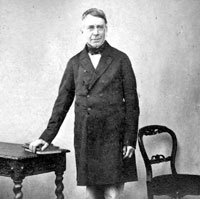
Sir George Biddell Airy |
|
blank |
In 1859 the Bury St Edmunds Literary Institute invited the Astronomer Royal, Sir George Biddell Airy, to give a lecture in the Athenaeum. Airy was a famous mathematician and astronomer, credited with many innovations and inventions. In 1851 Airy had established a new Prime Meridian at Greenwich. This line, the fourth "Greenwich Meridian," would become the definitive internationally recognised line in 1884. He had been educated at Colchester Grammar School and Trinity College, Cambridge. His talk apparently inspired the Literary Institute to such an extent that its members authorised the building of an Observatory on the roof of the Athenaeum. The planning and work took some time, but the Observatory would be opened in 1861.
In 1859 the Angel was offered for sale. Its assets included only one remaining stage coach, and since the coming of the railway in 1846, this once glamourous "flying machine" had been reduced to ferrying Angel customers to and from the Northgate Railway station. The Angel still kept 20 post-chaises for local travel, but even these would become out-moded within 10 years, superceded by the Broughams, Clarences, and Phaetons.
Charles Dickens stayed at the Angel Hotel in 1859 and 1861 for the purpose of giving readings from his work at the Athenaeum.
|
|
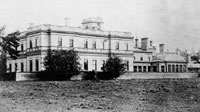
Stowlangtoft Hall |
|
blank |
Stowlangtoft Hall was built for the Wilson family in the fashionable Italianate style. It survives today as a home for the elderly.
Lowestoft got a railway line to Ipswich and hence to London and Bury. In the next 30 years its fishing industry would grow explosively. By 1880 it would become home to 300 trawlers, and 400 drifters.
The non-conformist road was not always a smooth one.
Some members of the Glemsford Baptist congregation claimed the Ebenezer chapel was too “hyper-Calvinistic” and wanted a more “Evangelistic view”. This discussion rumbled on for a year, but such were the convictions on both sides that 32 members left the Ebenezer congregation and built their own chapel, called Providence Baptist Chapel, on Hunts Hill at Glemsford. This opened on December 11th 1859.
|
|
1860
|
Sir Henry Edward Bunbury of Barton Hall had been in poor health for some time, and he died in April 1860. His eldest son, Charles James Fox Bunbury, inherited the Mildenhall and Great Barton estates and the baronetcy. Sir Charles and his family moved to Barton Hall in May and had to undertake the responsibility for the estates but he hoped there would be time for botany, which had become his main passion. Charles Bunbury had met Charles Darwin on a number of occasions, and in March 1860 Bunbury had read Darwin’s book with great care but confessed that he was not altogether convinced. He wrote “It is wonderful how much it has been talked about by unscientific people; talked about, of course, by many who have not read it, and by some, I suspect, who have read without understanding it, for it is a very hard book”.
For 200 years the Quakers had suffered civil punishments for the exercise of their beliefs, which included refusal to pay church tithes, church rates, military service, marriage and the making of wills, or swearing oaths. In 1860, for example, Jonathan Grubb had £10. 15s worth of hay confiscated.
The Bury St Edmunds Improvement Commissioners continued their programme of improving the town's drainage. A sewer was planned to run from the Fox public house to Out Northgate in order to link with the new sewage works at Bell Meadow just being considered. Following a report from their Consultant, Mr. Burns, the Commissioners agreed to apply for the necessary loan sanction, and when this was received, they approved a scheme in 1860 for the provision of filtration plant, settling lagoons and other required building works at Bell Meadow. The new sewage works would begin working in May, 1863.
Robert Boby now built a new warehouse at the rear of his ironmongery shop in the Meat Market in Bury St Edmunds. This site had probably previously been the yard behind his shop. It fronted on to St Andrews Street south, and was adorned with a stone plaque pronouncing, "RB 1860". This warehouse was later occupied by Duttons, House Furnishers, and Cramphorns. (Notes in Record Office file "Robert Boby Way cuttings", BB 5/1.)
On 31st August 1860, the creditors of James Garrod sold the Home Maltings to Robert Boby. Home Maltings had been part of the premises of the Capital Brewery (Buckley and Garnish) which had opened in 1791 and closed a year later, passing to John Clark. It then became owned by Stutter and Gallant, (1813 to 1844) and then to James Garrod, a common carrier. Garrod got into financial difficulties and the Trustees for his creditors arranged the sale. Boby paid £900, and it is interesting to note that there were three current occupiers listed in the deed, being Grayston, Burrell and Boby himself.
According to the St James Rate Book, Boby did not enter into beneficial occupation and start to pay rates on the Home Maltings until March of 1861. This may mean that there was a period when demolition and rebuilding or refurbishment was under way. This site would remain part of Boby's factory right up until final closure in the 1970s.
At Thurston, St Peter's church tower collapsed, quickly followed by the nave in March 1860. A collection raised £3,500 to rebuild it, and the new church re-opened in October, 1861.
At what is now known as Beeches Pit, at West Stow, work on removing brickearth had stopped by 1860. This work
left a pit approximately 70 x 50 m across, depressed below the surrounding landscape by up to
5 metres, and was relatively flat-bottomed. The north margin was investigated by geologists in the 1860s
(Whitaker et al., 1891; Skertchly, 1877). The dark
organic horizons which characterize the site were
first noticed at that stage; artifacts including hand
axes and faunal remains were also recorded and a
few finds were lodged in museums (Wymer in Preece et al., 1991).
The nineteenth century pit offered a highly useful window for investigation by Gowlett et al and was published in 2005. When the ice retreated there was left a hummocky dissected landscape of creeks and pools. Beeches Pit represents the interglacial infilling of one such feature. The inter glacial sediments, which include extensive spring deposits (calcareous clay or tufa), were later covered by solifluction sediments and finally by Holocene cover - sands.
With Daniel Gurteen junior as its conductor, the Haverhill Choral Society was set up, meeting at first in the Corn Exchange in Haverhill. In 1860 hopes of greater prosperity were raised in Haverhill when work started on the new railway line from Halstead to Haverhill.
The so-called Cobden–Chevalier Treaty was an Anglo-French Free Trade treaty signed between the United Kingdom and France on 23 January 1860. It is named after the main British and French originators of the treaty, Richard Cobden MP and Michel Chevalier. It gave free entry of all French products except wines into Britain. Meanwhile, France had to reduce its own tariff barriers.
Employment in the silk industry had reached a peak in the 1850s when about 2,000 silk throwster, dyers and weavers were employed locally around Sudbury. However, a number of firms in the silk business failed to survive in the decades following the Cobden Free Trade Treaty. The firms that survived this and later recessions in the silk industry did so by focussing on the quality end of the market and by specialising in a niche market. In the late 19th century a number of firms specialised in silk fabric for parasols and umbrellas.
|
|
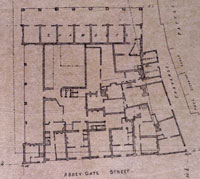
Site of proposed Corn Exchange 1860 |
|
blank |
During 1860 there was a growing demand from business interests in the town for a completely new and larger Corn Exchange to replace the by now cramped building of the existing Exchange. The proposed site was adjacent to the south of the existing building and would replace somewhat decayed shops and an existing Shambles which housed the town's butchers and meat stalls.
In November, 1860, Mr Croft, a Bury St Edmunds surveyor was commissioned to produce a plan of the existing buildings on the the proposed site, together with an outline of the footprint of the proposed new Corn Exchange. The full plan can be seen by clicking on the thumbnail attached.
It shows the Traverse being widened by the removal of two shops, (Messrs Bryant and Shillito) as well as other rooms owned by the council. The existing butchers' Shambles would also have to go, but would be replaced a few yards to the north. Despite the smell and nuisance produced by the butchers, it was accepted that it provided a vital service to town centre customers.
|
|
1861
|
The American Civil War began and lasted until 1865 when slavery was abolished in America.
The census of 1861 produced the following figures.
Bury's population was now 13,318, about four percent less than a decade earlier. Perhaps the railways allowed people to leave more easily, without any great attraction to lure newcomers in.
At Lavenham the census recorded 12 cocofibre matmakers, presumably working in John Churchyard's factories in Water Street and Hall Road. Churchyard also employed 74 horsehair weavers at this time. Both raw materials were used for making mats and matting, but at this point the coconut fibre production seems to have been much less developed than it would later become. John Churchyard also had a horsehair mill at Long Melford, where his son-in-law, William Roper was manager. Both the coconut matting and horsehair products would expand in importance over the years up to the First World War.
Edward Greene's Westgate Brewery had increased considerably since 1851. He now employed 45 men and 5 boys compared to 18 men and 3 boys in 1851. He produced around 20,000 barrels of beer a year, or ten times more than the 2,000 barrels in 1836.
|
|
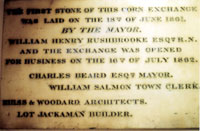
Corn Exchange foundation stone |
|
blank |
By March, 1861, tenders were received for the construction of the new Corn Exchange, a building which still stands today. Prominent local builder, Lot Jackaman won the job, with a tender of £4,424. Ransomes & Sims of Ipswich would provide the ironwork for another £750.
In April, site demolition began, in the face of a new wave of opposition to the scheme led by Councillor Frederick Nunn, one of the butchers, and James Lee, coal and timber merchant. Happily for the corporation, a public meeting of ratepayers held on 4th April voted almost three to one in favour of the scheme.
By June, 1861, the foundation stone was laid, and work pressed ahead. It would be open in 1862.
Work also began on rebuilding the Hospital.
|
|
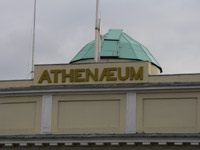
The 1861 Observatory |
|
blank |
In 1859, the Astronomer Royal, Sir George Biddell Airy, had given a lecture in the Athenaeum. This had so inspired the Literary Institute that it decided to allow the building of an Observatory at the Athenaeum. The new observatory was opened on the roof of the Athenaeum in 1861. This still survived in 2004, but was, by then, felt to be too dangerous to allow public access.
During 1861, Nathaniel Hodson was still presiding over his Botanic Garden, and living within the abbey grounds in the house now known as Ailwyn House. On 10th December, he died, an esteemed member of Bury Society. He had been elected Mayor for the year 1855/56, and was well known on the national horticultural scene.
|
|
1862
|
The Highways Act abolished parish powers over roads and established Highway Boards.
By 1846 the Eastern Union Railway had opened a line from Colchester to Ipswich, and this Company built a branch line from Marks Tey to Sudbury in 1849. In 1862 the Great Eastern Railway Company was formed by an amalgamation of most of the existing East Anglian Railway companies. The new company now made plans for the completion of the lines connecting Long Melford, Glemsford and Haverhill with Cambridge and Sudbury.
Still desperate to sell the rapidly declining Lark Navigation, Lady Ann Cullum had it auctioned off in London. The Navigation was sold for £4,500, half its original build cost, to James Lee, a local coal and timber merchant. He planned to bring in coal cheaper than the railway, but first it needed a massive investment in the canal. Lee died on September 8th, 1862, before anything came of his plan.
James Lee left the Navigation to three men whom he must have thought were most likely to make something of it. These were William Biddell of Hawstead, Robert Boby of Bury, and John Jackson of Fornham. The first two men repudiated the bequest, leaving John Jackson to be sole beneficiary.
|
|
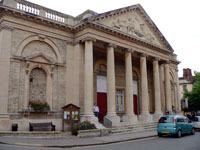
New Corn Exchange
|
|
blank |
The present corn exchange was completed at the top of Abbeygate Street and opened for business on 15th July, 1862. The elaborate south front and portico were still not finished until September, although without any decoration for the moment. The famous carvings within the portico and the motto, "The earth is the Lords and the Fulness thereof" did not arrive until 1865 following a public subscription to raise 200 guineas for the costs. The north side of the building replaced the Shambles, a row of open colonnades, where butchers would hang carcasses for evisceration and preparation. The name Shambles is still used for the short stretch joining the Traverse to Cornhill. Part of the old shambles building was incorporated into the Corn Exchange, as it was a fine Georgian construction.
The new Corn Exchange would be used for corn sales on Wednesdays up to 1997. On other days it would be used for public functions. It cost the sum of £7,000. It was the third purpose built Exchange used in Bury, the first being in the Market Cross. The corn exchange now being replaced, which was the second, was in the building between the Market Cross and the new Corn Exchange. This building was now freed up and it was planned to use it as a covered provision market. This use was resisted by stallholders, and the greengrocers were allowed to remain out-doors. In 1897 the market would return to the street to be replaced in the building by the School of Art and the Fire Station.
Extensive alterations were carried out to the church of St James in Bury, now called the cathedral. In particular the high pitched roof of oak was erected, and the whole works cost £10,000.
The West Suffolk Hospital was much enlarged at its site in Hospital Road, Bury, and nearly rebuilt at a cost of £11,000. It would be used as a hospital until 1974, and demolished in 1979.
|
|
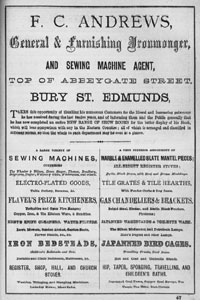
F C Andrews advertisement 1874
|
|
blank |
In about 1862, Frederick Charles Andrews started his own hardware business, although it seems that the premises had already been a hardware business for 50 years. Andrews Stores was favourably located at 88, Guildhall Street, facing down Abbeygate Street. The firm would become well known as Andrews and Plumpton in the 20th century, a partnership which began after 1898, when a nephew called Robert Plumpton joined the business from Peterborough. The first directory to include notice of Andrews Store was not until 1874. This advertisement from a page of White's Directory of Suffolk, 1874, refers to 12 years of existence. It is a typical Victorian advertisement where the vendor thanks his customers for their patronage and lists his wares. There is an enormous range of goods such as kitchen fittings and ranges, baths, bedsteads and hat stands.
In 1862 Lord Manners sold Fornham Park and the Fornham St Genevieve estate for £85,000 to William Gilstrap, who, in 1868, would also buy about one third of the parish of Fornham All Saints. Sir William Gilstrap (1816-1896), was a native of Newark upon Trent, in Nottinghamshire, and was a well known benefactor of that town. He had made his fortune in the malting industry, and he wanted the Park in Fornham St Genevieve for its sporting value.
Although he and his wife moved to Suffolk in 1862, William retained a strong interest in the Newark area, and in the 1880s he gave the town its library together with generous endowments from himself and other members of his family. The Gilstrap library was opened by Mrs Gilstrap in 1882 and still stands in the main street of the town of Newark.
William was created a baronet in the title of Gilstrap of Fornham, Suffolk, in Queen Victoria's golden jubilee honours list in 1887.
Later he would become High Sheriff of Suffolk, and he would hold shooting parties and house parties at Fornham Park Hall and his lodge at Herringswell, until his death in 1896. The park and its Hall would remain in the Gilstrap family until 1950, firstly passing via a daughter to George Manners, who became Sir George Manners in 1920. In 1939 it would pass to Captain Duncan Macrae of Dunoon.
During 1862 the clothing factory in farm buildings at Chevington was replaced by a new factory on land near the village shop behind the Greyhound Inn on Hargrave Road. It was owned by Robert and Henry Parnall and Company of Bishopsgate in London, and managed by William Beales, who was now living at Cheveley. The 1861 census included these details and also that it had a labour force "in and out of the factory, of six hundred persons in this and adjoining parishes."
There were 30 sewing machines, but these were operated by foot treadles as the factory had no power source. Coats, jackets, trousers and dresses were all apparently produced here.
Frank Cooper has estimated that up to 500 of the 600 workers were probably out-workers who collected materials and orders from the factory, took them home to sew up, and returned the finished articles or part articles to the factory when completed. At some point by the 20th century the factory had a collection centre at Denston, where home workers from Wickhambrook, Stansfield and Stradishall could collect orders and deliver their products.
Parnall's London premises were a short distance from Liverpool Street station, which was the London end of the railway line from Bury, Risby and Saxham. Although Saxham was nearer to the Chevington factory, Bury may have become the preferred outlet when it received the benefit of the Electric Telegraph.
|
|
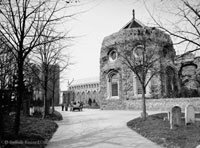
New Probate Office
|
|
1863
|
In the Spring of 1863 Samsons Tower was converted into the Probate Registry together with a residence for the Registrar. The distinctive window and door arches of the Tower were installed at this time. This late 19th century photograph shows the new arched windows and tiled roof. Previously it had been used as stables for the Assembly House, a private residence and later the stables for the Six Bells Inn. Part of the west front had also been a dye works. Until it became the Probate Registry it had a thatched roof.
In 1863 a sewage works was opened at what is now called Bell Meadow in Bury. It was the first attempt in the town to deal with the collective disposal of foul water. It soon led to complaints.
|
|
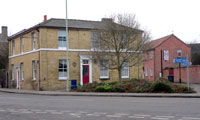
The New Inn
|
|
blank |
The New Inn in Northgate Street was "new" when it was built in 1863. The New Inn stood at the junction of Northgate Street with Cannon Street. Its application for a license was opposed by the four other pubs in the vicinity, which were the Three Horshoes, at the end of Looms Lane on Northgate Street, the Swan, now 96 Northgate Street, the Dolphin, now 50 Cannon Street, and the Seven Stars in Long Brackland. However, it was welcomed by the magistrates as it was built on a derelict site, considered to be an eyesore at the time.
The Colne Valley and Halstead railway arrived in Haverhill. Their station would become known as Haverhill South when competition arrived, but at first it was just called the railway station.
|
|
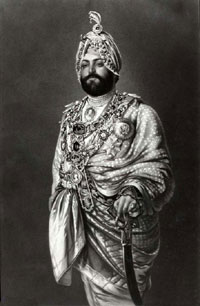
Duleep Singh
|
|
blank |
His Highness the Maharajah Prince Duleep Singh purchased the estate of Elveden, together with Elveden Hall, as his British home. Duleep Singh was born in India in 1838, one of four sons of the Maharajah Ranjit Singh of the Punjab, ruler of the Sikh nation. At the age of six he was confirmed as his father's successor, but the Anglo-Sikh War broke out, and in 1849 the Punjab was annexed by the British East India Company. Much of the family's vast wealth was seized by the British, including the diamond known as the Koh-i-Noor, which is currently one of the Crown Jewels, being part of the royal crown worn by the late Queen Mother.
The deposed ten year old boy now stood as a problem for the company, who feared he would become the focus of Sikh unrest under British rule. He was converted to Christianity, and in 1854 arrangements were made to send him to England, out of harms way. Here he was given funds by the government, the title of Prince, and became friends with Queen Victoria and was welcomed by the British aristocracy and held in high esteem. After he bought the prime shooting estate of Elveden in 1863, for £105,000, he gave grand hunting parties, and became well established on the social scene. In his later years he moved to France, and died there in 1893, but his son Prince Frederick brought his body back to Elveden where he was buried in the churchyard.
By 1863 the Bury Fair was no longer the resort of gentlefolk, as shown by this item in the Ipswich Journal of October 24th 1863:
"At Bury Fair, which has sunk to the very lowest depth of squalor and wretchedness, the police prohibited the exhibition of “the living skeleton,” a young man 24 years of age weighing only three stones."
Bury Fair would be abolished in 1871.
|
|
 Settling House in 2006
Settling House in 2006
|
|
1864
|
At Bury Cattle Market the attractive octagonal settling house was erected to make the process of toll collecting considerably easier. The toll collector also sold ginger beer and buns from this booth on market days. It continued to stand here during the years when the Cattle Market was used as a car park, but had to be removed in 2007 to make way for the Arc redevelopment. The settling house can therefore no longer be seen on its original site, but has been fully restored and is now located at the Museum of East Anglian Life at Stowmarket.
|
|
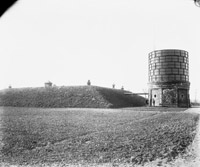
The Waterworks by 1890 |
|
blank |
At the Corporation's Yard behind the new Cattle Market, off today's Kings Road and Prospect Row, the council built tanks in order to develop the well there from a source of water for street cleansing, into a piped drinking water supply. At first a windmill was used to raise water from the underground aquifer.
The Woolpack Inn on the corner of Woolhall Street and Cornhill, was taken over by one Michael Everard. Eventually it became known as Everards Hotel, a name which lasted until 1987, when the hotel became a Pizza House. Michael Everard's parents had already owned the Suffolk Hotel since the 1840's. Michael continued the old Woolpack brewery, and had a brewery tap looking out into Kings Road.
Meanwhile the Bell Hotel on the Cornhill was advertising itself as the Inland Revenue Office, and General Posting establishment as well as a family and commercial hotel, home of Henry Scott's wine and spirits, and Hearse and Mourning Coaches available. Later in the century the Bell Hotel would be replaced by the new Post Office.
|
|
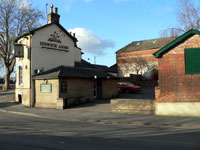
Ipswich Arms and yard 2006
|
|
blank |
The Segment, a beerhouse on Station Hill and Tayfen Road was renamed the Ipswich Arms, to match the latest new street in Bury, Ipswich Street. This short road had just been built to link St Johns Street more conveniently to the Station Hill and, of course, the railway station. It got the name Ipswich to reflect the fact that travellers using it could go on to Ipswich from the station. The Ipswich Arms had a large yard which could hold stock being shipped in or out by rail. These extensive premises still hold a public house, and also a snooker hall, micro brewery and night club. By 2012 the Ipswich Arms had enjoyed a couple of name changes, culminating in "The Beerhouse".
With the opening of Ipswich Street came another new street, called Peckham's Walk, now known as Peckham Street. It ran from St Andrews Street, North, to Ipswich Street, behind the Gas Works. At some point a Rope Walk had been established behind the Gas Works and the houses were built for Mr Peckham, (number 17), and his workers. Mr Peckham was the Rope manufacturer's name. A rope walk was a long narrow open sided shed, used for plaiting long lengths of rope. This walk was still shown on maps into the next century. The rope walk was behind the houses in Peckham's Walk, running across what would become their gardens.
|
|
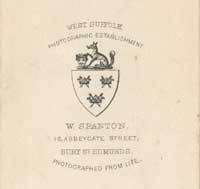
Spanton's Photographic shop
|
|
blank |
In 1863 or 1864 William Spanton established his "Repository of Arts and West Suffolk Photographic Establishment" at 16 Abbeygate Street in Bury St Edmunds. At first he ran a variety of enterprises from these premises, combining the photographic side with work as a house decorator, paper-hanger, plumber, glazier, carver, gilder and painter. He also designed the four-storeyed house in Abbeygate Street in which he had his business. William Spanton found that he had great success in his photographic studio and he was soon to give up his other concerns. He then combined photography with framing and gilding. His son, William Silas Spanton took over when his father died in 1870.
In 1901 the stock of negatives and the premises were taken over by Jarman's. Many of Bury's photographs from this era are attributable to the work done by William Spanton senior and junior, and Harry and Oswald G Jarman from these premises. Today it is a shop again, following several years as the Trustee Savings Bank.
The owner of Ousden Hall and manor, Thomas Ireland, had died in 1863, and in 1864 the whole property was put on the market, together with its 2,350 acres in Ousden and adjoining parishes. The property was bought by Bulkley John Mackworth-Praed, a member of the Praed banking family. (Praed's Bank later became incorporated into Lloyds Bank.) The family seem never to have lived at Ousden, and the property was let, primarily for its attractions as a shooting estate.
When Bulkley died in 1876, his son, Sir Herbert Mackworth-Praed, continued to let the estate. Sir Herbert was MP for Ipswich, as well as a banker. Eventually the property would be bought to live in by Algernon Mackworth Praed, in 1913.
|
|
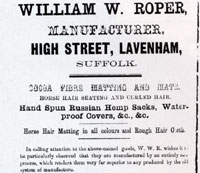
Roper's advertisement 1864
|
|
blank |
By 1864 the factories of John Churchyard at Melford and Lavenham had been taken over by his son-in-law, William W Roper. Roper's name became synonymous with horsehair and coconut matting manufacture in Lavenham, expanding into Thomas Turner's old woolstapling premises in the High Street. This factory is today redeveloped for housing and is called Roper's Court. Roper's advertisement in the Harrod's Directory for 1864 claims that he is, "Sole manufacturer, by special appointment, of Coloured Horse Hair Matting for the Houses of Parliament." His factory also made hemp sacks, waterproof covers, waggon covers and processed horsehair into a curled hair product suitable for stuffing mattresses and bedding, guaranteed clean and free of moth.
Rather more dangerous industry was carried out at Stowmarket. In 1864 Thomas Prentice and Company built their Great Eastern Chemical Works at Stowmarket in order to make Gun Cotton under licence from the Austrian Baron Von Lenk, although in England he used the name of Revy. Production began in Spring, 1864, the guncotton being marketed in rope-like lengths spun from fibres of nitro-cellulose.
The Ipswich Journal for May 28th 1864 reported that… “The terrible explosion of Gun Cotton at Stowmarket occurred on Tuesday.” The Gun Cotton Factory actually lay in Stowupland, near to the parish of Combs, as the boundaries were then.
This was very early in production, when safe working methods were still being established. Four girls were working together in a building when an explosion filled the building with flame. They all ran out with their clothes alight. Men working nearby came to their aid, plunging them into the river to extinguish the flames. Fifteen year-old Fanny Burrows was dead at the scene. Betsy Barnard died shortly after. Sarah Welham and Amy Cunnold were badly burnt. Though also burned, foreman Michael Miles Cobb was able to give evidence at the inquest held at the Fox Hotel. The Coroner recommended that this accident needed further investigation, to ensure nothing like it ever happened again. However, such incidents were avoided until 1871.
From 1864 to 1895 the Turnpike Trusts were gradually wound up.
|
|
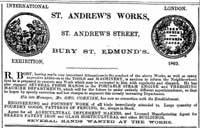
Robert Boby announces George Cornish leaving him. |
| 1865 |
On 3rd January 1865, Robert Boby placed an advertisement in the Bury and Norwich Post to announce that he was reorganising the management of various parts of his factory. The immediate cause of this seems to be that George Cornish, who had hitherto been his factory manager, had now left his employment in order to take over his father's foundry business of Cornish and Sons, to trade as George Cornish.
John Cornish had started his business as an iron and brass founder in about 1840 in Westgate Street. His son George learnt the trade with his father, but it is likely that he left the small family firm around 1855 or 1856 to join Robert Boby in setting up his new factory. With this experience behind him Cornish would soon develop the family firm to new heights.
|
|
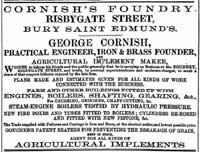
George Cornish relocates foundry to Risbygate Street |
|
blank |
In April 1865, George Cornish announced that the Iron and Brass Foundry Business previously trading as Cornish and Sons, in Whiting Street, would from now on be known as George Cornish, Practical Engineer, Iron and Brass Founder, and Agricultural Implement maker.
By September of that year, George Cornish was advertising his foundry was now relocated to Risbygate Street in Bury St Edmunds. This foundry would last on that site until the 1960s. The Whiting Street foundry was apparently given up at this time.
Robert Boby's brother, George Boby moved into St Andrews Castle in 1865, where he would reside until his death in 1890. He had previously been a grocer and draper at Stowmarket, but would now become a businessman in Bury, and become associated with some of Robert's enterprises.
|
|
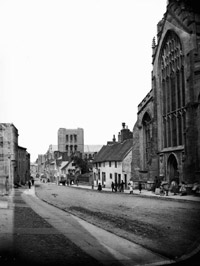
Cottages demolished 1865 |
|
blank |
At the time of this photograph in 1864 money was being raised to fund the demolition of the cottages adjoining St Mary's Church. These were finally pulled down in early 1865. As this photograph survives in the Spanton/Jarman archive, it was probably taken by William Spanton, and must have been one of his first pictures after setting up his shop in Abbeygate Street.
In Bury St Edmunds work began on providing St James' Church with a new Chancel. It was completed by 1869.
|
|
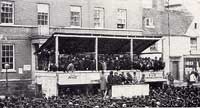
The 1865 Election |
|
blank |
Elections were held in 1865. They were carried out by the system of the recorded vote. Although this method was open and transparent, it contained obvious opportunities for malpractice. There would be only one further open voting election before the secret ballot was introduced in 1872.
It is not wholly clear if this picture of the election is from 1865 or 1868, but Mr H I Jarman, who later owned Spanton's negative, was told that the camera was lashed to a lamp post and given a three second exposure.
Bury St Edmunds had two parliamentary seats, held by Lord Alfred Hervey, Conservative, and J A Hardcastle, a Liberal, and a brewer from Essex, who lived at Nether Hall Estate at Pakenham.
Lord Alfred had managed to upset the local Conservatives because he had voted to abolish church rates, and often sided with the Whig party of Lord Palmerston. The local Tory party therefore put up Edward Greene, the Bury brewer, as their candidate. Despite the Herveys having had nearly 200 years representing the Borough, this time Lord Alfred lost. Hardcastle got 331 votes, Greene got 300, and Hervey got only 266.
|
|
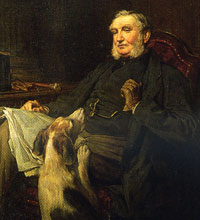
Edward Greene MP
|
|
blank |
Edward Greene was the third son of the founder of Greene's brewery in Westgate Street, Benjamin Greene. His eldest brother, Benjamin Buck Greene had made a great success of the family plantations in St Kitts, and gone on to be a wealthy London merchant, and a Governor of the Bank of England. His second brother John had done well as a Bury Attorney, JP, and twice Mayor of that town. Edward, perhaps the least academically promising third son, went into the brewery from age 13, and bought out his father, gaining full control of it in 1836. In 1836 the brewery was probably seen as the least promising enterprise in the Greene family, but by 1865 Edward had built it up to a thriving and prosperous business. It became even more important to the family as the value of their sugar interests in St Kitts had declined. He devoted himself to life in Suffolk and was by now extremely popular throughout the county. Hitherto he had professed no interest in politics. He had not joined the Council or even become a Guildhall Feoffee, although he had been asked often enough. The job of standing against Lord Alfred had been offered to his brother John, but in view of John's poor health, Edward was persuaded to have his say.
|
|
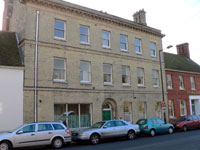
Westgate House, home of Edward Greene |
|
blank |
In 1862 Edward Greene had taken his son Walter Greene into partnership. Unlike Edward, who was educated at Bury School, Walter had been sent to Rugby under Dr Arnold. In 1864 Walter got married, and moved into the Greene home at 6 Westgate Street. Edward now bought Westgate House. One of the factors to persuade Edward to now put up for Parliament may have been his hope that Walter could take on some additional management duties at the Brewery.
One of Edward's platforms was a crusade to improve the housing conditions of the working classes. He even advocated a law to make it a requirement that any new housing should include at least three bedrooms. His straightforward homely approach contrasted with the lofty aloofness of Lord Alfred Hervey, and the Tory voters were split between Greene's Progressive Conservative ticket and Hervey's traditional aristocratic approach. Edward Greene would be returned to Parliament representing Bury St Edmunds until he chose not to stand again in the 1885 election.
Edward Greene took on the lease of Ixworth Abbey in 1865, together with 400 acres of farming land. He already leased Stonebridge Farm in Bury, which he ran as an adjunct to the brewery. He now embarked on a programme of improving agricultural practices, with others, in what has been called the High Farming Movement.
In 1865, the cattle plague (Foot & Mouth) hit Eastern England. Familiar measures were put in place. The Bury Post reported that fairs, markets and sales were prohibited, and no stock was to enter or leave the afflicted areas.
Over the course of the year and into 1866 ten thousand cattle died or were destroyed in East Anglia. The rejoicing felt as the disease finally ran its course was displayed in the form of ‘Days of Humiliation,’ with Church Services of Thanksgiving held at Diss, Melford, Yarmouth & Sudbury. (Bury Post: March 1866)
|
|
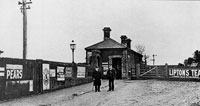
The Eastgate Station |
|
blank |
The Great Eastern Railway company added a rail link from Bury to Sudbury, via Welnetham, Cockfield, Lavenham and Long Melford which would link to its Colchester line. Although it ran into the existing Northgate Station at Bury, they added a station of their own in Eastgate Street, which was used until 1909.
|
|
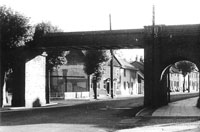
Eastgate Street railway bridge |
|
blank |
To take the railway into Bury St Edmunds' Northgate Station it was necessary to cross Eastgate Street. This bridge was built for that purpose. The Sudbury line was eventually closed in 1965.
In the 1970s the A45 (later A14) trunk road would be built along the last part of the abandoned railway from Sudbury into Bury, and the Pot Black Snooker Club marks the location of the defunct Eastgate station. The Eastgate Street railway bridge was then replaced by the A45 bypass flyover.
|
|
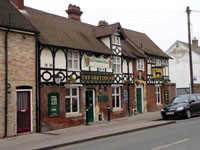
The Greyhound |
|
blank |
Passengers arriving at Eastgate Station could find accommodation at the Greyhound inn, sixty yards away in Eastgate Street. This inn had opened in the 1840's, taking its name from the well known and prestigious Greyhound in the Butter Market, which was renamed the Suffolk Hotel in 1833. The Greyhound remains today as a pub in Eastgate Street.
To advertise the new services the company published their "Official Illustrated Guide to the Great Eastern Railway." It commented that in Bury "there is not any branch of manufacture carried on.... Bury St Edmunds is not a commercial town."
|
|
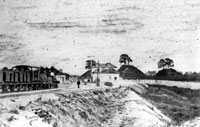
The three Bartlow Hills
|
|
blank |
The Great Eastern Railways also arrived in Haverhill from Cambridge, and set up their Haverhill North Station. The first station out of Haverhill, heading for Cambridge was Bartlow, where the well known Bartlow Hills stood on the route of the railway line. Excavations for the line caused further damage to these burial mounds, which dated back to the 1st and 2nd centuries AD. This picture shows a train entering Bartlow Station, with the mounds visible in the background. Within another year a new railway line was built from Bartlow to Saffron Walden, possibly with further damage to the mounds. Originally there had been seven Bartlow Hills, but only three survive to the present day.
|
|
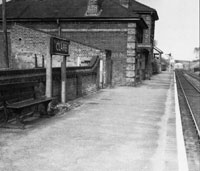
Clare Castle Station |
|
blank |
Within a couple of months Haverhill was also linked up to Sudbury via Sturmer, Stoke by Clare, Clare, Cavendish, Glemsford and Long Melford. At the same time as the Sudbury link went in, the Sturmer Arches were completed to link the Colne Valley railway to the Great Eastern Line.
Unfortunately, as at Bartlow Hills, some of this railway building resulted in the destruction of other important historical remains. The Royal Archaeological Institute proceedings for July 21st, 1869, recorded their visit to Clare in these terms, "the large party reached
Clare Castle in good time, and were landed in the outer bailey of the
once famous stronghold, the remains of which have been most ruthlessly
cut about in all directions for the requirements of the railway. It is
very greatly to be regretted that a slight detour had not been made at
this spot, for the worst of the matter is, that railway stations grow, and
any addition to the accommodation now furnished at Clare Castle station
(a very probable contingency) would entail further destruction of a fine
ruin associated with the memories of one of the greatest families in
English history. It is true that we are indebted to the railway works for
the very beautiful cross and chain which Her Majesty now possesses, and
which, by her gracious permission, was exhibited in the Museum ; but
even such a result is paying dear for one's whistle."
The cross mentioned was discovered during the railway excavations.
Railway building was still being planned despite the wide network now in place. The years between 1863 and 1866 became known as the time of Railway Mania. In 1865, Robert Boby, the Bury Engineer, and Edward Greene the brewer, set up the Bury and Thetford Railway Company to link Bury to Thetford and hence to Kings Lynn. Other directors were Peter Huddlestone, who was Greene's banking partner, and Hunter Rodwell, a barrister of Ampton Hall.
Before the coming of a rail link from Bury to Ipswich in 1846, the River Ouse and Lark Navigations had made Kings Lynn the main port for Bury trade. The rail link had at first reduced costs, but put the GER in a monopoly position over Bury's commerce. Edward and John Greene believed that Bury's development needed an alternative outlet, and thus obtained an Act of Parliament to allow it to be built. They also wanted Bury to become the trading centre for Thetford and its surrounds. Others were less enthusiastic and it would take 9 years to raise the £100,000 needed to build it. It would not open until 1876, by which time it was all too late, and the Company soon sold out to the GER.
The One Bull inn, just off the Angel Hill, had been a notoriously rowdy house for well over a decade. It included two dancing rooms, and attracted the militia, as well as "thieves and prostitutes". In 1865 the inn was taken over by a Mr William Welham from Newmarket, who closed the dance rooms, and opened a grocery business in their place. He promoted his own home brewed beer and turned the inn into a respectable and flourishing inn, one of only 24 in Bury to survive into the 21st century .
|
|
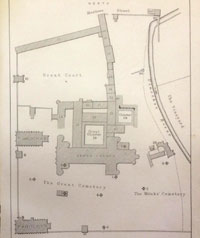
Hills' Plan of the Abbey |
|
blank |
A B Whittingham reported in 1951 that, during 1865, Gordon M Hills published a full account of the Abbey of St Edmund in the Journal of the British Archaeological Association, JBAA volume xxi (1865). The account, called 'The Antiquities of Bury St Edmunds', included plans and Whittingham called it "the most authoritative account of the site, though
in parts superseded, gives fuller information on some points than later writers". Hills referred to the River Lark as Ulnothes River on his plan of the monastery.
|
|
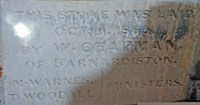
Primitive Methodist Chapel extension
|
|
blank |
In 1865 the congregation of Primitive Methodists had continued to expand. The Chapel at 23A Garland Street had been built with a capacity of 120 places, and this was too small by this time.
An extension was built to number 23A in 1865 which brought the seating capacity up to 160 worshippers. The event was commemorated by the plaque shown here, which was photographed by Martyn Taylor. It is slightly unclear, but the inscription reads, "This stone was laid Oct 9 1865 by W Chapman of Barnardiston. M Warnes, T Woodall Ministers."
This chapel would be in use until 1902, when the Primitive Methodists would move to 4 Northgate Street, a former Congregational Chapel.
|
|
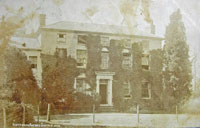
Livermere Rectory by 1909
|
|
blank |
In 1865 the Reverend Herbert James became the Rector of Great and Little Livermere, bringing with him a wife and family from Goodnestone next Wingham, in Kent. He obtained the living from a female relative who had inherited Livermere Hall. Their youngest of three sons was Montague Rhodes James, known as Monty to his friends. He would become well known in later life as M R James, writer of ghost stories, but he was also an antiquarian who would contribute significantly to the history of the abbey at Bury St Edmunds. Livermere Rectory would be the James family home until 1909, when the Reverend Herbert James died on 12th June, 1909, after 44 years as the Rector there. Livermere lake and its surrounds was believed to be the setting for some of M R James's ghost stories.
Recognising the advantages of the new railway system for fast distribution to all parts of the country, Gurteens built a second factory of three storeys in Haverhill, next to its drabbet mill. This housed sewing machines powered by steam driven beam engines.
Meanwhile, Vanners built a silk factory in Colne Valley Road in Haverhill, which in recent times became the Addis Brush factory.
|
|

St John's Church c 1866
|
|
1866
|
The Bury St Edmunds Building Society was founded in 1866. In those days, a Building Society meant what it said. A group of people set up a mutual society to help each other build their own homes. This society bought an orchard off St Johns Street to be sold in 57 plots to its members. Each plot had to have a house built on it of a value not less than £110. Orchard Street remains a fine residential road today. This picture by William Spanton was sold by him in a small format known today as CDV or Carte de Visite, measuring 110x65mm. Such items could be left as visiting cards if there was nobody at home, but were also collected as novelties at a time when photography was new and exciting. Note the absence of Orchard Street houses as well as the houses and shops called St John's Angle dated to 1880, and the Lathbury Institute of 1896.
Not far away in Peckham Street a "ragged school" was built to serve the fairly poor inhabitants of that area. The idea of ragged schools was developed by John Pounds, a Portsmouth shoemaker. In 1818 Pounds began teaching poor children without charging fees. The first formal ragged schools were in Scotland, inspired by Pounds' ideas. In 1844, the movement spread to England, with the establishment of the London Ragged School Union under the chairmanship of Anthony Ashley Cooper, 7th Earl of Shaftesbury. The Ragged Schools were charitable schools dedicated to the free education of destitute children. After 192 such schools were built, they were replaced by Board Schools following the Elementary Education Act of 1870.
|
|
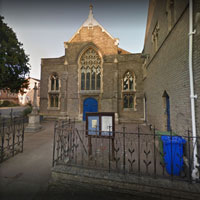
Whiting Street Church
|
|
blank |
The Congregational Church in Whiting Street was re-fronted, and internally improved. Today it is called the United Reformed Church.
In October, Edward Greene, the brewer, gave a celebratory dinner in the Theatre Royal for 350 of his workmen and those of Robert Boby and George Cornish, the Bury Engineers. It celebrated another expansion of his Westgate Brewery. He had added a second steam engine to the brewery, a ten horsepower machine built by George Cornish. Cornish did Greene's engineering work from 1850 to 1880, while Boby's supplied malt screens and made other malting equipment and agricultural devices. All the work had been undertaken by firms in Bury, a source of pride for Greene, who had been elected as one of the town's two MP's a year earlier.
George Cornish's Foundry was in Risbygate Street, where the B & Q store is now located. Boby's Works was in St Andrews Street South, now also replaced by shops like Waitrose, and other development.
This celebratory event marked a great revival in Bury as a manufacturing town, and a new prosperity for the workers of the town. Both pub and home brewing were being rapidly replaced by brewing on an industrial scale, and with the new foundries, gave alternative job opportunities to the agricultural worker looking for a new start. Greene himself had always reckoned to pay two shillings a week above the agricultural wage to get labour, but had also believed in the importance of good housing for working people. Since 1836 he had held annual suppers for his workers, and liked to have men about him that he knew, trusted implicitly, and who he would help out in their old age. In return the brewery had a loyal and devoted workforce, with families working in Greene's brewery for generations.
In 1866 the Suffolk Agricultural Association held an exhibition at Bury St Edmunds in a field overlooking the Botanic Gardens. This site would again be used in 1867 by the Royal Horticultural Association show.
A trans-Atlantic telegraph cable was successfully installed by the magnificent iron ship, the Great Eastern, launched in 1858. No other ship could have carried the 6000 tons of cable. The line was quickly profitable, and the two greatest economies in the world at the time, Britain and the United States, had a free flow of information uniting them.
The present Haverhill cemetery was laid out in 1866, and opened in 1867. Like many churchyards, St Mary's was full up.
|
|
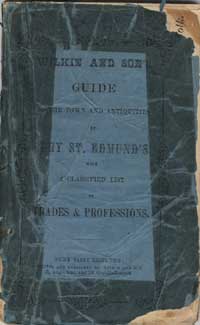
Wilkin's Guide and Directory
|
|
1867
|
During 1867 the Bury firm of Wilkin and Son, of 2 Angel Lane and 16 Guildhall Street, published their "Guide to the town and Antiquities of Bury St Edmunds, with a classified list of Trades and Professions." It included a short history of the town and Abbey, followed by a review of the main public buildings. It noted that St Mary's church organ, built by Gray's of London at a cost of £1,000 had just been removed for a rebuild. The tower had a "capital peal of eight bells". The "high, square unsightly pews" are to be replaced by graceful benches, wrote Wilkin, who also advocated removal of two "large ugly galleries". The living of St Mary's was reported to be a perpetual curacy, in the patronage of John Fitzgerald, esq, endowed with £240 a year. A vicarage house had just been purchased by public subscription for the incumbent, Reverend John Richardson, MA.
At St James's church, nearby, Lot Jackaman the Bury builder, was continuing a long renovation process, started in 1864. Wilkin noted with approval that the galleries there were wiped out in 1863-64, and the "high stiff-looking pews have been superceded by oak benches", giving about 2,000 sittings, of which 400 are free. "Mr F Fearnside, a skilful musician, is the organist, and has succeeded in forming a most excellent choir". The living is a perpetual curacy and the incumbent is Rev Frank Chapman.
Similarly, St Marys Church at Haverhill was being enthusiastically "restored", so that only its tower remains as clearly medieval today.
|
|
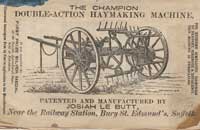
Le Butt's advert in Wilkin's 1867 |
|
blank |
A couple of years after George Cornish had left Boby's, another important manager left him.
The London Gazette of June 21st, 1867 announced that Josiah Le Butt of the Haymaker Works in Bury St Edmunds was awarded a patent for, "improvements to hay making machines." This patent was the basis upon which Le Butt would build a new business.
Robert Boby placed an advertisement in Wilkin's Directory, as did his new competitor, Josiah Le Butt, who advertised a haymaker to rival Boby's own. Boby, however, could afford to take two pages to Le Butt's single page. Josiah Le Butt had been working with Robert Boby, firstly as a representative, and then in the factory, for some 13 years, but had now set up on his own, near the Railway Station. At first he concentrated upon his Champion Haymaker, which, he said, was a great improvement upon the Boby version, to which Le Butt had added his own patented improvements.
You can look through the whole of this guide, with its many advertisements, and its list of the councillors, leading citizens and tradesmen of the town of Bury St Edmunds by clicking on this link:
Wilkin's Town Guide of Bury St Edmunds, 1867
The second electoral Reform Act expanded the right to vote from 4 1/2 % of Suffolk's population to 7 1/2 %, but only men could vote. In 1862 the Bury St Edmunds Borough's electoral roll held only 694 voters. By about 1885 it would reach 2,000.
|
|
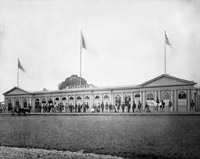
The Royal Show |
|
blank |
From July 10th to the 19th, the Royal Agricultural Society Show was held in Bury in Eastgate Street, not far from the Eastgate Railway Station. Such events could take place here because of the new rail networks. The event was on the north side of the road, on part of Grange Farm, occupied by Mr T Taylor.
The first few days of the show were restricted to testing and judging the various implements and engines on show. From the 15th visitors could visit freely among the exhibits.
At the same time, the Royal Horticultural Society began a run of provincial flower shows, the first of which was held at Bury St Edmunds on a site within five minutes walk of the Agricultural Show. This was in a field between the Botanic Gardens and the Vinefields, on the east side of the river. A special road was constructed to join up the two sites.
Men like Edward Greene had lobbied for the Royal Show to come to Bury. Greene was now a farmer as well as a brewer, and he applied his business methods to farming. In the 1860's he began to experiment with the use of steam power in agriculture on his Ixworth Abbey farm. Steam thrashing sets were starting to appear on farms in the 1860's, but steam ploughing was still experimental. Specially adapted steam traction engines were needed, each with a large winch slung under the boiler. A pair of such engines were needed, one at each end of the field. A plough with a driver would be winched from end to end across the field being ploughed. A report of Greene's trials of steam ploughing appeared in the Bury and Norwich Post of 22nd October, 1867. The capital cost was high, the machines heavy and cumbersome, and breakdowns frequent, and the method was not widely adopted.
|
|
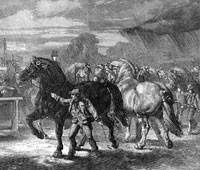 Suffolk Punches at Royal Show
Suffolk Punches at Royal Show
|
|
blank |
The Suffolk Punch horse continued to be the main motive power on the farms of Suffolk. With their unfeathered fetlocks they did not pick up the heavy clay soils of High Suffolk as the Shire horses would. Shires were more suitable for use on the roads than on the fields. The artist here was Samuel Carter, and he has captured the excitement of the show and the power and energy of the highly polished horses.
This picture comes from the Illustrated London News of 27th July 1867, a national publication of the time. The Illustrated London News began life in May, 1842, and remained mostly unchallenged until 1870, when the Graphic was first published. The ILN was the brainchild of Herbert Ingram, who employed leading artists of the day to illustrate social events, news stories, and views of towns and cities. The whole spectrum of Victorian England was to be recorded pictorially in the ILN for many decades to come.
The ILN and later similar publications were taking advantage of the advances in printing to build stories around pictures as much as to report news.
In 2009 this print was on sale on E-Bay for USD $19.95, or GBP £12.14, from a seller in the Bahamas.
You can read newspaper reports of the Royal Show, together with a plan, and Wilkin's description of it, within the section on Picture Stories here:
The Royal Show, Bury St Edmunds, 1867
|
|
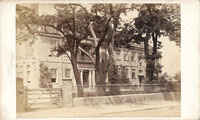 King Edward Grammar School c1867
King Edward Grammar School c1867
|
|
blank |
One of Spanton's competitors in the early production of CDVs was the firm of Clarke and Wallace, late Ladbrooke, Clarke and Wallace. The firm of Clarke and Wallace at 28 Angel Hill only seemed to have lasted for about a year in 1867. By December 1867, JW Clarke was working alone. This helps us to date this picture of the Grammar School in Northgate Street, Bury St Edmunds, to the year 1867 or shortly after. Clicking on the thumbnail will reveal the reverse of this CDV.
The artist Rose Mead was born in Bury St Edmunds. When Rose was born the family lived at 15 Hatter Street until about 1885 when they would move to 16 Crown Street. Rose Mead would grow up to be a well loved and appreciated local artist.
Henry Crabb Robinson, of Linnet House, in Southgate Street, died in 1867. He was born in Bury in 1775, and following receipt of a legacy in 1800, he travelled widely. In 1808 and 1809 he effectively became the first war reporter, reporting on Napoleon's campaign in the Spanish Peninsular. He returned to England and became a barrister, retiring home to Bury St Edmunds in 1828. In 1829 he owned property in Sparhawk Street, but Linnet House became his home, where he entertained literary figures like Coleridge and William Wordsworth. He was also a founder member of London's Athenaeum Club.
In December 1867, Lord Arthur Hervey wrote to all the members of the Suffolk Institute of Archaeology and Natural History, to inform them that the Institute was now separated from its union with the Bury St Edmunds Athenaeum, which had taken place in 1853.
|
|
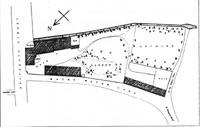
Braddock's Southgate Brewery
|
|
1868
|
In March 1868 Henry Braddock, one of the old brewers of Bury, died. He had owned the Southgate Brewery in Southgate Street, along with his White Hart Maltings and eleven inns. One of these inns, the White Hart, was situated just across the road from the brewery, as was the White Hart maltings. Braddock was an old man who had no sons, although he had been prominent in Bury affairs for years. His politics were of the old-fashioned Whig variety, and his brewery was similarly old-fashioned. These premises were now put up for sale by Braddock's executors. Fred King, who had married into the Maulkin Malting dynasty, and now ran the Maulkin business in St Mary's Square, announced in the Bury and Norwich Post newspaper, on June 16th, that he intended to take up the Brewing business. He wrote that he had entered into partnership for the venture with Francis Phillips, late of the Stowmarket Brewery, and that he was looking for premises.
|
|
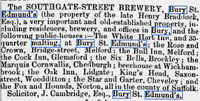
Braddock's for sale
|
|
blank |
Edward Greene, knowing King's energy and drive, felt he needed to act to protect his own brewing business. Braddock's old brewery was still on the market. In August, 1868, in order to prevent King from acquiring Braddock's Brewery, Greene bought Braddock's house, brewery, inns and other holdings for £7,000. The Southgate Brewery was old and unmodernised, and Greene now closed it down. Greene kept the maltings and used it right up to the 1930's. He also sold off seven of the pubs to recoup some of his outlay. None of this, however, deterred King from his ambitions.
|
|
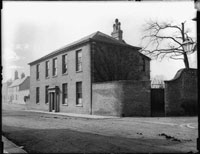
Braddock's/Pead's House
|
|
blank |
William Greene ensured that Braddock's Brewery stayed closed by the simple expedient of selling the brewery and house to his own Brewery Manager, William Pead. Pead had joined Greene's brewery from school in the 1840s, and after 20 years had been appointed Brewers Manager, and was receiving a share of the profits of the maltings. William Pead would reside here from 1869 until his death in 1903, having become Company Secretary and a shareholder in the business. When Braddock was living here, the house was apparently known as 81 Southgate Street. Pead adopted the name of Southbridge House for it, and at some point it became numbered 82 Southgate Street, according to later Directories. The house itself fronted on to Southgate Street, while the brewery stood behind the house, in the area between the River Linnet and Maynewater Lane. Maynewater Lane at this time was very narrow at the Southgate Street end, and it is visible curving away on the right of this picture.
|
|
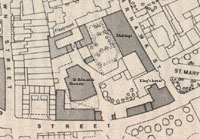
St Edmunds Brewery by 1890
|
|
blank |
In July, 1868, Fred King bought the Maulkin's Maltings and other property in St Mary's Square from his father in law, Robert Maulkin, for £5,300 using a mortgage from the Maulkin Family Trust. The maltings were very old and unmodernised, so a site was cleared on the corner of Westgate Street for an up to date "tower" brewery.
Fred King was aged 40 in 1868, when he built the brand new St Edmunds Brewery in Sparhawk Street, towering over Greene's Brewery only a few yards away in Westgate Street, Bury St Edmunds. It started producing beer at Easter, 1869, and they were acknowledged to be very good beers. King's stout was especially good.
The Maulkins also owned 6 pubs in town, like the Ram in Eastgate Street, giving a ready made outlet for King's beer. King was a shrewd man with 11 children to support, and began to buy up more pubs after 1870. He became stiff competition for Greene's business.
In July 1868, news arrived of a major fire in Stowmarket. Eighteen houses were destroyed in Bury Road, and 81 people were made homeless.
|
|
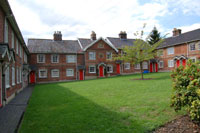
Maynewater Square |
|
blank |
Edward Greene, the well known Bury brewer, continued to improve the lot of his employees. In 1868 he built the Maynewater Square, a cluster of 16 dwellings around a tidy court facing Maynewater Lane in Bury. This square can still be seen today.
The National Provincial Bank was built in Italianate style in Abbeygate Street, Bury. Today it is the Alliance and Leicester.
By 1868, Spanton's photography business had a rival. John W Clarke and his son, John P Clarke, had their business on the Angel Hill in Bury, on the site of the Borough Offices. They concentrated on local views, and in 1890 took on Harry Jarman as an apprentice.
At the elections of 1868, Edward Greene now topped the poll in Bury, and his position as a local MP was consolidated.
|
|
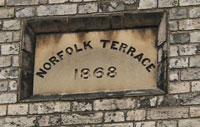 Cannon Street
Cannon Street
|
|
blank |
This plaque in Cannon Street, Bury St Edmunds, records the completion of a new row of terraced houses in Cannon Street.
|
|
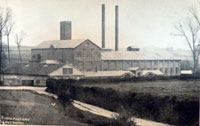
Lavenham Sugar Factory
|
|
blank |
At Lavenham a new Sugar Beet factory was built to process locally grown beet into sugar. Although this was a great technical achievement, the factory closed in 1871 because the price at which the local sugar was produced was too high to compete with the cane sugar being imported from abroad. It reopened in 1885, but soon closed again because of cheaper imported sugar products.
In 1839 Joseph Poulton had opened his silk factory at Water Street in Lavenham. Later it was run by George Bentotes, but by 1868 Morris's Directory of Suffolk recorded that it had ceased to weave silks and velvets, and converted to making coconut fibre mats and matting. These new products derived from coconuts were to prove a success over the rest of the 19th century, and other materials like plaited straw and horsehair would also be adopted for processing in the south of Suffolk to make use of the local labour supply. In 1851 the parish of Lavenham had 300 straw plaiters recorded in the census. John Churchyard brought a horsehair factory to Lavenham between 1851 and 1855. He had opened in Melford by 1830.
Canon Greenwell was a canon of Durham Cathedral, but was a typical antiquarian of his day. He had a wide range of interests, inventing a fishing fly, for instance, but is best known for excavating barrows and mounds. He wanted to investigate the bumps and hollows at Grimes Graves, and was to be the first to prove that these were the remains of mine shafts for the excavation of flints, and not a burial site. He spent three years digging at Grimes Graves, and lectured widely on his findings.
|
|
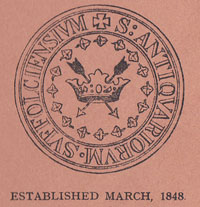 SIAH seal
SIAH seal
|
|
1869
|
The Bury and West Suffolk Archaeological Institute had been formed in 1848. In 1853 the Institute had joined with the Athenaeum to form one body, but in December, 1867 they broke away again to form the Suffolk Institute of Archaeology and Natural History. In January, 1869 the Institute adopted new rules and launched its new Quarterly Journal. The Institute's museum remained at the Athenaeum in Bury St Edmunds, and would stay there until 1899, when it would remove to Moyse's Hall.
The new Secretary was Edward Dewing, while Samuel Tymms was made an honorary member upon his retirement as Secretary. Lord Arthur Hervey remained as President, although he would soon be replaced by Lord John Hervey in 1870, when Lord Arthur would become Bishop of Bath and Wells. Subscriptions were doubled to 10/- a year to support the new Journal, but while a second journal came out in June, 1869, nothing more seems to have been issued until 1873.
In 1869, Horace Barker, senior died. He had been the printer and Publisher of the Bury and Norwich Post since 1863, but had worked on that newspaper since 1852. Horace Barker's widow, Emily Lydia Barker took over the paper, as shown in the 1881 census, until she retired in 1883.
The Bury and Suffolk Standard was set up in March 1869 by J Merrell and came out on Tuesdays.
|
|
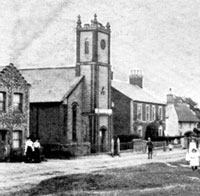 The Green at Barrow
The Green at Barrow
|
|
blank |
At Barrow a Primitive Methodist Chapel was built with a tower. The chapel was later taken over by the Salvation Army, but the building became redundant. The buildings were demolished, but the tower was kept because it housed a public clock. Today, only the tower survives, with no clock. as a curious relic standing over the Green.
The East Suffolk Police and West Suffolk Police were amalgamated by the Home Office to form the Suffolk Constabulary. This force lasted until 1899 when it split up again.
|
|
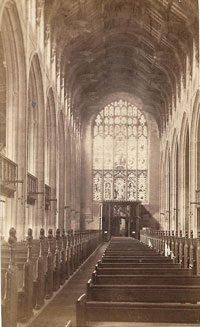 The galleries in St Mary's church
The galleries in St Mary's church
|
|
blank |
William Spanton produced this carte de visite (CDV) format photograph of the interior of St Mary's Church in Bury St Edmunds. CDVs were produced to order for anybody who wanted a picture of themselves or family, but maybe did not want to pay for the larger "cabinet" size portrait. In addition Spanton took many photographs around the town for sale to the general public as "views" in this cheap CDV format. These were popular to collect as well as to send to friends elsewhere. On the reverse of this CDV, a scan of which has been supplied by modern collector Gerald Brown, are handwritten "St Mary's Church, West end, Feb 20th 1869 From Mrs Salmon". The significance of this view is that it shows a run of galleries on both sides of the main aisle. These had been thought to have been removed in the 1840s.
From July 20th to the 27th the Royal Archaeological Institute of Great Britain held its annual meeting in Bury St Edmunds. The Suffolk Institute had been trying to get them to Bury for the last 18 years. Naturally, on the first day the company inspected the ruins of the Abbey of St Edmund, and noted the number of ruins remaining around the site of the Old Botanic Garden, to the south-east of the precinct.
Mr Parker, the guide on this occasion, also showed them Moyse's Hall, now used as a police station. In his opinion one bay of that building had been lost in the construction of a new street. After also visiting the Guildhall, the party was at liberty to explore the other shop fronts and buildings around the town centre. Members were commended to the fine carved corner-posts which may be seen in the shops of Mr.
Thompson, bookseller, and Mr. Crassweller, chemist, in Abbeygate
Street; the house of Mr. Ridley in Eastgate Street, which is of the
fifteenth century; and another house of that period in Mustowe Street.
In the evening a meeting of the Historical Section was held in the
Guildhall, Beckford Bevan, Esq., presiding in the absence of A. J. B.
Beresford Hope, Esq., M.P., President of the Section. The meeting was
very well attended, including a considerable number of ladies. Mr. A. W.
Morant, F.S.A., read a paper on "The History and Construction of
the Abbey of Bury St. Edmunds."
Amongst his comments, Mr Morant noted that "In the museum of the
Institute is a portion of "St. Edmund's Oak," which fell down in 1848,
with the iron cusp of an arrow imbedded in it, supposed to be one of
those actually used against the martyr."
During the remainder of the week, a series of lectures, excursions and a temporary museum exhibition were laid on. Trips were also made to Clare, Melford and Lavenham, Haughley, Thurston and surrounds with visits to Framlingham and Ipswich by special trains. It would not be until 1899 that the Royal Archaeological Institute would return to Suffolk, holding their AGM at Ipswich.
|
|
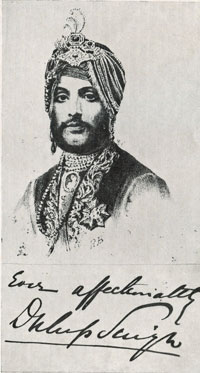 His Highness Duleep Singh
His Highness Duleep Singh
|
|
blank |
The Maharajah Duleep Singh had owned the Elveden Estate since 1863. He was interested in expanding his shooting estates and saw an opportunity at Eriswell.
The New England Company, properly known as the "Society for the Propagation of the Gospel in New England, and parts adjacent in America", had owned the manor of Eriswell, and much besides in that area, since 1649. In 1874, White's Directory of Suffolk noted that "His Highness Duleep Singh is Lord of the Manor (of Eriswell), which he purchased from the New England Co in 1869 for about £120,000." The Company had to obtain permission to sell from the Charity Commissioners, which they did in November, 1868. The estates now sold to Duleep Singh totalled 6,665 acres, which he added to his Elveden holdings.
Regulations came into effect in 1869 whereby beerhouses came under the control of local magistrates. Set up under an Act of 1830, these had spread because of the ease of setting one up, even in a separate room in a private house. Tighter controls now meant that beerhouses gradually declined, or were improved to the status of Alehouses or Public Houses. Many were bought up by breweries.
Just before the new controls came into force the Britannia Inn was built in Ipswich Street. This was a purpose built beerhouse, wrapped around the corner of Ipswich Street and Long Brackland. Today it is an 11 bed hostel with 6 move-on flats for the single homeless, and is called Britannia House.
The Falcon also opened in Risbygate Street, but applied for, and obtained, a full license. Much new housing was being built in this area. It was at the end of a row of houses called Paradise Place. This was an edge of town inn at this time, and had room for excellent stabling. Paradise Row was to become a slum clearance project, and the Falcon, once a thriving inn, would close for redeveloment into housing in 2012.
|
|
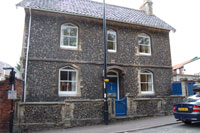
Bath Cottage 1870
|
|
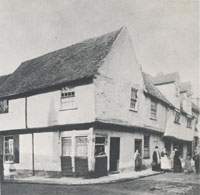
Guildhall and Westgate Street corner
|
|
blank |
Although there was plenty of new building going on in Bury St Edmunds, there was also plenty of old and decaying property in the town centre. This shop on the corner of Guildhall Street and Westgate Street photographed in 1870 illustrates this.
This was the year of the great new Education Act, 1870, when every authority had to ensure that school places were available to provide elementary education on a universal basis. It was also called the Forster Act. This new Education Act provided for the establishment of Board Schools to supplement those of the religious societies, and allowed for state funding of 50% of the running costs of voluntary schools, but phased out capital funding.
The passing of the Forster Act in 1870 thus brought about the establishment of Board Schools in places where there was a lack of existing provision. Bury St Edmunds already had enough places and no new Board School was needed, but this was not the case elsewhere in West Suffolk. With the advent of the board schools as a consequence of "An Act to provide for Elementary Education in England and Wales" [9 August 1870], the number of pupils at Ragged Schools such as the one in Peckham Street, gradually declined. Board Schools qualified for government grants.
The Act helped to raise the standards of literacy in Suffolk from 50% in 1845 to 97% by 1900.
In 1870 the Ixworth Farmers Club was founded by Edward Greene and a group of like minded farmers. Greene was living at Ixworth Abbey and farming its 400 acres as well as running his Westgate Brewery in Bury. This club met at the Pickerell inn in Ixworth and would become a focus in Suffolk for the discussion and dissemination of new agricultural knowledge and techniques. It met monthly to hear papers and was part of the so-called High Farming Movement. Greene was its President for 21 years.
|
|
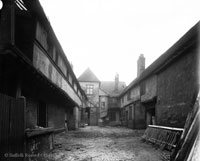
Half Moon yard
|
|
blank |
The timber framed building and galleries of the Half Moon Hotel in the Butter Market were demolished in about 1870. The Half Moon hotel stood at 28 Buttermarket and dated back at least to 1676. It had been a coaching inn, and its yard had extended back to High Baxter Street. In 1821 the coach known as The Times stopped here three times a week on the Norwich to London run. After some years The Times transferred its stops to the Bell Hotel, but in 1844 it reverted to the Half Moon. By 1844 The Times was the only remaining coach to run all the way from Bury to London by road. Other coaches transferred their passengers to the railway at Bury. The coaching yard continued in use by The Times coach until about 1850, when its passengers finally succumbed to the lure of railway travel. By 1870 the coaching yard was derelict, as shown in this picture by William Spanton. The Half Moon gradually dwindled away until it became the site of the Playhouse Cinema. Its old tap room would survive as the Playhouse Bar until closure in 1973.
After 1870 the pattern of the brewing business in Bury St Edmunds changed dramatically. The various new controls on licensed premises brought in in 1869, stopped the free trade in licenses. Brewers needed some way to tie in their customers in the new restricted market. Elsewhere in England this did not really have much effect until around 1880, but in Bury, Greene's brewery had a dangerous new competitor in Fred King's St Edmunds Brewery, which had been producing beer for just a year, but was being well received by the public.
From 1870 to 1880 Fred King bought 40 inns, pubs, and beerhouses, and tied them all to buying his beer.
Edward Greene had always preached the virtues of Free Trade, and in the past had always sold off any pubs that he had acquired. Now he saw that conditions had changed, and over the next ten years he also acquired 44 new pubs, the first being the Dog and Partridge, next to his brewery yard. With his own time being short, and his son Walter spending most of his time hunting to hounds, Edward also brought his nephew, Edward Lake into the firm in 1869. Lake was to prove a most valuable addition in the next few years, becoming a partner by 1876.
|
|
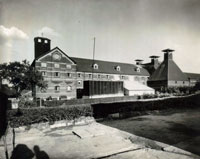
Gough's Maltings
|
|
blank |
In 1870 Jesse Gough acquired a large site on Thingoe Hill, behind the railway station. In 1884 any existing maltings on the site were replaced by a large new complex known as Old House Maltings, but in later years were always known as Gough's Maltings. By the 1960s this had developed into the largest operating traditional floor maltings in the UK, with J Gough and Sons Ltd at Bury St. Edmunds. By 1993 this method of malting was totally non-viable and Gough's Maltings were closed down, and demolished in 1994 to 1995.
After 1870 Jesse Gough bought Dunnell's maltings on the Mildenhall Road, which at the time was within Fornham All Saints parish. Gough would go on to own several maltings around East Anglia. He had a maltings in Long Melford, now apartments; one in East Harling, now a tarmac company; one in Bures St Mary, believed demolished; one in Stonham Aspell, now demolished, one in Felixstowe, near the docks; and one in Stowmarket, now a nightclub.
|
|
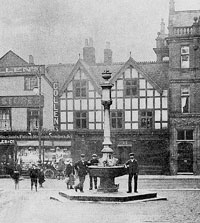
Lord Bristol's Gift
|
|
blank |
In the Traverse a fine drinking fountain of Portland Stone was installed as a gift from the third Marquess of Bristol. Presented in 1869, it was unveiled in 1871. Although a welcome feature, it always made it difficult to get a Four in Hand coach into the Traverse to reach the Cupola House, and in 1939, it was moved into the Abbey Gardens. Click on the picture to see a wider view of its location.
|
|
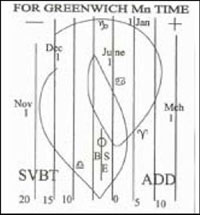
The Bury St Edmunds Curve
|
|
blank |
The new drinking fountain incorporated a sundial designed by the architect Francis Cranmer Penrose, FRS. Penrose applied the mathematical formulae he had learned at Trinity College, Cambridge, under William Whewell to allow users of the sundial to correct the observed solar time to Greenwich Mean Time. As GMT was not introduced as the legal British time until 1880, this was a ground breaking innovation. This fact was highlighted by Fred Sawyer in the North American Sundial Society Compendium, Volume 12 Number 3, September 2005, and the graphical corrections are now known as the Bury St Edmunds Curve.
Lord Arthur Hervey left Suffolk to become the Bishop of Bath and Wells. He gave up his presidency of the Suffolk Institute of Archaeology and Natural History, and his place was taken by his nephew, Lord John Hervey. Lord John would publish several books on Suffolk history, and was active in the Institute until his death in 1902.
|
|
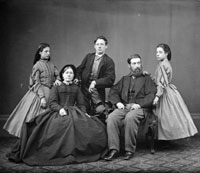
Spanton family c1868
|
|
blank |
William Spanton, the local photographer in Abbeygate Street, died in 1870 at the age of 47. This remarkable picture shows William Spanton, bearded, with his wife Sarah and family in about 1868/69. It illustrates the superb quality which could be achieved using the glass negatives and tripod cameras of the time, together with a long exposure. The younger man is William Silas Spanton with his sisters Sarah Rebecca and Hannah Kate.
After William's death his son, William Silas, took over the business and ran it until 1901. William Silas Spanton had been born in Bury in 1845, and was, at the time of his father's death, finishing his training as an artist in London. He returned to Bury to run the business, which he did successfully for some 30 years until his retirement in 1901. His interest in painting continued, and he built a reputation locally as a copier of paintings. He would also later paint portraits of local dignitaries, such as the Mayor. He widened the scope of the business, adding to photography, framing and glazing pictures, the sale of art materials, and also built up a considerable business as an optician.
At St John's church change was afoot. In the words of Simon Knott, in his exemplary website "Suffolk Churches.co.uk":- "It was not until 1870 that the first Vicar of the church, the Rev. B. Rashdall, was replaced by a young and enthusiastic Anglo-catholic priest, Father Stewart Holland. The effect was somewhat akin to a whirlwind descending on the church. During the seven years of his incumbency, the church was completely transformed, to emerge as St John the Evangelist, the county's flagship Anglo-catholic shrine."
" In 1871 and 1872, the great pulpit was taken down, and replaced by a simple reading desk. The church was decorated for Easter and Christmas. The black gown was given up, and surplices were worn by priest and servers. Holy Communion was introduced on every Sunday, and pew rents were abolished. Services were introduced on weekdays, and some of them were sung.
In 1873, choral Mass was introduced; the choir was surpliced, and a vestry built."
|
|
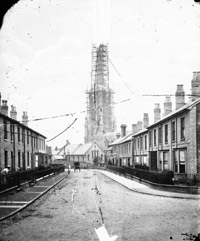
Repairs to St John's church |
|
1871
|
In 1871 the Spire of St Johns Church in Bury St Edmunds was struck by lightning. The spire had to be shrouded in scaffolding to make repairs. The lightning strike gave local photographers the opportunity to take birds eye view photographs of the views from the spire.
|
|
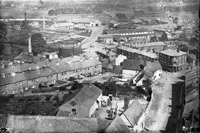
Gas Works by 1871 |
|
blank |
The first picture shows the spire shrouded in scaffolding awaiting repairs. The view northwards from the spire shows the view over the gasworks towards Station Hill. These pictures are by courtesy of the Spanton/Jarman collection held by the Bury St Edmunds Past and Present Society on their website.
In 1871 the General Board of Health was merged with the Poor Law Commission to form the Local Government Board.
Early in 1871 the Improvement Commissioners for Bury St Edmunds decided to employ a painter to paint house numbers on all those properties not already displaying a number. In 1830, Pigot's Directory of Suffolk was able to list properties in Bury St Edmunds by number because the Improvement Commissioners had then employed a painter to add numbers to Bury properties. However, as usual, there were people who had refused to display their allocated number, or had since had the number painted over in a redecoration. The Commissioners now began a new initiative to enforce their use across the board. Houses in the Long Brackland area and newer parts of town particularly needed attention. At this time house numbers were still allocated consecutively from one end of the street to the other along one side, and then back again along the other side. The idea of putting odd numbers along one side with even numbers on the other did not come in until new streets were built after the 1880s.
In the Bury and Norwich Post 28th March 1871, it was announced that the partnership of Robert Boby, George Boby and William Clarke, trading as Boby, Clarke and Co was dissolved, and that W Clarke and co would continue their General and Furnishing Ironmongers business at 6 Meat Market, Bury St Edmunds. The partnership ended on 25th March, 1871. The Boby Brothers had decided to leave the ironmongery business to concentrate upon the Iron Works. They were also planning a new joint venture to be set up by the railway station.
|
|
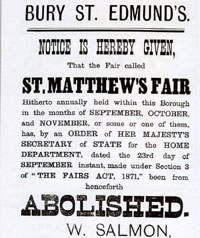
Bury Fair abolished
|
|
blank |
Bury Fair was abolished under the provisions of the Fairs Act of 1871. Upon petitions from the public, the Mayor, John Watling Ion, wrote to the Home Secretary to petition for its abolition. As St Matthew's Fair, it had run since 1135, under a grant of Henry I, and had achieved great prominence in its time. St Matthews Day was September 21st, but the fair would last for several days. It was held on Angel Hill and the opening used to include a sausage feast for the Mayor and Corporation. It declined as a trading fair in the 1830's and the coming of the railways hastened its decline.
By 1871 it had lost its respectability, and was now considered a public nuisance because of "a few noisy shows, Steam Roundabouts and Shooting Galleries which are kept going with their frightful noises until 11 or 12 o'clock at night." The residents of Angel Hill could bear it no longer. The Home Secretary accepted the Mayor's advice, and issued an order to ban the fair.
|
|
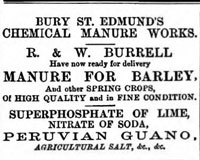
Chemical Manure advertisement 1871
|
|
blank |
In 1871 this advertisement for the supply of chemical fertiliser was offering a variety of manures for the improvement of agriculture. Robert Burrell of Honey Hill and his brother Walton Burrell, a farmer at Hall Farm, Fornham St Martin, established their factory outside the Borough boundary on Saxham Road. Today we know this location as Westley Road.
Superphosphate of lime was produced by dissolving animal bones and other materials such as coprolites in sulphuric acid, and then drying the results. This process was invented by John Bennet Lawes of Rothamstead around 1840.
|
|
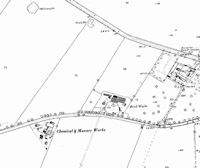
Chemical manure works Westley |
|
blank |
The factory produced sulphuric acid, (known at the time as vitriol), agricultural salt, and chemical fertilisers. This factory is recorded in the 1875 Suffolk Post Office Directory, and it was still advertising in 1892.
In the 1881 census there is an obscure note by the enumerator which appears to report that from December, 1879, Walton Burrell senior was not only a farmer employing 34 men, 3 women and 18 boys, but was also an employer of 8 men and 2 boys at the chemical manure factory.
At this time the factory was in the parish of Westley, being just outside the pre-1934 borough boundary. Today the site would have the address of Westley Road, Bury St Edmunds. Please click on the thumbnail to see a wider view of the locality. The attached view is from the 25 inch Ordnance Survey map dated 1884.
|
|
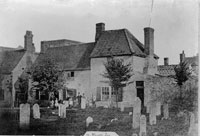
The Magpie Inn 1868
|
|
blank |
The notorious Magpie Inn by St Margaret's Gate, facing into the Great Bury Churchyard was demolished in 1871. It was an ancient and rambling inn, but it had enjoyed a bad reputation as a haunt of villains and ladies of ill repute for the whole of this century. Today it is under the new Shire Hall and part of the site is the Magistrates car park.
|
|
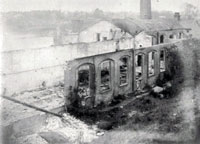
Guncotton Factory Explosion
|
|
blank |
Stowmarket had suffered an explosion in a gun cotton works in 1864, but that was a small explosion compared to what happened in the summer of 1871. The following headline appeared in the Bury Post on August 15th 1871.
TERRIBLE EXPLOSION AT THE STOWMARKET GUN COTTON WORKS
NINETY PERSONS KILLED AND INJURED
On Friday 11th August, 1871, the New Safety Gun Cotton factory of Thomas Prentice in Stowmarket suffered a terrific series of explosions. Twenty eight workers were killed and over seventy were injured. When the inquest was convened, thirteen of the dead were named. Also, there were two other males and four females unidentified at the time. One of those named was Edward Prentice but William Prentice’s name did not appear on the list, as no identifiable part of his body had been recovered. At the time the inquest was in session, the decomposed body of a boy called Frank Mayhew was discovered in the debris of the works. He had worked there for three weeks and earned 3s.6d. a week. He was just 14.
The factory was completely destroyed and it was decided that it was caused by unknown persons adding Sulphuric Acid to the gun cotton after it had passed its tests. A reward of £100 was offered to find the perpetrators.
It seems that at first three magazines containing 13 tons of guncotton exploded. Rescuers ran to help, including two of the Prentice family. An hour after rescue work began, there was a further explosion in the packing house, and both Edward and William Prentice were killed along with other rescuers.
The factory was rebuilt, and back in production within a year, as the Stowmarket Guncotton Company. The Prentice family would sell the company in 1880, after which it became known as the New Explosives Company of Stowmarket.
Vanners Silk manufacturers had originated in Spitalfields. According to the Sudbury Museum Trust, the firm made a late move into Suffolk in the 1870s when they opened warehouses in Glemsford in 1871 and Haverhill in 1874. Other silk manufacturers had been in Suffolk for half a century by this time.
|
|
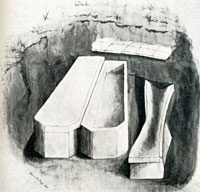
Four Roman burials
|
|
blank |
In December 1871, a labourer discovered a stone coffin in Hunt's Field at Icklingham. Henry Prigg, a local antiquarian, was called in and pronounced it part of a Roman period cemetery. He soon excavated four graves, and finding well worn coins of Probus c282, and Crispus, assigned the burials to the early 4th century. He ended up with two stone coffins, one lead coffin, and one burial without a coffin, but covered by a pavement of large Roman tiles. Prigg noted that the stone coffins were similar to a coffin already found at West Stow Heath.
Vaccination against smallpox had been available for many years by this time. However, outbreaks could still occur, as reported by the Bury Post, in December 1871:
"IXWORTH - Fourteen cases of small-pox have recently occurred in this village, two of which have terminated fatally. Eight of the cases are now fully recovered, and the remainder are convalescent."
By now the world was united by the electric telegraph, and thousands of new jobs were created. Cables were laid to India and Australia by 1871.
|
|
1872
|
The prison service was taken over from local government by central government. The quest for efficiency on all fronts also hit the Police Service. In 1872 the West Suffolk Police Force was merged with the East Suffolk Force. The secret ballot was introduced for elections.
In Eastgate Street, Bury St Edmunds, the St James Infant School was built in what was described as a neat Gothic stone building, on land donated by the Marquis of Bristol.
|
|
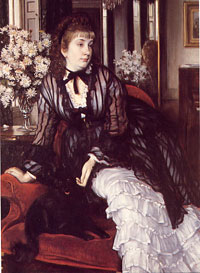
Sydney Milner-Gibson
|
|
blank |
In 1872 Sydney Milner-Gibson was 21, and she was presented with her portrait by her half brother, Thomas Bowles. Bowles knew the French painter, James Tissot, who had fled Paris in the face of the Franco-Prussian War. Bowles had given him a roof over his head in London and commissioned the portrait from him. This portrait was the most distinguished of the works of art to make up the Cullum Bequest, left to the Borough of Bury St Edmunds in the 1920's. For many years it was on display over the stairs in the Library when it occupied the site of today's Laura Ashley store. For some years it was on display in the Manor House Museum on Honey Hill, Bury St Edmunds, until that Museum closed in 2006.
The Dog and Partridge inn at Crown Street had been independently owned for many years. Its history goes back well into the 18th century, and, as the Mermaid Inn, probably another century before that. In 1872 it was taken over by Greene King's brewery, with a new landlord, William Land. It had long been a favourite with people attending the Theatre Royal, who used it before and after a performance, and during the intervals. Many people also stabled horses there while at the Theatre.
S Tymms produced a new edition of "A Handbook of Bury St Edmunds." There were numerous maltings in Bury, and the two breweries in Westgate Street, Greene's Westgate Brewery and Fred King's St Edmunds Brewery. Neither brewery employed many men. Boby's agricultural implements works in St Andrews Street employed 200 men by contrast.
According to Wikipedia the Bury Town Football Club was established by William Lake at a meeting in the Suffolk Hotel in 1872 (but see 1874). Initially named Bury St Edmunds Football Club, the first committee of the club elected to choose royal blue as the club's colours. In 1885 they were one of eleven founder members of the Suffolk FA and voted to change their name to Bury Town. In 1895 the club's name reverted to Bury St Edmunds, then to Bury United in 1908 and back to Bury Town in 1923.
The club took up residence at Kings Road, then known as the Cemetery Road ground, in 1888. It became the first football ground in East Anglia to operate floodlights, when on 12 January 1953, Bury played their first ever floodlit game against Cambridge City in front of 2,105 spectators. The club's last match at Kings Road was played on 30 April 1976, a 2–2 draw against a West Ham United team with 1,750 in attendance; the land on which the ground was located was required to build a new road. After a year at a temporary ground, the club moved to their current Ram Meadow ground in 1977.
The last of Haverhill's two yearly fairs was abolished in 1872. This fair was held on October 10th, while a second, held on 12th May, had already ceased. These fairs sold goods from a wider area than the Friday Market, and were also used as Hiring Fairs for servants and farm labourers.
|
|
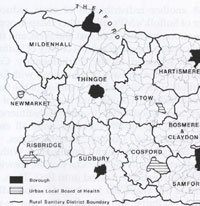
New Sanitary Districts |
|
1873
|
Urban and Rural Sanitary Authorities came into being under the Public Health Act of 1872. As a result, the Haverhill Sanitary District was set up, and its Local Board lasted until 1894. The Haverhill School Board was formed under the Chairmanship of William Wakelin Boreham.
The Bury St Edmunds Paving and Improvement Commissioners were now abolished by the Act, and Bury St Edmunds Borough Council was invested with all the powers of an Urban Sanitary Authority and therefore assumed the duties of the Commissioners.
The Poor Law Unions also became taken over by the new Sanitary Authorities.
The new Sanitary Districts in our area were as follows: - Bury St Edmunds USA,
- Risbridge RSA,
- Haverhill USA,
- Thingoe RSA,
- Thetford USA
After a time the Bury and Thingoe Sanitary Authorities would discuss pooling their resources. Gradually through the late 1870s the Bury Union Workhouse in College Street would be wound down and its inhabitants moved into the Thingoe Union Workhouse in Mill Lane, (now Mill Road), just off Hospital Road, Bury St Edmunds. In 1884 the College Street premises would be auctioned off.
The Sanitary Districts would last until 1894, when Urban and Rural District Councils would be established in their place.
|
|
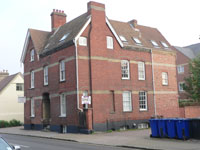
Northgate Villa
|
|
blank |
In 1873 the Collegiate School was founded in Northgate Villa in Northgate Street, Bury St Edmunds, by the Reverend H L Christien. This school became the Methodist school in 1881, and Culford School traces its origins to this foundation in 1873.
In 1873 the British Army was reorganised by Edward Cardwell, the Secretary of War. The 12th Regiment became part of the 32nd Military District with Headquarters and Depot in Bury St Edmunds. The Cambridgeshire and West Suffolk Militia were also formally incorporated.
The Trinity Methodist Church was finished in Brentgovel Street to replace the Wesleyan Methodist Chapel in St Mary's Square.
|
|
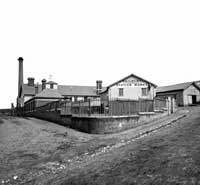
The Station Works c1873 |
|
blank |
Robert and George Boby decided to enter a joint venture and acquire land on the Station Hill in order to set up a new factory. They would produce a variety of products for the brewing and chemical industries. Located on their own railhead, raw materials were easily unloaded, and finished bulky products easily sent to anywhere with a railway station. The picture also shows the proximity of the railway goods depot and workshops to the right of the view.
The Bury and Norwich Post 4th November 1873 described a supper at the Angel Hotel given to all Boby workers to celebrate Messrs R and G Boby's Station Works opening, as well as a new building at St Andrews Works. The new station buildings were praised for their elegance, the main purpose of which was to produce brewers' finings. The raw material for this was the swim bladders of sturgeon, imported from South America. These were supplemented by the bladders from a similar species imported from Bombay. The new patented process ensured that a pint of the resulting isinglass could clarify a whole barrel of beer.
The Station Works also produced several other products which could also be sent out in bulk by rail. Among these were sulphuric acid, acetic acid, Bethell's patent Neutraliser and Bi-sulphate of Lime.
|
|
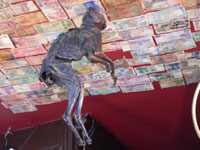
The Nutshell Cat
|
|
blank |
The smallest pub in Britain is the Nutshell, in the Traverse, at Bury St Edmunds. It was opened as a beerhouse in 1873. These tiny premises had been a newspaper sellers for some years, next door to John Stebbings fruit and vegetable business. The family took over the newsagents, and the son, John Henry Stebbing ran it as the Nutshell. In the next ten years John Henry filled it with his own cork models of the Abbey, the Norman Tower, and the Abbey Ruins, and other notables like Nelson's Column and Trafalgar Square. In addition he displayed all manner of "antiquities" and curiosities. The Nutshell survives today with a much reduced number of curiosities, most notably a mummified cat hanging from a ceiling full of foreign banknotes.
|
|
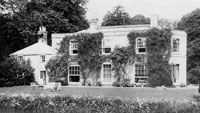
Cockfield Rectory
|
|
blank |
Robert Louis Stevenson said that his stay at Cockfield Rectory in 1873 was the start of his literary career. From 1866 to 1889, the rector here was Churchill Babington. His wife was a cousin of Stevenson, and the family had many literary and scientific friends, and these gatherings inspired Stevenson, then only 22, to launch his literary career. Visitors included the critic Sidney Colvin, and Frances Sitwell, a famous beauty of her day.
|
|
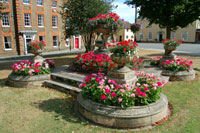
Terra cotta Construction
St Mary's Square, Bury St Edmunds
|
|
1874
|
There stands a prominent fountain-like construction in St Mary's Square in Bury St Edmunds, which is now used to display flowers as part of Bury in Bloom. An inscription can be found on its base which reads "Terra-cotta, M H Blanchard, London, 1874". Blanchard was highly regarded for his work in making, and promoting the use of, terra-cotta architectural objects. Such objects was widely used in the South Kensington Museum building projects. The planter was restored in 2009 and 2010, but is pictured here before restoration.
|
|
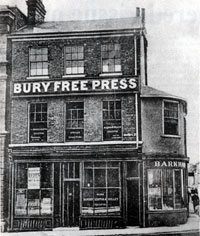
BFP offices in Abbeygate Street |
|
blank |
In 1874 the Bury Free Press moved some of its offices and all of its printing into what was then called Cemetery Road. These offices, now in the re-named Kings Road, continue to be the headquarters of the BFP in 2005. The demand for news was growing and Thomas Lucia's business kept growing with it. He had started the BFP in 1855 from his home at 8 Buttermarket, and had already moved its press to 15 Abbeygate Street, and then to the top of Abbeygate Street, (illustrated here), before settling in Cemetery Road. The editorial continued to be produced at this Abbeygate Street address into the First World War, which is probably the date of this picture. Henry Bankes Ashton was the solicitor for the paper, and occupied the ground floor premises, as seen here. (After Lucia's death, Bankes Ashton would take over editorship as Trustee.)
The new printing press was supplied by Mr Boby's St Andrews Works, just across the road, and was powered by a Steam boiler. The old presses were also moved into the new Cemetery Road works.
With the growing market for newspapers, the East Anglian Daily Times was founded in 1874 in order to provide Suffolk and Essex with its first daily paper. Mr Disraeli became Prime Minister.
This was the year which destroyed agricultural unionism in Suffolk. In 1872 the Exning farm labourers had joined Joseph Arch's new National Agricultural Labourers Union. Other farmworkers in Suffolk also joined them. For two years they tried to get better pay until in Spring 1874 the employers locked out all union members. This lock out spread through the Eastern Counties, and the men were forced back after several months, in time for the harvest.
Agriculture was moving down into another of its periodic depressions at this time, and things would get worse into the 1880's. In Brandon crowds gathered around a banner proclaiming "Bread or blood in Brandon this day." Troops were called in to disperse them. Other incidents around Halesworth and other areas included shops and barns being broken into, and farmers and magistrates threatened.
At Glemsford, a rural village which had been traditionally agricultural, the last 50 years had seen a growing number of factories situated there producing products from silk, coconut fibre and horsehair.
By 1871 Glemsford had more jobs in manufacturing than it had in agriculture. According to the Sudbury Museum Trust, Vanners Silk had arrived in Glemsford in 1871. The silk throwing mill alone had 200 employees by 1874. Meanwhile many other silk mills in places like Mildenhall, Boxford and Hadleigh had died out by the 1860s, following the depression in the industry caused by the free trade in silk imports.
Vanners Silk manufacturers had originated in Spitalfields. According to the Sudbury Museum Trust, the firm made a further move into Suffolk in the 1870s when they opened a warehouse at Haverhill in 1874.
|
|
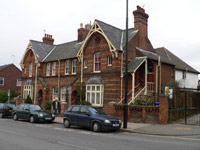
The Fennell Homes
|
|
blank |
A local Quaker, Sarah Fennell left money to another Friend, Sarah Ann Bott. She decided to use the money to build four flats on land sold to her by the Society of Friends. The Fennell Homes, as they were called, were for respectable women in reduced circumstances, who were willing to read the bible to the poor of Bury, and engage in other home mission work. The Quaker Cottages can still be seen in St Andrews Street, still occupied by retired women Quakers. The Friends Meeting House is the white building behind the Fennell Homes.
In Haverhill the Methodist Chapel was built in Camps Road. It replaced a series of temporary homes used by the Methodists of Haverhill since they were founded in 1857. The current building on the same site was built in 1970.
In October a public meeting was held in the Suffolk Hotel to consider forming a Football Club for the town of Bury St Edmunds. Mr E W Lake was voted in as Chairman, and subsequently Captain. About 30 people signed up to join the club at 2/6 a year subscription. The rules to be followed were the Rugby Union and the Football Association. Club colours were Royal Blue and Black.
On November 14th the Bury St Edmunds F C played its first match away at Colchester and drew against the 10th Regiment stationed there. The return match was played on 5th December on the Cricket Ground in Kings Road, and Bury won 2-1. A couple more games were played against the Bury Grammar School in the 1874/75 season, but they got going in earnest in the 1875/76 season. Bury Town F C still exists today, but no longer plays on the Kings Road site. Its home has been Ram Meadow since 1976.
The Conservatives won the General Election of 1874. Once again Edward Greene topped the poll in Bury, but this time the runner up was another Conservative, Lord Francis Hervey. The Hervey's were back in Parliament representing Bury, having been ousted in the 1865 election, effectively by the local Conservative party backing Edward Greene.
J Hardcastle, the defeated Liberal, had lost his seat. He had been living at Nether Hall in Pakenham, but he now sold this house and its estate to Edward Greene. Edward had re-married in 1870, and had been living with his wife at Ixworth Abbey, a home he had rented since 1865. His new wife was Lady Dorothea Hoste, the widow of Admiral Sir William Hoste, baronet, of Westgate House in Bury. The couple moved to Pakenham where Nether Hall was rebuilt and extended.
The plantations of the Greene family in St Kitts had been dwindling in profitability since the 1840's. Much of it had been disposed of. After 1874 there was a completely free trade in sugar, as tariffs favourable to colonial producers were finally ended. Continental beet sugar was now being produced.
|
|
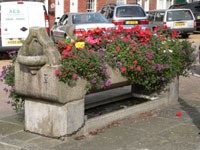
The Lady Bunbury Horse Trough
|
|
1875
|
The flow of public health legislation following the 1848 Act resulted in the consolidating Public Health Act of 1875. Sanitary authorities had the duty to secure wholesome and sufficient water for the needs of their areas. Where there was no other water undertaking the duty fell upon the authority. They also received powers to undertake refuse collection and disposal.
Lady Bunbury presented the Borough of Bury St Edmunds with a fine stone horsetrough for the relief of any animal in need of a drink passing along Eastgate Street. As fewer horses had need of it by the late 20th century, it was used as a flower planter. It stands in the Broadway in Eastgate Street.
The Suffolk Village Club and Reading Room Association started to promote the provision of such facilities in rural areas of the county. It seems to have operated until 1901 and was responsible for getting a reading room into around half of Suffolk's villages according to Robert Halliday.
The local troops of Suffolk Yeomanry Dragoons were formed into the Royal Suffolk Hussars, including the First Troop based at bury.
The firm of William Henry Smith and sons were linen and woollen drapers at 24 The Butter Market in Bury St Edmunds. His son, Samuel Smith established a hardware business in the Corn Hill. By 1875 they had set up a clothing factory at Barrow, about six miles out of Bury, and also seem to have acquired the clothing factory of Parnall's at Chevington, and another Parnall factory at Cowlinge.
Elsewhere on the Cornhill the Bullen family set up a drapery shop in the premises which had been the White Horse Inn. This stood where Burger King and a travel agents now sit, nearby to Moyse's Hall. The building dates back to a rebuilding after the Bury Fire of 1609. The plaque commemorating the fire used to be next to the Inn door. The inscription has been copied on to a board now above the windows.
In the 1860s and 1870s there was a growing use for the husk or outer covering of the coconuts and the fibres in these husks known as coir were imported into this country in large quantities for the manufacture of matting and as filling for mattresses. The mat-weaving from coir became centred in Suffolk and at one time there were 10 factories employed in this way in Glemsford. Coconut matting was cheap to buy and remained popular up to the Second World War. Factories used men and boys in the making of coconut matting and the preparing of raw horsehair. Weaving the horsehair was undertaken exclusively by women and girls.
Roper's had been making coconut matting and horsehair products at Lavenham since the 1860s, but in 1875, they were to meet local competition. Laycock's of Sheffield opened a factory in Barn Street, next to the Grammar School. They specialised in horsehair seating, and would expand into the school premises when the school closed in 1890. Laycock's factory employed predominantly women.
Some time during the 1870s a Flax factory was set up to the west of Long Melford, on the River Stour, on the site of a former paper mill. By 1883 this factory would employ 80 men, 50 boys and 30 women and girls. There was no weaving carried out, but flax was grown on the farms around, then soaked in tanks until the fibres became loose. A process known as "scutching" or beating the stems then took place to release the flax fibres. Flax was then sent to Belfast for spinning and weaving into Irish Linen. Unfortunately flax production never really succeeded anywhere in Suffolk, and by 1891 White's Directory said that it was, "now practically closed, only few persons being employed."
On nearby Westgate Street, Melford, the Stag beerhouse changed its name to the Scutchers Arms to attract flax workers. The Scutchers Arms continued to operate until the 1990s when it was sold by Greene King, and it became Scutchers Restaurant.
By 1875 Greene's Westgate Brewery was producing 40,000 barrels of beer a year, compared to 2,000 barrels in 1836, when Edward Greene took over the brewery from his father.
John Atterton moved to Haverhill in 1875 after the firm of Atterton and Symington closed down in Halstead. He set up the Duddery Iron Works not far from the Colne Valley Railway Station at Haverhill South, casting iron and brass. Atterton's works would become a long standing feature of Haverhill employment.
|
|
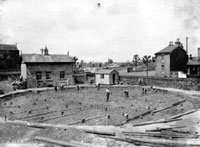 Gas Holder Tayfen Road
Gas Holder Tayfen Road
|
|
1876
|
In Bury St Edmunds gas had been supplied since 1834 by Malam and Peckston's gasworks in Tayfen Road. After several early changes, the works had become owned by the Bury St Edmunds Gas Company since 1849. At this time the gas was used mainly for lighting. Gas cookers would not come into use until about 1897. In 1857 the company had installed a telescopic gasholder, and a further holding tank. By 1876 they needed more capacity, and a new gasholder was built. Because of the restricted size of the original gasworks site, this new gasholder had to be built outside the existing gas works perimeter. The new site was bounded by Tayfen Road and Ipswich Street, so that Ipswich Street ran between the two sites.
This picture shows the new Bury Gasworks gas holder being constructed overlooking Tayfen Road, with the Ipswich Arms public house in the background to the right. (This gasholder was referred to as Number 2 gasholder in the company's centenary publication in 1934.) At the same time a new gas purifier was built, and a number of new gas mains were installed in the town.
In Haverhill the large Board School, later known as the Cangle School, was built at the junction of Withersfield Road and Wratting Road and the buildings survive there today. Such Board Schools were built under the provision of the Education Act of 1870 which made education compulsory.
In 1865 a private Act of Parliament was obtained to allow the construction of a railway from Bury to Thetford. It had taken another nine years for the finance to be raised to allow it to be built. However, by now the agricultural depression after 1875 was well under way, and would continue throughout the 1880's and 1890's. The Breckland around Thetford was one of the worst hit areas, and there was no trade for a new rail link to enjoy.
Therefore, when the railway line from Bury to Thetford was finally opened in 1876, it was not very successful, and it was sold to the Great Eastern Railway company, (GER), within two years for half what it cost to build.
|
|
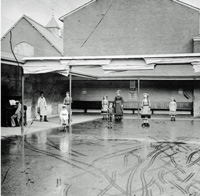
Mr Robinson's skating rink |
|
blank |
According to the BSE Past and Present Society website, Mr T B Robinson opened his skating rink in the grounds of his residence, Brooke House, Westgate Street on Easter Monday, 17th April 1876. The rink was 92 feet by 36 feet laid on concrete covered with Spanish asphalt, to provide a surface like ice. The south side and centre were open to the elements but the other sides were under cover. There was a practice room, called a 'Nursery', where clients could be taught how to roller-skate. One of the maltings of Greene King in Westgate Street was known as the Rink Maltings in 1880.
Moyse's Hall was improved by the addition of a Belfry and Public Clock.
|
|
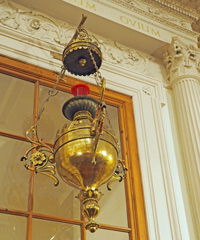
Catholic Sanctuary Lamp |
|
blank |
Meanwhile the Roman Catholic church in Westgate Street, Bury St Edmunds, received its sanctuary lamp. It had a red light indicating the presence of the Blessed Sacrament and was one of the early gifts to the Church, donated by Irish drovers who took cattle across Europe during the mid-19th century. They saw that the Church did not have a proper sanctuary lamp and provided one made of brass bearing the inscription ‘Hibernae Donum Sancto Edmundo AD MDCCCLXXVI’ confirming the date of this ‘Gift from Ireland’ as 1876.
It would appear that the Irish were mainly immigrants to England who worked as drovers in this country ‘driving’ cattle between markets and to the ports for export to Europe. One of the markets involved was Bury St Edmunds, and the drovers would attend Mass at Westgate Street on a Sunday, between jobs, usually standing in a group at the back of the church.
|
|
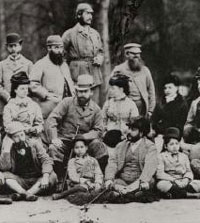
Elveden Shooting Party
|
|
1877
|
Between 1863 and 1870 Duleep Singh had transformed Elveden hall into an Oriental Palace. In 1877 he entertained the Prince of Wales to one of his frequent shooting parties. Elveden was one of the best sporting estates in England. It covered 17,000 acres. However, the cost of its upkeep and his unsatisfactory relationship with the British government led him to leave Elveden in the 1880's. He wanted to return to India, but the authorities would not allow it, and so he settled in Paris, where he died in 1893.
|
|
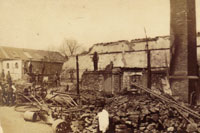
Aftermath of Boby's fire 1877 |
|
blank |
Robert Boby's factory at St Andrew's Works suffered a disastrous fire on May 5th, 1877, and many of its buildings were lost. The factory had to be largely rebuilt, and as part of the improvements, Pump Court on St Andrews Street was later purchased and replaced by what was to become Boby's main office, warehouse and showrooms. The new factory buildings would survive on the site until the 1970's. The building now preserved in the Stowmarket Suffolk Rural Life Museum was one of those built after the fire of 1877. The main offices still stand on St Andrews Street in 2011.
The accompanying picture is from a CDV, or Carte de Visite, made by the studios of J W Clarke. This format was in general use before the advent of picture postcards and derived from the older practice of leaving a visiting card when calling upon acquaintances. When photography arrived, people began to add a self portrait to their visiting cards, and soon these developed to include topographical views which could be sold to the general public. These could be collected and kept in albums as a pastime.
|
|
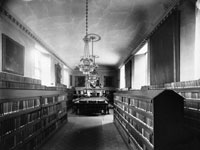
Library and Council in the Guildhall |
|
blank |
The governing body of the town, the Bury St Edmunds Borough Council, had met upstairs in the Guildhall, at the back for decades. In 1806 the wing holding the council chamber had been rebuilt, but by 1877 it was too small to hold all the councillors and the town officials. The room which is today known as the Banqueting Room on the ground floor, was much larger, but had been used as the Bury and West Suffolk Library since 1848. Nevertheless it was decided that the two functions could share the room, as shown in this photograph from the Spanton / Jarman Collection in the possession of the Bury Past and Present Society.
The Mayor and Council of Bury St Edmunds got a new suite of chairs when the Council Chamber moved downstairs. They were made by Bullens whose shop was by Moyse's Hall where Macdonalds is today.
The Suffolk Institute of Archaeology gave the contents of its Museum to the Borough Council of Bury St Edmunds. This collection would remain at the Athenaeum until more suitable premises were found. This would not happen until Moyse's Hall was opened as the Borough Museum in 1899.
|
|
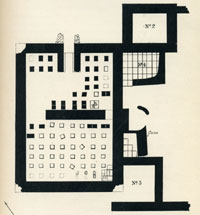
Prigg's Roman House
|
|
blank |
Early in 1877, Henry Prigg announced that he had discovered a Roman Villa in the field called "Horselands" in Icklingham All Saints. In April he began an excavation, and exposed four rooms of the villa. Further digging was stopped by the field being sown with barley. The main room had a hypocaust for underfloor heating, with the furnace visible at the top of the diagram. Prigg estimated from coin finds that the house was dismantled in the latter half of the 5th century.
In July, a workman ploughed up a hoard of silver Roman coins in a nearby field in Icklingham. Prigg dated these to late 4th century, and in his "Icklingham Papers" he suggested that the hoard was deposited around 408 AD, when Saxon incursions may have made this necessary.
|
|
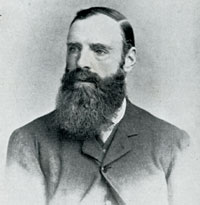
Henry Prigg
|
|
1878
|
From 1878 to the 1890s, Henry Prigg of Icklingham was excavating Roman pottery kilns on West Stow heath and found 'Anglo-Saxon urns etc' on the site of the then unsuspected village. He published his paper "West Stow Pottery Kilns" in the proceedings of the Suffolk Institute of Archaeology.
Henry Prigg also published "Warren Hill Tumuli" in that journal in the same year. He worked at the National Provincial Bank in Bury, but was a keen amateur excavator until his death in 1892. His book "The Icklingham Papers", was published posthumously in 1901 by his daughter.
|
|
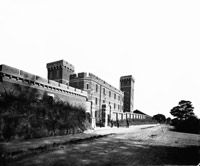
The Barracks |
|
blank |
In White's Directory of Suffolk for 1879, it was reported that "Bury is the place fixed upon as the Military Centre for the counties of Suffolk and Cambridge, and steps are being taken for the purchase of a suitable site for the erection of the necessary buildings."
In 1878 the Keep at Gibraltar Barracks, Bury St Edmunds was built as a Brigade Depot, to be composed of about 200 men of the 2nd and 3rd Battalions of the 12th Regiment of Foot. They were not called the Suffolk Regiment until 1881. Although used by the local militia, the Regiment later only had about 70 HQ staff on site. The battalions were mainly abroad until 1912. The Keep still remains, but the rest of the Barracks now contains open space, the Bury Leisure Centre and the West Suffolk College.
One of the side effects of building the new barracks, with its boundary wall, was that the old base of the boundary cross, now known as the Plague Stone, was found to be in the way of the new constructions. It is believed that it had stood at the junction of Beeton's Footpath, with Newmarket Road, just where the new barracks boundary reached. It was decided to preserve the stone and it was moved eastwards up Risbygate Street, to a site just in front of John Frenze's Spital almshouses, standing at the foot of Chalk Road. The move was recorded in Pawsey's "West Suffolk Illustrated."
White's Directory also recorded the other military features of Bury. The West Suffolk Militia Regiment had 1,000 men, 29 officers, 37 staff sargeants, and 40 NCO's. The men assembled annually for training as they were all part time volunteers. Their staff HQ was the barracks in Cemetery Road, where Yeomanry Yard now stands, in what is now known as Kings Road.
There was also the West Suffolk Yeomanry Cavalry, composed of four troops, of 190 privates, and 45 Officers and NCO's.They also muster annually for 8 days of exercises.
The 1st Battalion of the 13th Suffolk Rifle Volunteer Corps had 130 men, having been enrolled at Bury in 1860.
|
|
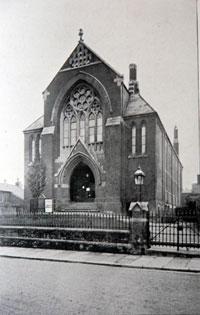
The Wesleyan Chapel
|
|
blank |
The Wesleyan Chapel was built in Brentgovel Street, to replace the earlier chapel in St Mary's Square. The chapel in St Mary's square had been built in 1811, and in 1878 was sold as a house, today called 4A St Mary's Square. The Brentgovel Street Methodist Church is still in use today, although it has been altered and extended from its appearance in 1878.
The Bury bank of Huddlestone and Company was bought by Gurney's Bank in 1878, together with a branch at Mildenhall. Gurney's Bank would become part of Barclay's bank in 1896.
There used to be a stone near the end of Norfolk Road which read "Norfolk Road, half a mile long, made and planted 1878". This fact was recorded in the Jubilee History of Bury, to be published in 1887. Today's Norfolk Road is only about 150 yards long and much of the original road is now called Northgate Avenue. It is still lined predominately with Lime trees. According to Ordnance Survey maps, the names of these roads has changed over time. Thomas Norfolk was the owner of the Northgate Estate who was developing the area. He had lived in Highland House. The OS map for 1886 does not have any reference to a Northgate Avenue, and the modern Avenue is labelled Norfolk Road. According to the map there may have been an intention to extend what we now call Norfolk Road right across the Shirehouse Heath, as the avenue of trees was planted ready. Shirehouse Heath is the area east of Northgate Avenue which included the Thingoe Hill tumulus, Northgate Farm and Highland House.
By the time of the 1904 OS map, the avenue across Shirehouse Heath was labelled Northgate Avenue, and what we now call by that name was labelled Norfolk Road. Similarly Avenue Approach was shown as extending across to the Klondyke, in front of Northgate Farm.
By the time of the 1926 map, the modern road pattern with today's names for Norfolk Road, Northgate Avenue and Avenue Approach was established.
In 1878 the Globe inn in Raingate Street, at the foot of Prussia Lane, was renamed the Rutland Arms. Curiously it was still referred to by many locals as the Globe up until the last half of the 20th century. Others still called it the Twizzler, because, as the Globe, it had enjoyed a spinning globe as its sign. It closed in 1992, becoming number 68 Raingate Street. Raingate Street had the dubious honour of being mentioned in a survey of 1881, saying that its houses were the "worse examples of habitation" in the town occupied only by the very poor.
In 1878 Atterton's of Haverhill announced their new invention, called Atterton's Patent Lawn Mower Grinding Machine. Atterton would now specialise in lawn mowing equipment.
|
|
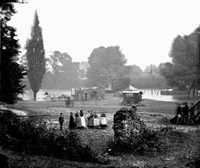
Bad weather July 1879 |
|
blank |
|
1879
|
Following a number of years of bad harvests, 1879 was even worse. It was a year of heavy and seemingly continuous rain. Cattle sank up to their knees in the fields, and the grazing was ruined. Sheep died in thousands. Haymaking was late and the crop was very poor.
Very wet weather meant that this was a year of disastrous harvests, some fields were not finished until October. Corn rotted where it stood, or sprouted on the stem. Normally such scarcity would have pushed up prices to provide some return for agriculture.
However, to add to the troubles of farmers and farmworkers, cheap American grain began to flood the market. Steam powered ships introduced in 1860, could now make fast and predictable crossing times over long distances. In 1879 the first shipment of refrigerated beef arrived from Australia. Such shipments would now become commonplace for food transport. Soon cheap beef would arrive from Argentina as well, and then lamb from New Zealand. The brief period of high farming which began after 1850 had now collapsed. Corn growing areas like Suffolk would be in a slump well into the next century, and conditions just grew worse and worse.
The bad weather holding up the harvest is illustrated here by flooding in the Abbey Gardens in July, when the showmen's gathering was flooded out.
At Walsham le Willows the lord of the manor, John Martineau, built New Cottages, a number of model homes for the working classes. These can still be seen today, with their improving mottoes carved into the wooden frames.
White's issued a new Directory of Suffolk in 1879. By now these Directories were very well developed. The entry describing the history of Bury St Edmunds filled 27 closely printed pages.
Bishops Road, Blomfield Street, Ipswich Street, Peckhams Walk and St John's Place were all recorded in the list of streets, whereas the great late - Victorian developments along West Road, Queens Road and York Road had not yet begun.
The Brewers listed were as follows:-
- Bishop, RA and C of 65 Guildhall Street, (at the Saracens Head)
- Clarke, John, of 62 Risbygate Street
- Greene E and Son, of Westgate Brewery
- King Frederick W, Westgate Street
- Lock Alfred, 92 St Johns Street
- Phillips Brothers Northgate Street; and Stowmarket
Maltsters listed were:-
- Clarke, John, of 62 Risbygate Street
- Cooper, Boby and Co, Railway Depot; and Stowmarket
- Gough Jesso & co, Out Northgate
- Newson P H 71 Risbygate Street
- Prentice Thomas, Town Hall, Meat Market
- Wing Charles of 10 St Andrew Street North; and Hawstead
The Iron Founders listed were:-
- Robert Boby St Andrew Street South
- George Cornish, 44 Risbygate Street
- Josiah Le Butt St Andrew Street South and Tay-fen Road
- Ransomes, Sims and Head, 5 Meat Market; and Ipswich
- Woods Cocksedge and Co, 22 Meat Market; and Ipswich
|
|
|
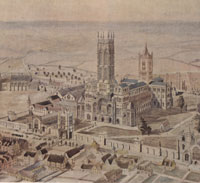
Abbey of St Edmund
by W K Hardy
|
|
1880
|
This well known picture of the Abbey of St Edmund in its heyday at Bury St Edmunds is now owned by St Edmundsbury Borough Council. It was painted in 1880 by W K Hardy, who was an architect who had married a Bury woman. They lived for many years in the town, and he claimed that he had undertaken exhaustive research before attempting this project. He voluntarily produced this work as a tribute to Bury St Edmunds, and it has been used in town guides and local publications ever since.
The prison, or The Fort, as it was now called, was closed in 1880. Most of the buildings were demolished except the facade and the Governor's house which still remain today.
The cemetery on the edge of Bury was extended by several acres .
The Renaissance style building now occupied by HSBC Bank in Abbeygate Street, Bury, was built for Barclays Bank.
|
|
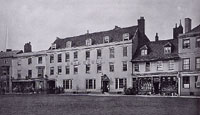
The Bell Hotel
|
|
blank |
The Bell Hotel had stood on one of the most prominent sites on the Cornhill since at least 1650, and along with the Angel and the Suffolk Hotel had been one of the town's three major coaching inns. There had been stabling for fifty horses, but by this time the stables were greatly decayed. The entrance to the inn for coaches was the origin of the access way through to St Andrews Street from the Cornhill at this location. The Inland Revenue Office was located here, and from 1795 had been the Bury base for the Royal Mail. In 1880 however, the Bell was sold off, and part of it was taken over by the Post Office for their new building which still stands next to Market Thoroughfare today. The rest of The Bell was auctioned off, and the inn replaced by shops. The route through to St Andrews Street was retained when the redevelopment of the Post Office finally took place in 1895, and became known as the Bell Arcade, running between the new Post Office and the new shops.
In the 1880 General Election the Conservative Party suffered for the fact that they had been unable to do much about the economic depression of the late 1870's. Once again in Bury the town returned a Liberal MP, Mr J A Hardcastle, who had been turned out in 1874. He topped the poll, and even the ever popular Edward Greene had a much reduced majority, although he was once again returned as the second MP. Greene had in fact been quite inactive since he had a bad fall at age 63, in November 1878.
|
|
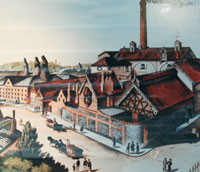
Greene's Westgate Brewery
|
|
blank |
In Westgate Street Edward Greene built the Rink Maltings on the corner of College Street. An article in the Bury and Norwich Post of March 4th, 1884, tells us, "The Rink malting, erected by L Jackaman from designs by Mr H F Bacon, architect, of Bury, has been only recently constructed on the site of the old Skating Rink." By 1884, the Westgate Brewery had six maltings, all producing different malts to suit the different beers produced at the time. The Westgate Brewery now looked as it does in this picture, which is in the Greene King Museum. The Rink Maltings of 1880 is visible on College Street, with the 1855 malt house beyond it. The garden of Fred King's house and brewery premises on St Mary's Square is visible in the bottom right hand corner.
Another Greene, John Smythies Greene, (1842-1884) was a solicitor working with George Partridge. Around 1880, J S Greene set up on his own, founding the firm which became Greene and Greene, which still exists in Bury today. Partridge's firm went on to become Partridge and Wilson, another surviving practice in Bury.
The Volunteer Rifle Corps were reorganised, and the 1st Administrative Battalion became the 6th (West Suffolk) Rifle Volunteer Battalion. In 1886 they would be attached officially to the Suffolk Regiment.
|
|
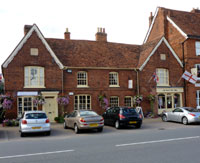
Cocoanut House, Long Melford
|
|
blank |
George Whittle had been a manufacturer of coconut matting at Melford since at least 1864, but in 1880 he built a new four storey mat factory there. It was located behind the house he called Cocoanut House which was completed a year later, in 1881. Cocoanut House can still be seen in Long Melford today. It carries its name on a plaque on one gable end wall and the date "1881" on the other gable end wall. This can be seen by clicking on the thumbnail shown here. In the factory, coconut fibre was woven into lengths of matting which were then cut to the finished size and brushed clean. The product was sent by railway to London for sale. By 1891 Whittle would be employing 170 men at this factory, and production would survive into the 1930s. This Long Melford mat factory has since been destroyed by fire, leaving only the house on the frontage to mark its passing.
|
|
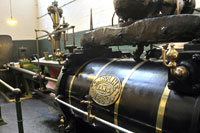
Caroline at Gurteen's
|
|
blank |
At Haverhill,
Daniel Gurteen III invested in improved mechanisation of his textile factory by installing a modern piston driven steam
engine that remains in the factory and has been restored to pristine condition. It was known as "Caroline", a 120hp single cylinder horizontal mill steam engine. Gurteens sold their now aging and obsolete beam engines to Walter Mason.
Gurteen also added the production of coconut matting to his output in the 1880s, and the
business expanded into the manufacture of men’s clothing, silk smocks and by 1900
the company would be employing some 2,500 people in and around Haverhill.
|
|
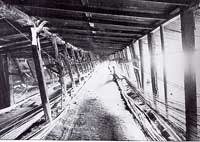
Burton End rope walk |
|
blank |
The Haverhill Rope Works was set up in 1880, according to the firm's own advertising sign, which can now be seen in the Suffolk Museum of Rural Life at Stowmarket. Rope was laboriously constructed in a "rope walk" which consisted of a long covered shed so that the fibres could be stretched and twisted together to build up the various thicknesses of rope.
Football was becoming an organised form of recreation for young men and the Haverhill Town Football Club was set up.
|
|
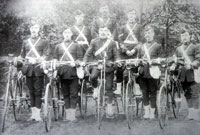
Third Battalion Cyclists
|
|
1881
|
Under the Cardwell army reforms, regiments were to become more closely linked to counties. The old 63rd Foot Regiment had been called the West Suffolk Regiment, but now became the Manchester regiment. The 12th of Foot had, until 1881, been called the Twelfth (East Suffolk) Regiment.
On 1st July, 1881 the 12th Regiment of Foot became called the Suffolk Regiment at last, and by 1900 90% of the men came from Suffolk.
The new Suffolks were to have two Regular Army battalions and two Militia battalions.
The old West Suffolk Militia thus became the 3rd Battalion of the new Regiment, and the Cambridgeshire Militia became the 4th Battalion. Here we see the Cyclists of the 3rd Battalion, pictured in 1881. Cycling units continued to be used up to the First World war.
There were also four Volunteer Battalions, the 1st, (East Suffolk), the 2nd (West Suffolk), the 3rd (Cambridgeshire), and the 4th (Cambridge University.)
|
|
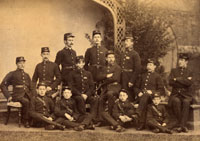
Bury's postmen pictured in 1885
|
|
blank |
Barclay's Bank opened its three storey premises in 1881, at the top of Abbeygate Street in Bury. For a few years it incorporated the Post and Sorting Office until 1895. In 1861 the post office in Bury was at 10 the Buttermarket, and customers stood outdoors and handed in letters or bought stamps through a foot square window. A few years later it moved to 24 Abbeygate Street, on the corner of Lower Baxter Street, where customers could be accommodated in a proper indoor office. In 1881 there was a need for larger premises, so the Post Office moved to 52 Abbeygate Street, premises formerly used by Gurney's Bank who had moved next door. The next move would wait until 1895, when the present post office on the Cornhill was built. For further information, including the names of the postmen pictured here, please click on the thumbnail.
According to the census of 1881, Bury's population was now 16,211. Bury's population would continue to be around 16,500, a figure which would more or less stay the same until after the Second World War.
At the corporation water works off Prospect Row, a new pumping station was built to raise water from the underground wells.
|
|
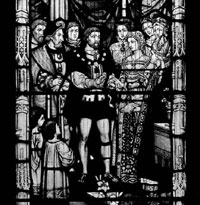
The Queen's Window
|
|
blank |
This stained glass window was given to St Mary's church in 1881 by Queen Victoria. It portrays the life of Mary Tudor, whose funeral was the last of the great ceremonies performed at the Abbey. After she was widowed she married Charles Brandon, Duke of Suffolk. Her body was re-interred in St Mary's Church on the orders of King Henry VIII. This photograph from the time, comes from the Spanton-Jarman Collection at Bury St Edmunds Record Office. It was printed from a glass negative approximately 164mm x 214mm.
Queen Victoria herself did not attend the installation of the window. She had not been seen in public since the death of her husband, Prince Albert, in 1861. It was a great weakness of her reign that she kept in seclusion until 1887, an extreme act of mourning lasting for 25 years.
|
|
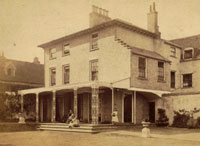
Rear of Bloomfield House |
|
blank |
By the time of the 1881 census, Robert Boby, proprietor of the great St Andrews Iron Works, had moved his address as follows: " 1 Low Baxter Street, Bury St. Edmunds (age 66 born Stanford, Norfolk), Ironfounder and Implement Maker. With wife Elizabeth (age 56) and children Selina M. (age 20), Agnes J. (age 18), Margaret A. (age 16) and Ethel M. (age 14). Also four servants and a visitor. " Number 1 Low Baxter Street was also known as Bloomfield House.
In 1871 the census had him living at 17 Low Baxter Street, but by 1874 he had moved to number 1.
|
|
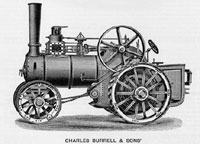
Burrells of Thetford
|
|
blank |
This picture is from the 1881 catalogue of Charles Burrell and Sons, Engineers of St Nicholas Works in Thetford. Burrell's claimed to be the oldest established makers of Traction Engines in the world, having been for the last thirty years engaged in their manufacture.
By 1881 they were making five classes of traction engine:
- Agricultural Locomotives
General machine for thrashing, grinding, sawing and haulage.
- Road Locomotives
For heavy and continuous haulage.
- Combined Steam Ploughing and Agricultural Locomotives
These were for the double engine ploughing system.
- Combined Steam Ploughing and Agricultural Locomotives
These were for the single engine ploughing system.
- Military Crane Engines
Includes use at Railways and Docks for lifting.
Burrell's would send a man to advise on your requirements, and more tellingly, to inspect the roads to ensure that the machine could operate in that locality. The agricultural locomotive varied in price from £300 for a 4 Horsepower engine to £500 for 10 HP. You could also order either 6, 7, or 8 horsepower versions.
The Road locomotive came in 6, 8 or 10 HP variants, priced from £450 to £580. The road wheels were 7 feet in diameter, by 18 inches wide, and the 8 HP version was guaranteed to draw 40 tons up a 1 in 15 gradient, with a normal working load of 20 tons in continuous operation. These were formidable machines.
All of these machines used a single high pressure steam cylinder to drive the crankshaft. In 1880 the Leeds firm of Fowler's had demonstrated the first compound cylinders to be used on a traction engine. This system used two cylinders. As steam was released from the high pressure cylinder, it was re-used at a lower pressure in a second, larger, low pressure cylinder. This was a very important innovation as it could produce a saving of 30% in the usage and costs of coal and water. All manufacturers soon adopted this idea into their ranges.
Burrell's really made their mark after 1889 when the first showman's engine with a dynamo attached was built for Jacob Studt, a famous showman, by the Thetford firm. Many of their surviving machines are the elaborate showman's engines with brass barley twist uprights, elaborate lining out and a full canopy over their length.
At Lavenham the census recorded 33 people employed as cocofibre matmakers, compared to only 12 people in 1861. There were 21 weavers, 7 'makers', 4 'worpers' and 1 'winder'. Coconut fibre matting was now increasing in popularity, and would continue to expand alongside the horsehair weaving at Roper's three factories , one in High Street, and now two in Water Street. However, Lavenham had 203 people involved in horsehair products in 1881, making it still six times greater in importance than the coconut matting industry. In 1875 the firm of Laycocks of Sheffield had opened their horsehair factory in Barn Street, Lavenham. Raw materials for all these factories were brought in by the railway since 1865, and easily exported from Lavenham the same way. Coconut fibre or coir came all the way from Ceylon and India, while unprocessed horsehair came from South America and Siberia.
|
|
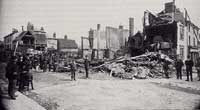
The 1882 Fire
|
|
1882
|
On June 16th there was a fire in Abbeygate Street in Bury which was begun as an insurance swindle. The owner of the tobacconist's shop got 5 years for attempted fraud. The rebuilding attempted to widen the pavement. You can still see the results of the wider paving from Hatter Street east to Barwell's the Butchers.
|
|
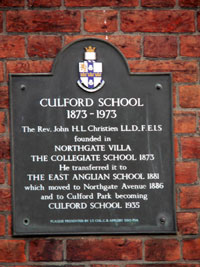
Plaque on Northgate Villa
|
|
blank |
The East Anglian School for Methodist boys was opened in Bury, to cater for secondary education. It was located in Northgate Street in the premises used by the Collegiate School, which was founded in 1873. The two schools were merged, and would move to larger premises in Northgate Avenue, within a few years.
In 1882 the magistrates at Ipswich who ran East Suffolk proposed that the quarter sessions held at Bury should be closed and all the administration moved to Ipswich for all of Suffolk. The western court objected and appealed to the high steward of the Liberty of Bury St Edmunds, the Marquis of Bristol. The argument continued until the local government bill included proposals for a single county council for Suffolk.
Continental beet sugar was now being sold in England at prices which undercut the West Indies producers. The remaining estates in St Kitts owned by the Greene family would be sold off at rock bottom prices by 1900.
The well known footbridge across the river Lark, located in the Abbey Gardens, was built in 1882. It was built for the use of scholars at the new home of the King Edward VI Grammar School, which was being built at the time in the Vinefields.
The Haverhill Industrial Co-Op was set up in 1882, located in a small thatched cottage in Peas Hill.
Walters shut down their silk works on Hamlet Green, in Haverhill and John Atterton took them over, moving his iron works operations from Duddery Road. New workshops were built and the old silk factory was now restored as show rooms. Attertons new works and showrooms opened at the very end of December 1883.
The Local Board at Haverhill now started on the project of a system of sewage disposal for the town.
Under the Electric Lighting Act of 1882, local authorities and private companies were empowered, subject to an individual Order, to set up their own electricity undertakings. This could be for their own use, such as to replace the old gas street lights, or to sell on to other customers. Bury St Edmunds would not achieve its own functional electricity undertaking until 1901.
|
|
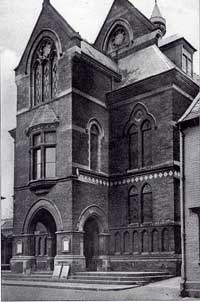
Haverhill Town Hall
|
|
1883
|
A magnificent new Town Hall was built as a gift to the town of Haverhill by Daniel Gurteen Senior to celebrate his Golden Wedding Anniversary. It was quite close to Haverhill South railway station. It contained a Council Chamber and office, the Public Library and a large Concert Hall. In 1884 it would be given a massive pipe organ by Daniel Gurteen junior.
The private mapmakers of earlier times were rendered unnecessary when the Ordnance Survey surveyed Bury and district on the scale of 1:2500, or about 25 inches to a mile. This base map was revised and reissued over the years, notably in 1903. The whole country was eventually surveyed at this scale throughout the 1880s.
In 1883, Robert Boby, the Bury St Edmunds agricultural implements maker of the St Andrews Works, in St Andrews Street (South), was elected Mayor of Bury St Edmunds. He took over from Thomas Ridley, the Grocer of Abbeygate Street.
|
|
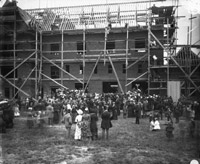
New Grammar School Building |
|
blank |
At Bury, the King Edward Free Grammar School moved to new premises. It had been located in Northgate Street for 200 years, but now moved to a 12 acre site on the old Abbey Vinefields, where it would remain until 1971. The site was bought from the Marquess of Bristol for £100 per acre. The architect was A W Bloomfield, and the builder was Grimwood and Sons of Sudbury.
The plans as proposed would have cost £16,000, but the governors agreed only to spend £12,500. R W Elliott called it a "job half done." Lord Francis Hervey had promised to give £2,000 towards the £16,000 design, and when this design was refused he resigned as a school governor.
|
|
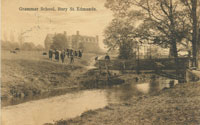
Grammar School access bridge
|
|
blank |
It was always compulsory for the boys to attend St James's church twice on Sundays, so the new school needed easy access to the church.
On page 126 of R W Elliott's History of the School he writes, "The bridge over the Lark from the Abbey Grounds was built by the governors, and paid for by them. Two or three sets of plans were considered. The school was given a right of way through the abbey grounds, then in the private ownership of Lord Bristol. The governors constructed a path from the centre path to the bridge, and Lord Bristol also gave a right of way on the school's side of the river, through the meadow, to the school grounds."
The old grammar school site in Northgate street was used as a Girl's High School, and by 1907 it was called the St Michael's Church of England College for Girls.
In about 1883, the long established stone masons business of the De Carle family was taken over by Arthur Hanchet. The De Carles had been in business since 1776, and they themselves had taken over Singletons stonemasonry business by 1800.
In 1883 the resident landlord of the Culford Estate, the Reverend Edward R Benyon, died. The estate included West Stow, and now passed to a nephew called Richard Benyon Berens. By 1889 he would sell it.
Edward Lake was elected Chairman of Bury St Edmunds Borough Council Finance Committee. He was managing Greene's brewery at the time, and was soon to be credited with putting the Council's finances on a modern footing. This greatly enhanced the Borough Council's reputation, for good management.
At the Stowmarket Brewery, Messrs Phillips had gone bust in 1872. In 1883 Greene's Brewery purchased the Stowmarket brewery, 35 pubs and, strangely, the Stowmarket Water Company. Greene King would run the waterworks until 1921, when they would sell it to Stowmarket UDC.
During 1883 the Bury and Norwich Post visited the three horsehair factories in Long Melford to report upon the state of the industry. There were three types of looms used to weave the horsehair, but the finished product was similar. Each operator was paid by the piece, and this was 52 feet long and 16 inches wide, and might take one girl about nine days to complete. They did not get paid their 16 shillings until the piece was finished and inspected. Handlooms were used by outworkers in their homes, while arm looms were used in the factories. In Melford, only the factory of List's had the newly introduced steam driven looms. List had 200 workers on his steam looms. The Masters of the factories all agreed to pay the same rates to their workers. List's factory would survive at Melford into the 1960s, long after most of the others had closed.
|
|
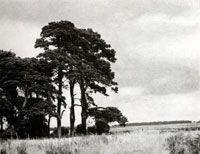
Typical Breckland raven site
|
|
1884
|
Dr Churchill Babington produced his Catalogue of the Birds of Suffolk in 1884. This replaced the Catalogue produced by Sheppard and Whitear in 1824. In 1824 the raven was not uncommon throughout Suffolk, but with the rise of the shooting estates, it was wiped out by 1884. Locally it was well known to haunt the Warren Hill plantation, near Mildenhall within living memory, also at Drinkstone Park and Euston Park. Ravens had also nested on Icklingham Plains, firstly in the Black Poplar trees, and then a mile away from that site. Elveden hall was another local site for them. Ticehurst believed that there must have been scattered breeding pairs in many parts of Suffolk up to 1860-1870, but that gamekeepers and shepherds had finished them off by 1884.
The picture shows a group of trees known as Birds Hurst on Redneck Heath, north west of Elveden. This was a traditional raven site until the 1870s. The word "hurst" means a grove or group of trees. Today this site is surrounded by forestry plantations, but the name survives on the OS 1:25,000 map.
A new Electoral Reform Act gave the vote to most working men in rural areas. The national electorate doubled to 5 million. Under the Redistribution Act, Bury was reduced from 2 MP's to 1 MP from 1885. Bury now had 2,000 electors compared to 694 in 1862, prior to the 1869 Act.
|
|
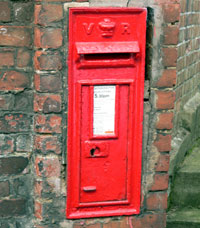
Victorian wall letter-box |
|
blank |
Wall letter boxes had been introduced in the early years of the 19th century, and pillar-boxes had been in use since the 1850s. At first they were routinely painted green, but in 1884 the familiar colour red was adopted in most provincial towns. Before the letter box was invented, letters had to be given to a bellman who made his collecting rounds in larger towns, or handed in to a recognised branch of the postal service. Since 1881 the main Bury Post Office and Sorting Office was located at 52 Abbeygate Street. It would remain there until new premises were opened in 1896 on the Cornhill.
|
|
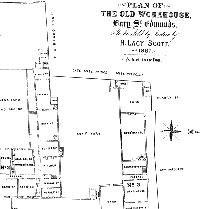
Workhouse sale plan 1884 |
|
blank |
The workhouse in College Street, in Bury St Edmunds, had closed in around 1880 after which time the Incorporation's indoor poor as well as vagrants were maintained at the Thingoe Union workhouse on Mill Lane. This de-facto arrangement was not formalised until 1907, when the Thingoe and Bury Unions would unite into the Bury St Edmunds Union. In 1884 most of the College Street site was then sold by auction, except for a portion that was retained for use as a board-room, pay-room, vaccination station, and relieving officer's office and residence.
The workhouse in College Street had been set up in 1748, and after its sale, parts of it were demolished. The College of Jesus had once stood on part of this site, and the College Hall had become a private residence after the Reformation of the 16th century. Having been a workhouse from 1748 to 1884, it would soon become the site of a sawmill and associated yard.
|
|
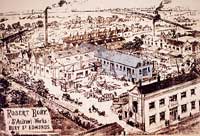
Boby's Factory |
|
blank |
The Bury and Norwich Post reported that Robert Boby's engineering works was employing nearly 200 men in the manufacture of screening and dressing machines, hay makers and horse rakes, and most of the utensils comprising a brewers' or maltsters' plant. The St Andrews Works would also cover general engineering and foundry work of all types.
The Old Independent Congregational Church was started in Haverhill for non-conformist worship and could seat nearly 800 people. At this date it was in Essex, as the County boundary ran down the Colne Valley Road.
Gurteens of Haverhill now began a new business, for them, of horse hair weaving but this could only be done on hand looms. They also went into fibre goods including the manufacture of crinolines.
By 1884, the gas supply in Haverhill was in a poor state. The gasworks had been set up in 1854, but since then the town had expanded ahead of the ability of the gas company to meet supply. The Haverhill Local board complained that not all the street lights were on when they should be. Individual householders on the gas supply complained that when it was a night with no moon, the demand for gas lighting was such that their lights were no better than rush lights. Such complaints had gone on for over a year.
Matters were more complex because the Haverhill Gas Company had leased the Works to a Mr Goddard for 14 years, which expired at Michaelmas, or 29th September, 1886. Mr Goddard said that there needed to be another gas holder to meet the demand, and the existing ones needed repair. He could not afford to spend up to £2,000 if he were to lose his lease in a couple of years.
The problem remained and 58 ratepayers had signed a petition asking for a public meeting. The Local Board decided to negotiate to buy the Gas works from the Haverhill Gas Company, and made a formal offer.
The Haverhill Gas Company sold its gasworks to Haverhill Local Board later in 1884 for £2,000. It seems that Goddard kept his lease until 1886, or 1887, when the Board took over management of the Works.
Meanwhile, Bury St Edmunds was thinking about converting to electricity, but with little action. In 1884 the Council received the Electric Lighting Confirmation Order (No 2) Act, which gave powers to the Mayor, Aldermen and Burgesses to erect and maintain electric lines and works to supply electricity to certain streets within the Borough. The Order was conditional upon works beginning within two years. In the event, two years would pass and this Order would lapse without any work apparently being carried out. Electricity was off the agenda until the 1890s.
On April 26th 1884 a rare event occurred when an earthquake hit the Colchester area. Wivenhoe and Langenhoe suffered damage, and shock waves rattled windows and furniture in Bury. The Halesworth Times for April 29th 1884 reported that, "Probably the most severe earthquake which has been felt in this country for a century took place on Tuesday morning last, being more or less felt throughout the entire length of the island. But especially in East Anglia, and in its fullest force and destruction at Colchester, where it destroyed property to the value of more than £10,000..... Four shocks followed one another. The stone spire of Lion Walk Congregational Church .....was broken off and fell with terrific force .....smashing the roof of the north aisle. A large number of civic buildings were damaged. At Langen-hoe, the fine old church of St. Andrews was completely destroyed, many other villages in the neighbourhood also reporting sad tales of injury and loss. The shock was felt to a lesser degree throughout Suffolk, but most were unaware of its cause until the East Anglian Daily Times, with praiseworthy enterprise, issued an extra special, which was eagerly purchased by thousands."
|
|
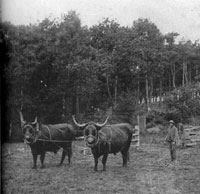
Harrowing with oxen |
|
1885
|
This remarkable photograph of a pair of oxen being used to harrow a field at Theberton in East Suffolk was taken around 1885. Oxen were still used for some jobs, and could be less expensive to feed than horses. They were slower, but could work on heavy land quite effectively. Here they are being used in the very light soil of the Suffolk Sandlings in a way that could have been seen a thousand years earlier.
General Gordon was killed at the siege of Khartoum. In Haverhill, the Old Independent Church was completed to a design by Charles Bell of London in Gothic style.
The Wesleyan Middle-Class Boys School had been in Northgate Street, Bury, until 1885. Highland House, built on Thomas Norfolk's Northgate Estate was bought and extended for use as a new school. Later it became known as the East Anglian School, and eventually in the second half of the 20th century it moved out to join Culford School. After some years as offices the building has been refitted in 1999, and during 2000 the surrounding land re-developed, for private housing.
In 1885, at the age of only 15, F G Pawsey took over a printing and stationery business in Hatter Street in Bury. Pawsey's would continue in business under several names always including Pawsey, until 1991.
|
|
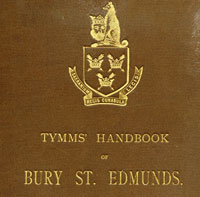
Tymms Handbook
|
|
blank |
Not far away in Abbeygate Street, was another business which would last well into the second half of the 20th century. This was the booksellers, F T Groom. They were the publishers of the Handbook of Bury St Edmunds, written by Samuel Tymms, Honorary Secretary of the Suffolk Institute of Archaeology and Natural History. Tymms had written many learned papers on the history of Bury, and despite his death, Grooms continued to sell the latest and 5th Edition of his Handbook as Tymms' Handbook of Bury St Edmunds. They had it printed by the London firm of Spottiswoode and Co..
The Handbook referred to the town's "distinguished Grammar School, an excellent Commercial School, a High School for Girls, a Wesleyan, and several private schools." "There are but few manufactures; the principal being that of Malt." Maltsters Gough, Boby and Fison had large maltings near the Northgate Railway station. Messrs Greene and King had their maltings near their breweries in Westgate Street and St Mary's Square. Robert Boby's St Andrews Works was making its famed Self Cleaning Corn Screening and Dressing Machine, having produced over 11,000 units. It had also produced 7,000 Haymakers. Mr G Cornish had "another considerable iron foundry in Risbygate Street." Ransomes of Ipswich and Woods of Stowmarket also had branches in Bury.
|
|
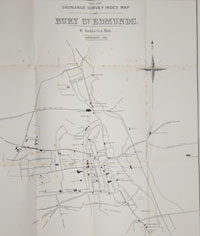
Bury in 1885
|
|
blank |
Included in the Handbook was a map of Bury based upon the latest Ordnance survey work as at September, 1885. In the north, the layout of the Avenue Approach and Norfolk Road area is clearly shown, along with the new location of the Wesleyan School, which became the East Anglian School later. The town's Sewage Works is still located at Bell Meadow. In the West, York Road and Queens Road are still called Upper and Lower Brown Road. Cornish's Foundry is marked at the foot of Chalk Lane. West Road is incomplete. In the east the Eastgate Railway Station is shown. In the south, St Botolph's Lane is shown as Madam White's Lane. Please click on the small map shown here to see a larger version.
The Handbook also described the town's three newspapers. The Bury and Norwich Post came out on Tuesdays and was established in 1782. The Bury Free Press was published Friday afternoon for Saturdays, established in 1855 by the present proprietor, T F Lucia. The Bury and Suffolk Standard was set up in 1869 by J Merrell and also came out on Tuesdays.
The year 1885 also saw the publication of another history and guide book, written by Horace Ross Barker. Its title was "History Of, and Guide To, Bury St. Edmund's". (H R Barker would eventually become curator of Moyse's Hall Museum in 1900.) He claimed that it was more of a guide for visitors than "some of its predecessors", although it contained much of the same historical detail as them.
Barker's guide was published by E L Barker at her Works at 8, Lower Baxter Street. This was Horace Ross Barker's mother, Emily Lydia Barker, (nee Ross), who had taken over the business from H R Barker's father, also called Horace. Horace Barker senior had died in 1869, at the early age of 54.
In practice, Horace Ross Barker was probably running the business in his mother's name for the last two years. H R Barker advertised in the guide that he would receive orders for "all kinds of publishing and letter press printing" at his office at 3 Guildhall Street, or at the works.
|
|
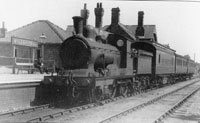
Mildenhall Station
|
|
blank |
In April 1885 the town of Mildenhall was linked to Cambridge via Fordham by a Great Eastern Railway Company railway line. Mildenhall had this rail link for passengers until 1962, and survived until 1965 carrying goods traffic.
Under the Redistribution Act of 1884, Bury St Edmunds was reduced from 2 MP's to 1 MP with effect from 1885, and agricultural labourers were given the vote.
Constituencies were reformed to give roughly uniform populations. Since 1832 Suffolk had two divisions, Eastern and Western, and each had two MP's. In addition the Boroughs of Bury, Ipswich and Sudbury also had two MP's each. The enlarged Borough of Eye had one MP. This made 11 Suffolk MP's in all, reducing to 9 after 1844, when Sudbury was disfranchised.
The dividing line between Suffolk West and Suffolk East had been along the boundaries of the ancient Hundredal sytem. The use of the defining Hundred boundaries was now abandoned in the revised system.
After 1885 there were 8 MP's in Suffolk. Eye was abolished as a constituency, Bury was reduced to one MP, but Ipswich retained two. The rural areas of Suffolk were split into North-Western, South, North-Eastern, Northern, and South-Eastern, each with one MP.
Edward Greene, who had been returned consistently as one of Bury's two MP's since 1865, decided not to stand again in the General Election held in the summer of 1885. He was nearly 70 and had suffered an accident in 1883, when he fell off a new tricycle at Nether Hall, his home in Pakenham.
The new elections were far from trouble free.
There was a riot in Long Melford at the 1885 election after the 1884 Act gave the vote to farm workers. Glemsford men had to walk 3 miles to Melford to vote, and although this was undoubtedly the trigger which started the trouble, this was by no means the only factor. Agriculture was in a dire situation with falling farm prices and reductions in the manpower employed. At the matting factories of Melford, Glemsford and Lavenham, wages had been cut, and men were either out on strike for better wages, or talking about it. All round, the mood in the whole area was ugly, with petty fights breaking out even between colleagues. Politically, Glemsford was strongly Liberal while Melford was staunchly Tory and the two villages were usually at loggerheads. The Melford people taunted the Glemsford men, calling them Egyptians, a term whose origin is unknown, but may refer to the winter sites of travelling gipsies, often called Little Egypts at the time.
|
|
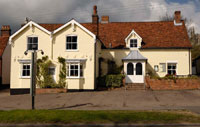
Scutchers Arms - First casualty
|
|
blank |
By 1885 the firm of H Kolle and Sons was employing some 700 hands at their horsehair and cocoa matting factory at Glemsford.
Obviously in the existing atmosphere, the Glemsford men had demanded a polling station be set up at Glemsford, to avoid having to visit the despised Melford, but this was refused. So on December 1st, polling day, a contingent of Kolle's Glemsford Matting factory men, marched en masse into Melford to vote. They were led by the works foreman on a horse, and most carried sticks or staves. Passing the Scutchers Arms in Westgate Street some windows were broken, and they went to vote at the polling station in the Lecture Hall. After voting they threatened to smash up the polling station, but by now a gang of Melford men had assembled outside. Stones were thrown and many windows were broken. Things looked so bad that the magistrate, Captain Bence of Kentwell Hall, read the Riot Act outside the Lecture Hall. A contingent of militia were actually sent from Bury St Edmunds by train, and were paraded on Station Square. With bayonets fixed they marched into Melford, emptying out each public house as they came to it. However, the mob violence died away in the face of the redcoats, and only a few individual fights continued as the men dispersed. However, the eye witness Ernest Ambrose in 'Melford Memories', who was seven at the time, reported that,
"The (Long Melford) village street was in a sorry state after it was all over, with broken glass everywhere. Shops and public houses down the whole length of the street from Whittle's Mat Factory right down to Branwhite's brewery on Chapel Green had their windows smashed. The Crown Inn suffered most damage as the mob stormed inside and wrecked the premises. Compensation for this alone amounted to £137.15.6, a considerable sum at that time."
The South or Sudbury division elected William Quilter of Hintlesham Hall, who stood for the Liberal party. Farm workers had used their new votes and voted Liberal in defiance of their Conservative masters. The Sudbury police had been unable to assist with the riot at Melford, possibly because they had their own disturbances to control.
|
|
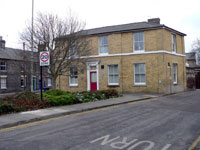
The New Inn
|
|
blank |
Disturbances also occurred in Bury St Edmunds. John Hammond, the new Landlord of the New Inn in Northgate Street was a Liberal supporter. The Liberal candidate was a Major Jameson, and the New Inn was a centre for his support. In the run up to the election several windows were broken following disturbances outside the New Inn.
Once the poll was declared, it became clear that Conservatism still reigned in Bury as the Borough again returned Lord Francis Hervey, the brother of the 3rd Marquess of Bristol. The election had been extremely close, but the new electors were not yet ready to change the status quo. From now onward Bury had only one MP.
The triumphant Lord Frances Hervey was dragged around town on an open wagon, as was the fashion in the nineteenth century, but they stopped outside the New Inn and taunted the Liberal occupants of the inn. A fight broke out and at least one man was knocked unconscious.
Ampton Hall was devastated by fire. However it would be rebuilt in much the same style as before.
|
|
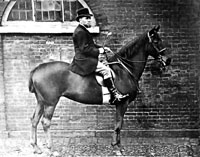
Jesse Gough c1890
|
|
blank |
The London Gazette for October 20th, 1885, contained this announcement,
"NOTICE is hereby given, that the Partnership heretofore subsisting between us the undersigned,
George Boby and Jesse Gough, carrying on business as
Maltsters, at Bury Saint Edmunds and Stowmarket, both in
the county of Suffolk, was dissolved, by mutual consent,
on and from the 30th day of September last. All the
debts due by and to the late partnership will be paid
and received at their office, Station Works, Bury St,
Edmunds.—Dated this 7th day of October, 1885.
George Boby.
Jesse Gough."
In Haverhill, John Atterton was turning out new inventions and putting them into production at his foundry. In 1885 he invented the central flue kettle and was later to invent a potato cleaning apparatus in 1893, a gear for friction clutches and in 1900 jib cranes and an apparatus for threshing machines.
Foundations of a building were found at the back of Weavers Row in Haverhill. This seems to be accepted as being the remains of the original Haverhill church, often erroneously called St Botolph's church, dating perhaps to a flint rebuilding of the 1100's. It was reportedly 100 feet long.
|
|
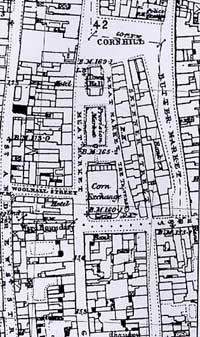
Bury town centre 1886
|
|
1886
|
A new Ordnance Survey base map of Bury St Edmunds was prepared on a 1:2500 scale or about 25 inches to the mile. The town centre is shown, together with the interesting expansion along Cemetery Road, with Boby's St Andrews Works shown, and the Cattle Market. It shows interesting changes and throws up some queries. The OS map for 1886 does not have any reference to a Northgate Avenue, and the modern Avenue is labelled Norfolk Road. According to the map there may have been an intention to extend what we now call Norfolk Road westwards across the Shirehouse Heath, as the avenue of trees was planted ready. Shirehouse Heath is the area west of Northgate Avenue which included the Thingoe Hill tumulus, Northgate Farm and Highland House.
Thomas the Ironmongers built a fine new building on the Cornhill, with a walkway from the Cornhill through to the cattle market on St Andrews Street. This was called the Bell Arcade at first, but today is known as Market Thoroughfare. The Market Thoroughfare still survives, but in a very much less elegant state since the replacement of this building by the 1960's redevelopment of Stead and Simpson's.
|
|
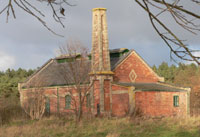
West Stow pumping station |
|
blank |
Some 112 acres at West Stow were purchased by the Borough Council in 1885, for a new sewage farm to be constructed to serve the town of Bury St Edmunds. Building took place from 1885 to 1887. This would replace the works built in 1863 at Bell Meadow in Bury. Like most sewerage schemes, it relied on gravity to provide the flow, and so the pipes were laid, as far as possible, along the river valleys. This required five miles of pipeline culminating at West Stow, where this pumping station was built by the River Lark. Its location at the end of the line, was needed to pump effluent up into the sewage farm site from a tank at the end of the pipeline. This is the only building now remaining from this work, and can be seen at the south-eastern end of today's West Stow Country Park. The expression sewage 'farm' came about because 20 acres of the site were to be used to grow crops such as tomatoes and blackcurrents to be irrigated from the outfall.
In order to finance this project, the Local Government Board gave the council permission to borrow £25,000 to cover the estimated costs. Such loans were normally repaid in instalments over a period of up to 60 years, together with interest. The annual instalments had to be a charge on the Town Rates. Unfortunately the scheme was not wholly succesful, and several improvements and changes were needed within a decade to improve its operation.
In 1886 Henry Lucia, who founded the Bury Free Press in 1855, died. Shops and private houses drew their curtains across as a mark of respect. The future of the paper came into question, but there was a curious solution on hand. The paper would be run by Trustees, who were Lucia's executors.
The newspaper, the Bury Free Press, was edited by Henry Bankes Ashton, a local solicitor for the trustees. He ran it from his offices at the top of Abbeygate Street, between the Alliance and Leicester Building Society, and Guildhall Street. The BFP did not get a proper new owner until 1902. The BFP itself was produced from its present site in Kings Road where it had stood since 1874.
Sir Charles James Fox Bunbury of Barton Hall died peacefully at Great Barton on July 17 th 1886. He had been lord of the manors of Mildenhall and Great Barton since the death of his father in 1860. Charles Bunbury had been a friend of Charles Darwin and Charles Lyall, the geologist. His own interests had been in the wider field of natural history, but botany had been his passion. He collected plant specimens on expeditions to South America in 1833 and South Africa in 1838. He also accompanied his great friend Sir Charles Lyell, the geologist, on an expedition to Madeira. He was elected a Fellow of the Royal Society in 1851.
As Sir Charles Bunbury had no children, upon his death he was succeeded in his title by his younger brother Sir Edward Herbert Bunbury, 9th Baronet. In 1847 Edward Bunbury had been elected to the House of Commons for Bury St Edmunds, a seat he held until 1852. Already 75 years of age, Sir Edward would die in 1895, at age 83.
|
|
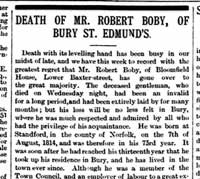
Robert Boby's obituary |
|
blank |
On December 2nd 1886, Robert Boby, described as the Proprietor of St. Andrew's Works, died after a protracted illness, aged 72, at his residence in Lower Baxter Street, Bury St. Edmunds. His widow Elizabeth would continue to live at Bloomfield House until her death on January 2nd, 1899, at the age of 72.
Robert Boby's funeral was held at St James's Church on 7th December, and large crowds gathered to pay their respects. The whole council and its main officers attended the service and the interment. The church was described as "comfortably filled." Although the cemetery on the edge of town had been in use since 1855, Boby was interred in the same brick vault in the old Churchyard as his first wife, Jane, who had died in 1854. Interments in the churchyard were now restricted to families who already owned vaults or graves there.
Robert Boby left a widow, a son and four daughters.
The 1885 Parliament ended in disarray as neither Conservatives or Liberals could muster a majority over the question of Irish Home Rule. Gladstone resigned and there was a fresh General Election on Irish Home Rule. Edward Greene, who had declined to stand as a candidate in the 1885 election at Bury, was persuaded to stand in the North-West suffolk constituency. There was a swing to the Conservatives, and Greene was elected, but his appeal to the agricultural workers for support went largely unanswered, as most appear to have abstained from voting. Greene represented North West suffolk until he died in 1891.
The 6th West Suffolk Volunteer Rifles became the 2nd Volunteer Battalion of the Suffolk Regiment.
At Haverhill, a new Police Station and Court were built on what is today the Pightle Builders Merchants site.
Gurteens of Haverhill now started coconut fibre mat weaving on hand looms, as well as weaving cloth clippings into rugs.
In 1886, the New Explosive Company of Stowmarket was taken over by the Nobel Explosives Company of Glasgow, which was owned by Alfred Nobel who, when he died, left most of his wealth in trust to fund several awards, one of which we know today as the Nobel peace prize.
|
|
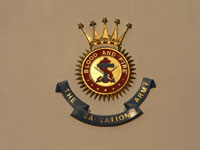
Salvation Army Badge
|
|
1887
|
The Salvation Army came to Bury in March 1887, and two sisters, Captain and Liutenant Newton
set up its barracks, as it was called, on the corner of Honey Hill and Sparhawk Street. Within three years they would move to a brand new building in St Johns Street.
The Local Government bill proposed to introduce elected County Councils to replace the administrative duties of the quarter sessions. It proposed to replace the Bury administration of West Suffolk, and the Ipswich administration of the East by one County Council. It was only the Marquis of Bristol's arguments in the House of Lords which got the bill amended to have two county councils created in Suffolk.
In April, 1887, a Report on Suffolk Agriculture was presented to the Royal Commission on Agriculture by Mr Druce. This report described Suffolk as a Corn County because the acreage under corn was two thirds greater than the acreage under permanent pasture. "Its agriculture consists almost entirely of corn growing, sheep breeding and feeding, and winter grazing or feeding of cattle. The four course system of farming is almost universally adopted coupled with restrictions against the sale of hay, straw and roots off the farm. Rents in 1880 ranged from 7/6 an acre for light sandy soils to 40s an acre for good mixed soil farms, to 42s for best marsh grazing land. The cottages are fairly good on the large estates, very bad in the 'open villages', where they are in the hands of small proprietors. Villages are, however, the exception rather than the rule in Suffolk, the cottages being generally scattered about the parish."
|
|
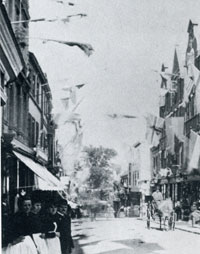
Abbeygate Street in Jubilee |
|
blank |
This was the year of Queen Victoria's Golden Jubilee, and street parties and events were organised to mark the event. This picture shows the flags lining Abbeygate Street in Bury St Edmunds.
In Richard Payne's survey of Bury St Edmunds in 1833, the land along the south side of Out Risbygate, from Chalk Road onwards, was owned by George Brown. When two new roads were laid out here, they were called Upper Brown Road and Lower Brown Road, running from West Road to Albert Street. Bury Town Council met on 3rd May 1887 and decided to rename these two roads to mark Queen Victoria's Golden Jubilee.
The
Upper Brown Road in Bury was re-named Queens Road, as from 21st June, 1887, as the first houses were being built here at this time. Lower Brown Road would become York Road, and The Crescent became called Albert Crescent.
|
|
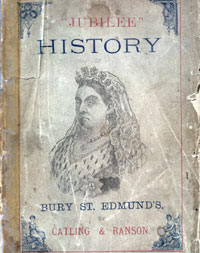
Jubilee History of Bury |
|
blank |
In June 1887 Messrs Catling and Ranson of 8 Lower Baxter Street, Bury St Edmunds, published this "Jubilee History of Bury St Edmunds" as part of the town's Jubilee celebrations. It contained some 124 pages of Bury's past from 855 up to 1887. It is valuable to us today because of the summary of some major Bury buildings and enterprises as they were in 1887. It had soft covers and was sold as a "people's edition" as it cost only sixpence, "a price within the range of all classes".
The introduction to the new history included this sentence' "During Her Majesty's reign great strides have been made in the march of civilisation (the Factory Act, the Education Act, and many other remedial measures having been passed), for which every man, woman and child in the United Kingdom should be truly thankful."
The first 42 pages consisted of history extracted "from Gillingwater's, Yates', Tymms', Jackson's and Barker's Histories, as well as Parish Registers and many other unquestionable authorities." The remaining 82 pages were entitled, "Bury St Edmunds in 1887."
In March 1887, the Jubilee History reported, the Medical Officer of Health, F W Clarke, gave his annual report for 1886 to the Bury Town Council. He was pleased to report that the mid '86 population of the borough was estimated at 16,630, and that a man in the Thingoe Workhouse had died at the astounding age of 104. Another woman had died in Southgate Street aged 99 years, while 3 others were in their 90s, and 36 were over 80. He was proud that few other towns the size of Bury could match this record of longevity.
Bury's agricultural markets were thriving. Throughputs were as follows:
CORN MARKET
- 142,165 quarters of corn, worth £214,553.7s.2d
LIVESTOCK MARKETS
- 6,588 fat beasts
- 16,971 store cattle
- 125,592 sheep and lambs
- 30,414 pigs
- 1,049 horses
Greene's Westgate Brewery was given four pages to itself, as the largest brewery in the town, but King's St Edmund's Brewery was second, followed by The Saracen's head, the Golden Lion and the Risbygate Breweries. The 'History' had to add an addendum at the final page to mark the merger of Greene and King, which had been announced in May.
By 1st June 1887, Fred King and his St Edmunds Brewery of St Mary's Square, had bought up 52 tied public houses. In response, over the years since King began brewing in 1868, Edward Greene of the Westgate Brewery had felt forced to buy 91 in total and to lease others. This fierce competition had pushed up pub prices and hurt both businesses. So Mr Greene and Mr King amalgamated their breweries, and Greene King was born. Ownership was two-thirds to Greene and one-third to King. The new company now owned a total of 148 licensed premises. Not wishing to flaunt their virtual monopoly in West Suffolk, at first the merger was not advertised, the pub signs showing no owner's name.
|
|
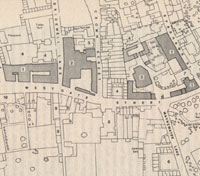
The new Greene King Brewery |
|
blank |
Details of the merger were handled by Edward Lake, the Managing Partner of Greene's brewery, and Edward Greene's trusted nephew. The company was floated as a Limited Liability business under the new Companies Act as did 29 other breweries in that year.
As a company it was now run by a Board of five Directors, and its Chairman was Edward Greene. Fred King's eldest son, J M King was made joint Managing Director with Edward Lake. Fred King was a Director. These five owned 97% of the issued share capital. Company policy was to continue to buy up new licensed premises, and to consider buying up any smaller breweries around East Anglia.
By this time, Greene's brewery had built or bought enough cottages to let at low rents to its workforce, that over half its employees lived in Brewery homes.
Greene King, newly created, now bought up Jenner's Brewery at Kedington, together with 22 public houses.
Despite the rise of the big brewer, beer was also still brewed at the Saracen's Head and the Golden Lion, both in Guildhall Street. Most publicans were by now taken over by one of the breweries, and so they took beer from their proprietor brewer.
The Saracen's Head building was occupied for many years by the British Legion Club, but by 2012 it became the Hunter Club.
In Risbygate Street, Clarke's Brewery was also operating, having been started in 1848.
Nearly three pages of "The History" were devoted to the Wine and Spirit trade of Machell Smith and Oliver's firm on the Cornhill. This enterprise was said to date back to its establishment by William Dalton in 1776. By 1877 it was held by F Machell Smith, and in 1881 the firm amalgamated with Oliver's to become Machell Smith and Oliver. G J Oliver had originally set up his own Wine Trade in Bury in 1860, and in 1870 he was joined by his son J G Oliver on the Buttermarket, before the merger with Machell Smith.
|
|
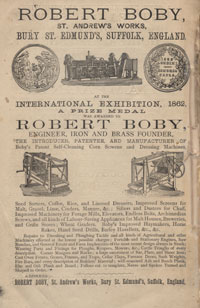
Robert Boby advertisement |
|
blank |
The St Andrews Works of Robert Boby also received a generous treatment of almost three pages of description. In its first year of production in 1856 the factory produced 200 cornscreens, and by 1887 it had sent over 13,000 such units all over the world. In 1877, following a disastrous fire, nearly all the factory was rebuilt, including a new main office and showroom on the site of Pump Court on St Andrews Street. Earlier, Turkey Court had been bought and demolished to incorporate its site into the factory premises. Boby's employed 200 men in its extensive range of foundries, workshops, carpentry shops, timber yards, paintshops and stores and assembly plants, all on the one site, located in the angle between St Andrews Street and Cemetery Road, now called Kings Road.
|
|
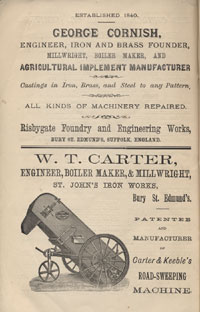
G Cornish and W T Carter |
|
blank |
George Cornish of the Risbygate Foundry and Engineering Works had a smaller enterprise, but still employed 50 men making agricultural implements. Harrows and Rollers were a speciality but in 1886 Cornish began making Tayler's new Road Sweeping Machine as well. In this advertisement Cornish claims to have been established in 1840. He also advertised as an Iron and brass founder, millwright and boilermaker, as well as an agricultural implement manufacturer. He would make castings in iron, brass and steel to any pattern.
St Johns Street also held the St John's Iron Works, making various iron machinery and implements. The owner, Mr W T Carter had also designed a Road Sweeping Machine, and had demonstrated it to the Borough Surveyor, Mr J Campbell Smith, in December, 1886.
Mr H Cooke had the Southgate Steam Flour Mills in Southgate Street, which was known for its steam horn sounding at 6 am on working mornings. It is said it was heard 10 miles away. At 6pm it also sounded the "leave off". The engine room was floored with Minton tiles.
Hirst's Tobacco and Snuff Manufactory occupied a site in Whiting Street. Today it has been converted into private housing.
The town enjoyed 15 butchers shops, as well as several butchers stalls in the Shambles. They all slaughtered their meat within the town boundaries. There were 32 bakers shops, 26 grocers, 19 greengrocers and 7 fishmongers.
|
|
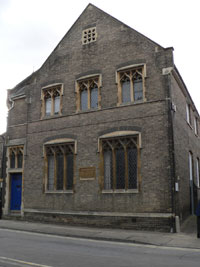
Congregational Sunday School |
|
blank |
In August 1887 the Congregational Church Sunday School had a fine new building erected for it. Located next to the Congregational Church in Whiting Street, it was opened by Edward Greene, MP, and his wife, the Lady Dorothea Hoste. Today this building is known as the United Reformed Church Annexe. It was built by Frederick Tooke, a builder of 76 Mill Road in Bury. Greene was a member of the Greene King brewing dynasty, and lived at Nether Hall in Pakenham. In 1836 he had bought Greene's Brewery from his father, and had just become Greene King's Chairman when it amalgamated with King's Brewery in June, 1887. Since Benjamin Greene's arrival in Bury in the 1790's the Greene family had attended the Congregational Church. Lady Dorothea had her title from her first husband, Sir William Hoste, Admiral of the Fleet, who died in 1868. After marrying Greene in 1870, she retained her title of Lady Hoste.
|
|
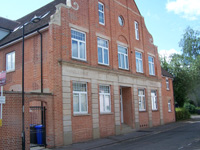
Makins of Long Brackland |
|
blank |
This trading warehouse at 50 Long Brackland, in Bury, was built in 1887 and is an imposing building in red brick with stone dressings and a Dutch style gable. The builder was Arthur Grimwood, listed as an architect of Church Walk, Sudbury, his family trading as George Grimwood & Sons Ltd of Sudbury. Leonard F Makin ran his wholesale grocery business from this warehouse supplying many of the smaller grocers in the town. He lived nearby at 7, St Andrews St North and was certainly still in business in 1908. Later in the 20th century it became a warehouse for Pordages, after which it would have many different uses.
|
|
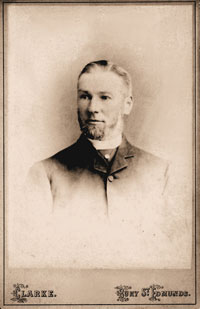
Frederick Charles Andrews 1887 |
|
blank |
Frederick Charles Andrews was elected Mayor of Bury St Edmunds to take office for one year, as usual commencing from the November of 1887. He would be elected for a further term as Mayor in 1894. He had founded his ironmongers business by 1862 in a commanding position facing down Abbeygate Street. His name would survive in the firm of Andrews and Plumpton, the Ironmongers, standing at the top of Abbeygate Street until well into the late 20th century.
The format of this photograph is known as a CDV or Carte de Visite, which denotes its small size as much as its function. Clarke was one of several Bury photographic firms who produced CDVs for clients. Such CDVs were widely collected, perhaps a precursor to the widespread hobby of collecting picture postcards two decades later.
In the 1880s, a new, more sensible, method of numbering new houses was implemented, putting odd numbers on one side of the road and even numbers on the other (starting with the lowest numbers at the main junction of the road). This means that without any prior knowledge whatsoever, anyone can deduce from a map where a number will fall in a street.
When the odds and evens system was introduced, it was used in most towns, including Bury, for newly built streets only. This left older streets with the consecutive numbering system, running along one side of the street, and then back along the other.
St Saviour's Hospital ruins stood in Fornham Road, Bury, and it was excavated to find a large hall of 66 feet by 23 feet. Beyond it was found the remnants of another apartment some 33 feet long. Five skeletons were found.
The Bristol Estate Book for 1887 recorded that however bad the farmers' position in 1884, it was worse now. Wheat had fallen to the unprecedented level of 32s a quarter, but barley, wool, meat and dairy were all making prices less than the cost of production.
|
|
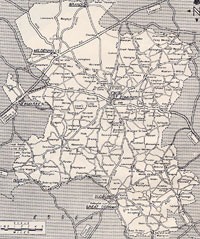
County of West Suffolk |
|
1888
|
The Local Government Act of 1888 set up the County Councils of West Suffolk and East Suffolk. County Councils now came into being as higher level administrative units all across the country. County Councils took on Highways powers. Prior to 1888, apart from the borough corporations, Suffolk had been administered by magistrates meeting in quarter sessions, one in the east at Ipswich and one in the west at Bury. County administration now passed from appointed magistrates to elected councillors. The existing area of the Liberty of St Edmund was largely perpetuated by the setting up of two county councils along this line.
However, there was a significant change to the county boundary at Thetford. Hitherto, the boundary with Norfolk had been along the River Little Ouse, and Thetford had been divided between two counties. All the town south of the river had been in Suffolk until 1888. The boundary was now shifted south towards Barnham, placing Barnham Cross Common and the whole of Thetford within the county of Norfolk.
The Act also brought in the concept of the County Borough Council for boroughs which had over 50,000 population. This included Ipswich and from 1888 the Ipswich County Borough Council became independent of East Suffolk County Council.
Rose Mead, later to become one of the best known local artists in Bury, attended art school in Lincoln from 1888 to 1892, followed by a brief spell at Westminster School of Art. The School of Art in Bury did not open until 1899.
Josiah Le Butt had set up his own iron works in competition with Robert Boby in 1867. In 1881 he had been recorded
in the census as an Agricultural Engineer, employing 10 men. On 4th April, 1888 Le Butt died at the early age of 57, at number 2, St Georges Terrace, which stands in Risbygate Street, Bury St Edmunds. This may well be the same location as the 1881 census address of 60, Risbygate Street. He left a wife Melinda, aged about 49, and a daughter Florence, aged about 23.
Some time after his death it is believed that the business was taken over by Boby's.
George Gery Milner-Gibson Cullum, of Hardwick House became the Sheriff of Suffolk. Born in 1857, he lived for most of his life at Hardwick, just outside Bury St Edmunds, and spent his time in studying history, archaeology and genealogy. He also had a collection of autographs. He had a great influence on setting up Moyse's Hall as a local museum, and loaned many family items for display. When he would die in 1921, he would leave the Cullum Bequest to the town of Bury St Edmunds, consisting of a large collection of books, objets d'arts and paintings.
During the 1870's and 1880's Hardwick House was enlarged to three times its original size. It became a massive mansion with extensive ornamental gardens. After George's death the house was demolished and its meagre remains are still visible at the rear of Hardwick Heath. The Hardwick Manor of today was originally the Gardener's Cottage of the old estate.
In 1888 Parliament passed the "Railway and Canal Traffic Act". His Lordship the Marquis of Bristol and the MP Lord Francis Hervey had a hand in drafting this piece of legislation. It ensured that Canal Companies had to make proper returns to the Board of Trade, and clause 41 dealt with decayed waterways. Their intention was to force the owners of the Lark Navigation to either improve the river or to sell it cheaply to someone who would do so.
The Constitutional Club was opened in Bury on Friday the 6th April, 1888 by the Marquess of Bristol who was accompanied by Lord Francis Hervey MP for Bury St Edmunds and Lord Harris.
This Grand Opening at 12 Guildhall Street was reported in the Bury and Norwich Post and the Suffolk Standard in their editions on the 10th April, 1888. This club still flourishes in 2009.
|
|
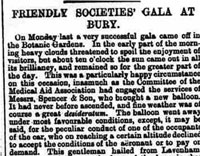
Friendly Societies Gala Balloon |
|
blank |
On 23rd July, 1888, the Friendly Societies Gala was held in the Abbey gardens and included Mr Spencer's new balloon which ascended with Spencer and two paying passengers. A report of the event can be read by clicking on the thumbnail adjacent. One passenger was W S Middleton, Clerk to the builder Lot Jackaman and a relation of his. The trip did not end until it landed seven miles south-east of Norwich. Jackaman had built himself a new house at 1 Westgate Street in 1884 and decorated the outside with examples of his stonework and plaques. After this epic balloon ride he added a small tile to the front lower left of the house showing a balloon with the year 1888 and the initials WSM. This plaque or tile can be seen elsewhere on this website, here:-
Miscellaneous plaques page 2
John Atterton of Haverhill received a patent for his lawn mower grinding machine and versions of this are still in use today. The local newspaper which would later become the Haverhill Echo was founded. It was called the South West Suffolk Echo until the 1960s. Around the same time the Haverhill Rovers Football Club was established. It was the second club in Haverhill, and they started to outdo the Haverhill Town Club. By 1900 the two clubs would have amalgamated under the Haverhill Rovers banner.
|
|
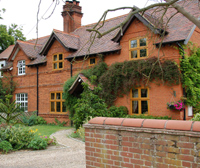
Cadogan's new estate houses |
|
1889
|
The great estate at Culford was sold by Richard Benyon Berens to the Fifth Earl of Cadogan. The Cadogans would own the estate until 1934. George was the 5th Earl of Cadogan of Chelsea House, Cadogan Place, in London. His property included the 200 acres of the Chelsea estate in London. Since the 1870s, George had redeveloped Chelsea into a fashionable collection of streets and squares, making a vast fortune in the process. He could now spend £250,000 on acquiring and improving the Culford Estate. This picture shows the characteristic red-brick style of his estate houses. It displays his interlocking CC motif and the date 1890. The two Cs stand for Cadogan and Chelsea.
|
|
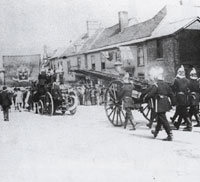
Alliance Insurance Fire Brigade |
|
blank |
Up to 1889 fire cover for the town of Bury St Edmunds was provided by the Alliance Insurance Company. The company owned two horse drawn fire engines with manually operated pumps. These were housed in Whiting Street, but extra fire hoses were also located at the police station, Eastgate Street, Northgate Street, and Southgate Street. On 11th January, 1889, the Bury St Edmunds Borough Council resolved to take over complete control of the town fire brigade. It would be 1899 before a new Borough Fire Station was equipped in the Shambles.
The Salvation Army Barracks was started in St John's Street in Bury. Land was bought at the bottom of the street, and the building project began. The Salvation Army came to Bury in March 1887, and set up its barracks, as it was called, on the corner of Honey Hill and Sparhawk Street. The two sisters Captain and Liutenant Newton soon raised the army to a size where a move was needed. On October 10th 1889 the first foundation stone was laid, and the building opened in the Spring of 1890.
With the legislation in place which could force a reluctant canal owner to bring the navigation up to proper standards at considerable cost, the owner of the Lark Navigation was willing to dispose of his asset, which had now become a potential liability to him. In June 1889, Mr F Woodbridge sold the Lark Navigation to the Marquis of Bristol and the Mayor of Bury St Edmunds for just £26.5.0.. They were acting on behalf of the new company which was in the process of being formed, to be called "The Eastern Counties Navigation and Transport Company Limited", or the "ECN & TCL", as their new lighters would soon be blazoned.
Things moved swiftly and improvements to the river Lark at Mildenhall began straight away in August 1889, as did the construction of the new wharf at St Saviours, in Bury St Edmunds. The dredging and canalisation of the river from Fornham Wharf to St Saviours had already begun in July 1889.
Plans were drawn up for a new bridge to carry the Fornham Road by the Tollgate Inn, and for a new lock just upstream of the bridge.
Despite all this progress on the river, the Eastern Counties Navigation and Transport Company Limited was only formally established in November 1889. This haste may have contributed to the disputes with the builders which erupted in the next two years.
In Haverhill the silk industry revived somewhat and Kipling and Co now rented part of the old silk factory from Attertons. A new Corn Exchange was built on Withersfield Road in Haverhill designed by Frank Whitmore. The site behind it was used as a livestock market.
The Old Independent Church in Haverhill received a new organ, presented by the Gurteen family in memory of old Daniel Gurteen who had died in 1884.
|
|
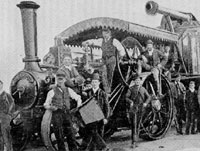
Burrell's first Showman's Engine |
|
blank |
The firm of Charles Burrell and son, of Thetford, took a decisive step in 1889 when the first showman's engine with fancy details attached was built for Jacob Studt, a famous showman of the day. Like most of the Showman's engines that would follow it, it was given a name, in this case it was "Monarch".
The picture shows it in action a few years later, and illustrates the enormous loads an engine would pull in a showman's Road Train.
|
|
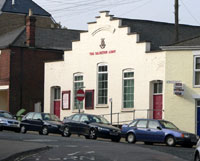
Salvation Army Citadel
|
|
1890
|
On March 21st 1890, the Salvation Army's new Citadel was opened at the bottom of St Johns Street in Bury St Edmunds. The building had cost £1,000. The Salvation Army was set up in London in 1878 by William Booth with the motto "Through Blood and Fire", epitomising his military and disciplined approach to Christianity.
Lord Bristol wanted to revive the Lark Navigation and had set up the Eastern Counties Transport and Navigation Company to revive James Lee's ideas of 30 years earlier. Much money was borrowed, the river dredged and straightened and an attempt was made to extend the Lark navigation into Bury St Edmunds itself. The new wharves were already being built behind St Saviour's Hospital ruins, where today's Tesco car park stands.
By May 1890 there were 200 navvies working on the river between the Babwell Staunch, which Howlett called the Old Clough, and the Tollgate Bridge. A new cut was made in a nearly direct line from the Fornham Maltings cut to the bridge, alongside the old course of the stream. A strip of land had been bought from Captain Ord of Fornham St Martin, to carry the cut and a towpath. Water was supplied from the old river, and also from the nearby Mermaid Pits. These were very old flooded pits which were also the source of a strong spring. Water from the Mermaid Pits was fed into the Lark just below the Old Clough, also known as Babwell Staunch.
By 1890 firms like Burrell's of Thetford, Garrett's of Leiston, and Savage of Kings Lynn, had brought the manufacture of traction engines to a high state of development. Other firms outside East Anglia were also building engines in works across the country. Perhaps the biggest and best known was Fowler's of Leeds. The period from 1890 to 1930 was the heyday of the traction engine. Powered by steam, with massive torque, they could take the road conditions of the time as well as pull the vast loads needed by Britain's heavy engineering factories. As their numbers grew, so did the numbers of accidents, and an accident in an engine could be much more serious than the equivalent horse drawn incident.
|
|
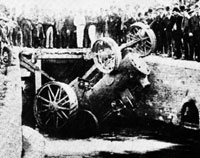
Sheepwash Bridge |
|
blank |
In June 1890, work was being undertaken to provide a new lock and a new bridge over the River Lark at the Tollgate Inn, just outside Bury. This was part of the work to extend the Lark Navigation from Fornham Wharf to a new wharf at St Saviours. Traffic had to be diverted via the Causeway Bridge, (now called Sheepwash Bridge), over the River Lark at Fornham All Saints. This was a wooden bridge which partly collapsed on 16th June 1890, when a traction engine tried to cross it, coming from Timworth to Bury. Thomas Newell, the driver of the two man crew was killed in the accident. They were employed by George Cornish, one of Bury St Edmunds' engineering firms.
By September the River Lark works contract of Gilmour and Wilson ended. They had removed three of the staunches, and converted one to a pound lock. The rest had been repaired. In addition, the Tuddenham Mill Stream had been dredged to allow navigation up to Tuddenham Mill. This work had required a new staunch to be installed on the mill stream.
Despite all that had been done, many people considered that it was obvious that the dredging was incomplete.
|
|
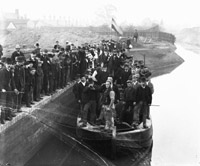
Opening St Saviour's Wharf, October 1890 |
|
blank |
In October 1890, an Opening Ceremony was held at St Saviour's Wharf to mark the opening of the waterway connecting Bury St Edmunds to Kings Lynn. A barge had been brought upriver from Kings Lynn to the Old Clough, which was more or less where the previous navigation had ended. On board were representatives of the canal contractors. These included James Wilson, the contractor, his son, J F Wilson, J C Gilmore, the Engineer, H Boreham, the Clerk of Works, and Mr J C Ford and Mr W Hooper.
The lighter was drawn up the new cut by horse power and towed through the new Tollgate Lock. It was drawn on to arrive for the ceremony at St Saviours Wharf. It only drew about 18 inches of water, so there was no difficulty with water levels.
St Saviour's Wharf was 100 feet long and 50 feet wide. W S Spanton photographed the proceedings, and it is clear from the photograph that the work was very far from complete. In fact the River could not be used fully until more work was done. The Navigation Company had to make money by using its barges on the fenland rivers below Mildenhall.
The Masonic Order bought the premises of the old Six Bells Inn in Chequer Square from the brewer, Greene King and Co., and it became the home of the local Masonic Lodges. There were two lodges in the town, the Royal St Edmund, and the Abbey. The inn had closed in 1885. The Six Bells had been a great coaching inn in its heyday of 1818 to about 1860, but it then deteriorated in both business and conduct until its final demise.
|
|
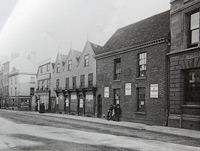
Shops due for demolition |
|
blank |
In 1890 Harry Isaac Jarman joined the firm of John Palmer Clarke as an apprentice photographer. In 1901 he would take over William Spanton's photographic business. Several of the photographs included here were taken by this firm, and the collection of pictures is now held by the Bury St Edmunds Past and Present Society as the "Spanton Jarman Collection". Here we see two shops at the top of Abbeygate Street due for demolition which would be replaced by the splendid new building of the Sun Alliance Insurance Company. Mr R Kidson was a taylor and habit maker and Mr T Cross was a seed merchant and nurseryman. Both shops would relocate elsewhere and display posters announcing their relocation. Just visible on the right is the National Provincial Bank building of 1868.
Around 1890 Edward Lake started the Greene King private Fire Brigade. This enterprise was part of the company's insurance against fire. Greene King did not like to pay premiums to insurance companies, and instead held financial reserves to deal with any losses from fire. These risks were minimised, it was felt, by training a team of their own men to deal with fires. Over the years the Fire Brigade would be improved until it was routinely called in to assist the Municipal Brigade around the town.
Under the Electric Lighting Act of 1882, private companies, as well as Councils, were empowered to set up their own electricity undertakings for their own use and for resale.
At the Greene King Brewery in Bury St Edmunds, Edward Lake had proposed just such a course of action during 1890, but he was over ruled by the Board. No doubt he carried on his enthusiasm for electricity into his Council work. Lake had been a councillor since 1883, would become Mayor in both 1892 and 1896, and had considerable influence on the Town Council.
In 1890 Thomas Arnold published the first of his three volumes entitled "Memorials of St. Edmund's Abbey". Volume One contained reprints of the following documents: - 'The Passion of St. Edmund' by Abbo of Fleury, c. 1000;
- 'The Miracles of St. Edmund' by Archdeacon Herman, c. 1095;
- 'The Infancy of St. Edmund' by Geoffrey de Fontibus, c. 1150;
- 'The Miracles of St. Edmund' by Abbot Samson, c. 1190;
- Jocelyn's Chronicle, 1182-1211.
Whitmore's Timber Yard was a familiar name and sight to people living in Bury St Edmunds before 1972. The firm's website suggests that it originated in 1890, founded by T.G.Whitmore, but at this time Whitmore was originally a blacksmith and wheelwright. In the Suffolk Directory for 1900, there were two Whitmores listed as Smiths, namely:
- Whitmore James C. and Son,Out Northgate
& St. Andrew's st. north, Bury;
- Whitmore James Caney,Higham,Bury
The site at Out Northgate may well be the same site on which the timber yard began. In 1900 Austin Whitmore, son of T.G.Whitmore, started milling home grown round logs, and from here grew the massive business which would be bought up as part of the by-pass in 1972. Part of Whitmore's Yard is covered by Tesco's Supermarket today.
By 1890 the Bury Alexandra Football Team was established. The existing Bury St Edmunds FC had changed its name to Bury Town FC in September 1885, but by 1890 the Alexandra had been set up "for the sole purpose of giving a certain class of members the chance of getting some match play which they could not get while members of the town club." (Letter to Bury and Norwich Post 13th October, 1891.) This was not a wholly amicable arrangement. The new club would become top of the league in 1894/95, and 1895/96.
|
|
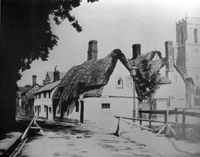
Haverhill Market Hill
|
|
blank |
In the 1880's and 1890's Haverhill's streets were edged with cast iron kerbing brought from Wellingborough. Some still remained in Quakers' Lane until recently. This view of work on the Market Hill dates from 1890, and may even show the new kerbing being installed on the left hand edge of the picture. These houses were all swept away in the late 20th century to make Market Hill an open square once again.
By 1890 the Haverhill Choral Society was widely known and for its concert in this year special trains were laid on along the Colne Valley Line from Halstead.
The Haverhill North railway station was well used but Station Road and the yard in front of the station was unpaved and knee deep in mud in winter. It was as late as 1890 before even a cobbled and brick path was laid to the booking hall entrance. The rest remained as mud.
The Gurteen family of Haverhill were non-conformist in religious belief, and in 1890 they laid the foundation stone for Haverhill's Congregational School. The whole family were active in the religious, social and political life of the town.
Haverhill in Massachusetts held a celebration to mark 250 years of settlement there. Haverhill, Suffolk was represented by the Chairman of the Local Board, who was a Gurteen.
|
|
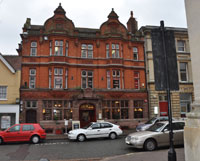
Alliance Assurance Office
|
|
1891
|
The winter of 1890 / 1891 was described in the Suffolk & Essex Free Press as the coldest winter on record. In January, the paper reported people skating on the Gipping from Bramford to Stowmarket. Passengers on a train from Haverhill to Long Melford found themselves stranded when the brakes froze at Clare when the train stopped to take on water. March of that year was marked by tempests and snowstorms across the whole country. The Suffolk & Essex Free Press reported damage across Suffolk from Hurricane Force winds, deep snow and wrecks grounded all along the East coast.
The winter of 1890 / 1891 endured a prolonged frost of 59 days, which caused a high death rate amongst birds like Song thrushes and Mistle Thrushes. Even the Redwings and Fieldfares, which normally wintered here from Scandinavia, had to leave this country and travel further south for better fare.
In 1891 the elaborate red brick Dutch style building, now occupied by Cafe Rouge, was built at the top of Abbeygate Street in Bury. The architect was John Shewell Corder of Ipswich. It was built for the Alliance Assurance Company, which was founded in 1824, and was later to become the Sun Alliance Company. Up until 1889 the company had kept two fire engines in Bury St Edmunds, stored in Whiting Street, but since then the Borough Council had taken over the Fire Brigade.
The new Mayor from November 1891 was George Cornish, the Iron Founder. His father's foundry had been established in Bury St Edmunds by 1841. When George took over, his new Risbygate foundry was set up in 1865, and was located in Risbygate Street, and would still be trading as Cornish and Lloyd into the 1960s.
Edward Greene, MP, who had owned Greene's brewery in Westgate Street since 1836, and had been the first Chairman of Greene King since 1887, now died.
|
|
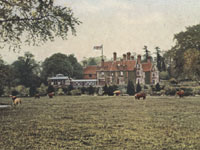
Nether hall, Pakenham
|
|
blank |
His son, Edward Walter Greene, now took over the Chairmanship of the Company as well as the house at Nether Hall Estate, lying in Thurston and Pakenham. Edward Walter was always known as Walter, and used this as his first name.
Walter was invited to fight the by-election for North West Suffolk, which arose on his father's death. To everybody's surprise,
he narrowly lost this election to Viscount Sydney de Stern, another millionaire.
Walter now extensively modernised and improved Nether Hall. In 1891 and 1892 he had a large lake built through the winter. He would soon only be in residence from September to March, for racing at Newmarket, hunting and shooting. The rest of the year he spent in Scotland, Monte Carlo, Cowes, and the other fashionable haunts of the rich.
Despite this lifestyle, he was a great patron of Thurston Church, and Pakenham's Tin Tabernacle.
|
|
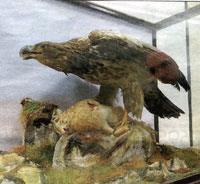
Sea Eagle shot at Rushbrooke
|
|
blank |
This white tailed sea eagle was shot on the Rushbrooke estate on December 31st, 1891. It was believed to have been driven from Scotland in the great storm of December, 1891, and had been seen around Bury St Edmunds for some weeks living on game birds and hares. Cecil Nunn, the Rushbrooke land agent, chased the bird from a field owned by the feoffees at Bury up to Moreton Hall on land owned by the Eyres. From there to Hon Hill, Rushbrooke, and then to Rougham Heath. From there he pursued it to Rushbrooke Rectory, to Water Cottages and then to Rushbrooke Park. It was finally shot at The Clump on that estate. The mounted juvenile bird was sold to Moyse's Hall Museum in 1952.
Despite the high hopes of 1890, for the whole of 1891 the Lark Navigation remained closed to traffic between Mildenhall and Bury St Edmunds. The ECN & TCL had to concentrate upon the river stretches which had already been in operation prior to its formation. They were forced to compete with any existing operators on the Great Ouse, the Cam and the Lark from Mildenhall to KIngs Lynn.
|
|

Rail crash 1891
|
|
blank |
The railway system was also not without its difficulties. There was a derailment between Long Melford and Lavenham on 17 October 1891. The Long Melford to Bury St Edmunds line was opened on 9th August 1865. In 1891 A passenger train which was passing between Bury and Melford and travelling at a high rate left the rails about two miles from Melford near Lineage Wood where the line has a sharp curve also a decline of 1 in 110. The engine without warning left the line turning a complete somersault and fell funnel downwards some 60 yards into the field. The Brake with the other carriages except a horse box left the metals and plunged down the embankment and capsizing on to their sides. The fearful jolting threw driver Harvey and his fireman from the footplate and doubtless saved their lives. The cause is not absolutely certain but it is believed a heavy storm shifted some ballast on the line causing the rail to move. The engine is a No 169 known as a tank engine and was running head foremost.
The official report on the railway accident on the Bury Melford line was issued by the Board of Trade in January 1892. Eight passengers were injured, two seriously, the driver and the guard. The Inspector attributed the accident not to the permanent way which was in good order but to the character of the engine which was one of a class that runs unsteadily when the chimney is in front and it is desirable and that the balance weights on the leading and driving wheels must be restored. Drivers must be specially cautious and not to run at high speed when the chimney is in front.
The 1891 Elementary Education Act provided for the state payment of school fees up to ten shillings per head, making primary education free. This Act effectively introduced free elementary education for all by requiring central government to pay a 'fee grant' of ten shillings (50p) a year for each child between the ages of 3 and 15 and by prohibiting the charging of other fees in elementary schools.
At Lavenham the old Sugar Beet processing factory in Lower Road was standing idle. It was built in 1868 by James Duncan, of London, but production was ended in 1871 because of cheaper foreign cane sugar imports. It reopened under the new owners Bolton and Co., in 1885, but soon closed again. Roper's already had three coconut matting and horsehair factories in Lavenham, but, in 1891, they bought the old sugar factory intending to make crinolines there. In the event this never happened, but they used the premises as a store for finished products until it was burnt down in 1905.
Haverhill's West End Congregational Church was built on Withersfield Road to house the growing Sunday School and congregation of the Market Hill Chapel. It could hold about 450 people. Market Hill chapel became Chapman's shop in the late 20th century. By the 1890's most of the terraced houses that were to form the majority of Haverhill's homes were
built. Eden Road, Waveney Terrace, Duddery Road, Mount Road and Withersfield Road all date from this period. In January 1891 there was great excitement in Haverhill, Suffolk, when a shield of friendship was presented to the town by the town of Haverhill, Massachusetts, USA.
In 1891 the Haverhill North railway station was given a footbridge over the railway line and steps built down to Wratting Road.
|
|
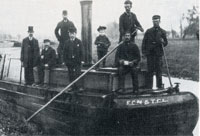
Directors welcome first gang of barges |
|
1892
|
In January 1892 the contractors for the Lark Navigation improvement works were forced to resume work on the river, following the decision of the Court of Appeal. It took another 10 months before river traffic could reach Bury St Edmunds.
Not until October, 1892 was the new wharf on the River Lark at St Saviours finally able to receive its first consignments of goods. The first gang of six barges were welcomed to Bury by Lord Francis Hervey, Mr George Cornish, the Mayor of Bury St Edmunds, Mr H C Bunbury, Mr Manners, and Mr Thomas, the company's manager. These six barges carried mainly granite, amounting to about 100 tons.
The photograph shows the welcoming party on board the steam barge which towed the six lighters. Lord Bristol is seen in his top-hat. The steam barge had difficulty being steered on the narrow river, and was a problem in the locks, and it is most likely that this was the only occasion upon which a steam barge was used to reach Bury St Edmunds. Although good trade was done, the company was never profitable following the long delays.
As if the company did not have enough financial worries, worse was to come on Monday October 31st, 1892. Following heavy rains, the water level was high. However, the old problem of the Ickworth Park lake struck again. The water level rose so high that a deluge flowed down the river Linnet, flooded the Holywater Meadows by the Spread Eagle inn, and on into the Lark. The whole of the Tollgate inn side of the brand new Tollgate lock caved in, taking with it the gates on that side. Traffic to Bury once again had to halt until repairs costing £100 could be carried out. The Navigation company would be bankrupt inside two years.
A new police station was built in St Johns Street in Bury to replace the cramped quarters in Moyse's Hall. The purpose built police station was designed by Frank Whitmore, and the builders were Everett and Sons of Colchester. It cost £7,000 and had seven cells on the ground floor and another seven on the first floor. It included living quarters for police personnel and a charge room for occasional petty sessions. The new station was in use until around 1969 when the occupants moved to the new station in Raingate Street, which had been open since 1966. The small street called Sergeants Walk was created with the opening of the new library in 1983, and remains as a reminder of former times.
|
|
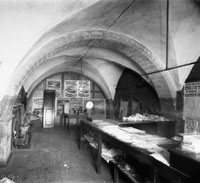
Great Eastern Parcels Office
Moyse's Hall |
|
blank |
After Moyses Hall ceased to be used as the Police Station in 1892, the Great Eastern Railway rented it for use as as their parcel and enquiry office.
From 1892 to 1898 Moyse's Hall continued as a railway parcels office, but clearly its uses were becoming more and more limited and restricted as part of the holdings of the Guildhall Feoffment Charity.
This picture, from the Spanton-Jarman Collection at Bury St Edmunds Record Office, shows how Moyse's Hall looked during this period. The picture shows posters advertising railway excursions, displays of railway timetables, and a distribution table for packets and parcels. Although it was a convenient town centre location, the building was quite unsuited to use by a modern business, and was not well maintained. The Guildhall Feoffees, who were the owners, grappled with the problem of a suitable use, even considering it as a depot for the local Fire Brigade. However, use would continue as a parcels office until 1899 when it would become the Moyse's Hall Museum.
The Savings Bank, located alongside the Norman Tower, closed its doors as a bank in 1892. Although often referred to as the Penny bank, it was properly called the Savings Bank.
|
|

New East Anglian School |
|
blank |
The East Anglian Methodists Boys School moved to Northgate Avenue to gain space. They took over Highland House, which had been the home of Thomas Norfolk, after whom Norfolk Road was named. In the 1930's the boys would move to Culford, and this site would become a girls school. By 2005 the whole site in Northgate Avenue was becoming redeveloped as housing.
|
|
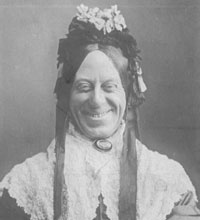
Charley's Aunt postcard |
|
blank |
One of the Theatre Royal's claims to fame is that the premiere of the play 'Charley's Aunt' was performed here. In 1892 Theatre Royal staged the world premiere of the play Charley’s Aunt, written by Brandon Thomas and starring W.S Penley. The idea was to test the play in front of a provincial audience before launching it on the London stage. The show was an immediate success and went on to take London by storm – it was translated into numerous languages, souvenirs were produced and to date three film versions have been made.
Rose Mead returned to Bury from Westminster School of Art to nurse her sick father. In 1895 he died and she went to Paris to pursue tuition in her chosen field of painting. In 1896 she went to London, and returned to Bury in 1897 to nurse her mother.
|
|
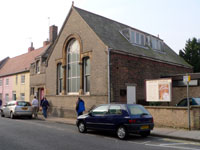
Baptist Sunday School |
|
blank |
The Baptist Church in Garland Street had run a Sunday School since 1824. A fine building was erected opposite the Baptist Church to house the Sunday School. A memorial plaque was laid by James Stiff, who now lived in London, but who had once attended the Sunday School.
The play "Charley's Aunt" had its debut at the Theatre Royal in Bury during 1892.Subsequently this play went on to be popular worldwide. At one time it was being performed simultaneously in 48 theatres across the world in 22 languages. Within 30 years the Theatre Royal would shut its doors.
In 1892 it is thought that William H. Montgomery set up his bicycle shop at number 6 Brentgovel Street, Bury St Edmunds. Montgomery and Company would carry on business at this location until 1911, but by the early 1900s he would turn more and more to involvement in motor cycles. At first he would become known for manufacturing motor cycle sidecars. In 1911 the firm would move to Coventry where they would establish themselves as a well known maker of the super bikes of the day, such as the
1924 Montgomery-Anzani 1000cc V-Twin.
|
|
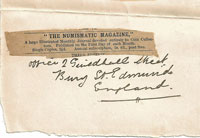
C H Nunn's coin magazine |
|
blank |
In 1892 C H Nunn of 2 Guildhall Street, was already advertising himself as a Philatelic Publisher. By 1892 he was branching out into the Coin Collecting field as well. Attached is the advertising copy that he sent to certain publications to proclaim his new title, "The Numismatic Magazine". This would be published on the first day of each month at a subscription of 2s 6d a year or tuppence ha'penny for a single copy.
The Royal Commission on Labour visited Chevington and surrounds to see the state of the workers and their wages. The agricultural slump had resulted in a loss of jobs and also cuts in wages so that men had to work from light to dark and could be sent home in bad weather, losing a day's pay. In 1893 the Commission reported that housing largely provided by the Ickworth estate was satisfactory, in good repair with good gardens and closets. However, the water supply was inadequate. There were two wells near the school and no more for a mile. Many people got their water from ponds or ditches, but it was felt that this was not so bad, because no one had to go more than a quarter of a mile to find it!
The Commission also reported that a good many men belong to the local Lodge of the Ancient Order of Shepherds. This was the main friendly society in the local country area.
|
|
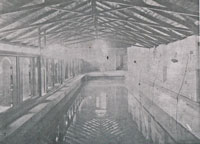
Jackaman's pool taken over by Council
|
|
1893
|
In 1870 the well known local builder, William Lot Jackaman, had built a covered in Swimming Bath at the top of Maynewater Lane. In 1893 the Pool was taken over by the Bury Town Corporation. Later it was acquired by the Greene King brewery, and was a private pool for their employees. The house known as Bath Cottage, built for his Baths Supervisor is still there today, but the pool is no more.
Both the Guildhall and Moyse's Hall were to be handed over to Bury Borough Council by the Feoffment Trust, who could no longer justify their upkeep. The intention was to shed them completely, but the Scheme made by the Charity Commissioners vested the premises in the Official Custodian for Charities.
The Fire Brigade made some use of Moyse's Hall around this time, but its vaulting could not accommodate their appliances. Something needed to be done.
|
|
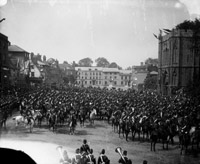
Loyal Suffolk Hussars |
|
blank |
The Suffolk Yeomanry, now called the Royal Suffolk Hussars, held a great centenary parade on the Angel Hill, where they were reviewed by the Duke of York, who would later become King George V. The Duke accepted the post of Colonel of the Regiment and now granted them the title of Duke of York's Own Loyal Suffolk Hussars. The successors to this regiment are today part of the Territorial Army.
In around 1895 the Ten Bells beerhouse at 33 Whiting Street was renamed the Duke of York in his honour.
|
|
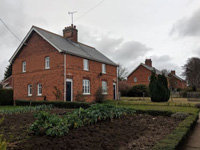
Stow Road Ixworth |
|
blank |
Although the rural sanitary authorities were shortly to be abolished, the Thingoe Rural Sanitary Authority made history by being the first rural authority in the country to build municipal housing. This was at Stow Road in Ixworth where 8 houses were built for a tender price of £1,300. Neither Bury nor Haverhill Corporations were to build council housing until the twentieth century.
This breakthrough was not achieved without a struggle, which was led by the radical local vicar, the Reverend Frank Duerdin Perrott, who came to the village in 1888. Much of what follows comes from the Blog Municipal Dreams by John Boughton.
The local lord of the manor, Captain RN Cartwright, was an opponent of the new housing and owner of three quarters of the parish’s 1700 acres and 14 of its run-down cottages. Perrott had earlier attacked Cartwright for evicting an elderly widow in order to house an estate worker, and was appalled by the state of housing in the village.
One of the vicar's first acts in 1891 was to help form the Ixworth Agricultural Labourers’ Association. The Association surveyed local housing needs – both the sorry condition of existing homes and the desperate need for new – and petitioned the local Rural Sanitary Authority (the Thingoe Board of Guardians at this time) to take action under the 1890 Housing of the Working Classes Act.
The Sanitary Authority responded by evicting existing tenants under Part II of the Act addressing unfit accommodation. Perrott and the Association held public meetings to halt these evictions and press for action under Part III of the Act, permitting the building of replacement new homes. Reluctantly, the Authority asked the Local Government Board to organise a local inquiry which could compel – if the need were proven – the County Council to grant the permission Thingoe needed to adopt Part III.
The Inquiry was chaired by Lord Francis Hervey, the local Conservative MP who concluded the case was clearly proven. Unfortunately it appeared that Ixworth parish would bear the cost rather than the whole of the Thingoe area. This led to another enquiry under Colonel Frederick Pocklington, which overturned the decision of the Hervey enquiry. Lord Francis then obtained a legal opinion which overturned the Pocklington decision, and Thingoe Sanitary Authority was compelled to go ahead with the new homes.
Elections to the Authority in 1892 returned a reforming majority and Perrott (now as its Chairman) served for one meeting to secure the housing’s final go-ahead. The Reverend Perrott left Thingoe in the year of victory, 1892, and resigned from the priesthood four years late. Re-qualified as a barrister, he remained active for some years as a campaigner for housing reform.
Numbers 1 and 2 Stow Road were granted grade II listed status in 1998. The listing reads as follows:
"Pair of council houses. Designed 1892, built 1893-1894 by Mr Whitmore, the Suffolk County Surveyor, for Thingoe Rural District Council. Red brick, slate roofs with ridge
crest. Central shared stack.
Two-storied semi-detached pairs with rear single storey back kitchen/wash house and lavatory. Timber casement windows under arched brick heads, timber doors under toplight. Single sill band to first floor. Interiors not inspected.
One of four pairs of houses understood to be the first rural council housing built in England, under the Housing of the Working Classes Act 1890, and surviving in little-altered condition. The 1890 Act was the first to permit local authorities to acquire and develop land for housing but was adopted by just eight rural authorities, despite increasing recognition that agricultural labourers endured housing conditions every bit as bad as those of the inner cities. "
Greene King experimented with delivering beer to Stowmarket and Haverhill by Traction Engine. The trial was abandoned.
Prince Duleep Singh, who was once the owner of Elveden Hall, died in Paris. His son, the Prince Frederick, loved living in England, and brought his father's body back to Elveden, where it was buried in the church.
|
|
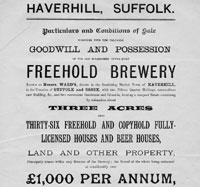
Sale of Ward's Brewery
|
|
1894
|
In January 1894 William Ward auctioned off the Haverhill Brewery with 36 pubs tied to it covering an area as wide as Castle Hedingham, Saffron Walden, Fulbourn and Swaffham Bulbeck. It had been established in the 1840s. William Ward was the owner by 1885. At this sale in 1894 the brewery was bought by Frederick Charles Christmas for £29,100, and on his death in 1918 the brewery and 49 public houses would be sold to Greene King & Sons Ltd. It occupied buildings on both sides of Camps Road and Upper Downs Slade, and the main building has become better known as a laundry in recent years.
Gurteen's built a new factory in Haverhill for its coco matting production which had grown apace since 1886. However in 1893 and 1894, both Gurteens who had led this expansionary period since 1856, were to die. The firm passed to another Daniel and his brothers William and Jabez Gurteen. At this time, Gurteens employed 7-800 people at Haverhill.
Crampton's Almanac for 1894, contrasted the condition of Haverhill in 1894, one of prosperity, with the poverty of the 1850's. It also praised the rural location, and the town's main employer;
"The Haverhill people (are) enjoying the purity of the country air combined with all the advantages to be obtained by the inhabitants of a large town. That Haverhill combines these advantages is due to the Gurteens."
By March, on the River Lark at Fornham All Saints, a new iron bridge had been erected by the West Suffolk County Council. This replaced the old wooden Causeway Bridge which had partly collapsed under the weight of a traction engine in 1890. By at least 1955 the Ordnance Survey maps called this Sheepwash Bridge.
On the river itself, barge traffic was as low as one gang of barges a week passing up to Bury St Edmunds. As for the Eastern Counties Navigation and Transport Company, it was in deep financial trouble. On 7th December 1894, a receiver was appointed by the Chancery Division of the High Court. He was Mr Bevan, the local banker who had issued the writ. A few days later the business was handed to a new Receiver, Charles Baker, an accountant. He was to try to run the business until April 1895.
In May 1894 the Guildhall and Moyses Hall were all officially handed over to Bury St Edmunds Council by the Guldhall Feoffees. Both parties regarded this as a full and final transfer, without any restriction on their future use, but in later years it was found that the Charity Commissioners had agreed only to a partial transfer of rights of usage.
According to Kelly's Directory of Suffolk for 1900, in 1894 the town of Bury St Edmunds was completely
resewered, at a cost of £42,000, under the supervision
of Mr. James Campbell Smith A.M.I.C.E. Borough
Engineer. The new sewers, like the old, were connected to the Sewage Farm at West Stow, established nine years earlier.
|
|
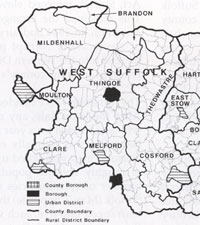
Rural and Urban District Councils 1894 |
|
blank |
Urban and Rural District Councils were set up by the Local Government Act of 1894. This resulted in the establishment of Clare RDC, Thingoe RDC and Haverhill UDC, which in 1974 would become St Edmundsbury Borough Council, with the addition of Bury St Edmunds Borough Council.
In addition Parish Councils were instituted to replace the Vestries, which were now abolished by the Act. There would now be elected parish councils in all rural civil parishes with more than 300 electors. These were grouped into the rural districts.
The UDC's and RDC's were replaced in 1974, but Parish Councils still flourish in 2005.
The Urban Sanitary Authorities were now abolished, so in Bury, all sanitary functions were transferred to the Corporation. Bury Borough Council now took on the powers of an Urban District Council, but retained the ceremonial status of a Borough. Similarly, the rural sanitary authorities were abolished, and so the Thingoe Rural Sanitary Authority was also a casualty, all its powers passing to Thingoe RDC. The Brandon RDC was also set up as part of West Suffolk, but in 1935 would become part of Thingoe RDC.
The Thingoe RDC surrounded the town of Bury, and retained the ancient name of Thingoe. In pre-abbey days, the Thingoe Hundred had included the administration of Bedericsworth, but when King Cnut had founded the abbey, he had given the town an independent existence, ruled over by the abbey convent. The name Thingoe means the Hill of the Council, and Thingoe hill stood outside the North Gate of old Bury, where Northgate Avenue is today. Like its predecessor authority, Thingoe was to remain one of the most energetic and development minded RDC's in the country.
The first Chairman of Thingoe RDC was Robert Burrell of Westley, who held that office until 1912. The first meeting of the original 46 parishes was held in the Union Workhouse, but subsequently its meetings were held in the Guildhall at Bury until 1946.
The defining difference between an urban district and a rural district was that an urban district usually contained a single parish, while a rural district would contain many. Urban districts were considered to have more problems with public health than rural areas, and so urban district councils had more funding, and more powers than their corresponding rural districts.
Urban districts usually covered smaller towns, usually with populations of less than 30,000.
One of the smallest Urban Districts set up by the 1894 Act was Glemsford UDC, which was surrounded by the Rural District Council of Melford. In the 1891 census Glemsford had a population of 2,458 and had several factories employing this workforce covering silk weaving, horsehair weaving, and coconut matting production. Even as soon as 1901 its population would fall to 2,016, and under the boundary adjustments of the 1930s it would become a part of Melford RDC in 1935. By 1951 Glemsford would shrink to 1,353 persons, and would fall into insignificance compared to its relative importance in the 19th century.
Setting up the boundaries of the new structure was a complicated business as every parish, RDC and UDC was to fall wholly within an administrative county. This had not been the case hitherto with unions and sanitary bodies not infrequently overlapping county boundaries. Each county council had to settle the new boundaries and so the process took a year or two. Glemsford UDC started its formal life in 1896 for example.
At Culford, Earl Cadogan was in the process of enlarging the Culford Hall.
By 1894 Thomas Arnold had published the second volume of his work "Memorials of St. Edmund's Abbey". Volume ii contained the following manuscripts:
- An anonymous chronicle, breaking off 1212;
- Three narratives of the elections of abbots in 1215, 1257, and 1302 respectively;
- A French metrical biography of St. Edmund by Denis Piramus;
- An account of the expulsion of the Grey Friars from Bury in 1257 and 1263;
- The story of the Great Riots of 1327;
- Building Acts of the Sacrists from 1065 to 1200.
|
|
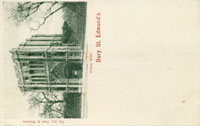
Postcard format 1894-1902 |
|
blank |
Plain postcards, with a pre-printed stamp, were introduced by the Post Office in 1870. The address was on one side, and a brief message was allowed on the other. From 1 September 1894, the Post Office allowed postcards published by others to be posted. A halfpenny adhesive stamp was to be added to these cards before posting.
Several manufacturers produced cards. The first publisher to include pictures on the cards is believed to have been George Stewart of 92 George Street, Edinburgh.
These early cards had the address on one side, and the message and the picture were on the other side. The format which we know today did not arrive until 1902.
This postcard of the Abbey Gate in Bury, published by Paul and Mathew, illustrates how the picture and the sender's message had to share one side of the card before 1902. The other side was strictly reserved for the words "Post Card" and the address and the stamp only. This format was a start for the industry, but postcard use and collecting did not take off until after the rules were changed in 1902. It is clear from this example that the picture fails to have much impact at the restricted size allowed in 1894.
|
|
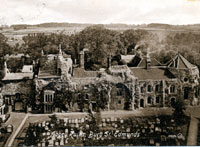 West Front dwellings, 1890s
West Front dwellings, 1890s
|
|
1895
|
Once picture postcards could be sent after 1894, old established printing firms like Valentine's of Dundee, decided to take advantage of the idea. James Valentine was already an experienced photographer, with a stock of negatives, but soon he would travel across the country to gather pictures to turn into postcards. Once he had the picture he realised that old negatives could be re-issued many times, and it is thus very hard to date a picture from date of manufacture of the postcard. Luckily, James Valentine had a numbering system for his negatives, and this one is 23688, which indicates that this view of the West Front of the Abbey was taken in the 1890s. At this time the picture could only take up half of one side of a postcard, sharing it with the message. However, the format of this particular postcard means that it was made after 1902, when the view was allowed to fill one whole side of the card. In addition, this card has been sent through the post, and is postmarked 14th May, 1917. However, in order to sell, the view must still have looked much the same as in the 1890s.
|
|
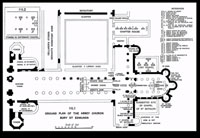
M R James' plan of the Abbey church |
|
blank |
In 1895 M R James published his work entitled "On the Abbey of St Edmund at Bury". It was published by the Cambridge Antiquarian Society, as Monty James was a Don at King's College, Cambridge, at the time. His home was at the Rectory in Great Livermere, although he would spend most of his time in Cambridge, and many of the manuscripts referred to in his book were located at Cambridge Colleges.
The work was divided into two sections. The first section was on the Library of the Abbey at Bury, and the second was on the great Abbey Church. James described the foundation of the abbey's book collections, the building of the library in about 1430, and listed every book that it was known to contain.
The description of the Abbey Church was taken from a Bury Register which James discovered in Douai, in France, and was a full description of the building and its features in the 15th century. The Register was from Bury Abbey, and had been owned by the English College in Douai until the French Revolution. By 1895 it was to be found in the Public Library in Douai. M R James' work was the first to identify the locations of the graves of the abbots, and promoted the idea of excavations to verify the grave sites. This book and the plan he produced led directly to the excavations of 1901.
The Bury Borough Council agreed to apply the money it received from the Feoffment Trust back to the maintenance of the Feoffment Schools, in order to secure their future, as the Trust's finances were not enough to run them unaided.
|
|
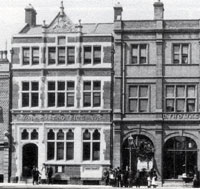
General Post Office built 1895 |
|
blank |
The Post Office on the Cornhill was pretty well finished by 1895, with Queen Victoria's coat of arms on its gable. It is still part of the street scene today. Until then the Post Office had been in the premises of today's Barclay's Bank, at 52 Abbeygate Street. The passage down the side of the new Post Office was called Bell Arcade in memory of the Bell Hotel which had formerly stood on the site. Nowadays it is called Market Thoroughfare, and became controversial in the early 2000s as the main access to the shopping area known as the arc, on the old Cattle Market carpark site. The new post office opened for business in 1896.
The Bell Hotel had been sold to the Postmaster General in 1880, although it still sold beer for a year or two afterwards. A large part of the site was sold on to make the shop of Thomas and Marston shown here, and only a small part was retained to house the new Post Office.
|
|
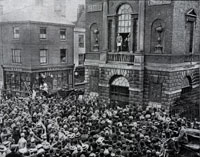
Declaring the Poll 1895 |
|
blank |
This photograph was published in the Sketch periodical of July 31st, 1895. It is a fine photograph by J Palmer Clarke, a Bury photographer, who had his studio at 7, Angel Hill, also moving to 31 Abbeygate Street. He also had a studio situated in Post Office Terrace, Cambridge, which was in business from the 1890s to the 1930s. For a few years he worked in both Bury and Cambridge. In 1903 he would move permanently to Cambridge, leaving his Bury negative stock to H I Jarman. John Palmer Clarke was the son of John William Clarke, who started the photographic business in Kings Road, Bury St Edmunds at least by 1875. J W Clarke variously produced work at two Angel Hill addresses, (7 and 28), two Abbeygate Street addresses, (31 and 41), in Whiting Street and at 3, Meat Market.
This picture shows the declaration of poll for the Stowmarket Division of North West Suffolk, when the winner was Mr Ian Malcolm, Conservative, with 5,144 votes to Mr H de R Walker, a Liberal, who polled just 3,701 votes. The result was declared, as we can see here, from the window of the Town Hall, overlooking the Buttermarket, in Bury St Edmunds. The count was declared on July 19th. The constituency of Stowmarket was created for the 1885 general election, and abolished by the 1918 general election. Ian Zachary Malcolm (1868 – 1944) was 17th Laird of Poltalloch, was a Conservative and Chieftain of the Clan Malcolm/MacCallum. He was MP for Stowmarket from 1895 to 1906, and created KCMG in 1919. In 1902 he would marry Jeanne Langtry, the daughter of Lillie Langtry.
The Railway Mission was a charity founded in 1881 to bring the Gospel to people working on the railways. The railways employed thousands of men who often had to work during normal church hours. In 1895, local railwaymen approached Mrs Arthur Ridley, about starting a local branch of the railway mission in Bury St Edmunds. Mrs Ridley was a widow, and a Congregationalist from the Northgate Street Chapel, and she began by leading services at the station. A committee was formed, called the Mission Band, and the Station Master, a Mr Cook, made premises available to them. Mrs Ridley was made the local Superintendent of the Mission.
From 1895 until 1900, a room in the Station Master's house by the Northgate railway station in Bury St Edmunds would be used as the mission to railwaymen who worked on the Bury line. Soon the services attracted the workers' wives and children, and activities were organised for them.
By 1900 the number grew so much that the Railway Mission Hall was built on Fornham Road, just past the railway bridge.
|
|
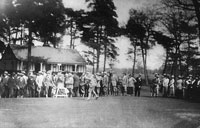
Flempton golfcourse in 1922 |
|
blank |
Even golf clubs can have their own foundation myths. Omar James-Johnson has recorded that legend has it “Scottish Officers from the Depot Barracks being homesick and looking for somewhere to hit a golf ball had chanced upon Flempton as the ideal spot to enjoy a few hours of leisure.” Club records do not support this legend.
It was in 1895 that a group of local people formed the Flempton Golf Club. At the time the only other golf club in West Suffolk was the newly made Royal Worlington and Newmarket Golf Club, located at Worlington, just south west of Mildenhall. The original subscribers for Flempton included nine clergymen and twelve ladies, paying a subscription of one shilling a month. There is a story that the course itself had first been played by officers from the Gibraltar Barracks in Bury, but the club itself definitely rented the Golf Ground from the farmer, J M Rutterford of Hall Farm, in December 1895. The original course was 2070 yards, covering 34 acres, which would gain another 12 acres in 1906. Rutterford's 350 acre farm was part of the Hengrave Estate.
In 1896 the club acquired an old railway carriage as a clubhouse. The clubhouse in this picture dates from 1905.
|
|
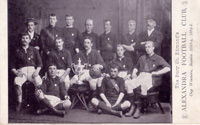
Bury Alexandra FC |
|
blank |
By September 1895 the Bury Town FC had suffered a couple of seasons when their rivals, the Bury Alexandra FC, had been top of the league. In September 1895, the Bury Town club decided to revert to their original name of the Bury St Edmunds FC, perhaps hoping to change their luck. This picture of the Alexandra club is an F G Pawsey promotional postcard, supplied by Bob Pawsey. F G Pawsey himself was Treasurer of the Alexandra, and is seen in the straw boater. The card itself must date to after 1903.
Fred King, part owner of the Greene King brewery, had been living and farming at Rushford Lodge since 1880, on the Norfolk border. In 1895 he bought 5 and 6 St Mary's Square in Bury, and moved back to town. He lived here until his death in 1917.
Sir Edward Bunbury, 9th baronet, lord of the manors of Mildenhall and Great Barton, died in March 1895, aged 83. He never married and was succeeded in the baronetcy by his nephew, Sir Henry Charles John Bunbury, 10th baronet (1855-1930). Sir Henry moved into Great Barton Hall, as had all previous lords of the manor, but would leave it in 1900, to take up residence in Mildenhall.
Hengrave Hall had been for many years in the ownership of the Gage family, following Penelope Darcy’s marriage to Sir John Gage, 1st Baronet. The house had for a time been used as a refuge by the English Augustinian Canonesses of Bruges from 1794–1802, led by their Prioress Mother Mary More where the Canonesses ran a school. In 1887, on the death of Lady Henrietta Gage, the house was bought by John Lysaght, one of the founders of the Australian steel industry. In 1895 it was bought by Sir John Wood, who found the Hall considerably run down.
Sir John Wood was born in September, 1857, at Whitfield in Derbyshire. He graduated from Magdalen College, Oxford University in 1883 with a Master of Arts degree. He was a practising barrister and held the office of Justice of the Peace for Herefordshire between 1888 and 1938.
From 1896 to 1901, much of Hengrave was restored to its former splendour when Sir John renovated the great Banqueting Hall, the chapel, the gallery and its summer parlour. He also built an annexe to replace the infamous ‘de Hemegrave wing’ that was demolished in 1775. (This annexe later served as a hospital during the First World War.)
He held the office of High Sheriff of Herefordshire in 1900, but by 1901 he lived at Hengrave Hall, just north of Bury St Edmunds. He would hold the office of Member of Parliament for Stalybridge between January 1910 and November 1918. He gained the rank of Lieutenant-Colonel and Honorary Colonel in the service of the 4th Volunteer Battalion, Cheshire Regiment. He was created 1st Baronet Wood, of Hengrave-in-Hengrave, Suffolk on 14 February 1918. He would be Member of Parliament (M.P.) for Cheshire, Stalybridge and Hythe Division between November 1918 and October 1922. He would die at Hengrave in January 1951 at age 93.
By the 1890's the climate started to become a bit warmer. This warmer period would last until the 1940's.
|
|
1896
|
By January 1896 the River Lark above Icklingham mill and its lock was becoming seriously neglected. From Icklingham to Flempton the lock gates were sometimes left permanently open, and then there was scarcely enough water for the fish to survive.
Meanwhile barges were still working on a daily basis to and from Barton Mills and Mildenhall to the junction with the Great Ouse, and on to Kings Lynn. Barge traffic up to Bury was weekly at best. The Lark Navigation company continued to trade in receivership as best it could.
In April, 1896, William Howlett of Mildenhall was leading the movement to set up the Lark Angling Society. He believed that the navigation did nothing but good for the fishing, and he stressed that the bargees had always been careful to preserve the fishing. With the navigation failing, the anglers wanted to preserve the fishing.
Now that the Bury St Edmunds re-sewering project was well on its way to completion, the Electricity Project could be seriously reconsidered. The Bury St Edmunds Gas Company had been providing public street lighting by gas since 1834. These needed to be lit each evening by a team of lamp lighters, which was an expensive charge on the Rates, and was sometimes ineffective and the lighting was considered unsatisfactory.
By 1896 Bury St Edmunds Borough Council had established a new Electric Supply Committee to obtain a new Order for Lighting the Town and to carry it forward to obtain a supply of electricity for public and private uses. The council agreed to appoint a consultant, F. Hastings Medhurst of London, to draw up recommendations and proposals. His report was approved with some additions in May, 1896, and his proposed site on the Playfields was also accepted. The Council would need to obtain loan sanction from the Local Government Board of £18,900, which should allow capacity for 2,500 connections, all within three quarters of a mile from the proposed power station.
The existing gas lighting of the streets was considered to be poor, and would be much improved (said the report) by two arc lamps located on the Cornhill, and two more for the Angel Hill. The rest could be replaced by incandescent lights of 16 candlepower each. The Council could now apply for a new Electricity Order to authorise it to carry forward the new plans. This would not arrive until 1897.
The first modern Olympic Games were inaugurated in Athens, 1,500 years after the ancient games were staged on the nearby plains of Olympia.
|
|
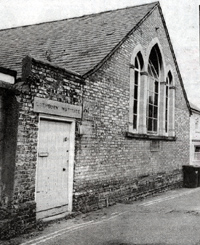
Lathbury Institute |
|
blank |
In Bury, the Lathbury Institute was built near St Johns Church, and was used as a Mission Room for that parish. This church hall stands in Church Row and cost £400 to build, the money coming from a bequest left by Elizabeth Lathbury. The Lathbury family lived at 2, Angel Hill. Soon after this picture was taken the premises were converted to private dwellings.
In Bury two national chain stores had arrived by 1896. They were Stead and Simpson and Liptons, both on the Cornhill next to Market Thoroughfare, although it was then called Bell Arcade.
Moves were afoot to improve the Moyse's Hall so that the Fire Brigade could get their engines fully under cover. This would have meant removing the distinctive medieval arches from the undercroft. This caused an outcry, and the plans for Moyse's had to be rethought. It was decided that the fire brigade would have to go somewhere else, and that the existing collections of antiquities currently held in the Athenaeum should be displayed properly in a museum. Moyse's Hall seemed an ideal location from the point of view of historical interest. By modern standards the dampish conditions were less than healthy for the long term good of the collections. New ideas were needed.
As part of their ongoing work at the time, the Boundary Commission moved the whole of Haverhill into West Suffolk, under the control of Haverhill UDC. Prior to this date the Hamlet Road area south-east of Duddery Hill lay in Essex.
At Walsham le Willows, the Church of England Society for the Housing of waifs and strays acquired Walsham Hall. It housed 40 children for some years. Today this charity is called The Childrens Society.
|
|
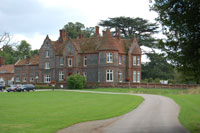
Bradfield Hall in 2006
|
|
blank |
Arthur Young of Bradfield Hall, died in 1896. He was the last descendant of Arthur Young, the agricultural writer, who died in 1820 and was responsible for spreading new agricultural ideas in the late 18th century. As the last of the Young family, Bradfield Hall was now sold off, after nearly 300 years in Young family hands. During the 19th century the old hall known to Arthur Young, the agriculturalist, was demolished, and replaced by this building.
Also to die in 1896 was Sir William Gilstrap of Fornham St Genevieve Hall and estate. Gilstrap had owned the estate since 1862, and it now passed to George Espec John Manners, whose wife was a Gilstrap. George Manners would be knighted in 1920, and retain the estate until his death in 1939. However, Sir George had other property, and it appears that he never lived at Fornham Hall, so from 1896 until 1939 the house would be let until it was finally requisitioned by the army during the Second World War.
|
|
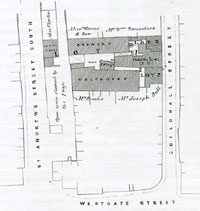
Golden Lion Brewery & Pub
|
|
blank |
In 1896 it seems that the Golden Lion Brewery in St Andrews Street (South), ceased its brewing operation. The Golden Lion pub in Guildhall Street, (now number 57) continued to function as a pub, but it was sold to the Saracen's Head Brewery, which was still operating a few doors north on Guildhall Street.
Greene King bought out the Newmarket Brewery of Miss Moody, together with her 10 public houses, for £22,500. Greene King's Managing Director, Edward Lake, was made Mayor of Bury for the third time, having previously been mayor in 1886 and 1892.
By 1896 Thomas Arnold had published the third volume of his work "Memorials of St. Edmund's Abbey".
Volume iii contained the following manuscripts: - 'The Chronicle of Bury, 1020-1346';
- The Collectanea of Andrew Aston, hosteller of Bury, made in 1426;
- Excerpts from Cambridge MSS. 1351 to 1462;
- The Curteys Registers, 1429 to 1446;
- The destruction of the church by fire, 1465;
- A short general chronicle from the Conquest to 1471;
- A variety of valuable excerpts in an appendix.
In July of 1896 the banking company of Barclay, Bevan, Barclay and Tritton joined 19 other private banking businesses to form Barclay & Company Limited, a joint stock bank, with 182 branches and deposits of £26m. The Gurney's Bank, in its various guises throughout East Anglia, including Bury St Edmunds, joined this new company.
|
|
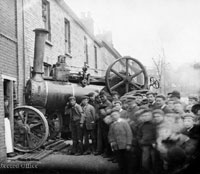
Crash in Eastgate Street
|
|
1897
|
Road traffic accidents are not new, but when you are in charge of several tons of steam driven iron with chain steering, a loss of control has serious consequences. This picture, photographed by Palmer Clarke, shows what happened when a traction engine ran into a house in Eastgate Street, Bury St Edmunds, on April 21st, 1897.
The building between the Market Cross and the Corn Exchange had been used as a covered provision market since 1863, but in 1897, it was closed for adaptations. The market stalls returned to the streets to rejoin the fruit and vegetable stalls who had stayed there all along. The building was to be adapted to become home to the School of Art and to the Fire Brigade. This would allow the Brigade to leave Moyse's Hall, and have the space to house all their equipment and fire engines.
Wind pumps were added to the West Stow sewage farm to help distribute liquid to higher ground. The system was not working very well.
In 1897 the Bury St Edmunds Borough Council finally received a new Electric Lighting Order which authorised them to proceed with their plans for a new electricity generating station. These regulations were of more practical value than those first issued in 1884. Once the finance was arranged, the capital expenditure could begin.
From 1897 to 1900 the Bury St Edmunds Borough Council began work on the coal fired electricity generating station located just to the west of town. The generating station, together with two cottages to house its key operatives, was located on the Playfields, off Prospect Row. The whole site was referred to as the Playfields because it had been acquired in 1843 for a cricket and sports area.
Two Lancashire Boilers were ordered which would be installed driving two 60 kilowatt dynamos. These produced Direct Current (DC) power of three wire 200 volts, as opposed to the modern alternating current of 230 volts. A battery of 210 accumulators was also planned. Mains wires would be erected to provide private supplies to homes and businesses within the town centre. It was intended to provide capacity sufficient for 2,500 connections.
|
|
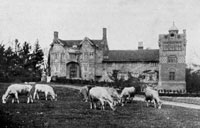
Gedding Hall c1906
|
|
blank |
At Gedding Hall, an old mansion dating back to the time of Henry VIII, time had taken its toll. It was built and rebuilt, by the Chamberlain family, between 1357, when they became Lords of the Manor, and 1582.
In 1897 it was bought by Arthur Wakerley, who had once been Mayor of Leicester, and he restored the old house and added a tower, seen here on the right of the picture. If you click on the picture to enlarge it, you can see the message "Rebuilt 1897" picked out in bricks on the tower.
The cows shown here were reputed to be the last surviving herd of Suffolk Dun Poll cattle. They were to die out after they had been used to cross with the Norfolk Red to produce the Red Poll breed earlier in the century.
Clopton's Asylum, in the Churchyard was sold by order of the Charity Commissioners. It was bought to provide a vicarage for the Church of St James. The purchase sum was invested and the interest was to provide ten shillings a week to "deserving residents in needy circumstances".
This was the year of Queen Victoria's Diamond Jubilee, and in Bury an eight day clock with three dials was erected in the tower of St Mary's church by public subscription, to commemorate the event.
The public clock which had until now been located on the Norman Tower, was taken down. The chapter ring from this 18th century clock was preserved and is now part of the Clock Museum collection.
|
|
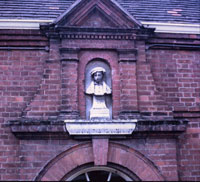
Founder's bust 1897
|
|
blank |
At King Edward VI Grammar School in the Vinefields, the governors decided to commemorate Queen Victoria's Jubilee with a new bust of the school's founder, King Edward VI. The original bust which had stood over the entrance to the former school in Northgate Street had broken when it had been attempted to move it to the new site in 1883. The inscription reads:
"MARTYRIS AEDMUNDI FELIX ONO FLORUIT OLIM FLOREAT EDWARDI VINEA NECTA LOCUM ET ONEM BIS SENO POSITUM VICTORIA LUSTRO VIDERIT AETERNUM PROTEGAT AUCTOR OPUS"
|
|
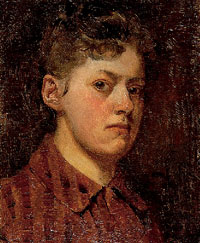
Rose Mead self portrait 1900
|
|
blank |
The promising art student Rose Mead returned to Bury from London to nurse her 70 year old mother. By now she had exhibited a portrait in the Paris Salon and at the Royal Academy. She moved into 18 Crown Street, and would live in Bury for the rest of her life. Her portraits were accepted at the Royal Academy, and this was her field of work until the Bury St Edmunds Pageant of 1907.
Greene King first began to produce bottled beers in 1897. They had already had some experience of bottling mineral waters and Guinness and Bass, but now they produced their own beers.
Not only was beer now available in bottles, but another innovation was the gas cooker. Bury had been lit by gas since 1834, at first in public streets and buildings, and then in private houses. In 1897 the Bury St Edmunds gas Company agreed to let out cookers on hire for 2/6 per quarter. In an exhibition of gas cookers in April, 5 were sold and 4 taken on hire. By 1934 the company would be supplying gas to 2,660 cookers.
The new Haverhill Co-Operative Society store was opened in the High Street, and its frontage survives today opposite Peas Market Hill. The society had by now outgrown its thatched cottage beginnings on Peas Hill, opened in 1882.
At St Mary's church, Haverhill, the vestry and organ chamber on the north of the chancel were built, and the arches of the Lady Chapel reopened.
The Haverhill Waterworks was opened in 1897, with a pumping station in Camps Road.
|
|
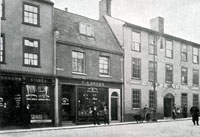
Andrews Store seen in 1907
|
|
1898
|
Sybil Andrews was born on April 19th, 1898, the third child of Charles Andrews and Beatrice Trigg. She was born at 88-90 Guildhall Street above Andrews ironmongers shop, a business founded by Sybil's grandfather, Frederick Charles Andrews. Sybil's father was a partner in the firm. They lived over the shop until 1901, when they moved to Greyfriars, on Whiting Street.
Also in 1898, a nephew of Mr Andrews, called Robert Plumpton, was invited to join the business. Plumpton had been living in Peterborough where he was already working as an ironmonger.
By 1901 the shop was called Andrews and Plumpton, which survived on its commanding site looking down Abbeygate Street, until 1988. The room where Sybil was born is illustrated in a sketch showing Andrews and Plumpton by Cyril Power, made after he met her, in about 1921.
Her mother's father was Henry Trigg, (1838-92) who had altered his name from Prigg, and had been a well known local antiquarian. He was the author of "The Icklingham Papers", an archaeological investigation of the remains of the Roman villa at Icklingham, although the book was not published until 1901, and was confusingly published in the name of Henry Prigg. Local interests and local history played a big part in Sybil's early life, and her 1936 linocut 'Tumulus', was a memory of Rampart Fields at Icklingham.
Sybil would gain an international reputation as an artist after leaving Suffolk to move to London in 1922.
In 1898 the Reverend Sydenham Henry Augustus Hervey retired to live at 28 Angel Hill, in Bury St Edmunds. S.H.A.H., as he styled himself, now turned himself in earnest to the research and publication of a series of local history pieces now called the Suffolk Green Books. He had begun this work in 1894, with his first publication, and would produce 30 such Green Books in the years from 1894 to 1929. These included the Parish Registers of Horringer from 1588 to 1850, The Subsidy Returns for 1327, 1524, and 1588, and the massive Dictionary of Herveys.
Sydenham Hervey was the 5th of twelve children born to Lord Arthur Charles Hervey of Ickworth, himself a keen historian. He had been born in 1846, and had been the Vicar of Wedmore in Somerset, until his retirement. He would live to be 99 and was buried in Bexhill in 1946.
William Henry Smith II died and his clothing factory at Chevington was sold. His other shop and premises in the centre of Bury had already been disposed of.
Chevington Grove estate had been home to the White family since 1776. Three Whites had been Rectors of Chevington All Saints Church. In 1898 the Reverend John White III sold Chevington Grove to the Marquess of Bristol.
In 1898 the Rating assessment of Greene King's brewery was increased by 75%. The assessment was in the hands of the Board of Poor Law Guardians, and they noted that the brewery was more than prospering, and that there had been no increase in their assessment for a decade.
The firm appealed and pleaded that the brewery was old, antiquated and too inefficient to merit such an increase! They needed 1200 tons of coal a year, which all had to be hauled the mile or so from the railway station using their own stable of 46 horses. All the hops and barley needed, and the beer produced, had to be similarly transported. The brewery won its appeal with costs, but the case showed that Greene King stuck to old methods and equipment, but were able to produce good quality beer nevertheless.
|
|
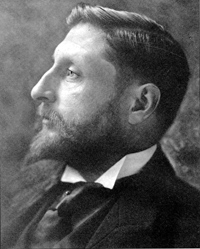
H Rider Haggard
|
|
blank |
In 1898 Henry Rider Haggard wrote "The Farmer's Year", which described the terrible conditions in the agricultural industry at the time. Wheat prices had fallen from 56/9 a quarter in 1877 to 22/10 in 1894. By 1900 the acreage under wheat in Suffolk would be halved as farmers struggled to make a living. Cheap food from the Empire was making home farming impossible. He described how the small men went to the workhouse, larger farmers had to take work as stewards or worse on shooting estates, and "landlords sink and sink until they vanish beneath the surface of the great sea of English society." Rider Haggard was well known for stories like "King Solomon's Mines" which he wrote in 1885, but although his novels produced his main income he was, at heart, a farmer. He was an agricultural adviser to governments, and himself farmed at this time near Bungay. In 1902 he would write another treatise on the state of "Rural England", by which time he would write, "I can only describe the conditions prevailing in rural Suffolk at the present time as disastrous."
|
|

Annual Cycle Races at Bury
|
|
blank |
Things were, however, slightly improving in urban areas.
The Factory Workers Compensation Act was one of a number of government measures to protect urban workers' rights at this time. Hours of work became regulated, and factory inspectors came to visit major employers like Gurteens of Haverhill.
At Bury St Edmunds the Cycle and Athletics Club held its third annual race meeting on the Cricket Ground, off Kings Road. There was no shortage of enthusiastic working class and middle class young men eager to take up this relatively inexpensive new form of sport and transport.
Among the prizes was a superb new racing cycle built by the firm of Montgomery and Co. William Montgomery had set up a bicycle shop at 6 Brentgovel Street, Bury St Edmunds, in 1892. Although he sold ready made cycles, he also began to build his own machines using a mixture of bought in parts, to which he soon began to introduce his own innovations. He thus came to cater to both the beginner and the enthusiast user who was prepared to pay a bit extra for quality. By the 1900s Montgomery would turn his attention more towards the motor cycle, where he was to continue to show his innovative streak. By about 1911 Montgomery would outgrow his rural roots and move the whole business to Coventry.
|
|
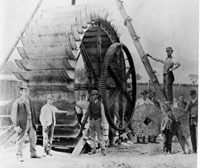
Joseph Bridge, Engineers
|
|
1899
|
This waterwheel was built in or about 1899, by the firm of Joseph Bridge at their Victoria Street works in Bury St Edmunds. It was for use in a watermill, as can be seen by the display of millstones in the picture. Several watermills were still working along the valley of the River Lark, and Pakenham and Ixworth both had watermills still operating on the River Blackbourne at this time. Some time around 1890, the Chimney Mills water wheel had been replaced with a 20 foot diameter steel wheel made by Woods and Cocksedge of Stowmarket.
A new stone quarry was opened near the Temple Bridge at Icklingham in 1899. In April, several gangs of barges were seen going up to that location to load stone. This must presumably have been gravel and large flints, which is still dug in this area today. Things were looking up for the Lark Navigation, but this extra traffic between Icklingham and Mildenhall could not save the fortunes of the Navigation Company.
The old local families bank of Oakes, Bevan and company was sold to the Capital and Counties Bank.
|
|
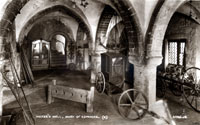
Moyses Hall Museum
|
|
blank |
Moyse's Hall was turned into a museum by the Borough Council, having been handed the building to run by the Guildhall Feoffees. At first it had been intended to use it for the Fire Brigade, but local objections were made to the building work needed to allow fire engines to be parked inside Moyse's Hall. W.S. Spanton, the well known photographer in Abbeygate Street, took a leading part in the opposition to the Corporation's proposal in the 1890s to convert Moyse's Hall in this way. He then became Honorary Secretary of the Committee formed to prepare the Hall for its opening as a museum.
In December 1898 the Moyse's Hall Museum Committee appointed Mr John Jennings of Newmarket as curator of the museum at £50 a year, together with rooms in Moyse's Hall. His contract was for one year at a time, starting on January 1st, 1899, in order that he could make all preparations for opening.
On 31st May 1899, the museum was officially opened by Lord John Hervey. The collections displayed came from three main sources. The Bury St Edmunds and West Suffolk Archaeological Institute had collected together many artefacts and had presented these to the Borough Council in 1878, since when they had been stored out of sight at the Athenaeum. The master of the workhouse in College Street (successor to the workhouse in Moyse's Hall) had collected Bury St Edmunds books, keys and coins, and these were all purchased from him. The first curator, Mr Jennings, arranged a collection of furniture, weapons, clothing, ornaments, etc., all lent by local people. Early pictures of the museum interior show these borrowed articles, some of which look very fine.
|
|
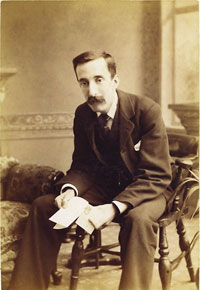
Horace Ross Barker
|
|
blank |
The first curator was J Jennings, and the first catalogue, in 1899, was signed by Jennings. In January, 1900 the committee re-appointed Mr Jennings for a further year, but he immediately tendered his resignation. The post was then offered to Mr Horace Ross Barker, who took over in February, 1900. Horace R Barker was well known in the town as an active local historian, but during his working life he was a printer, and he was listed in White's Directory as a printer's manager in 1885. (His father was another Horace Barker who was the publisher of the Bury and Norwich Post newspaper from 1863 until his death in 1869, although he had been working at that newspaper since 1852.)
|
|
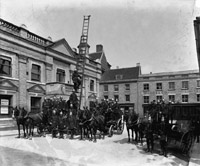
Fire Brigade new HQ |
|
blank |
In 1889 the Bury Town Council had taken over the management of the town's fire brigade. Before that date all fire calls in Bury St Edmunds were handled by local insurance companies. The Alliance Assurance Company had kept two fire engines in Whiting Street and the council had considered moving these to Moyse's Hall for a short time before deciding to build this new facility in the Traverse.
Following a renovation of the old provision market building, closed two years earlier, the new Fire Station was opened there to house the town's Volunteer Fire Brigade. In the same building a new School of Art was also opening its doors on to the Cornhill. After several years of debate, the problems of the Fire Brigade had been solved, the town had a proper museum and there was a new amenity in a brand new School of Art.
Despite the disapproval of the Home Office, the West Suffolk Police committee, called the West Suffolk Standing Joint Committee, set up the new West Suffolk Constabulary. In effect this broke away from the Joint Suffolk Constabulary. Suffolk had had a unified police force since 1869, but having a local police force run from Ipswich had never been satisfactory for the western area.
It was clear that the existing foundries within the St Andrews Works could no longer keep up with demand. So during 1899 the company of Robert Boby Limited bought 27 acres at the Chalks, a site alongside the railway line, and through into 1900 they built the new foundry which became known as the Northgate Foundry.
In June 1899, Boots Cash Chemists, styling themselves as "the largest retail chemists in the world", opened a shop at number 81 St John's Street, Bury St Edmunds. By 1910 they needed larger and more prestigious premises and moved to their well known mock tudor style building on the Cornhill.
|
|
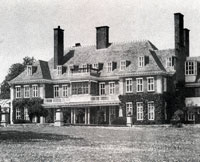
Cavenham Hall
|
|
blank |
Great houses were still being built by the super rich of the 19th century. Cavenham Hall was built in 1899 as a home at which shooting was the main occupation. It was designed by A N Prentice for H E M Davies, who had grown rich from the proceeds of gold mines in South Africa. Like many such great houses it could not survive the changes wrought by two world wars and Death Duties, and it would be demolished in 1949.
Stafford Allen set up a farm and factory on the outskirts of Long Melford in 1899 alongside the River Stour, and reached from Melford via Westgate Street or from Liston Lane. The site had previously been the old flax factory, which must have closed down soon after 1891. Allen's plan was to make natural pharmaceuticals, flavourings and perfumes by milling herbs and spices, many of them grown on his own farm. These locally grown plants included Deadly Nightshade, (Atropa belladona, for atropine), Foxgloves, (for digitalis), liquorice for its root and peppermint for its oil. The factory also milled imported ginger and pepper, a variety of gums and other spices, and made food flavouring essences and naturally-based insecticides such as pyrethrum and derris.
In 1966 a merger of Allen's with two other companies making complementary products produced the new firm of "Bush Boake Allen" but was bought out by IFF in 2000. The factory closed down in 2002, when International Flavours and Fragrances Ltd. moved all the Melford production to its site in Haverhill.
The silk manufacturer, Stephen Walters, had built silk mills in Haverhill in 1828 and in Sudbury in 1860, where he began weaving fine umbrella and parasol silks with the help of his son Alfred I (1822-1913). In 1899 Alfred Walters II (1852-1937) bought the factory at Sudbury Silk Mills in Suffolk, absorbing the silk maker, Messrs Kipling, in 1900. The firm of Stephen Walters and Sons now established its weaving base at Sudbury, and moved completely out of Spitalfields in London.
The Haverhill Rope, Twine and Sack company was formed in 1899, although Hendersons had started manufacturing these items in 1893. Haverhill Rope company had been set up originally in 1880.
The second Boer War started on 10th October 1899, when the Boer Republics of Transvaal and Orange Free State declared war on the British. The First Battalion of the Suffolk Regiment had just returned to Dover from Malta, and was sent to South Africa, arriving on 29th November. This war was to have a big impact on the home front, as news and photographs got home quicker than ever before.
|
|
Quick links on this page
Top of Page 1813
Enclosure awards 1815
Theatre Royal built 1819
Lenny's map of Bury 1823
Suffolk Hospital opened 1825
Ickworth Rotunda ready 1829
Great Reform Act 1832
Municipal Reform 1835
Pigot's first Directory 1839
St John's consecrated 1842
Rail link to Ipswich 1846
Athenaeum taken over 1854
Corn Exchange built 1862
Fred King starts brewery 1868
Corn Exchange built 1862
Fred King starts brewery 1868
BFP moves, EADT born 1874
Henry Prigg's digs 1878
KEGS at the Vinefields 1883
Greene King Brewery 1887
West Suffolk C C 1888
Police in St Johns Street 1892
Moyse's Hall Museum 1899
|
|
1900
|
Please click here if you wish to follow our Chronicle into the Twentieth Century. For a closer look at Haverhill, see below.
Hav.
1900
|
The history of Haverhill in the 20th century is one of great expansion. Please click here to follow Haverhill's century in close-up detail.
|
|
Prepared for the St Edmundsbury
local history project
by David Addy, 1998 to 2004.
Photography of some Museum exhibits and pictures by Graham Portlock
Books and online resources consulted
"An illustration of the Monastic History and Antiquities of the town and abbey of St Edmund's Bury" by the Reverend Richard Yates 1805
"Additions with 14 additional plates to the History and Antiquities of the abbey of St Edmund's Bury" by the Reverend Richard Yates (Posthumous publication) 1843
"The Life of Sir Charles J. F. Bunbury", edited by Mrs Henry Lyell is available at the West Suffolk Record Office
"Autobiography of Arthur Young" edited in 1898 by Miss M. Betham-Edwards
"Bury St Edmund's Its History and Antiquities", by William S Spanton, c1930.
"Suffolk" by Lilian Redstone, 1930
"A Century of Traction Engines" by W J Hughes, 1959
"A Short History of Glemsford" by Rev Kenneth W. Glass 1962 available at Foxearth and District Local History Society
"The Story of King Edward VI School, Bury St Edmunds", by R W Elliott, 1963
"Victorian and Edwardian Suffolk from old Photographs" by Colin Harrison, 1973
Borough of St Edmundsbury Official Guide
1976 edition.
"The Matmaker and the Magistrate: Long Melford 1885" by Richard Deeks, 1980
"The History of Eriswell" by W H Donnan, 1956
"Jankyn Smyth and the Guildhall Feoffees"
by Margaret Statham. 1981
"Greene King, a Business and Family History", by Richard G Wilson, 1983
"Chevington" by Frank Cooper, 1984
"Curtsey to the Lady", by Zoe Ward, 1985
"A History of Suffolk" by David Dymond and Peter Northeast, 1985 & 1995
"History of Needham Market" by Hugh Paget, 1988
"Lavenham industrial town" by Alec Betterton and David Dymond, 1989
James Oakes' Diaries edited by Jane Fiske, Volume 1 1990, Volume 2 1991
"Yesterdays Town Bury St Edmunds" by Margaret Statham, 1992
"Suffolk of 100 years ago" by Humphrey Phelps 1992
"300 Years of Quakerism in Bury St Edmunds Suffolk" by Betty Curtain 1993
"Early East Anglian Banks and Bankers", by Harold Preston, 1994
"Suffolk at Work", by Robert Malster 1995
"The Book of Bury St Edmunds"
by Margaret Statham. 1988 & Revised 1996
"Firefighting in Suffolk" by Graham Saward, 1996
"Old Inns and Beerhouses of Bury St Edmunds" by Gerry Nixon 1996 and 2002
"Lost Railways of East Anglia" by Leslie Oppitz, 1999
'Brewing in Bury' by Rob Lansman, 2000
"Bury St Edmunds - a photographic history" by Clive Paine, 2001
"Tithe War 1918 - 1939 the countryside in revolt" by Carol Twinch, 2001
"Bury St Edmunds Past and Present" by Robert Halliday, 2002
"The History of Bury Town FC" by John Wybrew, 2003
"John Kirby's Suffolk: his maps and Roadbooks" facsimile reprint by Suffolk Records Society, volume 47, 2004
"Around Bury St Edmunds" by Robert Halliday, 2004
"Death Recorded - Capital Punishment in Suffolk 1732-1900" by Pip Wright, 2006
"A Handsome and Substantial Building - A History of BSE Corn Exchange" by John Orbell, 2017
"Suffolk newspaper reports, 1801-1825 & 1826 -1850, 1851-1875, 1876-1900" from Pip Wright's website
Railway Mission by Gloria J Abbot
Clarke's Tin Whistles
"First rural council homes at Stow Road Ixworth at Municipal Dreams Blog here:
Stow Road Ixworth
Simon Knott's website on Suffolk Churches. St Johns Church, Bury St Edmunds
For historical maps see this website:www.VisionofBritain.org.uk
Foxearth and District Local History Society
|














































































































































































































































































































